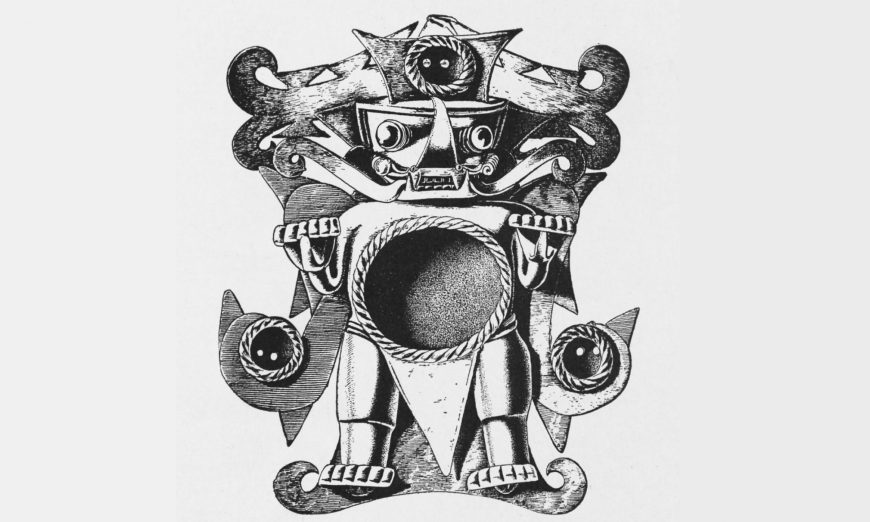11.2: North America before c. 1500
- Page ID
- 67096
North America before c. 1500
Canada, the United States, Mesoamerica, and Central America
Native American / First Nations
Traces of sophisticated cultures remain across what is today the United States and Canada.
before 11,200 B.C.E. - c. 1500
Clovis culture
Clovis culture
The first clear evidence of human activity in North America are spear heads like this. They are called Clovis points. These spear tips were used to hunt large game. The period of the Clovis people coincides with the extinction of mammoths, giant sloth, camels and giant bison in North America. The extinction of these animals was caused by a combination of human hunting and climate change.

How did humans reach America?
North America was one of the last continents in the world to be settled by humans after about 15,000 BC. During the last Ice Age, water, which previously flowed off the land into the sea, was frozen up in vast ice sheets and glaciers so sea levels dropped. This exposed a land bridge that enabled humans to migrate through Siberia to Alaska. These early Americans were highly adaptable and Clovis points have been found throughout North America. It is remarkable that over such a vast area, the distinctive characteristics of the points hardly vary.
Typical Clovis points, like the example above, have parallel to slightly convex edges which narrow to a point. This shape is produced by chipping small, parallel flakes off both sides of a stone blade. Following this, the point is thinned on both sides by the removal of flakes which leave a central groove or “flute.” These flutes are the principal feature of Clovis or “fluted” points. They originate from the base which then has a concave outline and end about one-third along the length. The grooves produced by the removal of the flutes allow the point to be fitted to a wooden shaft of a spear.
The people who made Clovis points spread out across America looking for food and did not stay anywhere for long, although they did return to places where resources were plentiful.
Clovis points are sometimes found with the bones of mammoths, mastodons, sloth and giant bison. As the climate changed at the end of the last Ice Age, the habitats on which these animals depended started to disappear. Their extinction was inevitable but Clovis hunting on dwindling numbers probably contributed to their disappearance.
Although there are arguments in favor of pre-Clovis migrations to America, it is the “Paleo-Indian” Clovis people who can be most certainly identified as the probable ancestors of later Native North American peoples and cultures.
© Trustees of the British Museum
Additional resources:
B. Fagan, Ancient North America (London, 2005).
G. Haynes, The Early Settlement of North America: The Clovis Era (Cambridge, 2002).
G. Haynes (ed.), American Megafaunal Extinctions at the End of the Pleistocene (New York, 2009).
D. Meltzer, First Peoples in a New World: Colonizing Ice Age America(Berkeley, 2009).
S. Mithen, After the Ice: A Global Human History 20000-5000 BC (London, 2003).
Moundbuilders
Fort Ancient Culture: Great Serpent Mound

A serpent 1300 feet long
The Great Serpent Mound in rural, southwestern Ohio is the largest serpent effigy in the world. Numerous mounds were made by the ancient Native American cultures that flourished along the fertile valleys of the Mississippi, Ohio, Illinois, and Missouri Rivers a thousand years ago, though many were destroyed as farms spread across this region during the modern era. They invite us to contemplate the rich spiritual beliefs of the ancient Native American cultures that created them.
The Great Serpent Mound measures approximately 1,300 feet in length and ranges from one to three feet in height. The complex mound is both architectural and sculptural and was erected by settled peoples who cultivated maize, beans and squash and who maintained a stratified society with an organized labor force, but left no written records. Let’s take a look at both aerial and close-up views that can help us understand the mound in relationship to its site and the possible intentions of its makers.

Supernatural powers?
The serpent is slightly crescent-shaped and oriented such that the head is at the east and the tail at the west, with seven winding coils in between. The shape of the head perhaps invites the most speculation. Whereas some scholars read the oval shape as an enlarged eye, others see a hollow egg or even a frog about to be swallowed by wide, open jaws. But perhaps that lower jaw is an indication of appendages, such as small arms that might imply the creature is a lizard rather than a snake. Many native cultures in both North and Central America attributed supernatural powers to snakes or reptiles and included them in their spiritual practices. The native peoples of the Middle Ohio Valley in particular frequently created snake-shapes out of copper sheets.

The mound conforms to the natural topography of the site, which is a high plateau overlooking Ohio Brush Creek. In fact, the head of the creature approaches a steep, natural cliff above the creek. The unique geologic formations suggest that a meteor struck the site approximately 250-300 million years ago, causing folded bedrock underneath the mound.
Celestial hypotheses
Aspects of both the zoomorphic form and the unusual site have associations with astronomy worthy of our consideration. The head of the serpent aligns with the summer solstice sunset, and the tail points to the winter solstice sunrise. Could this mound have been used to mark time or seasons, perhaps indicating when to plant or harvest? Likewise, it has been suggested that the curves in the body of the snake parallel lunar phases, or alternatively align with the two solstices and two equinoxes.

Some have interpreted the egg or eye shape at the head to be a representation of the sun. Perhaps even the swallowing of the sun shape could document a solar eclipse. Another theory is that the shape of the serpent imitates the constellation Draco, with the Pole Star matching the placement of the first curve in the snake’s torso from the head. An alignment with the Pole Star may indicate that the mound was used to determine true north and thus served as a kind of compass.
Of note also is the fact that Halley’s Comet appeared in 1066, although the tail of the comet is characteristically straight rather than curved. Perhaps the mound served in part to mark this astronomical event or a similar phenomenon, such as light from a supernova. In a more comprehensive view, the serpent mount may represent a conglomerate of all celestial knowledge known by these native peoples in a single image.
Who built it?
Determining exactly which culture designed and built the effigy mound, and when, is a matter of ongoing inquiry. A broad answer may lie in viewing the work as being designed, built, and/or refurbished over an extended period of time by several indigenous groups. The leading theory is that the Fort Ancient Culture (1000-1650 C.E.) is principally responsible for the mound, having erected it in c. 1070 C.E. This mound-building society lived in the Ohio Valley and was influenced by the contemporary Mississippian culture (700-1550), whose urban center was located at Cahokia in Illinois. The rattlesnake was a common theme among the Mississippian culture, and thus it is possible that the Fort Ancient Culture appropriated this symbol from them (although there is no clear reference to a rattle to identify the species as such).

An alternative theory is that the Fort Ancient Culture refurbished the site c. 1070, reworking a preexisting mound built by the Adena Culture (c.1100 B.C.E.-200 C.E.) and/or the Hopewell Culture (c. 100 B.C.E.-550 C.E.). Whether the site was built by the Fort Ancient peoples, or by the earlier Adena or Hopewell Cultures, the mound is atypical. The mound contains no artifacts, and both the Fort Ancient and Adena groups typically buried objects inside their mounds. Although there are no graves found inside the Great Serpent Mound, there are burials found nearby, but none of them are the kinds of burials typical for the Fort Ancient culture and are more closely associated with Adena burial practices. Archaeological evidence does not support a burial purpose for the Great Serpent Mound.
Debate continues
Whether this impressive monument was used as a way to mark time, document a celestial event, act as a compass, serve as a guide to astrological patterns, or provide a place of worship to a supernatural snake god or goddess, we may never know with certainty. One scholar has recently suggested that the mound was a platform or base for totems or other architectural structures that are no longer extant, perhaps removed by subsequent cultures. All to say, scholarly debate continues, based on on-going archaeological evidence and geological research. But without a doubt, the mound is singular and significant in its ability to provide tangible insights into the cosmology and rituals of the ancient Americas.
Additional resources:
Great Serpent Mound at The Metropolitan Museum of Art’s Timeline of Art History
Serpent Mound at the Ohio Historical Society
Mississippian shell neck ornament (gorget)
by DR. DAVID W. PENNEY, NATIONAL MUSEUM OF THE AMERICAN INDIAN, SMITHSONIAN INSTITUTION and DR. BETH HARRIS
Video \(\PageIndex{1}\): Gorget, c. 1250-1350, probably Middle Mississippian Tradition, whelk shell, 10 x 2 cm (National Museum of the American Indian, Smithsonian Institution, 18/853), a Seeing America video
Speakers: Dr. David Penney, Associate Director for Museum Scholarship, Exhibitions, and Public Engagement, National Museum of the American Indian and Dr. Beth Harris
Additional resources
SmartHistory images for teaching and learning:

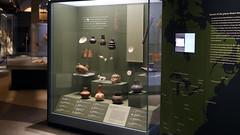
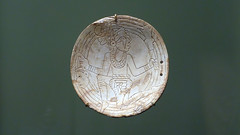
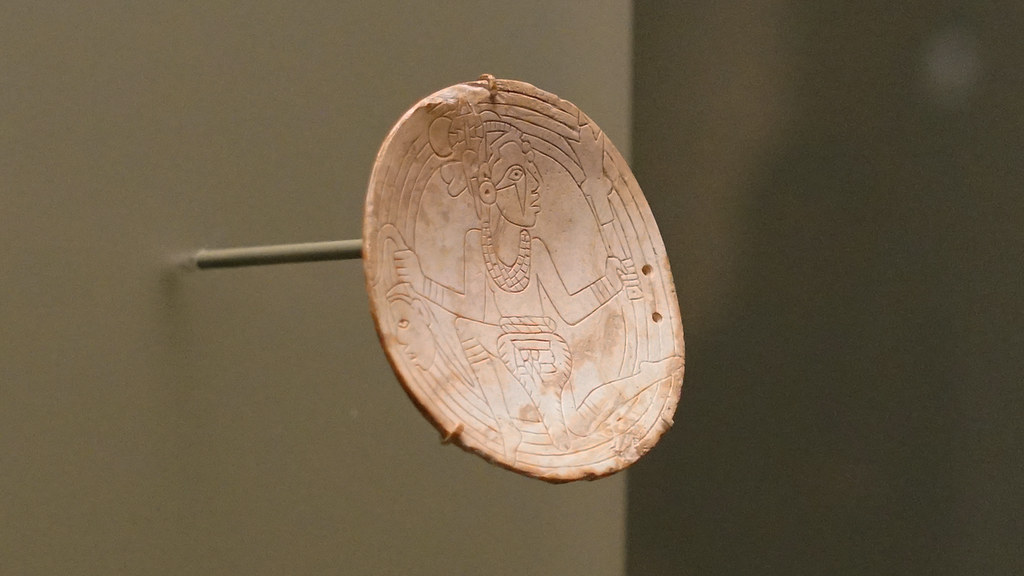
Ancestral Puebloan
Mesa Verde
Video \(\PageIndex{2}\):
Mesa Verde and the preservation of Ancestral Puebloan heritage ARCHES: At Risk Cultural Heritage Education Series Speakers: Dr. Lauren Kilroy-Ewbank and Dr. Steven Zucker
Wanted: stunning view

Imagine living in a home built into the side of a cliff. The Ancestral Puebloan peoples (formerly known as the Anasazi) did just that in some of the most remarkable structures still in existence today. Beginning after 1000-1100 C.E., they built more than 600 structures (mostly residential but also for storage and ritual) into the cliff faces of the Four Corners region of the United States (the southwestern corner of Colorado, northwestern corner of New Mexico, northeastern corner of Arizona, and southeastern corner of Utah). The dwellings depicted here are located in what is today southwestern Colorado in the national park known as Mesa Verde (“verde” is Spanish for green and “mesa” literally means table in Spanish but here refers to the flat-topped mountains common in the southwest).
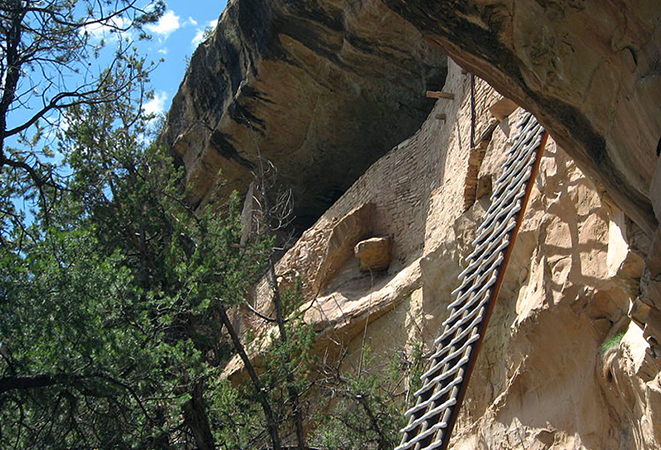
The most famous residential sites date to the twelfth and thirteenth centuries. The Ancestral Puebloans accessed these dwellings with retractable ladders, and if you are sure footed and not afraid of heights, you can still visit some of these sites in the same way today.
To access Mesa Verde National Park, you drive up to the plateau along a winding road. People come from around the world to marvel at the natural beauty of the area as well as the archaeological remains, making it a popular tourist destination.
The twelfth- and thirteenth-century structures made of stone, mortar, and plaster remain the most intact. We often see traces of the people who constructed these buildings, such as hand or fingerprints in many of the mortar and plaster walls.

Ancestral Puebloans occupied the Mesa Verde region from about 450 C.E. to 1300 C.E. The inhabited region encompassed a far larger geographic area than is defined now by the national park, and included other residential sites like Hovenweep National Monument and Yellow Jacket Pueblo. Not everyone lived in cliff dwellings. Yellow Jacket Pueblo was also much larger than any site at Mesa Verde. It had 600–1200 rooms, and 700 people likely lived there (see link below). In contrast, only about 125 people lived in Cliff Palace (largest of the Mesa Verde sites), but the cliff dwellings are certainly among the best-preserved buildings from this time.

Cliff palace
The largest of all the cliff dwellings, Cliff Palace, has about 150 rooms and more than twenty circular rooms. Due to its location, it was well protected from the elements. The buildings ranged from one to four stories, and some hit the natural stone “ceiling.” To build these structures, people used stone and mud mortar, along with wooden beams adapted to the natural clefts in the cliff face. This building technique was a shift from earlier structures in the Mesa Verde area, which, prior to 1000 C.E., had been made primarily of adobe (bricks made of clay, sand and straw or sticks). These stone and mortar buildings, along with the decorative elements and objects found inside them, provide important insights into the lives of the Ancestral Puebloan people during the thirteenth century.

At sites like Cliff Palace, families lived in architectural units, organized around kivas (circular, subterranean rooms). A kiva typically had a wood-beamed roof held up by six engaged support columns made of masonry above a shelf-like banquette. Other typical features of a kiva include a firepit (or hearth), a ventilation shaft, a deflector (a low wall designed to prevent air drawn from the ventilation shaft from reaching the fire directly), and a sipapu, a small hole in the floor that is ceremonial in purpose. They developed from the pithouse, also a circular, subterranean room used as a living space.

Kivas continue to be used for ceremonies today by Puebloan peoples though not those within Mesa Verde National Park. In the past, these circular spaces were likely both ceremonial and residential. If you visit Cliff Palace, you will see the kivas without their roofs (see above), but in the past they would have been covered, and the space around them would have functioned as a small plaza.

Connected rooms fanned out around these plazas, creating a housing unit. One room, typically facing onto the plaza, contained a hearth. Family members most likely gathered here. Other rooms located off the hearth were most likely storage rooms, with just enough of an opening to squeeze your arm through a hole to grab anything you might need. Cliff Palace also features some unusual structures, including a circular tower. Archaeologists are still uncertain as to the exact use of the tower.

Painted murals
The builders of these structures plastered and painted murals, although what remains today is fairly fragmentary. Some murals display geometric designs, while other murals represent animals and plants.

For example, Mural 30, on the third floor of a rectangular “tower” (more accurately a room block) at Cliff Palace, is painted red against a white wall. The mural includes geometric shapes that are thought to portray the landscape. It is similar to murals inside of other cliff dwellings including Spruce Tree House and Balcony House. Scholars have suggested that the red band at the bottom symbolizes the earth while the lighter portion of the wall symbolizes the sky. The top of the red band, then, forms a kind of horizon line that separates the two. We recognize what look like triangular peaks, perhaps mountains on the horizon line. The rectangular element in the sky might relate to clouds, rain or to the sun and moon. The dotted lines might represent cracks in the earth.

The creators of the murals used paint produced from clay, organic materials, and minerals. For instance, the red color came from hematite (a red ocher). Blue pigment could be turquoise or azurite, while black was often derived from charcoal. Along with the complex architecture and mural painting, the Ancestral Puebloan peoples produced black-on-white ceramics and turquoise and shell jewelry (goods were imported from afar including shell and other types of pottery). Many of these high-quality objects and their materials demonstrate the close relationship these people had to the landscape. Notice, for example, how the geometric designs on the mugs above appear similar to those in Mural 30 at Cliff Palace.
Why build here?
From 500–1300 C.E., Ancestral Puebloans who lived at Mesa Verde were sedentary farmers and cultivated beans, squash, and corn. Corn originally came from what is today Mexico at some point during the first millennium of the Common Era. Originally most farmers lived near their crops, but this shifted in the late 1100s when people began to live near sources of water, and often had to walk longer distances to their crops.

So why move up to the cliff alcoves at all, away from water and crops? Did the cliffs provide protection from invaders? Were they defensive or were there other issues at play? Did the rock ledges have a ceremonial or spiritual significance? They certainly provide shade and protection from snow. Ultimately, we are left only with educated guesses—the exact reasons for building the cliff dwellings remain unknown to us.
Why were the cliffs abandoned?
The cliff dwellings at Mesa Verde were abandoned around 1300 C.E. After all the time and effort it took to build these beautiful dwellings, why did people leave the area? Cliff Palace was built in the twelfth century, why was it abandoned less than a hundred years later? These questions have not been answered conclusively, though it is likely that the migration from this area was due to either drought, lack of resources, violence or some combination of these. We know, for instance, that droughts occurred from 1276 to 1299. These dry periods likely caused a shortage of food and may have resulted in confrontations as resources became more scarce. The cliff dwellings remain, though, as compelling examples of how the Ancestral Puebloans literally carved their existence into the rocky landscape of today’s southwestern United States.
Video \(\PageIndex{3}\)
Additional resources:
Yellow Jacket Pueblo reconstruction
Janet Catherine Berlo and Ruth B. Phillips, Native North American Art, 2 ed. Oxford History of Art series (Oxford: Oxford University Press, 2014).
Elizabeth A. Newsome and Kelley Hays-Gilpin, “Spectatorship and Performance in Mural Painting, AD 1250–1500,” Religious Transformation in the Late Pre-Hispanic Pueblo World, eds. Donna Glowacki and Scott Van Keuren, Amerind Studies in Archaeology (Tucson: The University of Arizona Press, 2011).
David Grant Noble, ed., The Mesa Verde World: Explorations in Ancestral Pueblo Archaeology (Santa Fe, NM: School of American Research Press, 2006).
David W. Penney, North American Indian Art (London: Thames and Hudson, 2004).
SmartHistory images for teaching and learning:
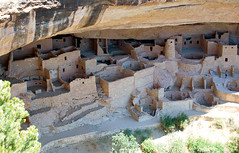
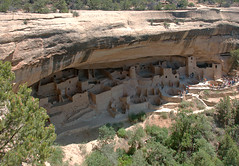
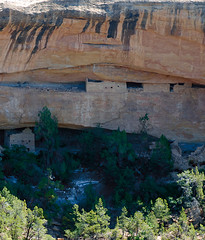

Introduction to Chaco Canyon
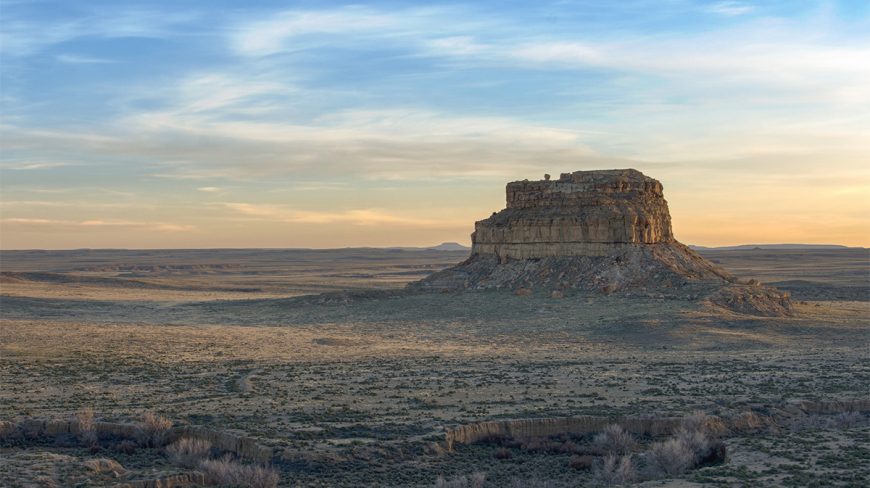
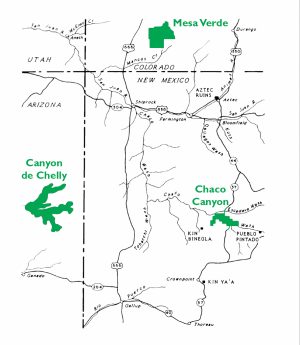
New Mexico is known as the “land of enchantment.” Among its many wonders, Chaco Canyon stands out as one of the most spectacular. Part of Chaco Culture National Historical Park, Chaco Canyon is among the most impressive archaeological sites in the world, receiving tens of thousands of visitors each year. Chaco is more than just a tourist site however, it is also sacred land. Pueblo peoples like the Hopi, Navajo, and Zuni consider it a home of their ancestors.
The canyon is vast and contains an impressive number of structures—both big and small—testifying to the incredible creativity of the people who lived in the Four Corners region of the U.S. between the 9th and 12th centuries. Chaco was the urban center of a broader world, and the ancestral Puebloans who lived here engineered striking buildings, waterways, and more.
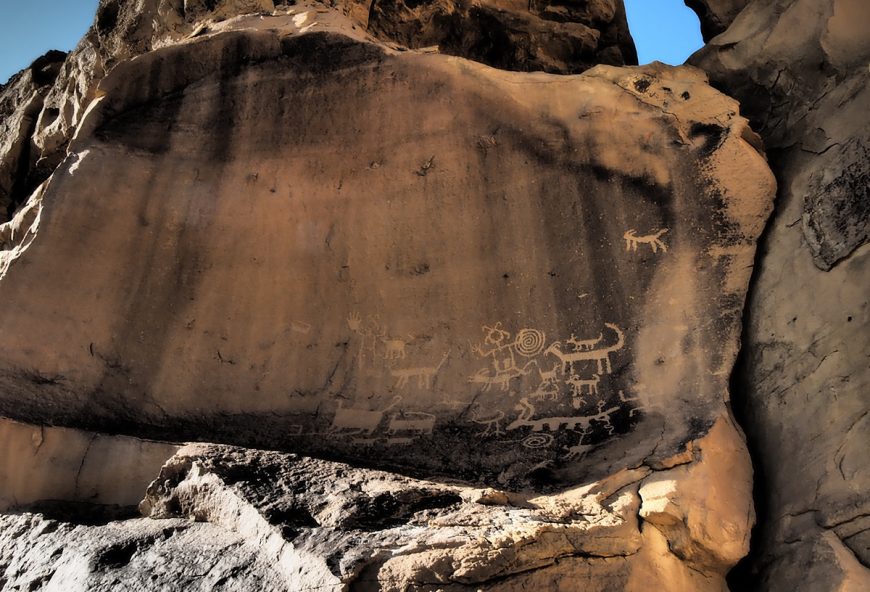
Chaco is located in a high, desert region of New Mexico, where water is scarce. The remains of dams, canals, and basins suggest that Chacoans spent a considerable amount of their energy and resources on the control of water in order to grow crops, such as corn. Today, visitors have to imagine the greenery that would have filled the canyon.
Astronomical observations clearly played an important role in Chaco life, and they likely had spiritual significance. Petroglyphs found in Chaco Canyon and the surrounding area reveal an interest in lunar and solar cycles, and many buildings are oriented to align with winter and summer solstices.
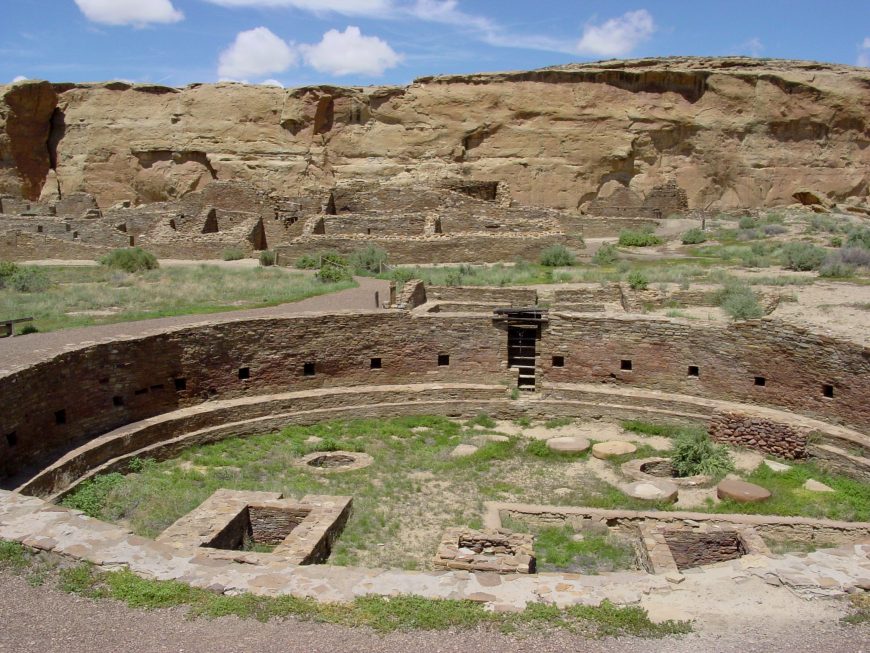
Great Houses
“Downtown Chaco” features a number of “Great Houses” built of stone and wood. Most of these large complexes have Spanish names, given to them during expeditions, such as one sponsored by the U.S. army in 1849, led by Lt. James Simpson. Carabajal, Simpson’s guide, was Mexican, which helps to explain some of the Spanish names. Great Houses also have Navajo names, and are described in Navajo legends. Tsebida’t’ini’ani (Navajo for “covered hole”), nastl’a kin (Navajo for “house in the corner”), and Chetro Ketl (a name of unknown origin) all refer to one great house, while Pueblo Bonito (Spanish for “pretty village”) and tse biyaa anii-ahi (Navajo for “leaning rock gap”) refer to another.
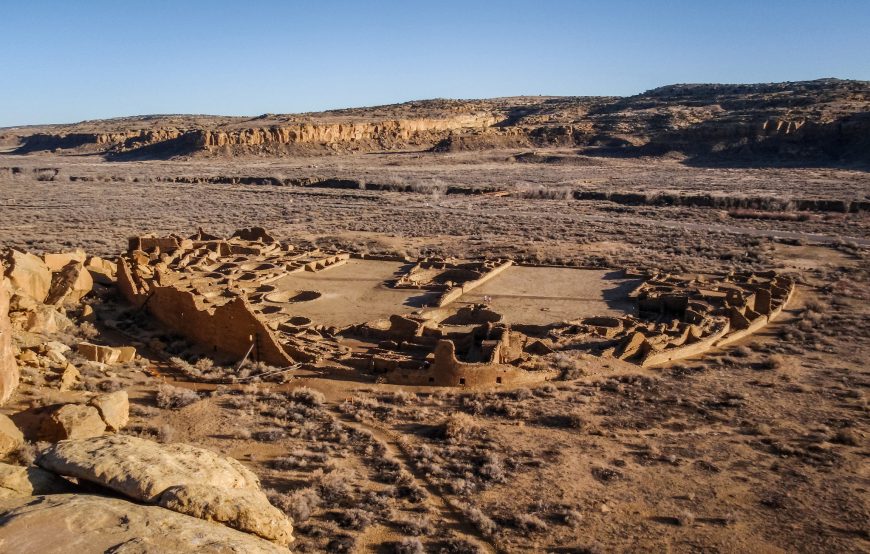
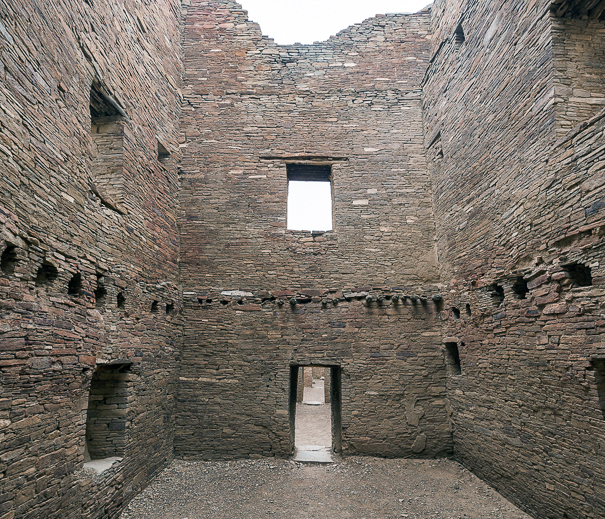
Pueblo Bonito is among the most impressive of the Great Houses. It is a massive D-shaped structure that had somewhere between 600 and 800 rooms. It was multistoried, with some sections reaching as high as four stories. Some upper floors contained balconies.
There are many questions that we are still trying to answer about this remarkable site and the people who lived here. A Great House like Pueblo Bonito includes numerous round rooms, called kivas. This large architectural structure included three great kivas and thirty-two smaller kivas. Great kivas are far larger in scale than the others, and were possibly used to gather hundreds of people together. The smaller kivas likely functioned as ceremonial spaces, although they were likely multi-purpose rooms.
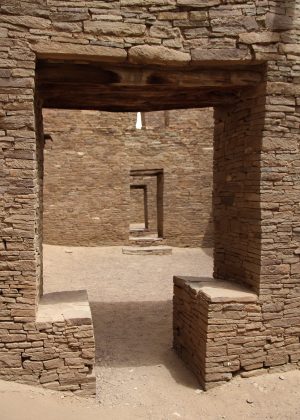
Among the many remarkable features of this building are its doorways, sometimes aligned to give the impression that you can see all the way through the building. Some doorways have a T shape, and T-shaped doors are also found at other sites across the region. Research is ongoing to determine whether the T-shaped doors suggest the influence of Chaco or if the T-shaped door was a common aesthetic feature in this area, which the Chacoans then adopted.
Recently, testing of the trees (dendroprovenance) that were used to construct these massive buildings has demonstrated that the wood came from two distinct areas more than 50 miles away: one in the San Mateo Mountains, the other the Chuska Mountains. About 240,000 trees would have been used for one of the larger Great Houses.
Chacoan Cultural Interactions
Traditionally, we tend to separate Mesoamerica and the American Southwest, as if the peoples who lived in these areas did not interact. We now know this is misleading, and was not the case.
Chacoan culture expanded far beyond the confines of Chaco Canyon. Staircases leading out of the canyon allowed people to climb the mesas and access a vast network of roads that connected places across great distances, such as Great Houses in the wider region. Aztec Ruins National Monument (not to be confused with ruins that belonged to the Aztecs of Mesoamerica) in New Mexico is another ancestral Puebloan site with many of the same architectural features we see at Chaco, including a Great House and T-shaped doorways.
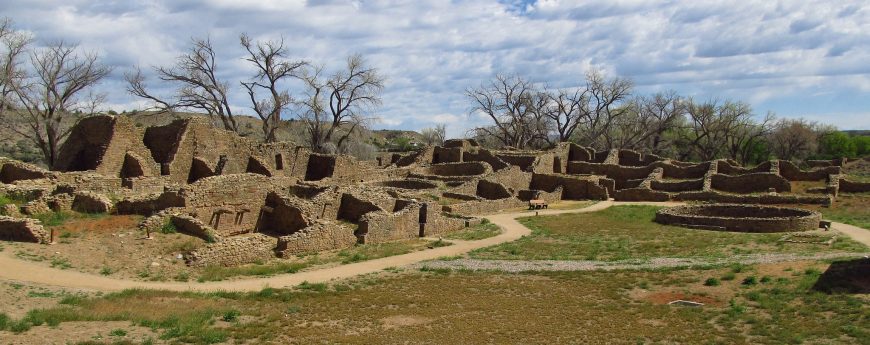
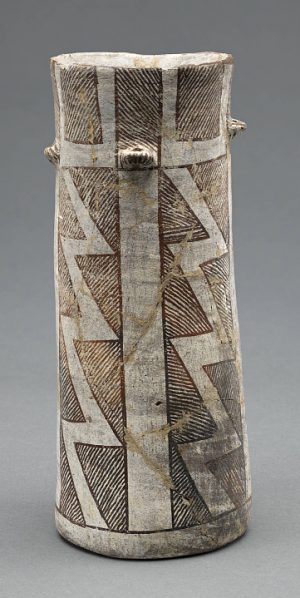
Archaeological excavations have uncovered remarkable objects that animated Chacoan life and reveal Chaco’s interactions with peoples outside the Southwestern United States. More than 15,000 artifacts have been unearthed during different excavations at Pueblo Bonito alone, making it one of the best understood spaces at Chaco. Many of these objects speak to the larger Chacoan world, as well as Chaco’s interactions with cultures farther away. In one storage room within Pueblo Bonito, pottery sherds had traces of cacao imported from Mesoamerica. These black-and-white cylindrical vessels were likely used for drinking cacao, similar to the brightly painted Maya vessels used for a similar purpose.
The remains of scarlet macaws, birds native to an area in Mexico more than 1,000 miles away, also reveal the trade networks that existed across the Mesoamerican and Southwestern world. We know from other archaeological sites in the southwest that there were attempts to breed these colorful birds, no doubt in order to use their colorful feathers as status symbols or for ceremonial purposes. A room with a thick layer of guano (bird excrement) suggests that an aviary also existed within Pueblo Bonito. Copper bells found at Chaco also come from much further south in Mexico, once again testifying to the flourishing trade networks at this time. Chaco likely acquired these materials and objects in exchange for turquoise from their own area, examples of which can be found as far south as the Yucatan Peninsula.
Current Threats to Chaco
The world of Chaco is threatened by oil drilling and fracking. After President Theodore Roosevelt passed the Antiquities Act of 1906, Chaco was one of the first sites to be made a national monument. Chaco Canyon is also a UNESCO World Heritage Site. The Chacoan region extended far beyond this center, but unfortunately the Greater Chacoan Region does not fall under the protection of the National Park Service or UNESCO. Much of the Greater Chaco Region needs to be surveyed, because there are certainly many undiscovered structures, roads, and other findings that would help us learn more about this important culture. Beyond its importance as an extraordinary site of global cultural heritage, Chaco has sacred and ancestral significance for many Native Americans. Destruction of the Greater Chaco Region erases an important connection to the ancestral past of Native peoples, and to the present and future that belongs to all of us.
Additional resources:
Chaco Canyon UNESCO World Heritage Site webpage
“Unexpected Wood Source for Chaco Canyon Great Houses” from the University of Arizona
Stephen H. Lekson, ed. The Architecture of Chaco Canyon, New Mexico (Salt Lake City: University of Utah Press, 2007).
Mesoamerica
Mexico, Guatemala, Honduras, Belize, and El Salvador
Before 7,000 B.C.E - c. 1500 C.E.
A beginner's guide to Mesoamerica
Mesoamerica, an introduction
Avocado, tomato, and chocolate. You are likely familiar with at least some of these food items. Did you know that they all originally come from Mexico, and are all based on Nahuatl words (ahuacatl, tomatl, and chocolatl) that were eventually adopted by the English language?
Nahuatl is the language spoken by the Nahua ethnic group that is found today in Mexico, but with deep historical roots. You might know one Nahua group: the Aztecs, more accurately called the Mexica. The Mexica were one of many Mesoamerican cultural groups that flourished in Mexico prior to the arrival of Europeans in the sixteenth century.
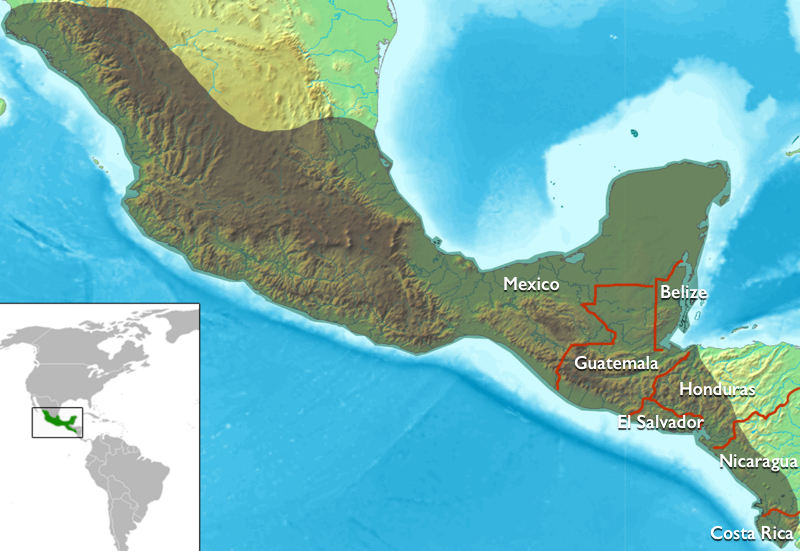
Where was Mesoamerica?
Mesoamerica refers to the diverse civilizations that shared similar cultural characteristics in the geographic areas comprising the modern-day countries of Mexico, Guatemala, Honduras, Belize, El Salvador, Nicaragua, and Costa Rica. Some of the shared cultural traits among Mesoamerican peoples included a complex pantheon of deities, architectural features, a ballgame, the 260-day calendar, trade, food (especially a reliance on maize, beans, and squash), dress, and accoutrements (such as earspools).
Some of the most well-known Mesoamerican cultures are the Olmec, Maya, Zapotec, Teotihuacan, Mixtec, and Mexica (or Aztec). The geography of Mesoamerica is incredibly diverse—it includes humid tropical areas, dry deserts, high mountainous terrain, and low coastal plains. An anthropologist named Paul Kirchkoff first used the term “Mesoamerica” (meso is Greek for “middle” or “intermediate”) in 1943 to designate these geographical areas as having shared cultural traits prior to the invasion of Europeans, and the term has remained.
Typically when we discuss Mesoamerican art we are referring to art made by peoples in Mexico and much of Central America. When people mention Native North American art, they are usually referring to indigenous peoples in the U.S. and Canada, even though these countries are technically all part of North America. More recently, archaeologists and art historians have considered connections between the Southwestern and Southeastern U.S. and Mesoamerica, an area sometimes called either the Greater Southwest or Greater Mesoamerica. Focusing on these connections demonstrates how people were in contact with one another through trade, shared beliefs, migration, or conflict. Ball courts, for instance, are found in Arizona sites such as the Pueblo Grande of the Hohokam. It is important to remember that modern-day geographic terms—like Mesoamerica or the Southwestern U.S.—are recent designations.
This essay generalizes about Mesoamerican cultures, but keep in mind that each possessed unique qualities and cultural differences. Mesoamerica was not homogenous.
When was Mesoamerica?
Art historians and archaeologists divide Mesoamerican history into distinct periods and some of these periods are then further divided into the sub-periods—early, middle, and late.
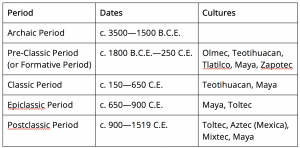
You might also encounter the term Pre-Columbian, which is a term designating indigenous cultures prior to the arrival of Columbus. It includes those in Mesoamerica, as well as in South America and the Caribbean. This term is problematic for several reasons, and is explored in another essay.
What language did people speak?
There was no single language that united the peoples of Mesoamerica. Linguists believe that Mesoamericans spoke more than 125 different languages. For instance, Maya peoples did not speak “Mayan”, but could have spoken Yucatec Maya, K’iche, or Tzotzil among many others. The Mexica belonged to the bigger Nahua ethnic group, and therefore spoke Nahuatl.
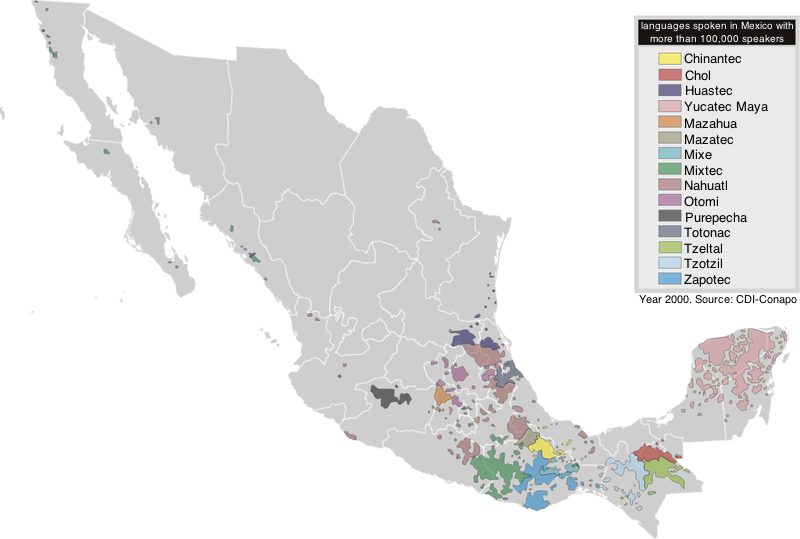
To students learning about Mesoamerica for the first time, the incredible diversity of people, languages, and even deities can be overwhelming. I recall my first Mesoamerican art history class vividly. I was intimidated by my lack of familiarity with different Mesoamerican words, languages, and cultural groups. By the end of the semester I was proud that I could differentiate between the Zapotec and Mixtec, and could spell Tlaloc. It took me a few more years to be able to spell and pronounce words like Tlacaxipehualiztli (Tla-cawsh-ee-pay-wal-eeezt-li) or Huitzilopochtli (Wheat-zil-oh-poach-lee).
Writing
Mesoamerican writing systems vary by culture. Rebus writing (writing with images) was common among many groups, like the Nahua and Mixtec. Imagine drawing an eye, a heart, and an apple. You’ve just used rebus writing to communicate “I love apples” to anyone familiar with these symbols. Many visual writing systems in Mesoamerica functioned similarly—although the previous example was simplified for the sake of clarity. You might encounter the phrases “writing without words” or “writing with signs” used to describe many writing systems in Mesoamerica. It is also called pictographic, ideographic, or picture writing.
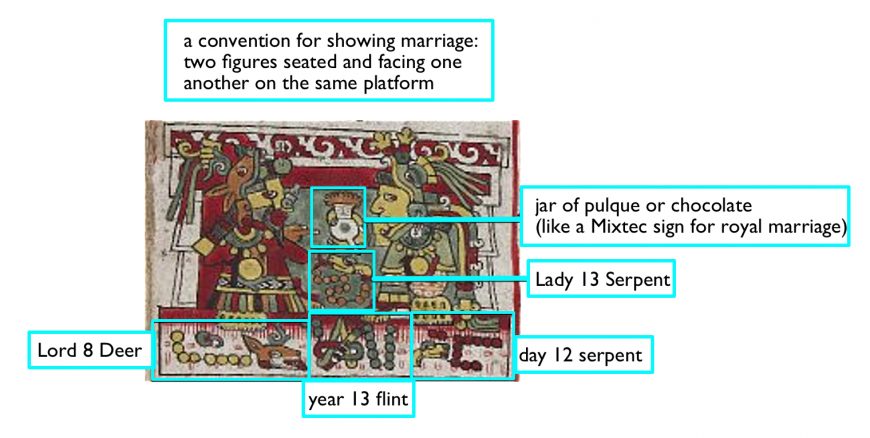
Only the Maya used a writing system like ours, where signs like letters designate sounds and syllables, and combined together to create words. Maya hieroglyphic writing is logographic, which means it uses a sign (think of a picture, symbol, or a letter) to communicate a syllable or a word.
The 260-day ritual calendar vs. the 365-day calendar
Other shared features among Mesoamerican peoples were the 260-day and 365-day calendars. The 260-day calendar was a ritual calendar, with 20 months of 13 days. Based on the sun, the 365-day calendar had 18 months of 20 days, with five “extra” nameless days at the end. It was the count of time used for agriculture.
Imagine both of these calendars as interlocking wheels. Every 52 years they completed a full cycle, and during this time special rituals commemorated the cycle. For example, the Mexica celebrated the New Fire Ceremony as a period of renewal. These cycles were understood as life cycles, and so reflect creation, death, and rebirth. The Maya (especially during the Classic period), also used a Long Count calendar in addition to the two already mentioned (rather than a cyclical calendar, the Long Count marked time as if along an extended line that does not repeat).
Religion and pantheon of gods
A complex pantheon of gods existed within each Mesoamerican culture. Many groups shared similar deities, although there was a great deal of variation. Deities that had important roles across Mesoamerica included a storm/rain god and a feathered serpent deity. Among the Mexica, this storm/rain god was known as Tlaloc, and the feathered serpent deity was known as Quetzalcoatl. The Maya referred to their storm/rain deity as Chaac (there are multiple spellings). The equivalent of Quetzalcoatl among different Maya groups included Kukulkan (Yucatec Maya) and Q’uq’umatz (K’iche Maya). Cocijo is the Zapotec equivalent of the storm/rain god. Many artworks exist that show these two deities with similar features. The storm/rain deity often has goggle eyes and an upturned mouth/snout. Feathered serpent deities typically showed serpent features paired with feathers.
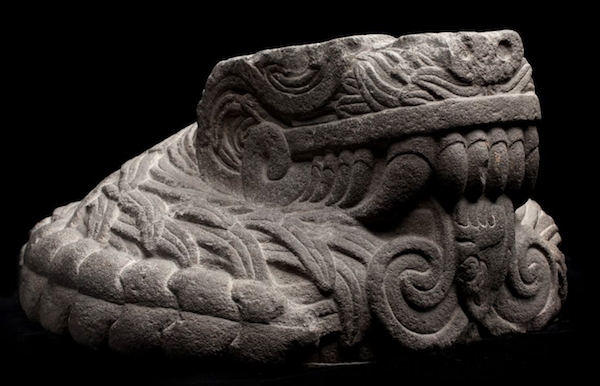
It is difficult to generalize about Mesoamerican religious beliefs and cosmological ideas because they were so complex. Throughout Mesoamerica, there was a general belief in the universe’s division along two axes: one vertical, the other horizontal. At the center, where these two axes meet, is the axis mundi, or the center (or navel) of the universe. On the horizontal plane, four directions branch off from the axis mundi. Think of the four cardinal directions (north, south, east, and west). On the vertical plane, we generally find the world split into three major realms: the celestial, terrestrial, and underworld.
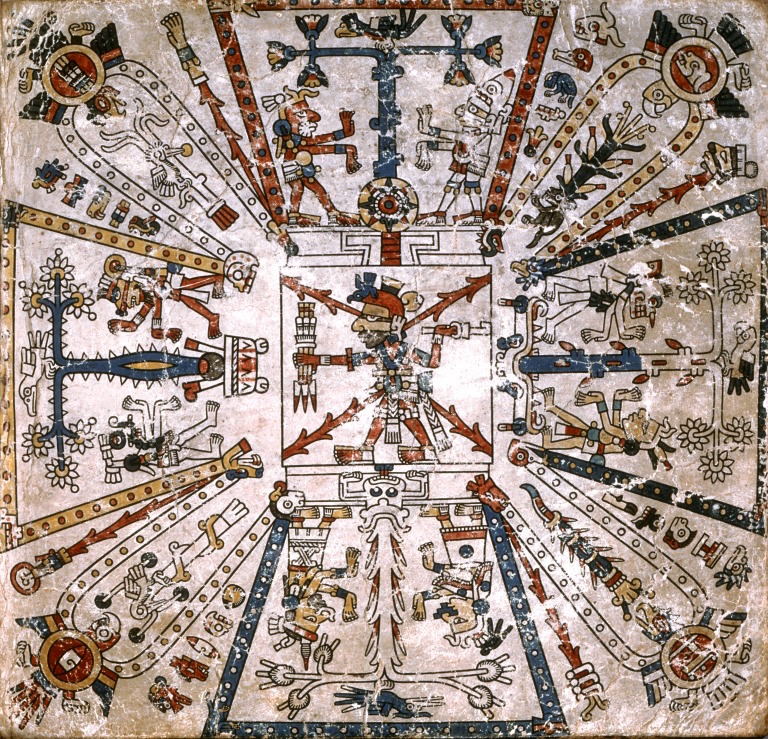
One Mexica example helps to clarify this complex cosmological system. An image in the Codex Féjervary-Mayer displays the cosmos’s horizontal axis. In the center is the deity Xiuhtecuhtli (a fire god), standing in the place of the axis mundi. Four nodes (what look almost like trapezoidal petals) branch off from his position, creating a shape called a Maltese Cross. East (top) is associated with red, south (right) with green, west (bottom) with blue, and north (left) with yellow. A specific plant and bird accompany each world direction: blue tree and quetzal (east), cacao and parrot (south), maize and blue-painted bird (west), and cactus and eagle (north). Two figures flank the plant in each arm of the cross. Together, these figures and Xiuhtecuhtli represent the Nine Lords of the Night. This cosmogram describes how the Mexica conceived of the universe.
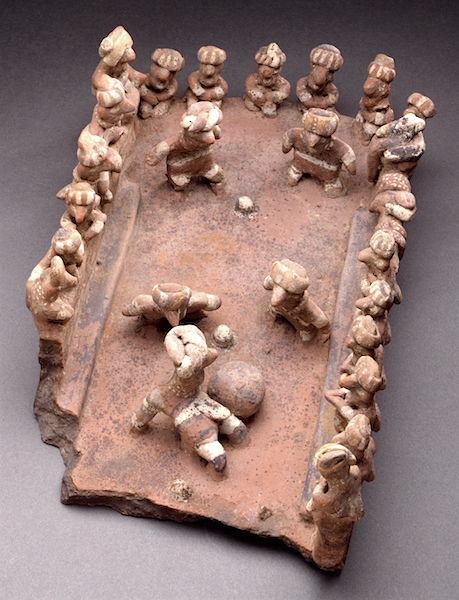
The ballgame
Peoples across Mesoamerica, beginning with the Olmecs, played a ritual sport known as the ballgame. Ballcourts were often located in a city’s sacred precinct, emphasizing the importance of the game. Solid rubber balls were passed between players (no hands allowed!), with the goal of hitting them through markers. Players wore padded garments to protect their bodies from the hard ball.
The meanings of the ballgame were many and varied. It could symbolize a range of larger cosmological ideas, including the movement of the sun through the underworld every night. War captives also played the game against members of a winning city or group, with the game symbolizing their defeat in war. Sometimes a game was even played instead of going to war.
Numerous objects display aspects of the ballgame, attesting to its significant role across Mesoamerica. We have examples of clay sculptures of ballgames occurring on courts. Ballplayers are also frequent subjects in Maya painted ceramic vessels and sculptures. Stone reliefs at El Tajin and Chichen Itza depict different moments of a ballgame culminating in ritual sacrifice. Painted pictorial codices, such as the Codex Borgia (above), display I-shaped ballcourts, and stone depictions of ballgame clothing have been found. Today, people in Mexico still play a version of the ballgame.
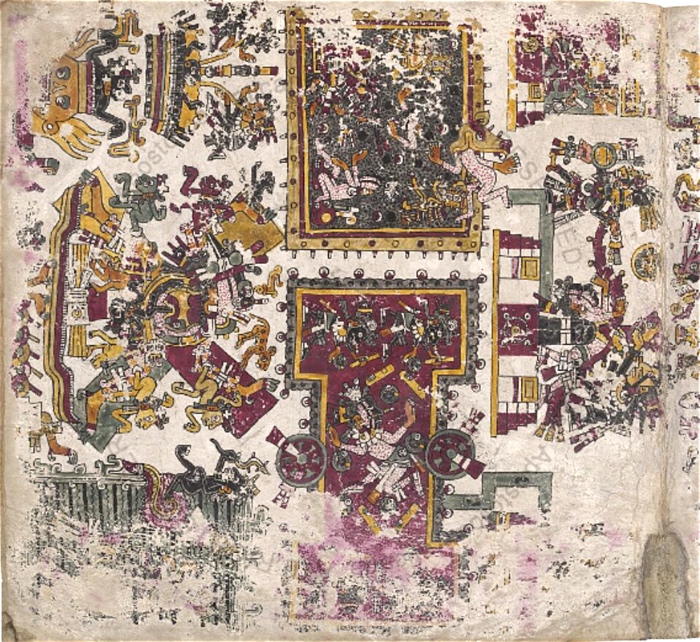
Mesoamerican societies continue to impress us with their sophistication and accomplishments, notably their artistic achievements. Our understanding continues to expand with ongoing research and archaeological excavations. Recent excavations in Mexico City, for instance, uncovered a new monumental Mexica sculpture buried with some of the most unique objects we’ve ever seen in Mexica art. With these discoveries, our understanding of the Mexica will no doubt grow and change.
Additional resources:
The Mesoamerican Ballgame on the Metropolitan Museum of Art’s Heilbrunn Timeline of Art History
The Ancient Future: Mesoamerican and Andean Timekeeping (Dumbarton Oaks)
The Mesoamerican Calendar
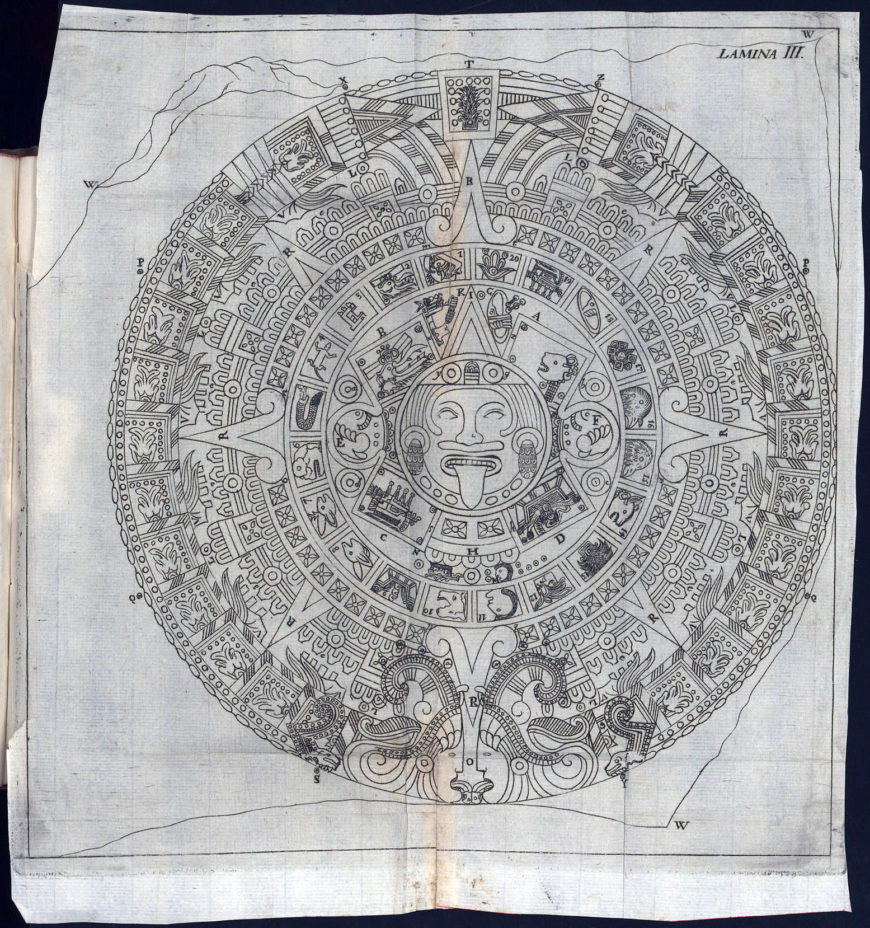
We think of calendars as utilitarian—as tools that we all use every day to organize our time. But calendars also tell us a great deal about how the cultures that produce and use them understand and structure their world.
Before Spanish conquerors invaded the Americas in the fifteenth and sixteenth centuries, the Indigenous peoples of ancient Mexico, Guatemala, Belize and Honduras—an area known today as Mesoamerica—developed cultures over more than three millennia that were distinctive but that also held many ideas in common. Some of the features that they shared include the presence of ballcourts where a game was played using a heavy rubber ball, the development of complex religions with elaborate pantheons of deities, and, in works of art, a shared understanding of the importance of materials like greenstone and precious feathers.
Many Mesoamerican cultures also shared common ways of counting time. Calendars consisted of a system of two different counts that ran simultaneously. The first count tracked a cycle of 260 days (in Nahuatl, the language of the Nahua ethnic group, this was called the tonalpohualli), which was used for divining an individual’s fate (or predicting their future); that fate was itself understood as a portrait of an individual’s character. The other count, closer to our solar year, followed a cycle of 365 days (in Nahuatl, the xiuhpohualli); this calendar tracked the passage of the alternating wet and dry seasons. Calendars were central to Mesoamerican cultures because they were tied to major seasonal cycles, and related to ideas around individuals and their fates.
Works of Mesoamerican art often include references to calendars and time. Taking a closer look at the role of the calendar in different artistic contexts helps us to understand how knowledge about time was represented and utilized in the ancient world.
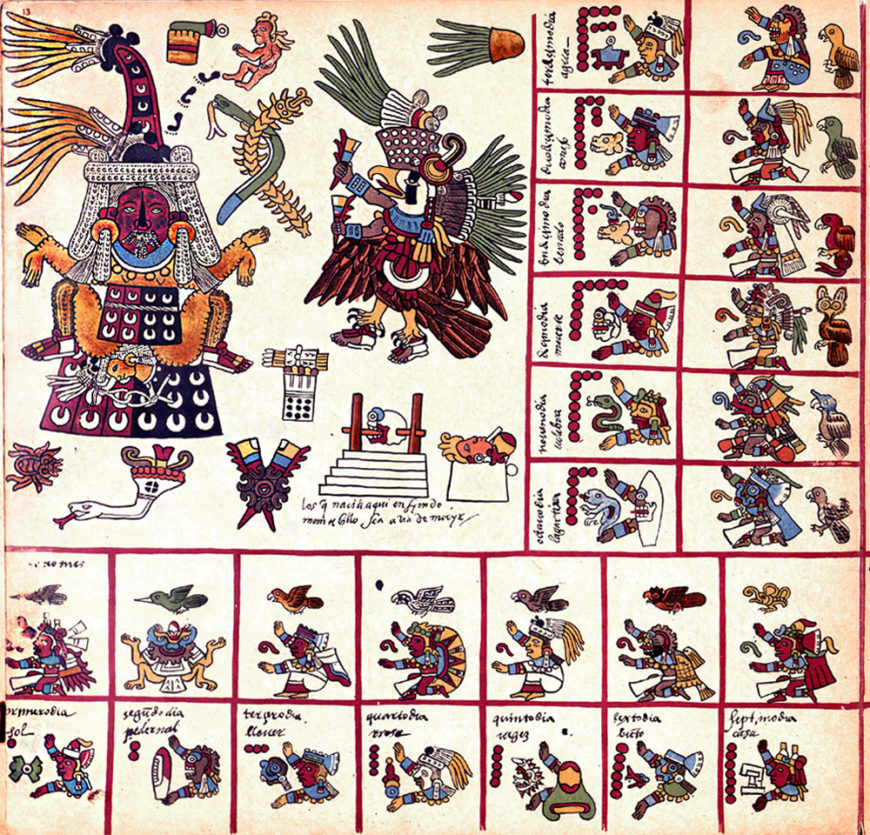
Painting the ritual calendar
Painted books—known today as codices, or codex in the singular—created both before and after the arrival of Spaniards to Mesoamerica in 1519 give us an idea of how the 260-day ritual count (the count most closely related to divination and prognostication) was represented in Mesoamerican art.
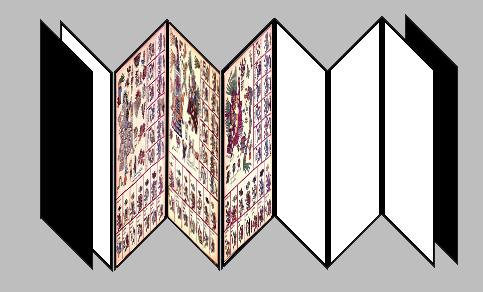
In the first half of the sixteenth century, a painted book (today known as the Codex Borbonicus) was created in Central Mexico using a very long strip of bark paper folded in an accordion-like format. This book was likely similar to the books typical of Mexica (sometimes called Aztec) visual culture, a tradition that flourished in Central Mexico in the fifteenth and sixteenth centuries.
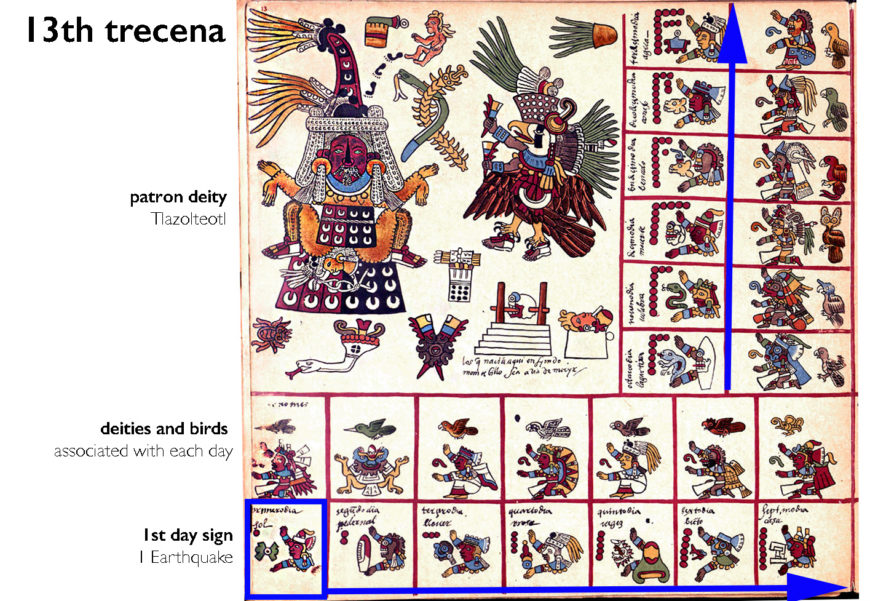
One page from an almanac in the Codex Borbonicus represents a 13-day period (called a trecena), and each trecena had a presiding patron deity. Calendar specialists consulted images like these to interpret whether the individual days that were represented might portend good, evil, or ambiguous fates. The first section of the Codex is dedicated to these 20 months of 13 days that made up the 260-day calendar.
Let us take a close look at the 13th trecena. This complex image consists of two parts, including both the count of days in the ritual calendar and the deities who were associated with those days. In the grids that run along the sides of the page, the artist has painted a sequence of 13 glyphic signs representing each of 13 days; the count starts at the bottom left and ends and the top right. 1 Earthquake is the first day of this period.
Meanwhile, the larger space on the page is a cartouche where we see the gods who are associated with these days. On the left, a frontally oriented female deity (Tlazolteotl) is depicted in the position of giving birth, while the deity on the right is an avian god who holds two perforators for sacrifice. These gods are surrounded by insects like the spider and centipede (creatures associated with night and darkness) and by objects, like an incense burner and perforators.
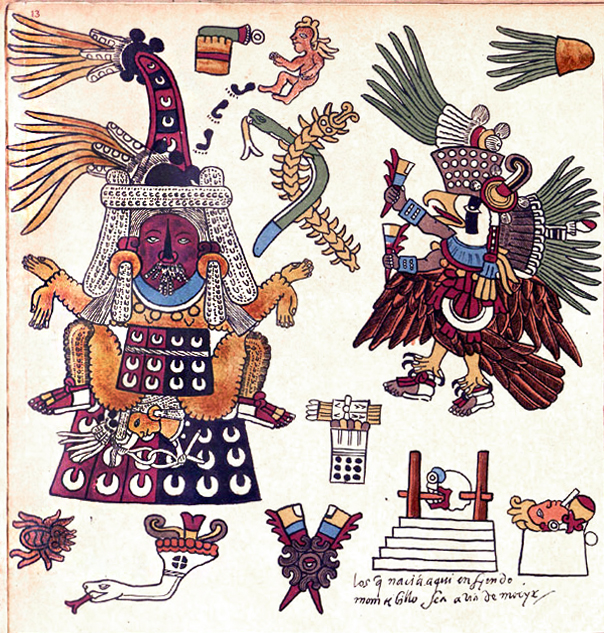
When a calendar specialist consulted this painting, these images of deities, animals, and objects could be interpreted to understand the fates and characters associated with the set of days referenced in the painting. Each day in the 260-day count was associated with a distinct quality or fate. Some days were believed to be tied to good outcomes and good character; others were ambiguous, and others still predicted evil ends. These destinies also spoke to the identity of people born on those dates. The birthdate of a child was considered in a number of contexts to be intimately tied to their fate, and in some contexts, like in the Mixtec tradition from southern Mexico, individuals were named after their birthdates, speaking to the close tie between the calendar and identity.
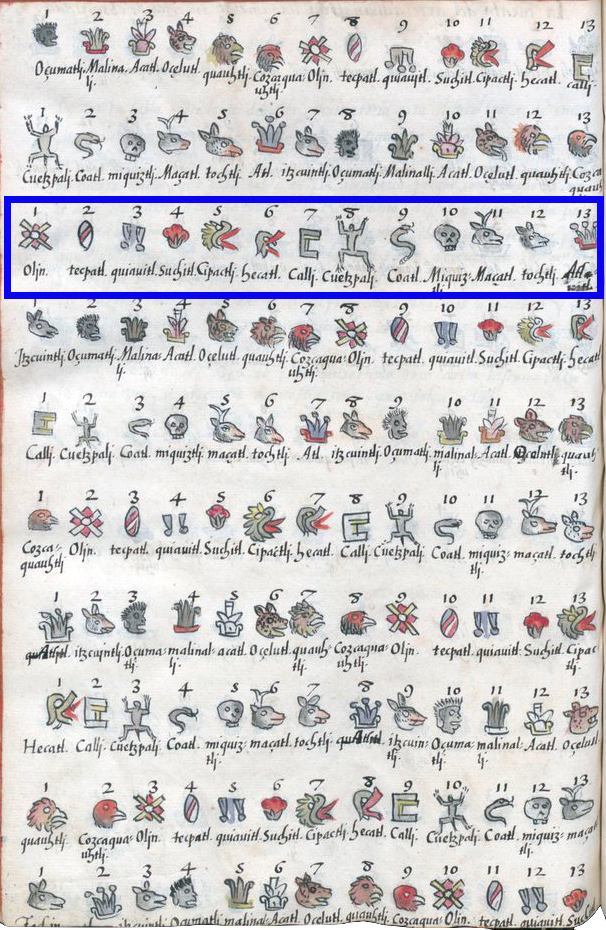
Today, we have some idea of how a painting like this one might have been interpreted in the Aztec world thanks to the texts in a manuscript known as the Florentine Codex. This manuscript was created in the second half of the sixteenth century, after the Spanish Conquest, when the Franciscan friar Bernardino de Sahagún asked a number of Nahuatl-speaking Indigenous collaborators to explicate various facets of Nahua thought and history, including their ideas about the calendar. When these collaborators turned to describe the ritual period depicted in the above page of the Codex Borbonicus, they wrote that those born on these days had destinies that were “only half good. He who was then born, man or woman, who did penance well, who took good heed, who was well reared, succeeded and found his [rewards]. But if he did not take good heed, and were not well reared, the opposite resulted. He met misery […]”[1] In this case, the fate of the days in the painting was ambiguous. It might portend either a good or bad fate, depending on the actions taken by the person who was born then.
The solar calendar’s festivals
While the 260-day ritual calendar was used for understanding individuals’ fates, the 365-day count tracked the passage of time and the seasons of the solar year. In Aztec culture, the distinctive seasons of the year were times for different activities. During the rainy season, Aztec culture emphasized agricultural fertility and rites to propitiate gods related to water and sustenance. During the subsequent dry season, warfare and the expansion of the empire became major concerns. The 365-day solar calendar was divided into shorter 20-day periods (with 18 months total) when festivals were celebrated that were related to these seasonal concerns. The names of these 20-day periods speak to the character of the seasons: One period is named Toxcatl, “dryness,” and another is called Atlcahualo, “the ceasing of the waters.”
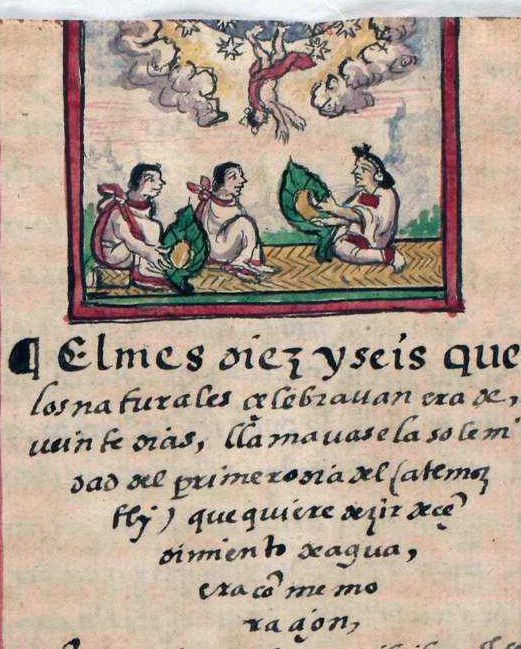
In manuscript paintings made late in the sixteenth century, we find images that depict the festivals that were scheduled according to the 365-day solar calendar. Images of these rites appear in the manuscript known as the Codex Durán. These images were painted by Indigenous artists around Mexico City in the year 1575 and the text was written by the Dominican friar, Diego Durán. One painting shows how an indigenous artist living in the colonial world depicted the ancient festival from the period of Atemoztli, a name that means “the descent of the waters.” In the painting, a group gathers upon a woven mat to eat tamales, the customary food for the celebration of this festival; the descending male figure at the top of the painting may represent the rains. Feasting was an important rite for this festival from the solar calendar; Codex Durán tells us that the tamales that the celebrants eat were considered offerings to ensure good rains and a good harvest. Unlike in the case of the Codex Borbonicus, this painting probably does not follow the format of an ancient book, since pre-Conquest references to the twenty-day festivals do not tend to include ritual scenes combined with important information about the months in the clouds. But it does show us how Indigenous artists imagined one of the festivals surrounding the agricultural cycle from the vantage point of their Colonial context.
The origins of the calendar
Manuscripts like the Codex Borbonicus and the Codex Durán show us how the calendar was visualized in the sixteenth century, but Mesoamerican calendars were in use long before that. We do not know exactly when the counts of the calendar were first adopted in Mesoamerican history, but archaeology tells us that the calendar’s past lies deep in the region’s history. On ancient stone monuments, solar calendar inscriptions appear by the first century B.C.E. in the region of Mexico’s Gulf Coast; in Oaxaca, inscriptions have been found that may date earlier still.
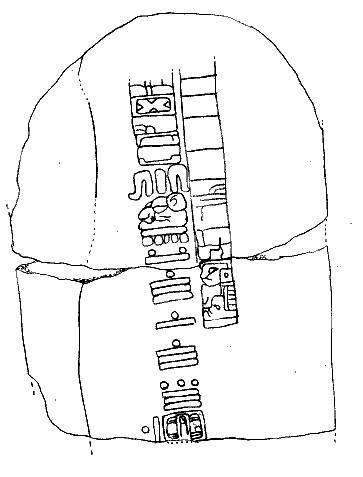
One of the oldest Mesoamerican monuments with a calendrical text is a sculpture from the site of Tres Zapotes, and it includes an inscription that notes the date of 31 B.C.E. Looking closely at its inscription, the left-hand column includes a series of numerals represented as dots above horizontal bars. This part of the text enumerates the number of days that have passed from a commonly held “start” point deep in time; the effect is that the inscription precisely names a single date that we are able to reconstruct today. Thanks to this count, we know exactly which historical moment was named in the inscription, and thanks to this monument, we appreciate the deep historical origins of calendrical monuments in Mesoamerica.
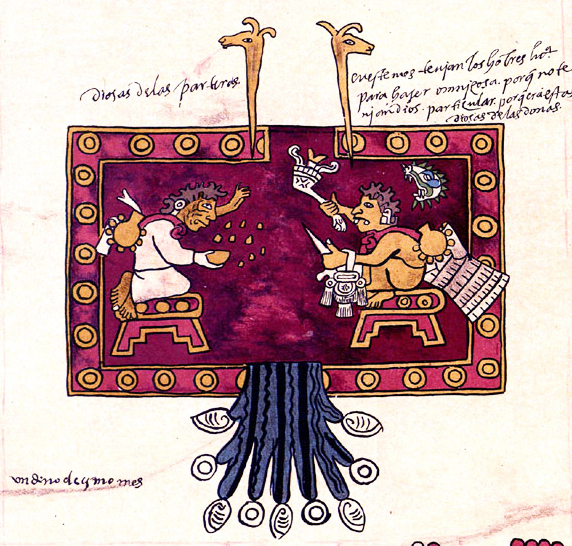
Although archaeology tells part of the story about the origins of the calendar, the Indigenous collaborators who created the Florentine Codex conveyed their ideas about the origins of the calendar. In their telling, the calendar had been invented by deities, including the feathered serpent known as Quetzalcoatl and a divine elderly couple named Oxomoco and Cipactonal; these elders are also named in other Nahuatl-language texts (including the manuscript known as the Anales de Cuauhtitlan). Indigenous peoples living in the colonial period had important beliefs about the sacred origins of the Mesoamerican calendar, beliefs that should be taken into account alongside contemporary archaeology’s story about the origins of the calendar.
Calendrical Inscriptions and Images of Power
Mesoamerican monuments show us that in some cases, calendrical information was deployed in support of images of power. This was the case in both the Maya and the Aztec worlds, where calendrical inscriptions contributed to visualizing the power of rulers.
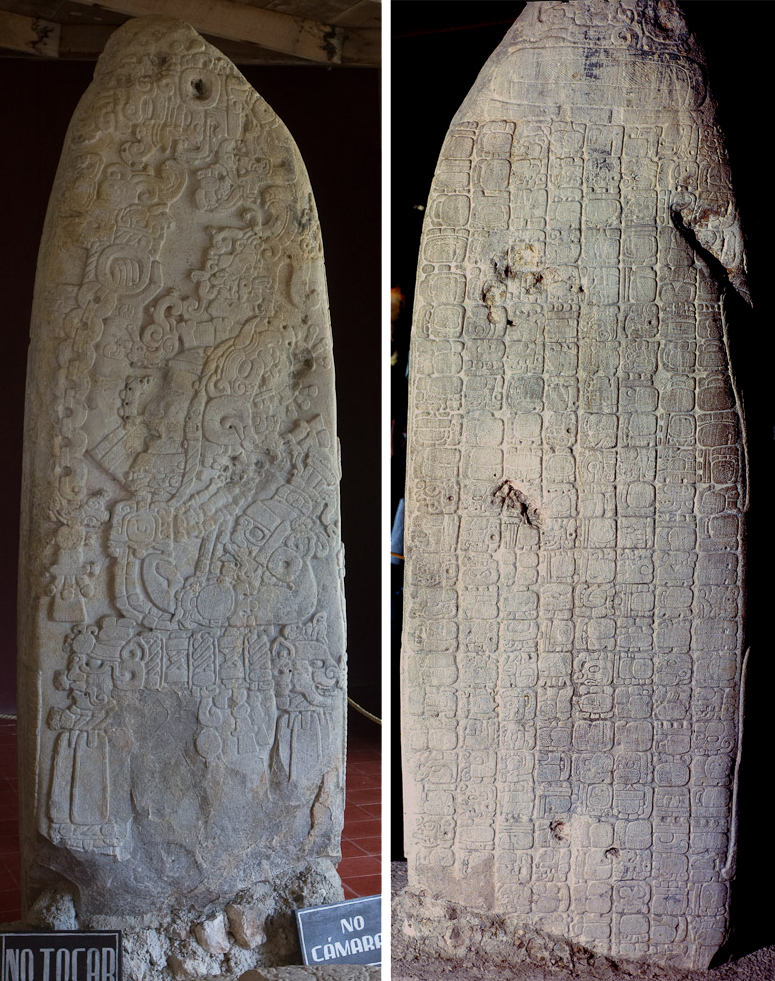
In Classic Maya art, a tradition that flourished between 250 and 900 C.E., freestanding stone sculptures (known as stelae) were a surface where Maya scribes used calendrical inscriptions to record important moments in the lives of kings, such as the dates when they were born or when they ascended to the throne. This was the case on Stela 31 from the site of Tikal in northern Guatemala. Dedicated in the fifth century C.E., the front side of the monument depicts a king from Tikal named Siyah Chan K’awiil II. In the image, he appears covered in elaborate royal finery and accompanied by images referring to his lineage.
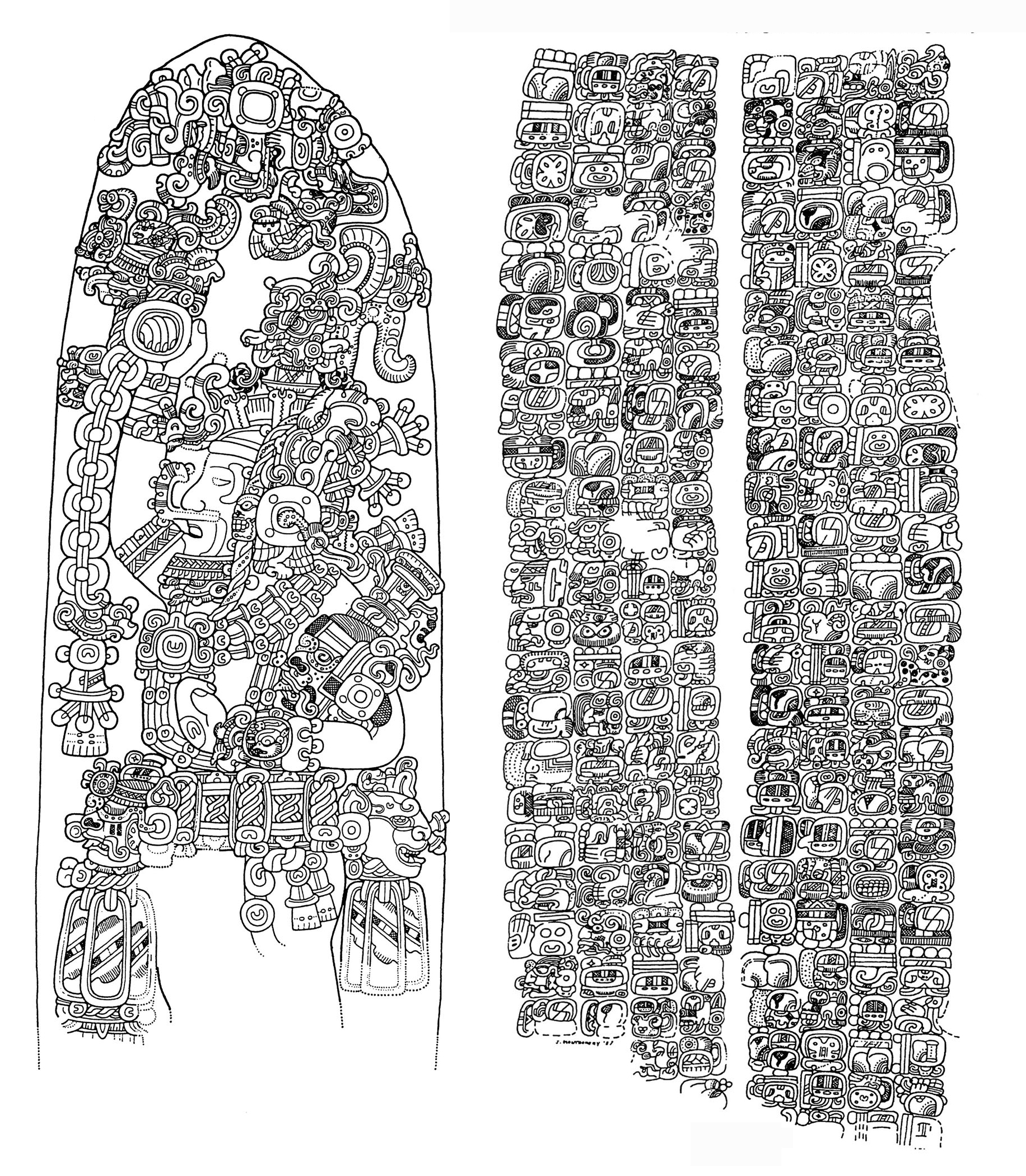
On the back of the monument, a long text describes episodes from Tikal’s history, from the moment when a foreign power took up leadership in the city in the previous century through Siyah Chan K’awiil II’s rise to the throne in 435, all the way to the moment when the stela itself was dedicated. Precise calendrical reckoning situated the events that led to Siyah Chan K’awiil II’s reign firmly in historical time and played an important role in constructing the king’s image and authority in this monumental work.

Among the Aztecs, monumental calendrical inscriptions also played an important role in constructing a ruler’s power. The Aztec Dedication Stone represents an important ceremony of royal ritual autosacrifice carried out by a deceased ruler and his successor. At the top of the work, the ruler Ahuitzotl (seen at right) is shown with his royal predecessor Tizoc (left) performing autosacrifice, drawing streams of blood from their ears with sharp perforators. Their sacrificial blood feeds a hungry earth, represented as an upturned, open maw; Aztec religion involved sacrifices in which offerings were made to the earth to ensure that cosmic order was maintained. Below this scene, the sculptor depicted a very large calendrical inscription that dominates the entire composition, associating the ritual with the date 8 Reed (or 1487–1488). With the great visual weight given to this date, this politically potent monument and its concerns around succession and rule shows the importance of graphically foregrounding historical time in an image of royal power in Aztec art. Even so, time is also interestingly manipulated on this monument. Tizoc’s death before Ahuitzotl’s ascension suggests that the time imagined in the ritual scene is likely imaginary; what mattered instead was that the new ruler appear beside his predecessor, emphasizing his continuity with royal power.
Calendar after the Spanish Conquest
In the decades that followed the Spanish Invasion of the Americas, European missionary friars became interested in the Mesoamerican calendar because they sensed that it still held a powerful influence in the communities that they sought to convert to Christianity. In the Codex Durán, Diego Durán wrote that he suspected that an Indigenous town had adopted their patron saint because his feast day fell on an important day on the ancient calendar. [2] Since many of these friars believed that the practice of the ancient calendar was a way of maintaining idolatrous practices, missionaries sought to end the use of the Mesoamerican calendar altogether.
Despite Colonial efforts at extirpation, the calendar continued to constitute an important form of knowledge in some areas of Mesoamerica long after the Colonial period. Among K’iche Maya speakers in the Guatemala highlands, for example, specialists in Mesoamerican calendrical knowledge have continued to interpret and use the calendar in the twenty-first century as an integral part of their social and political milieu. The special place accorded to calendrical knowledge in these communities today speaks to the continued relevance of the Mesoamerican calendar into our own century, as well as the prestige and status accorded to the keepers of this vital form of understanding the world.
Notes:
- Bernardino de Sahagún, Florentine Codex, Book 4: p. 85.
- Diego Durán, Book of the Gods and Rites and The Ancient Calendar, trans. Doris Heyden and Fernando Horcasitas [1971], pp. 409–410.
Additional resources:
The Ancient Future: Mesoamerican and Andean Timekeeping at Dumbarton Oaks
Elizabeth Hill Boone, Cycles of Time and Meaning in the Mexican Books of Fate (University of Texas Press, 2007).
Simon Martin and Nikolai Grube, Chronicle of the Maya Kings and Queens, 2nd ed. (Thames and Hudson, 2008).
Mary Miller, The Art of Mesoamerica from Olmec to Aztec, 6th ed. (2009).
Barbara Tedlock, Time and the Highland Maya, revised ed. (University of New Mexico Press, 1993).
Camelid sacrum in the shape of a canine
Prehistoric art around the globe
When we think about prehistoric art (art before the invention of writing), likely the first thing that comes to mind are the beautiful cave paintings in France and Spain with their naturalistic images of bulls, bison, deer and other animals. But it’s important to note that prehistoric art has been found around the globe—in North and South America, Africa, Asia, and Australia—and that new sites and objects come to light regularly, and many sites are just starting to be explored. Most prehistoric works we have discovered so far date to around 40,000 B.C.E. and after.
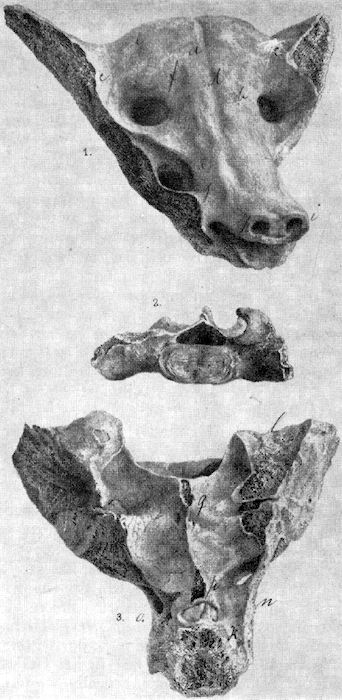
This fascinating and unique prehistoric sculpture of a dog-like animal was discovered accidentally in 1870 in Tequixquiac, Mexico—in the Valley of Mexico (where Mexico City is located). The carving likely dates to sometime between 14,000–7000 B.C.E. An engineer found it at a depth of 12 meters (about 40 feet) when he was working on a drainage project—the Valley of Mexico once held several lakes. The geography and climate of this area was considerably different in the prehistoric era than it is today.
What is a camelid? What is a sacrum?
The sculpture was made from the now fossilized remains of the sacrum of an extinct camelid. A camelid is a member of the Camelidae family—think camels, llamas, and alpacas. The sacrum is the large triangular bone at the base of the spine. Holes were cut into the end of the bone to represent nostrils, and the bone is also engraved (though this is difficult to see in photographs).
Issues
The date of the sculpture is difficult to determine because a stratigraphic analysis was not done at the find spot at the time of discovery. This would have involved a study of the different layers of soil and rock before the object was removed. Another problem is that the object was essentially lost to scholars between 1895 and 1956 (it was in private hands).
In 1882 the sculpture was in the possession of Mariano de la Bárcena, a Mexican geologist and botanist, who wrote the first scholarly article on it. He described the object in this way:
“…the fossil bone contains cuts or carvings that unquestionably were made by the hand of man…the cuts seem to have been made with a sharp instrument and some polish on the edges of the cuts may still be seen…the articular extremity of the last vertebra was utilized perfectly to represent the nose and mouth of the animal.” [1]
Bárcena was convinced of the authenticity of the object, but over the years—due to the lack of scientific evidence from the find spot—other scholars have questioned its age, and whether the object was even made by human hands. One author, in 1923, summarized the issues:
To allow us to state that the sacrum found at Tequixquiac was a definite proof of ancient man in the area the following things must be proven: (1) That the bone was actually a fossil belonging to an extinct species. We cannot doubt this since it has been affirmed by competent geologists and paleontologists. (2) That it was found in a fossiliferous deposit and that it had never been moved since it found its place there. This has not been proved in any convincing manner. (3) That the cuttings of the bone can actually be attributed to the hand of man and that it can never have occurred without human intervention. This has not been proved either. (4) That the carving was made while the species still existed and not in later times when the bone had already become fossilized. [2]
Today, scholars agree that the carving and markings were made by human hands—the two circular spaces that represent the nasal cavities were carefully carved and are perfectly symmetrical and were likely shaped by a sharp instrument. However, the lack of information from the find spot makes precise dating very difficult. It is quite common, in prehistoric art, for the shape of a natural form (like a sacrum) to suggest a subject (dog or pig head) to the carver, and so we should not be surprised that the sculpture still strongly resembles a sacrum.
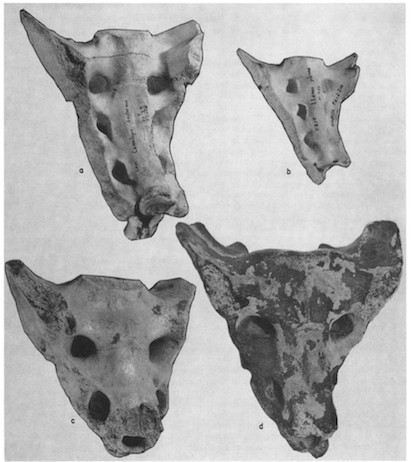
Interpretation
Because the carving was made in a period before writing had developed, it is likely impossible to know what the sculpture meant to the carver and to his/her culture. One possible way to interpret the object is to look at it through the lens of later Mesoamerican cultures. One anthropologist has pointed out that in Mesoamerica, the sacrum is seen as sacred and that some Mesoamerican Indian languages named this bone with words referring to sacredness and the divine. In English, “sacrum” is derived from Latin: os sacrum, meaning “sacred bone.” The sacrum is also—perhaps significantly for its meaning—located near the reproductive organs.
“Language and iconographic evidence strongly suggests that the sacrum bone was an important bone indeed in Mesoamerica, relating to sacredness, to resurrection, and to fire. The importance attached to this bone and its immediate neighbors is not limited to Mesoamerica. From ancient Egypt to ancient India and elsewhere, there is abundant evidence that the bones at the base of the spine, including especially the sacrum, were seen as sacred.” [3]
As appealing as this interpretation is (and the argument the author makes is quite convincing), it is wise to be wary of connecting cultures across such vast geographic distances (though of course there are some aspects of our shared humanity that may be common across cultures). At this point in time, we have no direct evidence to support this interpretation, and so we can not be certain of this object’s original meaning for either the artist, or the people that produced it.
[1] As quoted in Luis Aveleyra Arroyo de Anda, “The Pleistocene Carved Bone from Tequixquiac, Mexico: A Reappraisal,” American Antiquity, vol. 30, (January 1965), p. 264.
[2] As quoted in Luis Aveleyra Arroyo de Anda, “The Pleistocene Carved Bone from Tequixquiac, Mexico: A Reappraisal,” American Antiquity, vol. 30, (January 1965)
[3] Brian Stross, “The Mesoamerican Sacrum Bone: Doorway to the otherworld,” FAMSI Journal of the Ancient Americas (2007) pp.1-54.
Additional resources:
Luis Aveleyra Arroyo de Anda, “The Pleistocene Carved Bone from Tequixquiac, Mexico: A Reappraisal,” American Antiquity, vol. 30, (January 1965), pp. 261-77 (available online).
Paul G. Bahn, “Pleistocene Images outside of Europe,” Proceedings of the Prehistoric Society, 57, part 1 (1991), pp. 91-102.
Brian Stross, “The Mesoamerican Sacrum Bone: Doorway to the otherworld,” FAMSI Journal of the Ancient Americas (2007), pp.1-54 (pdf available online).
Tlatilco
Tlatilco Figurines
Video \(\PageIndex{4}\): Tlatilco figurines, c. 1200–600 B.C.E., ceramic, Tlatilco, Mesoamerica (present-day Mexico) (includes examples from the National Museum of Anthropology as well as the Female Figure at the Princeton University Art Museum)
We don’t know what the people here called themselves. Tlatilco, meaning “place of hidden things,” is a Nahuatl word, given to this “culture” later. Around 2000 B.C.E., maize, squash and other crops were domesticated, which allowed people to settle in villages. The settlement of Tlatilco was located close to a lake, and fishing and the hunting of birds became important food sources.
Archaeologists have found more than 340 burials at Tlatilco, with many more destroyed in the first half of the 20th century.

Intimate and lively
Tlatilco figurines are wonderful small ceramic figures, often of women, found in Central Mexico. This is the region of the later and much better-known Aztec empire, but the people of Tlatilco flourished 2,000-3,000 years before the Aztec came to power in this Valley. Although Tlatilco was already settled by the Early Preclassic period (c. 1800-1200 B.C.E.), most scholars believe that the many figurines date from the Middle Preclassic period, or about 1200-400 B.C.E. Their intimate, lively poses and elaborate hairstyles are indicative of the already sophisticated artistic tradition. This is remarkable given the early dates. Ceramic figures of any sort were widespread for only a few centuries before the appearance of Tlatilco figurines.
Appearance
The Tlatilco figurine at the Princeton University Art Museum has several traits that directly relate to many other Tlatilco female figures: the emphasis on the wide hips, the spherical upper thighs, and the pinched waist. Many Tlatilco figurines also show no interest in the hands or feet, as we see here. Artists treated hairstyles with great care and detail, however, suggesting that it was hair and its styling was important for the people of Tlatilco, as it was for many peoples of this region. This figurine not only shows an elaborate hairstyle, but shows it for two connected heads (on the single body). We have other two-headed female figures from Tlatilco, but they are rare when compared with the figures that show a single head. It is very difficult to know exactly why the artist depicted a bicephalic (two-headed) figure (as opposed to the normal single head), as we have no documents or other aids that would help us define the meaning. It may be that the people of Tlatilco were interested in expressing an idea of duality, as many scholars have argued.

The makers of Tlatilco figurines lived in a large farming villages near the great inland lake in the center of the basin of Mexico. Modern Mexico City sits on top of the remains of the village, making archaeological work difficult. We don’t know what the village would have looked beyond the basic shape of the common house—a mud and reed hut that was the favored house design of many early peoples of Mexico. We do know that most of the inhabitants made their living by growing maize (corn) and taking advantage of the rich lake resources nearby. Some of the motifs found on other Tlatilco ceramics, such as ducks and fish, would have come directly from their lakeside surroundings.


Male figures are rare
Tlatilco artists rarely depicted males, but when they did the males were often wearing costumes and even masks. Masks were very rare on female figures; most female figures stress hairstyle and/or body paint. Thus the male figures seem to be valued more for their ritual roles as priests or other religious specialists, while the religious role of the females is less clear but was very likely present.
How they were found
In the first half of the 20th century, a great number of graves were found by brick-makers mining clay in the area. These brick-makers would often sell the objects—many of them figurines—that came out of these graves to interested collectors. Later archaeologists were able to dig a number of complete burials, and they too found a wealth of objects buried with the dead. The objects that were found in largest quantities—and that enchanted many collectors and scholars of ancient Mexico—were the ceramic figurines.

Craftsmanship
Unlike some later Mexican figurines, those of Tlatilco were made exclusively by hand, without relying on molds. It is important to think, then, about the consistent mastery shown by the artists of many of these figurines. The main forms were created through pinching the clay and then shaping it by hand, while some of the details were created by a sharp instrument cutting linear motifs onto the wet clay. The forms of the body were depicted in a specific proportion that, while non-naturalistic, was striking and effective. The artist was given a very small space (most figures are less than 15 cm high) in which to create elaborate hairstyles. Even for today’s viewer, the details in this area are endlessly fascinating. The pieces have a nice finish, and the paint that must indicate body decoration was firmly applied (when it is preserved, as in the two-headed figure above). Many scholars doubt that there were already full-time artists in such farming villages, but it is certain that the skills necessary to function as an artist in the tradition were passed down and mastered over generations.
Additional resources:
Ceramics from Tlatilco (including the two headed figurine at the Princeton Art Museum)
SmartHistory images for teaching and learning:

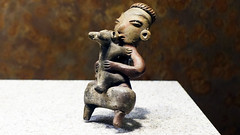

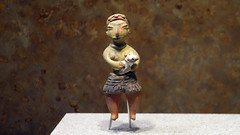


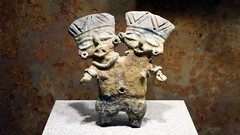


Olmec
The Olmecs flourished on the Gulf Coast, creating works in stone and jade that had a profound influence on later cultures.
c. 1200 - 400 B.C.E.
Kunz Axe (Olmec)
by DR. REX KOONTZ and DR. STEVEN ZUCKER
Additional resources:
Olmec art on the Metropolitan Museum of Art’s Heilbrunn Timeline of Art History (by Dr. James Doyle)
SmartHistory images for teaching and learning:


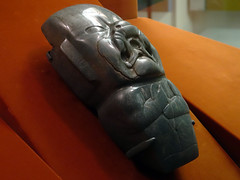
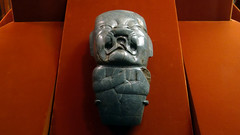
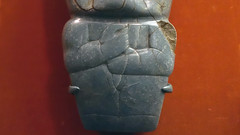
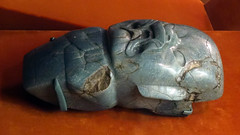
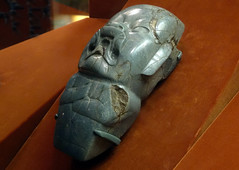
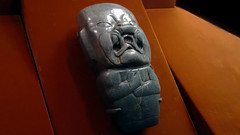
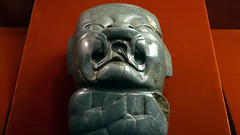
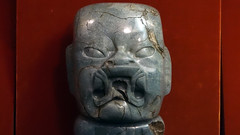
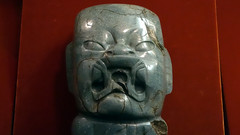
Offering #4, La Venta
by DR. BILLIE FOLLENSBEE
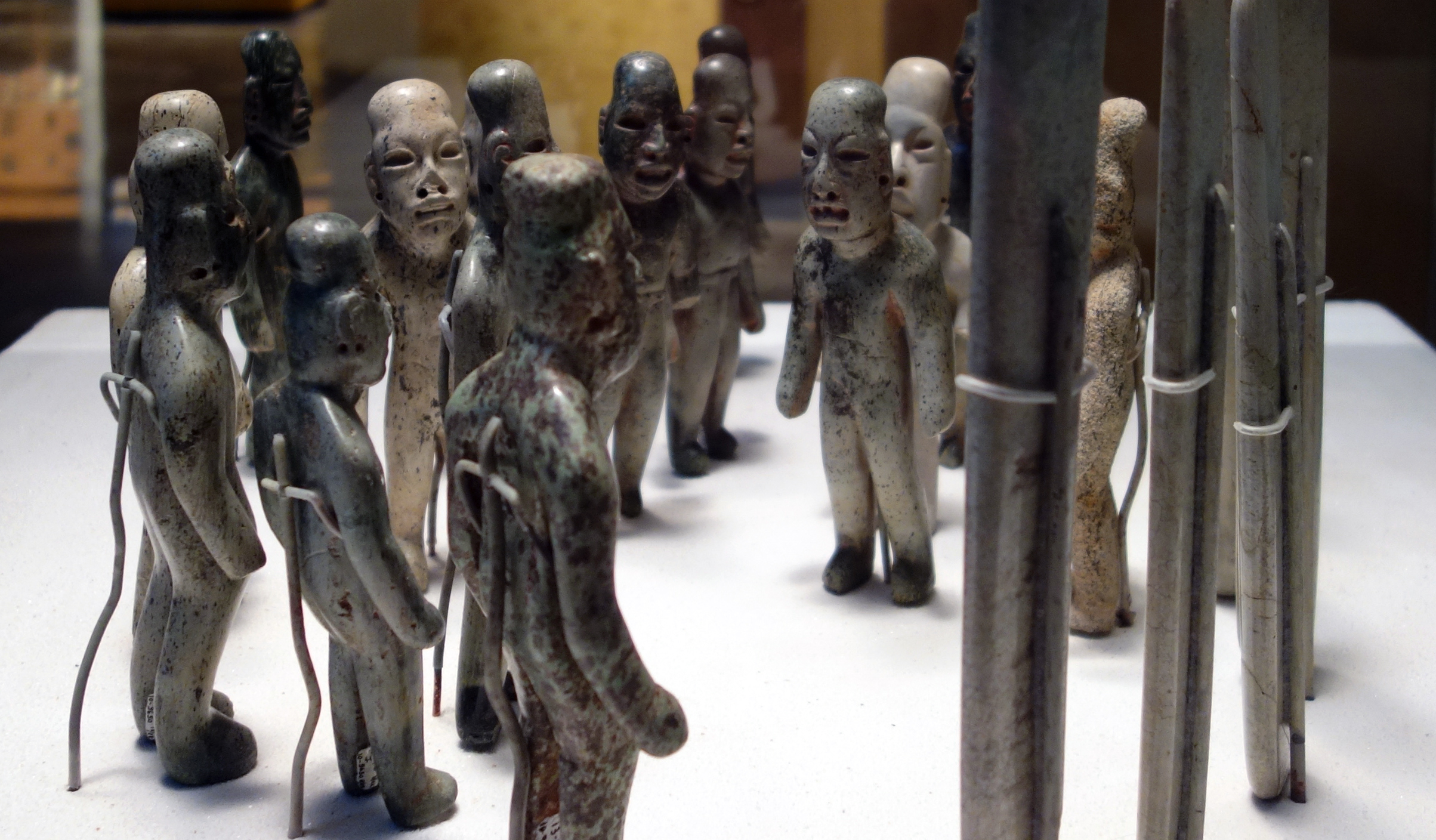
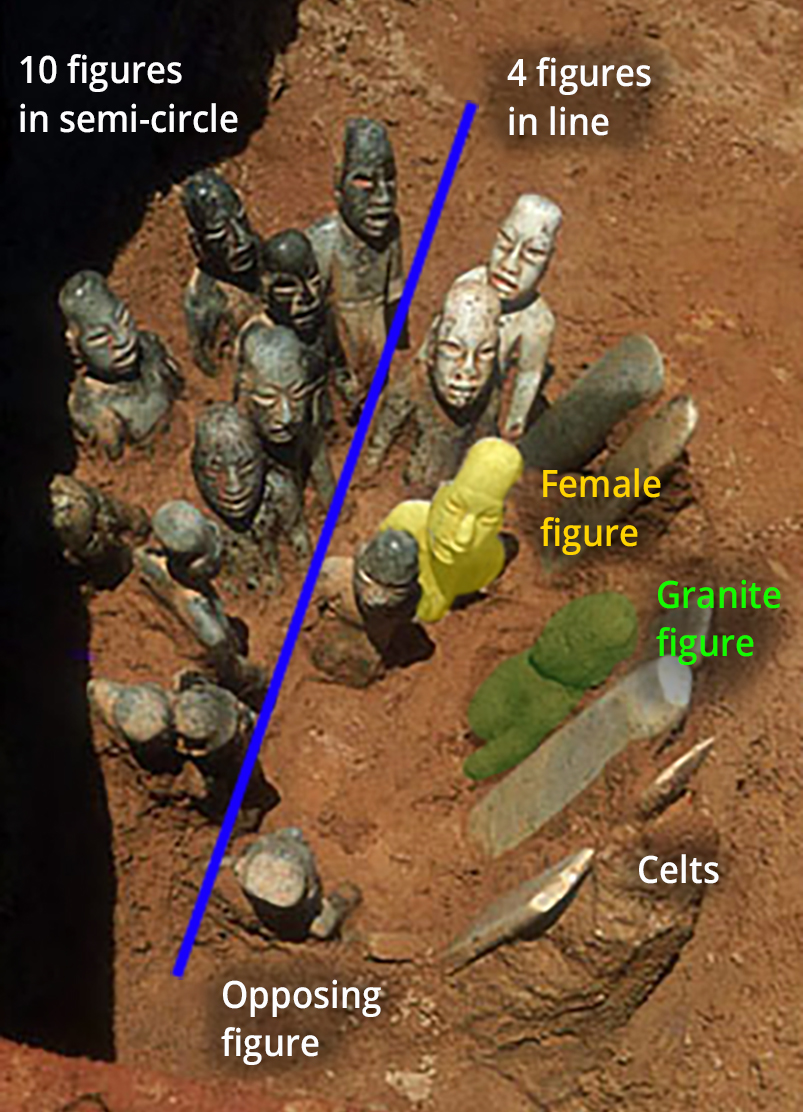
Offering #4 from La Venta is perhaps the most dramatic assemblage of Olmec small stone figures yet discovered. As found in situ (in the original place and arrangement that the Olmec people left them), the group consisted of seventeen stone figurines arranged in front of a flat row of six slender jade celts, all securely set upright in a base of sand. Only fragments remained of one figure, but the surviving sculptures illustrate a striking, enigmatic scene: A single figure stands with its back to the celts (see granite figure in diagram left), while four figures appear to process in front of this figure, apparently walking toward a fifth figure that faces them (see opposing figure in diagram). The ten remaining figures gather in a close semi-circle, facing the celts as if watching the procession.
Material and style
The material and style of this group of figures represents the artistic culmination of Olmec small stone carving. After focusing most of their efforts on making large stone sculptures during the Early Formative period (2000–1000 B.C.E.), the Olmec of the Middle Formative period began to produce these much smaller, portable stone sculptures as well.
The stone used to produce many of these sculptures also indicates the importance of Offering #4. While one unusual figure in Offering #4 is made of now-rough, eroded granite, and the fragmentary figure (likely its companion, also standing with back to the celts—not shown) was badly decomposed schistose—both victims of La Venta’s highly acidic soils—the remaining 21 sculptures are made of greenstone, a material that Mesoamericans valued above all others. Greenstone includes all green and bluish-green stones, with the most highly coveted form being jadeite, the American form of jade. Thirteen of the figures are composed of greenish serpentine, while two figures and all six of the celts are jade.
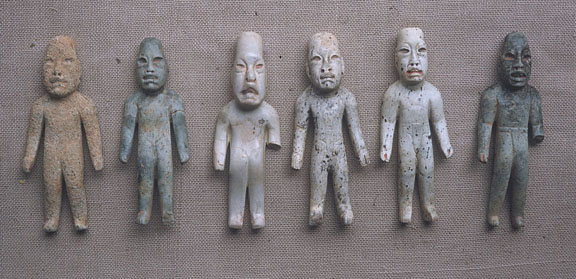 Figure \(\PageIndex{60}\): Several Offering #4 figures (granite figure first on the left; female figure third from the left), photo: 1955 (R.F. Heizer collection, National Anthropological Archives, catalogue ID: heizer_0114)
Figure \(\PageIndex{60}\): Several Offering #4 figures (granite figure first on the left; female figure third from the left), photo: 1955 (R.F. Heizer collection, National Anthropological Archives, catalogue ID: heizer_0114)
The figures all take the typically Olmec style often referred to as the “baby-face,” with an elongated head and a face with a down-turned mouth, puffy almond-shaped eyes, a triangular nose with drilled nostrils, and long, narrow ears with drilled holes in the lobes. The figures also all have nearly flat, slender bodies and take the classic pose of standing baby-face figures, with slightly bent knees and legs apart in a V, and arms held stiffly out to each side, with slightly bent elbows.
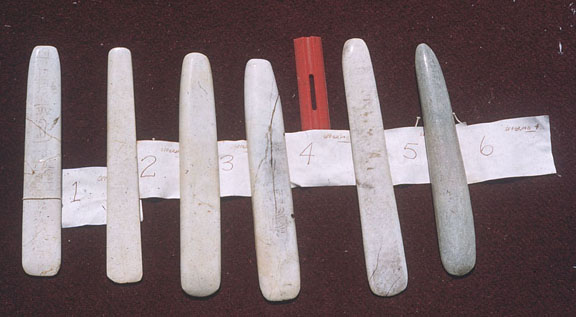
The six celts, meanwhile, are especially thin and narrow, clearly decorative objects rather than utilitarian axes or adzes.
Repurposing and recycling
Taken all together, the figures and celts of Offering #4 are similar in style, but their individualized features reveal that no single artist or workshop produced all of the sculptures; in other words, the Olmec did not create these sculptures as one group, expressly for this offering, but assembled this scene by repurposing and even recycling other small stone sculptures.
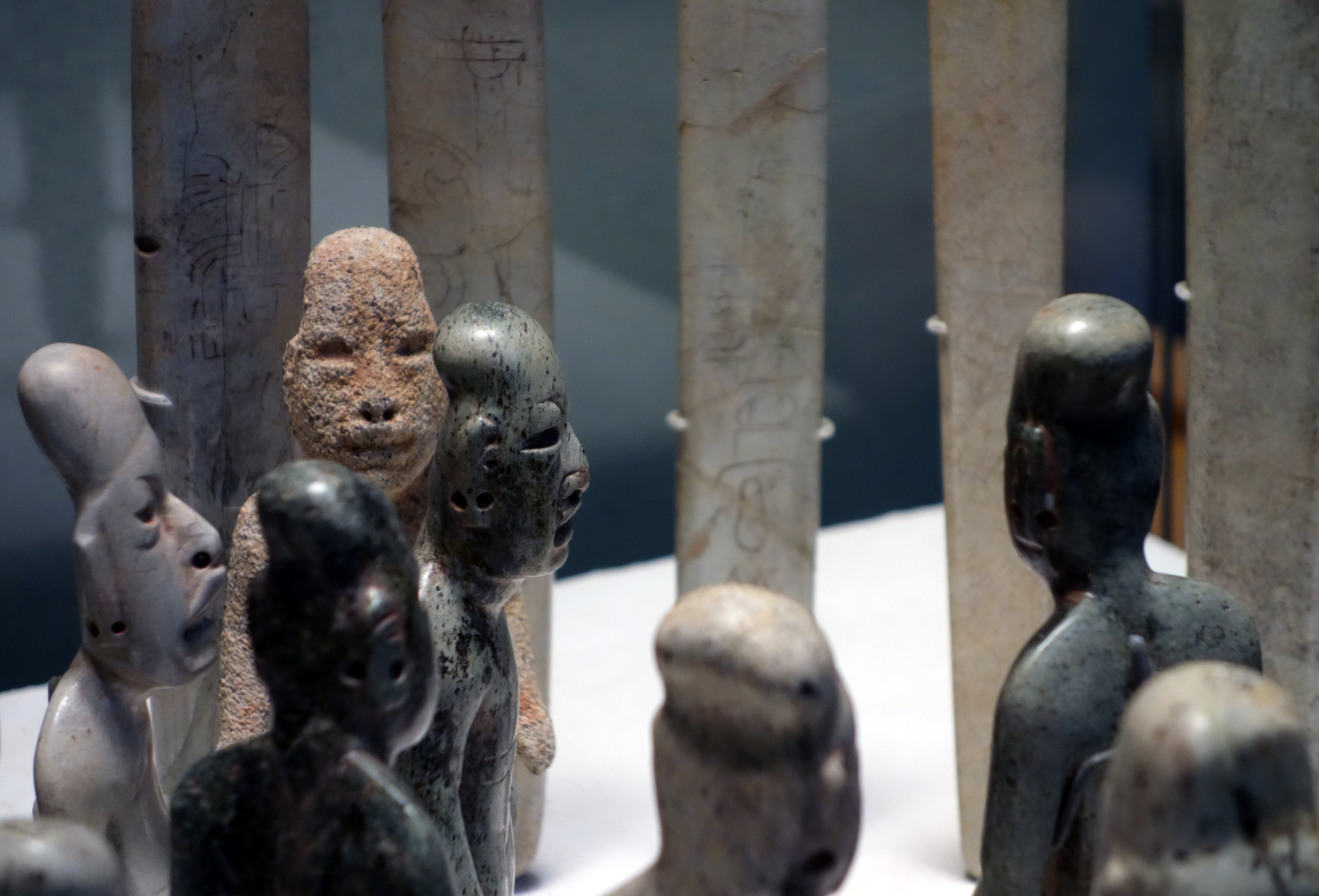
While the figures all take the classic baby-face style, they vary in color and details. Their heights and proportions vary, as do specific facial features such as the mouths; some have open, empty mouths, while others display a bare gum ridge, and still others have detailed teeth. Several figures were also already worn and broken, with missing hands, arms, or feet, when this offering was assembled. Other figures show evidence of reworking; for example, while some have deeply carved and well-modeled chest features and loincloths, others have only rudimentary, incised chests and loincloths that contrast with the original fine carving of the figure. The drilled ear holes, open poses, and elongated heads also strongly suggest that the figures may once have worn ornaments, clothing, headdresses, or possibly even wigs—and their dress could have changed for different occasions.
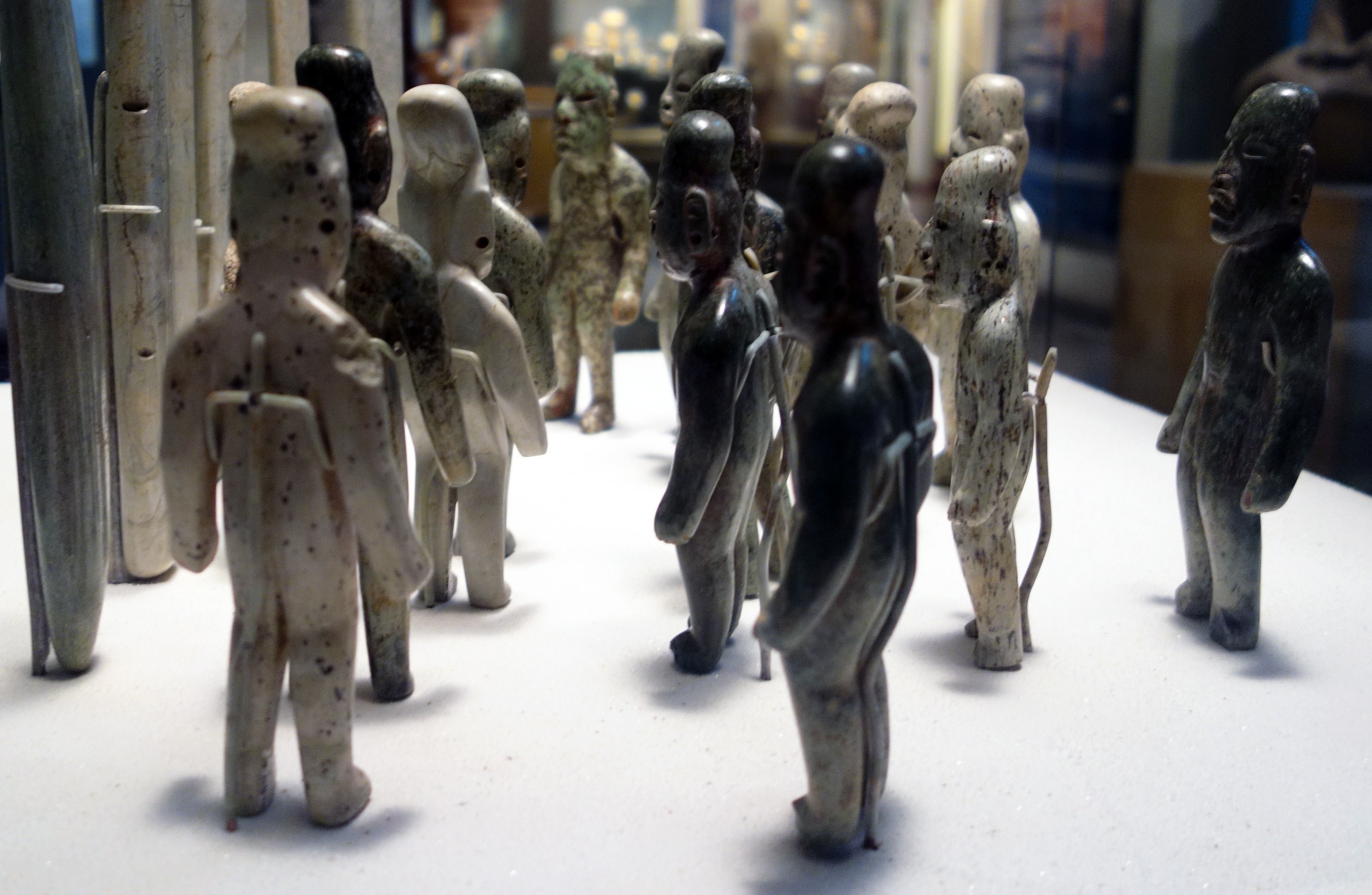

The six celts, meanwhile, may have assumed their final, thin forms for the scene portrayed in Offering #4, but four of the celts illustrate the remains of incised imagery on one side, revealing that they had previous incarnations as parts of other objects. Placing a mirror next to one celt shows that it once formed half of a jade object incised with the image of an Olmec supernatural; another celt illustrates incomplete geometric shapes. The last two incised celts reveal their secrets when placed side-by-side; together, they illustrate the image of a richly attired, prone man with his head facing forward—a well-known Olmec image called “the flying Olmec”—and show that the two celts were once part of a larger object.
None of this is surprising, however, as scholars have established that the Olmec reworked and re-carved their large stone sculptures, sometimes completely transforming them into other sculptures, and that the Olmec arranged and re-arranged large stone sculptures into different historical or mythological scenes. La Venta Offering #4 offers strong evidence that the Olmec likewise used and re-used figurines and celts to create scenes on a smaller scale
Possible meanings
The meaning of the scene portrayed in Offering #4 has long been a mystery, although most scholars concur that it represents some sort of important mythological or historic event. Some have speculated that the scene might portray a group of priests involved in an important ritual or procession to honor a visiting dignitary, or that perhaps it is a gathering to prepare a human sacrifice. Recent research has established that the row of celts forming the backdrop of the scene likely represent stelae—upright standing stones that are often covered in relief sculpture—and that the scene therefore takes place at an important site. Other studies have revealed that two of the figures–the second figure in the procession and one figure in the on-looking crowd—have chest and groin features suggesting that they are female.
The female in the procession is one of the two jade figures, and it is the most stylized figure of Offering #4, with an especially large head and a very light blue-green color. The other jade figure is the figure facing the procession—a larger, finely carved male figure of bright green jadeite that wears a prominent incised loincloth. If the jade material was particularly significant, these two figures might be interpreted as the main actors of the event, with the remaining figures of the procession perhaps acting as attendants, and the granite figure facing the crowd (and possibly the now-disintegrated schistose figure) acting as priest or important witness. If so, Offering #4 might represent a meeting of two dignitaries, the establishing of an important alliance, or, if the jade figure in the procession is in fact female, even the marriage of two people of high status—all types of scenes that also appear to be recorded in Olmec relief sculpture (see below).
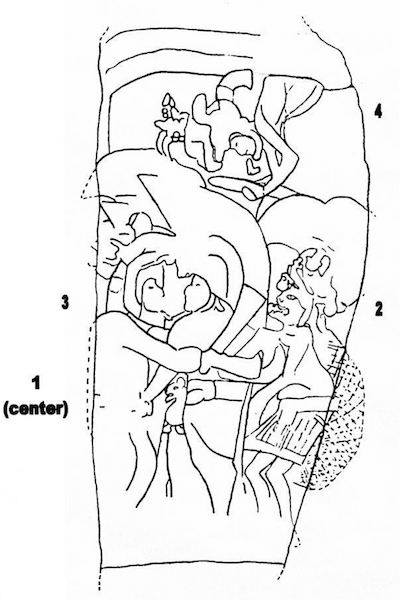
An important offering
Whatever the meaning behind Offering #4, the Olmec clearly assembled the objects into this scene as an important offering, since before the figures were placed into position, they were covered in red cinnabar and hematite pigment—a treatment reserved for high-status offerings and burials. The Olmec also completely buried the scene in specially cleaned, pure white sand immediately after they placed the figures and celts into position, then covered the mound of sand with clean fill, and finally constructed a large platform on top.
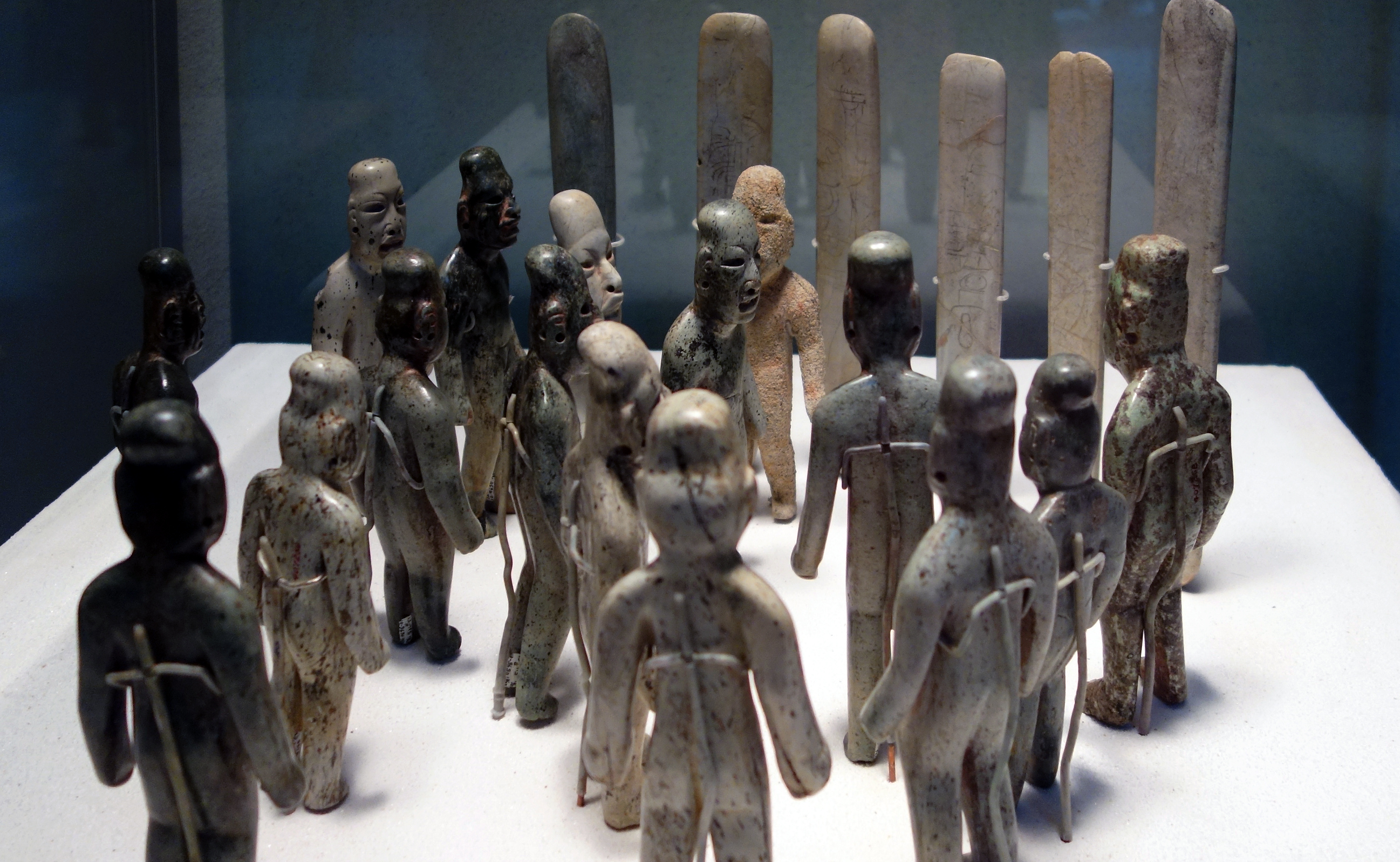
Offering #4 and the event that it commemorates apparently lingered long in Olmec collective memory as well. According to the original excavation reports, about 100 years after the original deposit, a later generation dug a small, precisely oriented oval pit down through four layers of platform flooring, through the fill, and into the white sand of the deposit. However, they dug just down to the tops of the celts and the figurines’ heads, as if to check and verify that the scene was undisturbed—and then immediately reburied them once again.
Additional resources:
Olmec art on the Metropolitan Museum of Art’s Heilbrunn Timeline of Art History (by Dr. James Doyle)
Phillip Drucker,, Robert F. Heizer, and Robert Squier. Excavations at La Venta (Tabasco. Smithsonian Institution Bureau of American Ethnology Bulletin 170. U.S. Government Printing Office, Washington, DC.,1959), pp. 152-161 and plates 30-36.
SmartHistory images for teaching and learning:

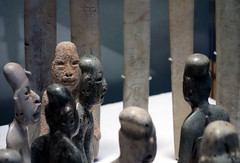
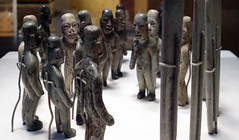

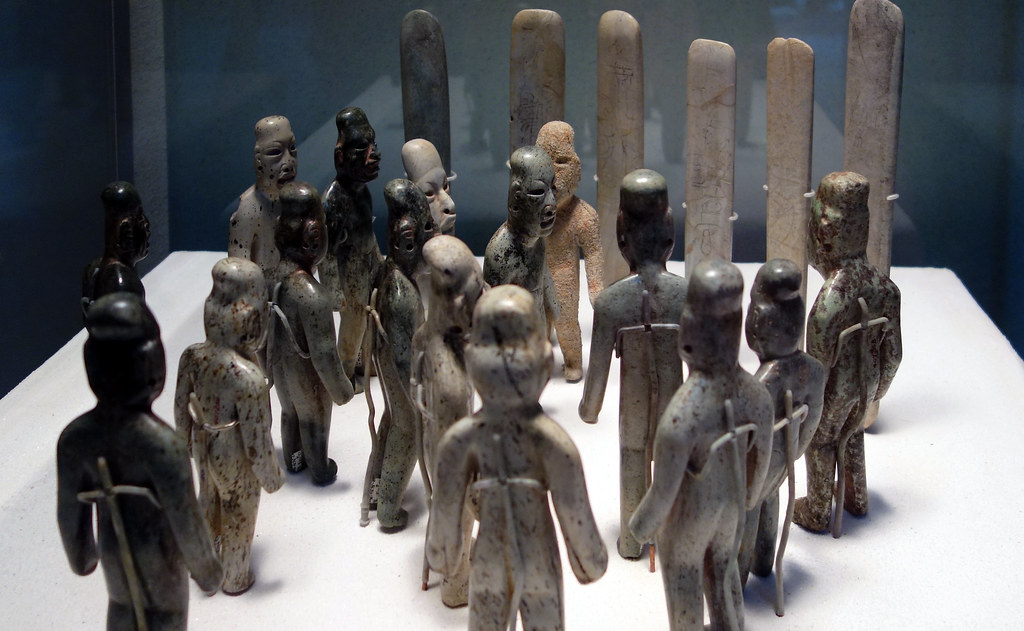
Olmec Jade

Jade votive axe
The Olmec fashioned votive axes in the form of figures carved from jade, jadeite, serpentine and other greenstones. The figures have a large head and a small, stocky body that narrows into a blade shape. They combine features of a human and other animals, such as jaguar, eagle or toad. The mouth is slightly opened, with a flaring upper lip and the corners turned down. The flaming eyebrows seen on this example are also a recurrent feature, and have been interpreted as a representation of the crest of the harpy eagle.
Most axes, including this one, have a pronounced cleft in the middle of the head. This cleft has been interpreted by scholars variously as the open fontanelle (soft spot) on the crown of newborn babies, the deep groove in the skull of male jaguars, or that found on the head of certain species of toads. In some instances vegetation sprouts out of some of them. These combinations of human and animal traits and representations of supernatural beings are common in Olmec art.
Jade perforator

Perforators were used in self-sacrifice rites, which involved drawing blood from several parts of the body. Some representations of Olmec rulers show them holding bloodletters and/or scepters as part of their elaborate ritual costume.
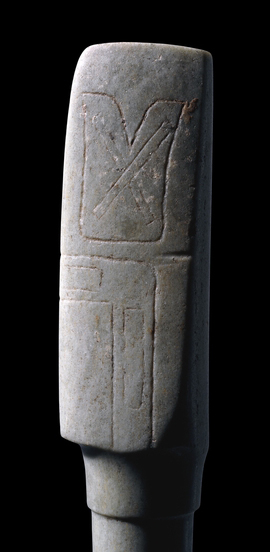
Bloodletting was performed by the ruler to ensure the fertility of the land and the well-being of the community. It was also a means of communication with the ancestors and was vital to sustain the gods and the world. These rituals were common throughout Mesoamerica.Olmec jade perforators are often found in graves as part of the funerary offerings. Bloodletting implements were also fashioned out of bone, flint, greenstones, stingray spines and shark teeth. They vary in form and symbolism. Handles can be plain, incised with a variety of symbols associated to certain deities, or carved into the shape of supernatural beings. The blades, ending in a sharp point, are sometimes shaped into the beaks of certain birds, such as the hummingbird, or into a stingray tail.
This large perforator was probably not used as a bloodletting instrument; it might have been placed in a grave as an offering, or may have served a symbolic function.
Jade pectoral

This pectoral (chest ornament), broken on both sides, was carved by an Olmec artist and reused by the Maya, as shown by the two Maya glyphs on the left side. The edges framing the head at the top and bottom indicate that it could also have been part of a larger pectoral.
Jade objects in Olmec style have been found throughout Mesoamerica and as far south as Costa Rica. Those found in areas of Mexico, Belize, Guatemala and Honduras, are decorated with different motifs and shapes from those found in the Olmec heartland, centered in present-day Southern Veracruz and Tabasco.
Although contacts between the Maya area and the Olmec heartland seem to have been limited, jade objects in Olmec style appear in Maya deposits dated to the Middle Preclassic (about 1000-400 B.C.E.). Its presence was probably the result of contact between the two areas or with areas that shared the same cultural traditions and similar imagery. Objects found in later deposits, for example at the Cenote of Sacrifice, in Chichen Itza, an Early Postclassic site (900-1200 C.E.), would have been reused over generations or found in earlier graves.
This portrait is a remarkable example of the finest Olmec lapidary art. It was designed to be worn as a pectoral and the pair of Maya name glyphs inscribed on one flange indicate that it was later reused by a Maya lord as a treasured heirloom. Unusually the glyphs are drawn backward so that they face the Olmec portrait, hinting at the power of the object as a symbol of ancestral, dynastic authority. The depressed iris of the eyes and the pierced nose probably bore additional shell work and ornament.
Suggested readings:
Michael Coe, The Olmec World: Ritual and Rulership (Princeton, N.J., Art Museum, Princeton University in association with Harry N. Abrams, 1996).
E. Benson (ed.), The Olmec and their neighbors (Washington, DC, Dumbarton Oaks, 1981).
E. Benson and B. de la Fuente (eds.), Olmec art of ancient Mexico (Washington, National Gallery of Art, 1996).
C. McEwan, Ancient Mexico in the British (London, The British Museum Press, 1994).
© Trustees of the British Museum
Olmec mask
by DR. LAUREN KILROY-EWBANK and DR. STEVEN ZUCKER
The Olmecs are known as “rubber people,” a name given to the peoples of the Gulf Coast after the Spanish Conquest. We don’t know what they called themselves.
Items buried in offerings included ceramic vessels, stone sculptures, obsidian blades, seashells, greenstone, and objects gathered from earlier locales (like Olmec sites and the city of Teotihuacan). Jadeite was quarried in the Sierra de las Minas in Guatemala, and was imported to the Gulf Coast of Mexico. Items acquired via trade or tribute (by the Aztecs) included feathers, obsidian, jadeite, cotton, cacao, and turquoise.
Additional resources:
Olmec art on the Metropolitan Museum of Art’s Heilbrunn Timeline of Art History (by Dr. James Doyle)
SmartHistory images for teaching and learning:
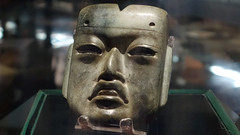
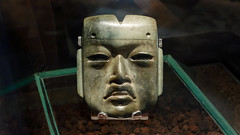
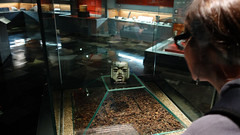
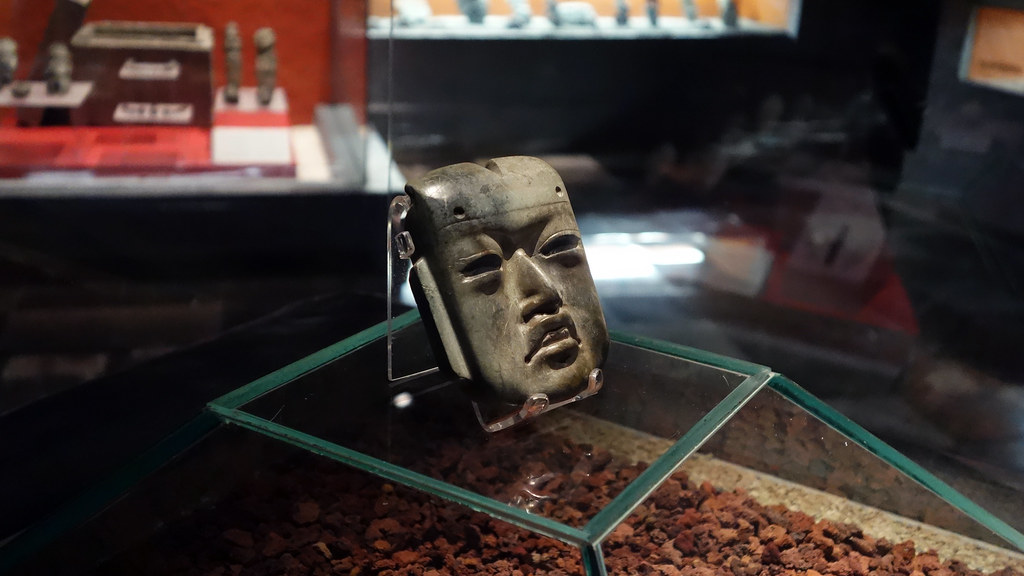
Olmec mask at The Metropolitan Museum of Art
by THE METROPOLITAN MUSEUM OF ART
Video \(\PageIndex{7}\): Mask, 10th–6th century B.C., Olmec (Mexico), jadeite, 6 3/4 x 6 5/16″ / 17.1 x 16.5 cm (The Metropolitan Museum of Art, New York). Video from The Metropolitan Museum of Art.
Additional resources:
Olmec art on the Metropolitan Museum of Art’s Heilbrunn Timeline of Art History (by Dr. James Doyle)
Olmec figurine
Hollow pottery figures such as this are referred to as “baby-faces,” since their plump bodies and facial features are similar to those of an infant. The eyes are almond-shaped, elliptical, or a simple slit. A protruding head, probably the result of cranial deformation, is another common feature. They are usually seated, with legs spread and arms raised or resting on their legs. Infants were a recurring theme in Olmec art.
Baby-face figurines

Baby-face figurines often present a mixture of human and animal traits, with features such as a feline mouth with down-turned low corners, a flaring upper lip and ‘flaming’ eyebrows. Their bodies are naked and show no indication of gender. These “were-jaguar” infants are also carved on monumental altars and stone sculptures, lying on the lap or in the arms of a person.
The different sections of the body were produced separately and joined together at a later stage. The finished product was covered by a thick white slip and then polished to a lustrous appearance. Red cinnabar or haematite powder was often applied to highlight symbolic details or features incised on the figures. These pigments were also used in human burials and probably had a significant role in Olmec rituals.

One rare find of a group of Olmec figurines, excavated in situ, revealed standing figures arranged in a semicircle, apparently engaged in an act of collective veneration or worship. This figure may once have formed part of such a scene.
© The British Museum
Olmec stone mask

This mask was probably worn around the neck as a pendant and may have given the wearer a new identity, perhaps that of an ancestor or a god. It was made by the Olmecs, the earliest known settled civilization of Central America.
The Olmec
The Olmecs lived in the low-lying Gulf Coast area of what is now Mexico in about 1200-400 B.C.E. at sites such as San Lorenzo, Tres Zapotes, Laguna de los Cerros and La Venta.
These and the other Olmec centers were well planned and included many of the features that would be associated with later civilization in Central America including the Mexica (Aztecs) and Maya. Alongside impressive public spaces and large platform-mounds made of earth, there is evidence of a ceremonial ball game and complex astrological calendars.
Olmec art is very distinctive and clearly reflects their religion. Jaguars feature prominently because the Olmecs believed that, in the distant past, a union between a woman and a jaguar produced an earlier race of were-jaguars.
The Olmecs worked mainly in stone and particularly favored jade, or greenstone, which they believed had distinctive properties linked with fertility and procreation. These sought-after materials were brought into the region through long distance trade networks.
Earliest known writing in America

The head above is made from a dark green stone called serpentinite and would have been worked by skilled craftspeople using hand tools.
On either side of the mouth (detail above) there are two Olmec glyphs (picture signs). Olmec glyphs are the earliest known writing in America. These fine-line motifs symbolically define the four quarters of the human world with the king as ruler at the center. The Olmec art style is found on objects as far afield as the Valley of Mexico to the north and the Pacific coast of Chiapas to the south. This suggests a widely-shared set of beliefs that was to have a profound influence on many later Mesoamerican stylistic traditions.
Suggested readings:
M. Coe, et al., The Olmec World: Ritual and Rulership (New York, 1996).
R. Diehl, The Olmecs: America’s First Civilization (London, 2004).
M. Miller, and K. Taube, The Gods and Symbols of Ancient Mexico and the Maya: An Illustrated Dictionary of Mesoamerican Religion (London, 1993).
C. Pool, Olmec Archaeology and Early Mesoamerica (Cambridge, 2007).
K. Taube, Olmec Art at Dumbarton Oaks (Washington D.C., 2004).
S.T. Evans, Ancient Mexico and Central America: Archaeology and Culture History (London, 2008).
© Trustees of the British Museum
Teotihuacan
Metropolis
An impressive city of 125,000-200,000 inhabitants, by the 6th century, Teotihuacan was the first large metropolis in the Americas. Teotihuacan, as the city is called, is a Náhuatl name that means “the place where the gods were created” and was given by the Aztec centuries after it was abandoned in the 7th century. The Aztecs attributed names and significance to its buildings but had no contact with this earlier culture. Very little is known of the people who built Teotihuacan, and as a result much of our knowledge of the site, its art, and Teotihuacan culture is derived from Aztec sources. Largely created before 250 C.E., Teotihuacan is a testament to the ambition of its people, who built the first American city on a grid plan.
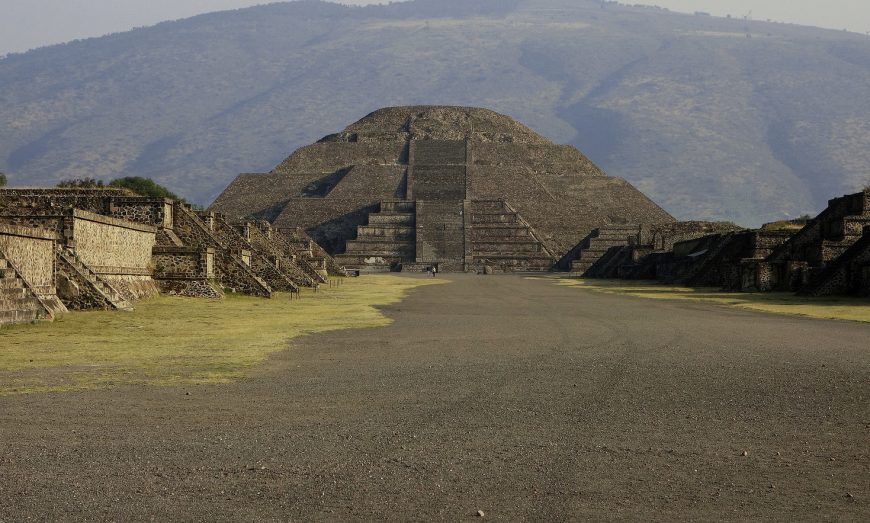
Figure \(\PageIndex{77}\): Pyramid of the Moon seen from the Avenue of the Dead with Cerro Gordo in the distance, Teotihuacan, Mexico
Due to an absence of (or as of yet undiscovered) royal palaces and graves, the lack of evidence for a cult of personality, and the as-of-yet undeciphered hieroglyphs, the governing system of Teotihuacan remains largely elusive to scholars. Nevertheless, the dramatic monumental architecture and dense urban fabric reveal a complex environment carefully planned to support a large population but also structured by the surrounding natural environment and in relation to specific constellations and planetary events. In keeping with the stratified nature of other Mesoamerican societies, Teotihuacan also benefitted from rulers, or a ruling elite, who commissioned massive architectural landmarks such as the Pyramids of the Sun and Moon, and who spread Teotihuacan’s sphere of influence throughout Mesoamerica—even into the Maya region as far away as Guatemala.
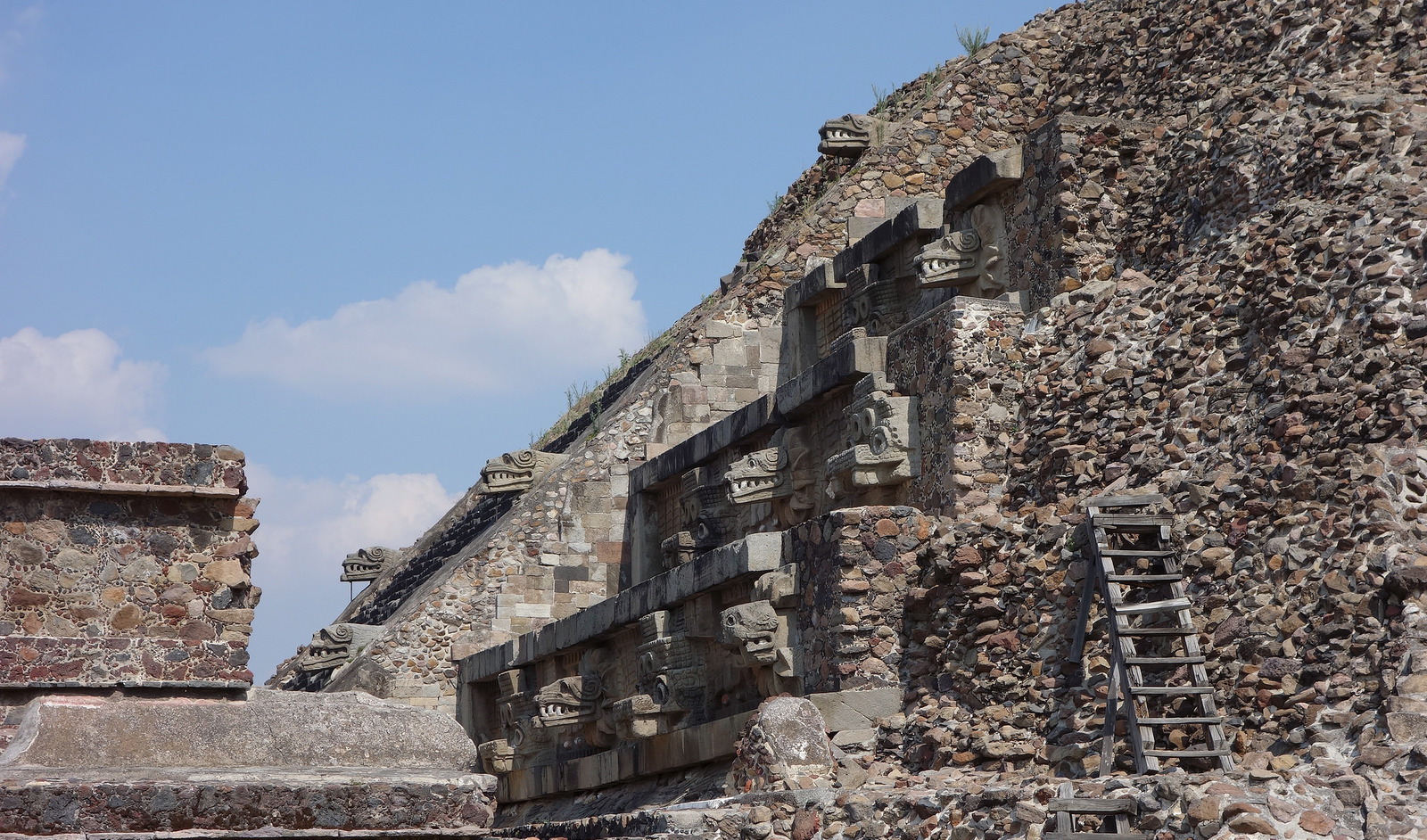
Plan and pyramids
The city of Teotihuacan is aligned, like other Mesoamerican cities such as La Venta, on a north-south axis. This alignment is made explicit by the central artery, known as the Avenue of the Dead, which extends more than 1.5 miles across the city. Entering the city from the south, the Avenue of the Dead leads visitors to the city’s three main architectural monuments, the Ciudadela, a sunken plaza at the southernmost tip that contained temples, including the Pyramid of the Feathered Serpent (above), the Pyramid of the Sun further down the avenue (below), and the Pyramid of the Moon (top of page) located at the northernmost point. In the distance and behind the Pyramid of the Moon, visitors can also catch a glimpse of the impressive Cerro Gordo, an extinct volcano that frames the pyramid and demonstrates the harmonious relationship between architecture and natural topography. Running perpendicular to the Avenue of the Dead another street follows the San Juan River. These axes help to define the grid of intersecting horizontal and vertical corridors that structure and organize the city plan. The urban grid helped to establish order for religious, domestic, and commercial complexes and a structural coherence that supported the management of the city and its population. Thousands of apartment complexes also reflect the ordered planning of the site.
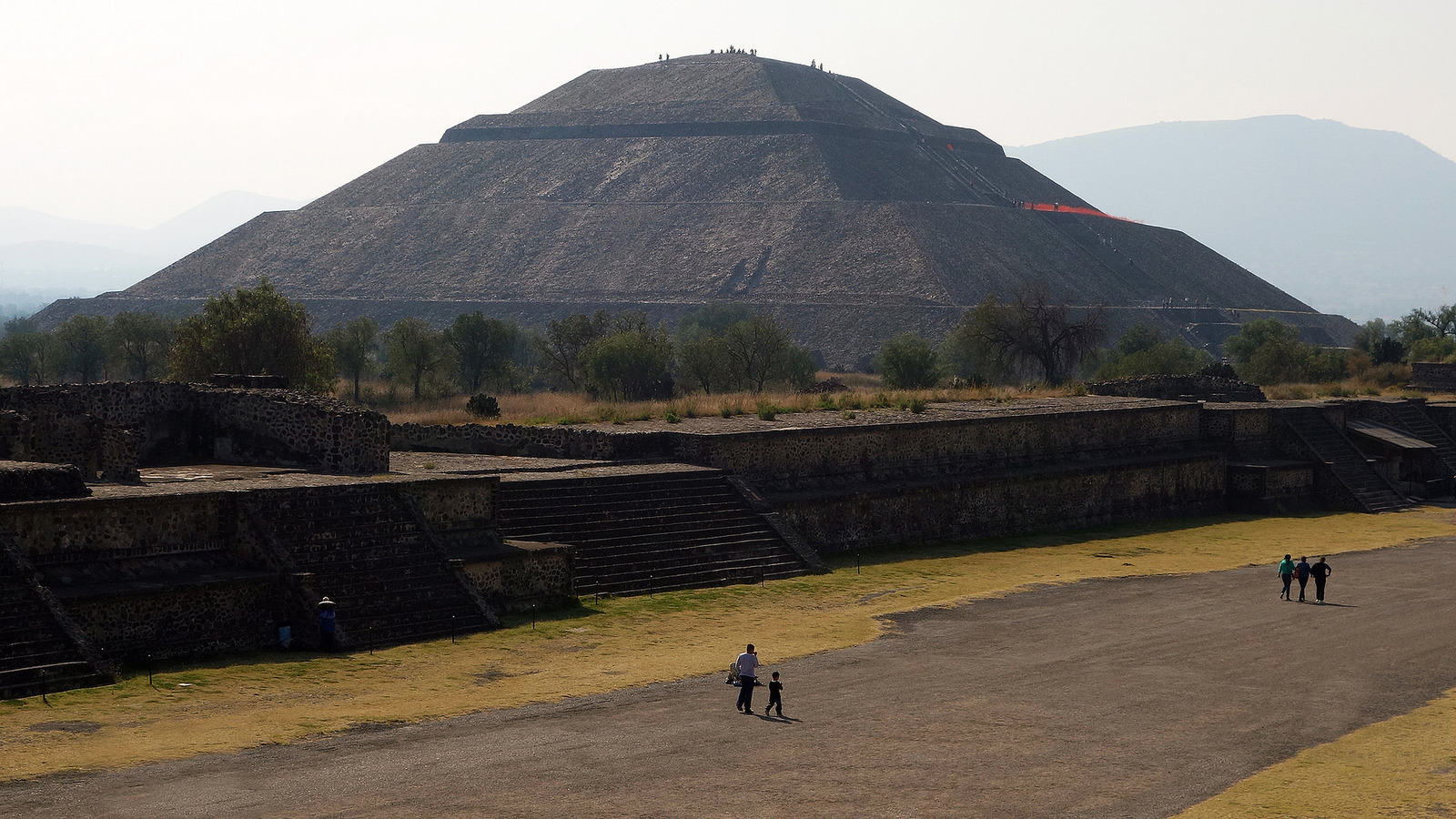
The Pyramid of the Sun, which reaches a height of over 200 feet, was the tallest structure in the Americas at the time. Built over a cave, it is unclear who, or what, the pyramid was built to commemorate although art historians have suggested that creation mythology may be at issue, since Aztec and Maya sources refer to caves as places of origin and fertility. The pyramid was meant to be viewed and approached from the East. Visitors can still climb the pyramid’s steep staircase, which originates near the Avenue of the Dead and rises over five levels to what is now a bare flattened top (above). Keep in mind that this pyramid was heavily reconstructed in the modern era, so its original shape may have appeared somewhat differently than it does today.
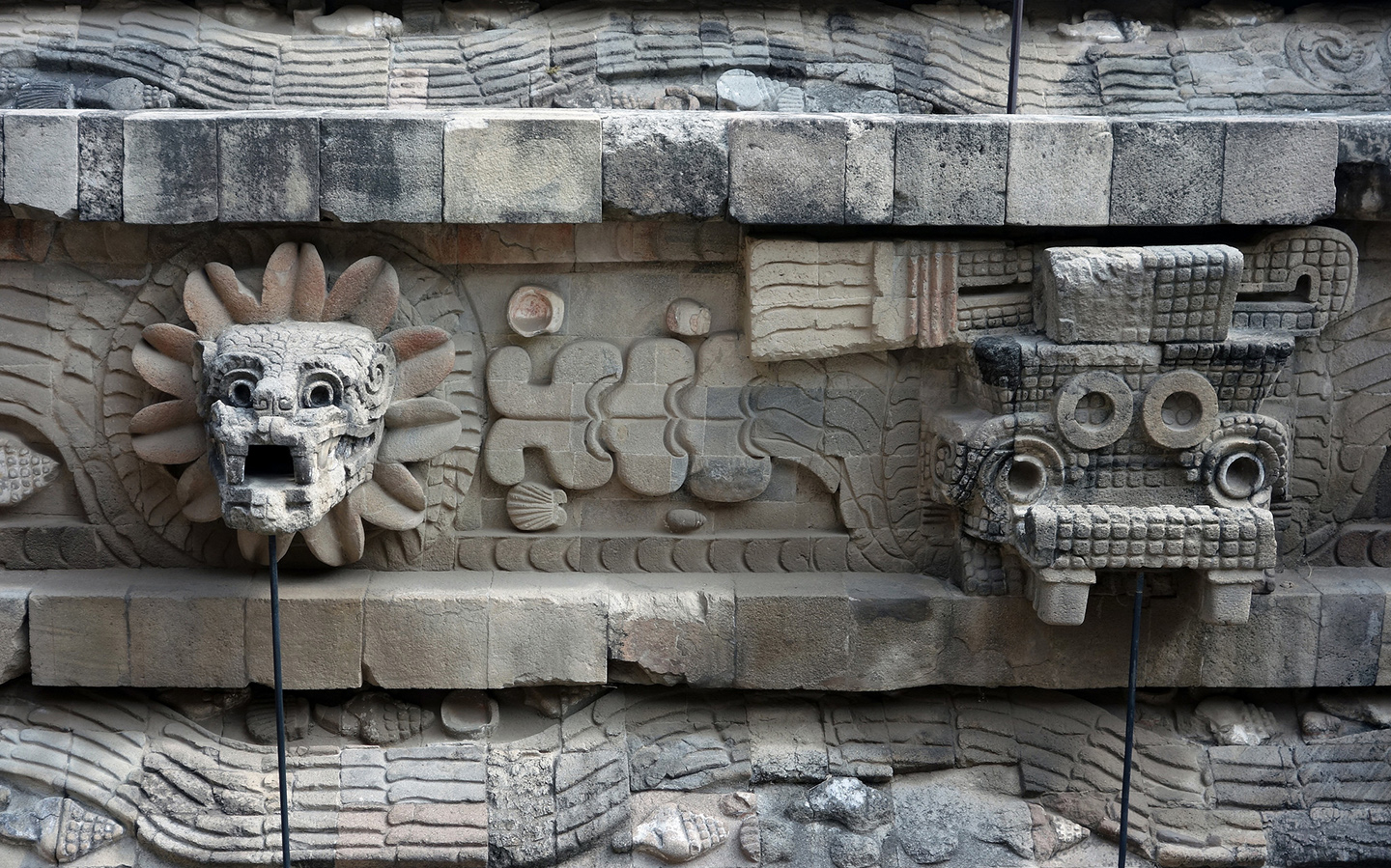
The Pyramid of the Feathered Serpent occupies a prominent place in the Ciudadela, a large open space that offers a respite from the massive presence of the Pyramid of the Sun and Pyramid of the Moon. Like so much else at Teotihuacan, the Pyramid of the Feathered Serpent was built in the talud-tablero style. The temple stands out for its sculptural ornamentation depicting the feathered serpent, known by its Aztec name Quetzalcoatl. The feathered serpent is associated with water imagery and is depicted numerous times on the exterior of the temple as an undulating snake navigating among seashells (above). Two faces project outwards, one of which depicts the feathered serpent (above left). The identification of the other head is more challenging. One interpretation is that it represents an early version of the Aztec god Tlaloc (known for his goggled eyes) and associated with rain and warfare (above right). However, some scholars identify the head as an early precedent of Xiuhcoatl, or Fire Serpent, and who was associated with warfare, fire, and time (or the calendar). Most scholars agree that the temple was associated with warfare and human sacrifice, as confirmed by numerous skeletal remains (presumably of warriors) that were discovered by archeologists in the 1980s. Speculation has also arisen about whether the Pyramid of the Feathered Serpent may have contained the body of a ruler.
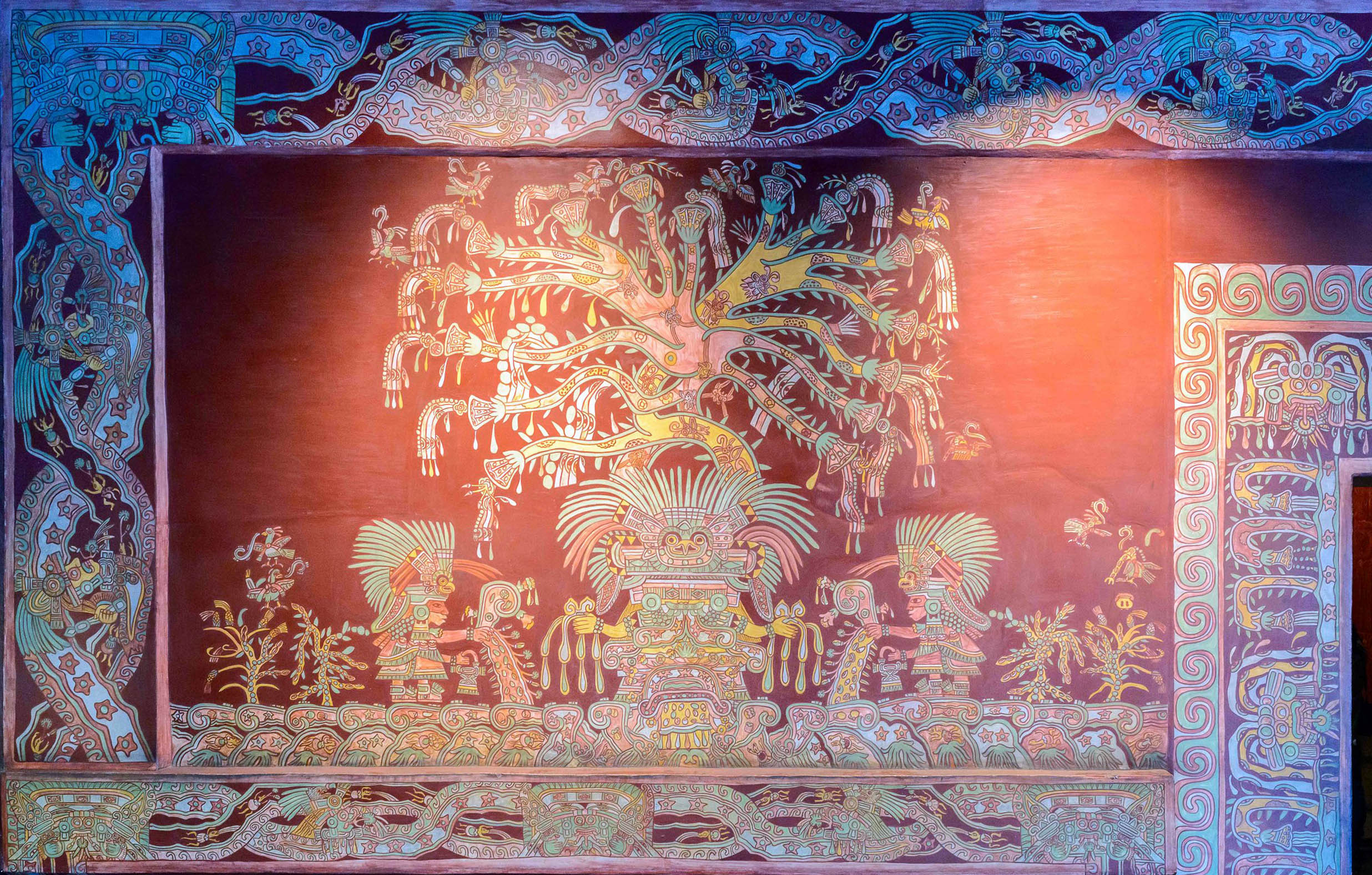
Paintings
Teotihuacan was a heavily painted site, with murals found throughout the city. For example on the walls of the apartment complex in the Tepantitla district, we find an elaborate mural showing a figure often identified as the Great Goddess and more recently as a mountain-tree. The female figure stands frontally while a blossoming tree with butterflies and spiders emerges from her head (potentially a reference to the heavenly realm), while her feet remain attached to the underworld. The inverted u-shape found below the mountain-tree may function as a symbolic womb, similar to the cave found at the Pyramid of the Sun.
The identity of the two individuals to her side, possibly priests, have sparked interest. Considering the cosmopolitan nature of the city, it had been thought that Teotihuacan’s figurative art was not portraiture, but rather generic representations that sought to unify a diverse population. Recently however, some painted signs have been recognized as representing the names of individuals, leading to a re-examination of whether Teotihuacan artists portrayed specific individuals and reminding us that there is still much to learn about this complex and ancient city.
Archeologists have dated the city’s collapse to the seventh century when many of Teotihuacan’s buildings were destroyed.
SmartHistory images for teaching and learning:



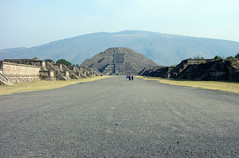
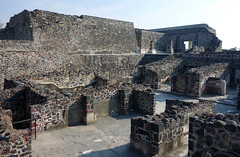
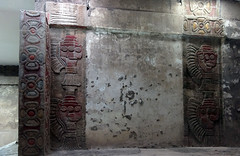

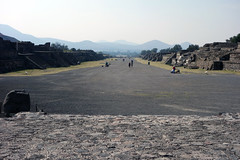
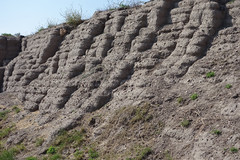
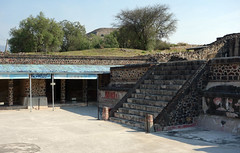
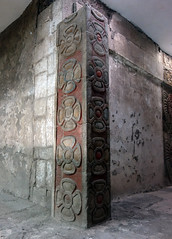

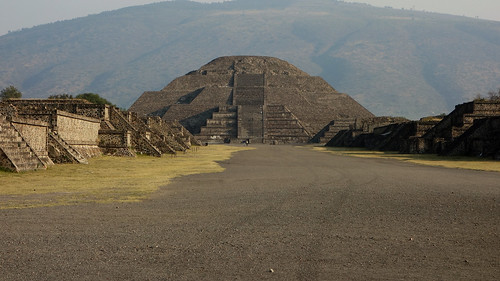
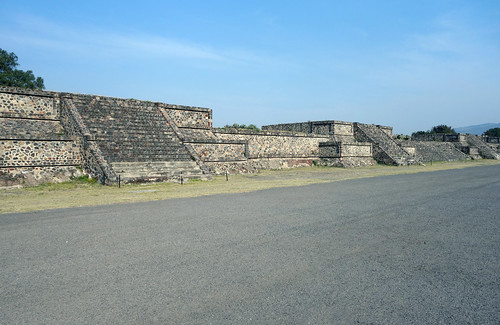
Classic Veracruz culture
The Mesoamerican ballgame and a Classic Veracruz yoke
by DR. REX KOONTZ and DR. STEVEN ZUCKER
Video \(\PageIndex{9}\): Yoke, c. 1 – 900 C.E., Classic Veracruz culture, greenstone, 11.5 x 38 x 41.5 cm (American Museum of Natural History, Washington D.C.)
SmartHistory images for teaching and learning:
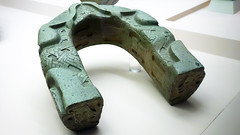
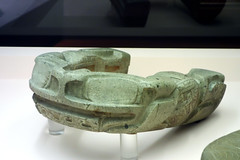
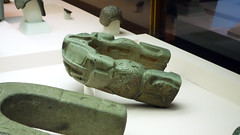

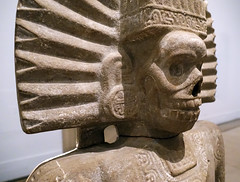
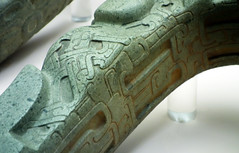
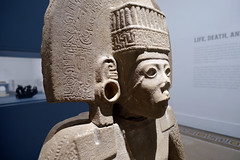
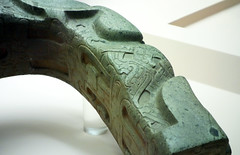

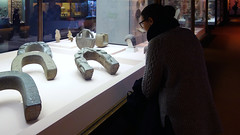
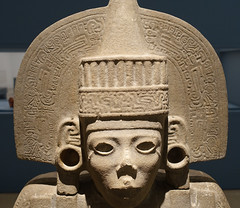
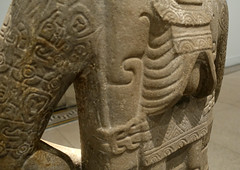
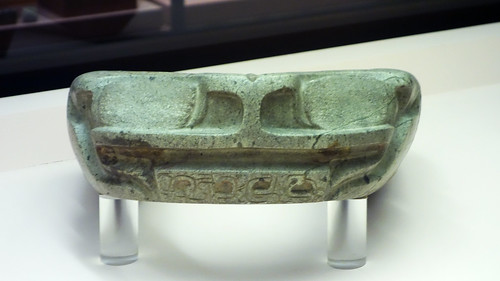
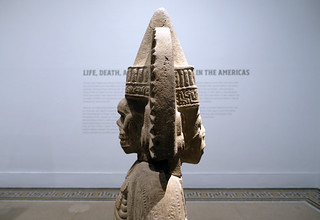
Art of the Maya
The ancient Maya were united by belief systems and cultural practices that included a distinct architectural style and a writing system.
1000 B.C.E. - 1521 C.E.
The Maya, an introduction
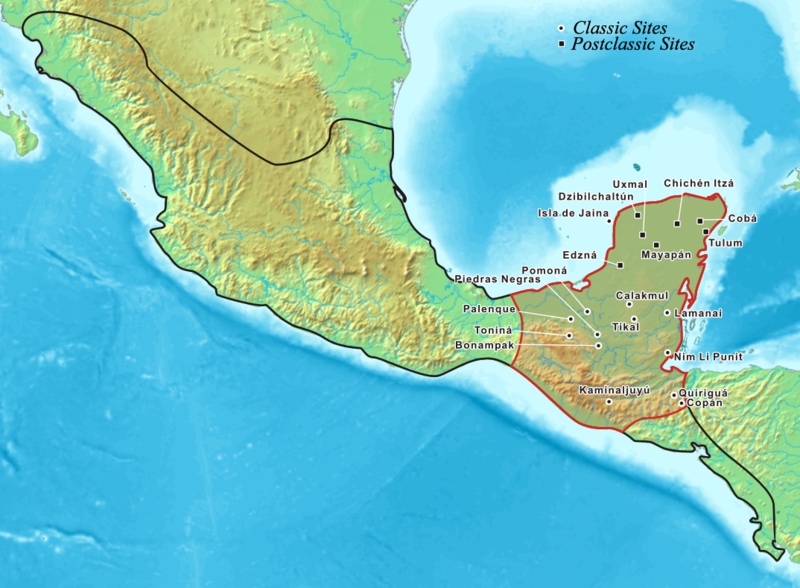
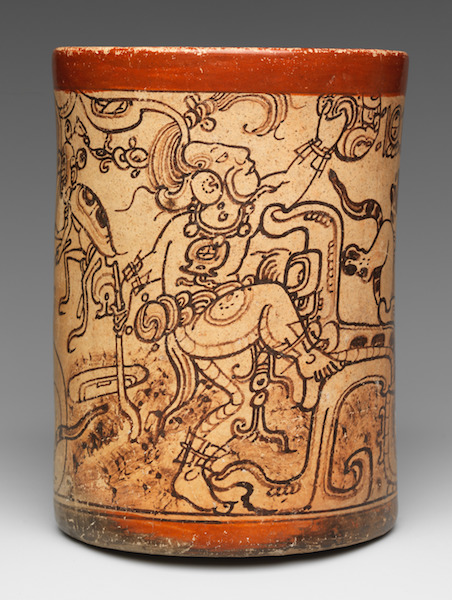
The Maya are a culturally affiliated people that continue to speak their native languages and still often use the ancient 260-day ritual calendar for religious practices. The ancient Maya were united by belief systems, cultural practices that included a distinct architectural style, and a writing system. They were also joined by political interaction in the form of warfare and intermarriage. They left an artistic legacy that ranges from intricately carved monolithic sculptures to complex mural cycles. The ancient Maya are credited with creating the most advanced Mesoamerican writing system, which was logo-syllabic, meaning that it consists of pictorial symbols or glyphs that represent either entire words or syllables. It is the only pre-Hispanic writing system of Mesoamerica that has been largely deciphered (see image below).
The Maya are also known for their advanced understanding of time, which they acquired through their study of astronomy and which allowed for the development of a complex calendrical system.
Public inscriptions—which decorated temples and palaces—have also contributed to our knowledge of the Maya, providing archeologists with important dates, names, and ritual information.
Periods in Maya history
Historians divide Maya history into three periods:
Pre-Classic: 1000 B.C.E.-250 C.E.
Classic: 250-900 C.E.
Post-Classic: 900-1521 C.E.
The Classic Period is divided into Early Classic: 250-550 C.E. and Late Classic: 600-900 C.E. During the early Classic Period, the Maya had built only a few cities in Mesoamerica. By the Late Classic Period however, the population had grown and Maya cities had been founded throughout the region. Important Maya cities include Tikal in the east (in what is today Guatemala), Palenque in the west (what is today Mexico), and Copán in the south (in what is today Honduras).
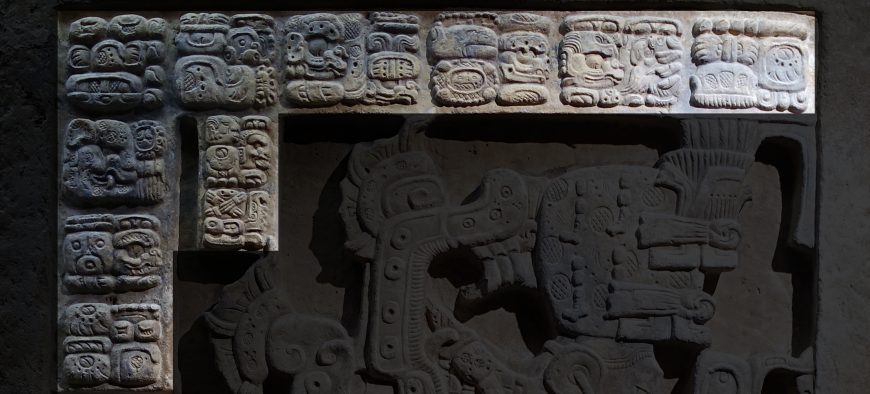
City States, ruled independently
With a population ranging in the millions and scattered throughout a vast region, the Maya were organized into small independent kingdoms or, more accurately, into city states. Each city state was ruled by a divine lord or ajaw/ahau who controlled territory around the capital city and frequently fought with neighboring states for preeminence. Political and economic rivalries among the Maya lords were fueled by an interest in acquiring territory and controlling trade routes—activities made more complicated by the remoteness of many Maya cities as well as their diverse geographies (Maya cities could be found in lowland rainforests and mountainous highlands). Different from the later Aztec, who centralized power and created a true empire, Maya power remained de-centralized and was spread throughout numerous kingdoms.
The collapse of Maya cities in the tenth century is not fully understood but may have resulted from complex factors including climate change (and resulting drought and crop failures), overpopulation, and political unrest. Following this collapse, Maya civilization continued on the northern tip of the Yucatán Peninsula, where Chichen Itza emerged as an important city of the Post-Classic Period. Though the city was abandoned by the thirteenth century, it was the arrival of Hernan Cortés and his Spanish fleet in the early 16th century that marked the end of the Maya civilization.
Tikal National Park (Tikal Guatemala)
Additional resources:
The British Museum and Google Cultural Institute resources on Maya Culture
Mirror-Bearer
by DR. JAMES DOYLE and DR. BETH HARRIS
Video \(\PageIndex{10}\): Mirror-Bearer, 6th century (Classic Maya), wood and red hematite, 35.9 x 22.9 x 22.9 cm (The Metropolitan Museum of Art)
Additional resources:
SmartHistory images for teaching and learning:

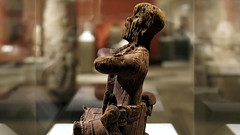
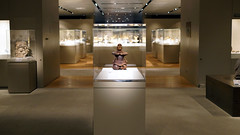


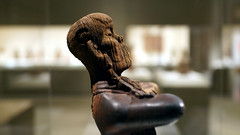
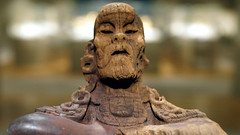
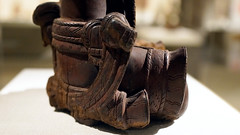
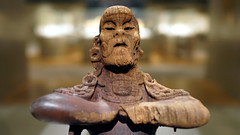
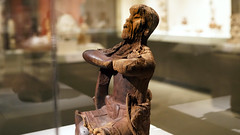
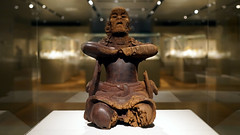
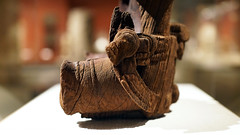
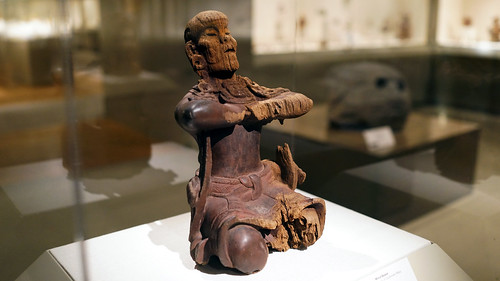
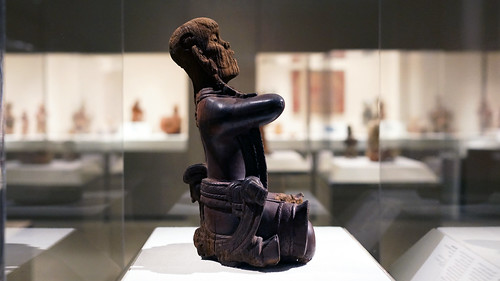
Vessel with a mythological scene
by DR. JAMES DOYLE and DR. STEVEN ZUCKER
Video \(\PageIndex{11}\): Vessel, Mythological Scene, 7-8th century C.E., Maya (Classic Maya), 14 x 11.4 cm, ceramic (1978.412.206) (The Metropolitan Museum of Art)
Additional resources:
Politics and History on a Maya Vase
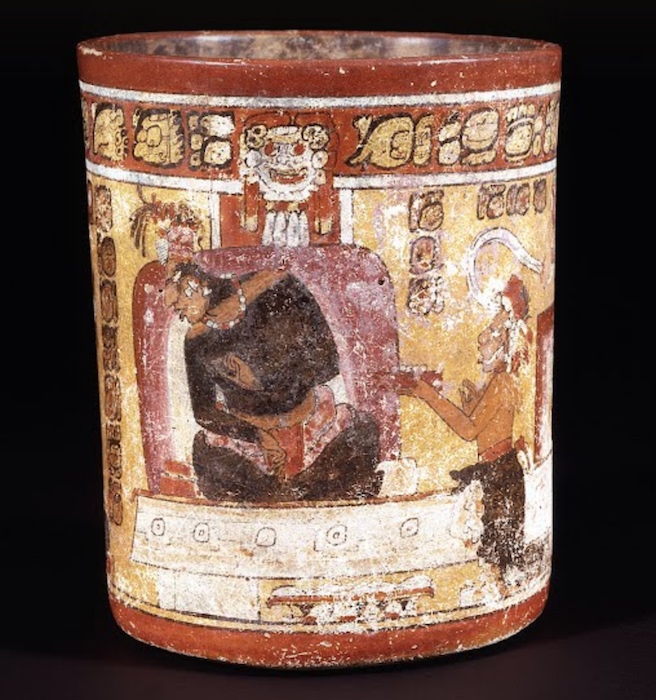
The rich and famous
Getting up close and personal to the rich and famous is not something that many of us have the opportunity to experience in our lifetimes. While we may not be able to rub shoulders with them, television, magazines, and the internet provide us with a glimpse into their lives. Just as media is a form of advertising and communication today, art was a means of communication for the ancient Maya. In a world where most of the population was illiterate, the visual arts were an important tool used to record historical events and communicate political and religious ideals.
Monumental architecture and sculpture of rulers and elites were often set in public spaces for the entire populace to see, as a constant reminder of their control and authority. In restricted elite spaces, which commoners did not have access to, grandiose visual arts were unnecessary signs of wealth. Affluence and authority were instead communicated via much smaller items manufactured from exotic materials by the finest craftsmen. Painted vases were especially favored and were commissioned to portray the lives and activities of those in and around power in the ancient world. These scenes included historical individuals such as the ruler and his family, mystical deities, and natural representations of flora and fauna. They survive today as a visual snapshot into the lives of the rich and famous Maya over 1000 years ago.
The ruler in his court

This painted ceramic, in the collection of the Dumbarton Oaks Research Library and Collection in Washington, D.C., shows us an intimate scene involving a ruler and the members of his court. Its style can be dated to the Late Classic period (650-850 C.E.)—a time in which painted ceramics were manufactured in large quantities, many depicting scenes of the royal court.
The ancient Maya were not a unified kingdom but were organized into different city-states, each controlled by a different ruler. The ruler was generally male, although there were a few instances in which there were female Maya rulers. Just as monarchs, prime ministers, and presidents today are supported by an administrative body, ancient Maya rulers were aided by members of their royal court. In addition to providing administrative support, courtiers also provided entertainment for rulers and we see evidence for this in the representation of musicians and dancers on Maya vases.

Maya hieroglyphic writing was commonly painted around the rim of vases, to announce its owner and describe the contents inside (frequently a chocolate drink known as cacao). The writing states that the vase is a drinking vessel, belonging to K’ebij Ti Chan (the spelling of this name is uncertain and the first word may have alternatively been K’ebix or Kexik). He was the son of Sak Muwaan (whose name translates as White Bird), ruler of the site Motul de San Jose in Guatemala, whose exact period of reign is unknown but is likely to have been before 701 C.E. or somewhere between 711 and 726 C.E.. K’ebij Ti Chan is not the individual seated on the throne in this scene, but may be the individual seated to the left of the ruler (occupying a privileged position close to the throne). The individual on the throne is a ruler from the Naaman polity, which was based at the site of La Florida. Here is a diagram identifying what we see on the vase.
The importance of the ruler on this vase is emphasized by his placement on a throne, above the other figures in the scene. He sits with his legs crossed and back resting on a large cushion, which is in front of a chest that seems to hold sporting equipment and costume for the ballgame (more about the ballgame here). To his right a kneeling attendant offers him a small dish, perhaps containing food, but the ruler turns away toward the two attendants seated on the ground. Two additional attendants (image left), who may be in a separate room, are seen conversing with each other. Interestingly, three of the attendants are wearing the same body paint as the ruler, and all attendants wear somewhat similar jewelry and accoutrements. The representation of the outfits in this scene is in stark contrast to the large, lavish, outfits depicted on sculpture and other media. This suggests that extravagant outfits were not part of the daily life of the Maya court.
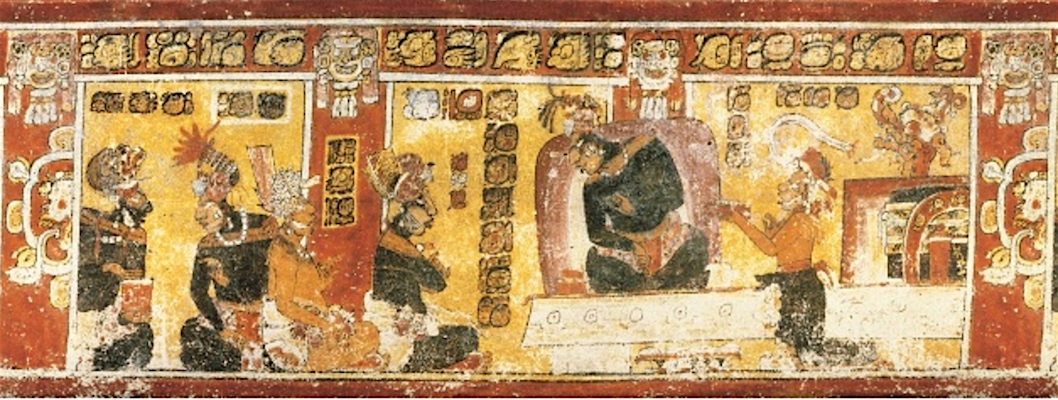

While excavations have uncovered architectural thrones, demonstrating that rulers did indeed sit on thrones like those depicted in this scene, materials used to manufacture cushions and costume elements are usually not recovered from ancient Maya sites. Unfortunately, because of the humid environment and acidic soils in the Maya region, many organic remains from royal court settings such as this one are not preserved in the archaeological record. Consequently, our knowledge about their use and importance within the court is largely taken from the visual record. Therefore, although this vase is unprovenienced (meaning it was not discovered from a scientifically controlled excavation) it is important to the study of ancient Maya culture and can reveal information about the past that is otherwise unavailable.
How did the Maya make these ceramics?
A cylinder-shaped vase (meaning straight-walled), like this one, was manufactured by hand from local clays available in the Maya region. Recent research shows that these vases were built up from coils placed on top of one another. Once the shape was created, it was left to dry so that it could be painted prior to firing in an open kiln. The Maya obtained different colored pigments from vegetation, minerals, and insects, and applied them using brushes made from hair, fibre, or feathers. Firing the ceramic after painting it ensured a durable, long-lasting, design.
The lack of appendages on cylinder vases required them to be held in both hands, creating a close relationship between object and person. Embellishing the exterior of vases that were in such close contact with the body allowed for an intimate and privileged means of communication. Only a select few individuals would have been privy to holding and viewing vases such as this one. Thus, care was taken to produce painted scenes of the highest quality as a means of impressing whoever came into contact with them. It is likely there were specialized workshops that produced painted vases such as this one, with artists that were in high demand and much sought-after for their skills.
What did the Maya use painted ceramics for?
The Maya used painted ceramics in feasting events to serve food and beverages, and as gifts for elites and rulers from neighboring sites. Feasts were not only a means of celebration and festivity, but were also important political events that fostered relationships between different sites. Ceramics therefore played an important social and political role as objects that were used and gifted. More significantly, the painted scenes that decorated these ceramics became valued elements in their own right and would have stimulated trade between sites that manufactured them, and sites that desired them. Consequently, vases of this kind were used, gifted, and traded between sites all throughout the ancient Maya region.
Presenting food and drink in vases such as this one is akin to serving dinner using the best family tableware, and, presumably, they were afforded the same care and high regard. Many painted vases have been recovered from burials and offerings at archaeological sites, where they were included for their ritual, symbolic, and economic value.
Additional Resources:
This vase at Dumbarton Oaks Research Library and Collection
This vase on the Google Art Project (zoomable image)
What can we learn from a Maya vase?
Maya Area, 500-1000 A.D. on the Metropolitan Museum of Art’s Heilbrunn Timeline of Art History
Maya: The Fenton Vase

This vase shows a Maya ruler sitting cross-legged on a bench, wearing an enormous headdress to show that he is important. He is pointing to a basket full of corn bread gifts called tamales. This vase illustrates the delivery of a tribute, with glyphs naming the figures whose jewelry and turbans identify them as members of the Maya elite. The six hieroglyphs in boxes to his left list his name and titles.
Glyphs
The Maya had begun to write as early as 400 B.C.E., but from the sixteenth century Spanish missionaries destroyed their codices (screenfold books) and made them learn the Spanish alphabet. As a result, the Mayan language was lost and there was no way of deciphering the glyphs on their monuments or the handful of codices that survived.
In the eighteenth century, however, European travelers began to rediscover the Maya civilization. In particular, the publication of Antonio del Río’s report on his expedition to the ancient city of Palenque (1787) included the first illustrations of Maya script carved on stone monuments.

By the early nineteenth century, European scholars were beginning to recognize that Maya glyphs were a writing system. They made efforts to record the glyphs in drawings, engravings and casts, and collected vases and other artifacts with glyphs on them. The first European to accurately depict Maya glyphs was Alexander von Humboldt (1769-1859), who illustrated pages from the Dresden Codex in 1810. But, scholars did not finally understand the meaning of Maya glyphs until the twentieth century.
Tribute and warfare
Polychrome ceramic vessels were a symbol of status and power for the Maya. They were used by the élite and are found as offerings in rich burials. A large number of beautiful polychrome vases, bowls and dishes from the Late Classic period have been recovered from the Maya area, at sites such as Tikal, Holmul and Seibal in the lowlands, and Nebaj in the highlands.
The vessels provide an important source of information about Maya society in the Classic period, with text and images illustrating historical and mythological events. The scenes depict scribes, merchants, rulers and other members of society. This beautiful example was found at Nebaj, a Maya site in the highlands of Guatemala. The most common themes on Nebaj style polychrome vessels are tribute and warfare.
Suggested readings:
D.R. Budet, Painting the Maya universe (Durham, London, Duke University Press in association with Duke University Museum of Art, 1994).
M. Coe and J. Kerr, The art of the Maya scribe (London, Thames & Hudson, 1997).
K. Sloan with A. Burnett (ed.). Enlightenment: Discovering the World in the Eighteenth Century (London: The British Museum Press, 2003).
M. Coe, Breaking the Maya code (London, Thames & Hudson, 1992).
L. Schele and M.E. Miller, The blood of kings (London, Thames & Hudson, 1986).
R. Sharer, Daily life in Maya civilization (London, Greenwood Press, 1996).
© Trustees of the British Museum
Chakalte’, Relief with Enthroned Ruler
by DR. JAMES DOYLE and DR. STEVEN ZUCKER
Video \(\PageIndex{12}\): Chakalte’, Relief with Enthroned Ruler (lintel from La Pasadita, Guatemala), late 8th century (Classic Maya), limestone and paint, 88.9 x 87.6 x 7 cm (1979.206.1047) (The Metropolitan Museum of Art)
Additional resources:
This work at The Metropolitan Museum of Art
James Doyle, “Sacrifice, Fealty, and a Sculptor’s Signature on a Maya Relief”
James Doyle, “Maya Sculpture” on The Metropolitan Museum of Art’s Heilbrunn Timeline of Art History
SmartHistory images for teaching and learning:
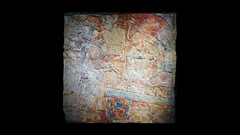
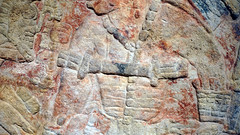
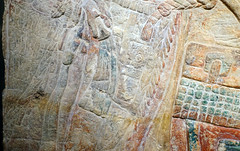
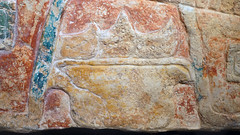
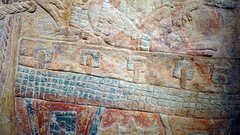
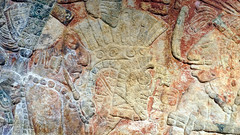
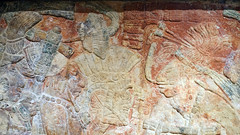
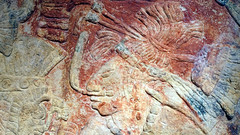

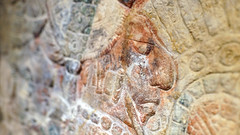
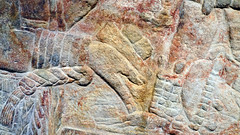
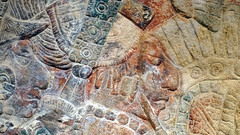

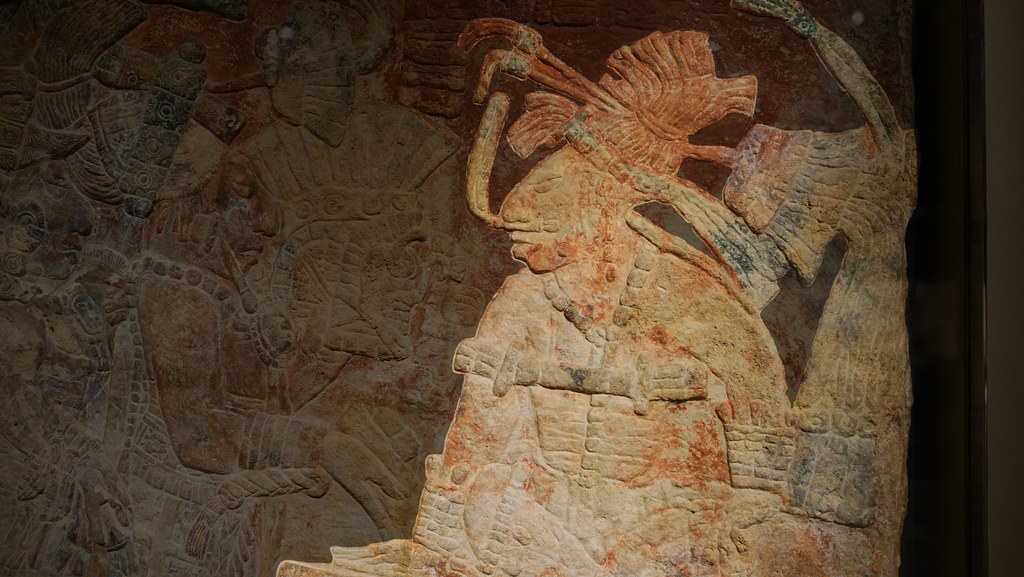
Palenque (Classic Period)
Google photosphere of Palenque: view of the Temple of Inscriptions from the Palace
King Pakal and the expansion of Palenque
According to Maya glyphic inscriptions, the city of Palenque (in what is today southern Mexico)—comprised of temples, a ballcourt, and the largest surviving Maya palatial complex—was established in 432 C.E. However, it was not until 600-700 C.E. that the city grew in importance. The rule of the king K’inich Janaab’ Pakal, from 615 to 683 C.E., initiated an ambitious architectural expansion at Palenque, an endeavor that was continued by his sons. Local lords such as Pakal, and other like him, each ruled over one of the many Maya city states, each with their own royal court.
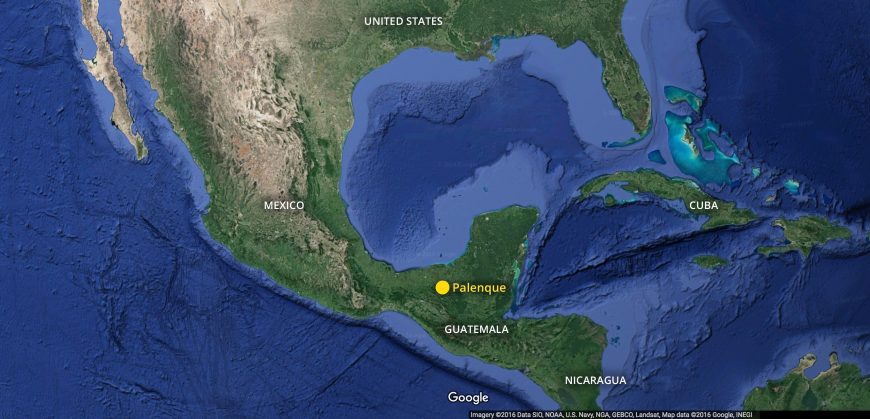
The palace complex is located in the center of the city, flanked by the Temple of the Inscriptions and a ballcourt. Both buildings echo the uneven terrain of the Chiapas region, and in some cases they are built into the rolling hills—as in the case of the Temple of Inscriptions.
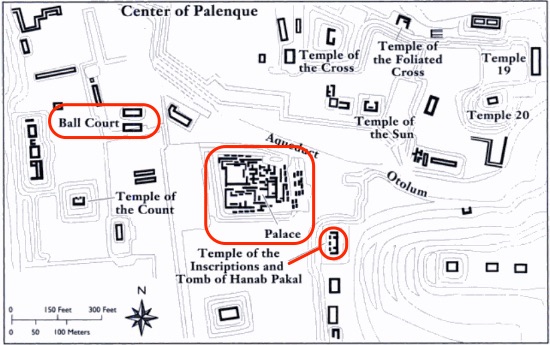
King Pakal lived and ruled from the Palace, where various royal ceremonies took place. The unroofed portion to the east of the palace (to the right in the photo below) is believed to be the throne room where kings were crowned. Built like the city, over the course of 200 years and in various stages, the palace features a prominent tower near the center (that scholars believe may have been used as either an observatory or a watchtower).
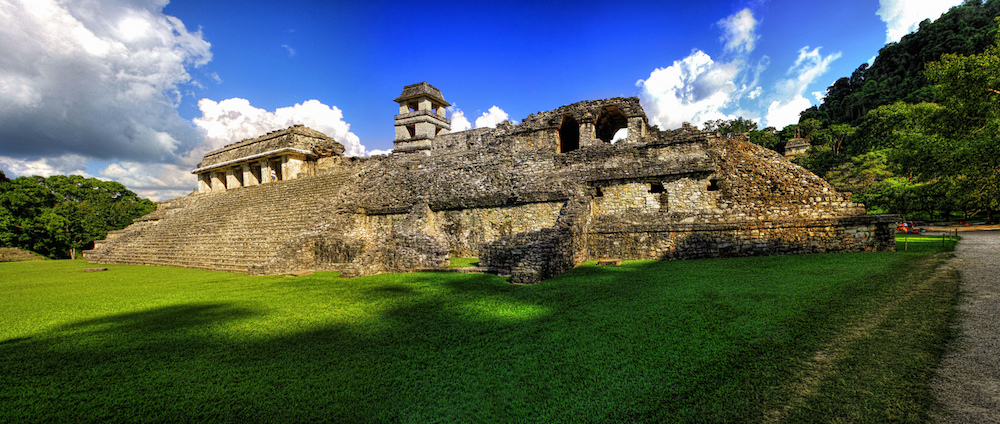
The roofed portions that remain reveal the typical roof comb architecture of the Maya, most obviously seen in the Temple of the Sun (photo: Dennis Jarvis, CC BY-SA 2.0). While the palace occupies a prominent place in the city of Palenque and features a façade with multiple staircases, access to the building was limited and its enclosed spaces purposely guaranteed privacy.
A funerary pyramid
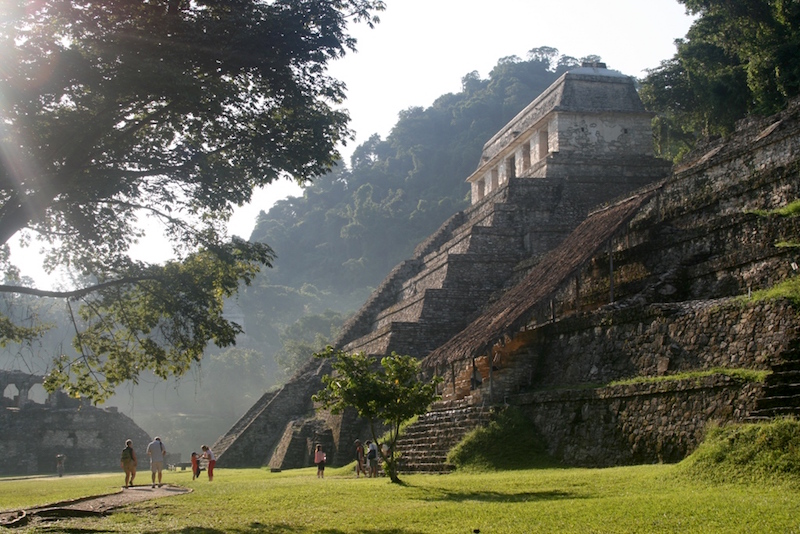
The Temple of the Inscriptions has been called the greatest Maya funerary pyramid and gets its name from the relief panels inside the temple containing an unusually long glyphic inscription that includes a history of the city and its most famous ruler, Pakal (find a translation here). The enclosure at the top was decorated with the iconic Maya roof comb, and decorated with Maya inscriptions.
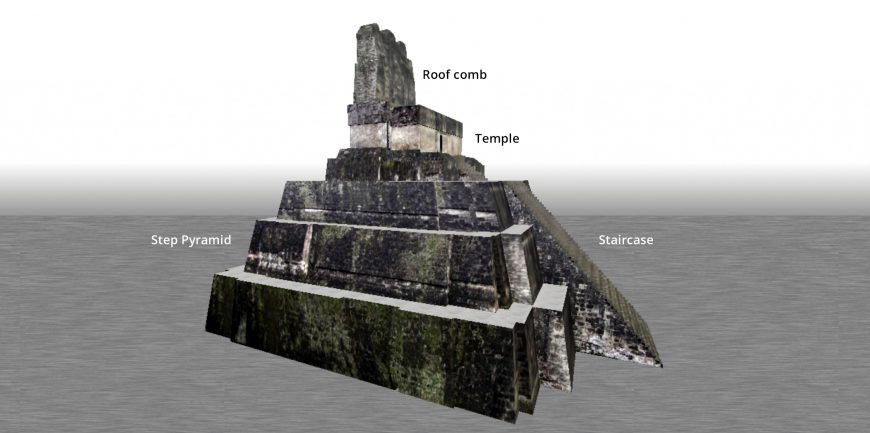
The pyramid consists of nine levels—the same number of stages found in the Maya underworld (this same numerological association, which was pan-Mesoamerican, is also seen at Temple I in Tikal and El Castillo in Chichen Itza). Long considered a simple pyramid with a temple on top, in 1952, Mexican archeologist Alberto Ruz Lhullier discovered that the Temple of the Inscriptions also contains an interior burial chamber. The tomb of King Pakal is found at the nadir, or lowest point, of the pyramid in a burial chamber that may have once been accessible by an interior stairway but was eventually sealed.
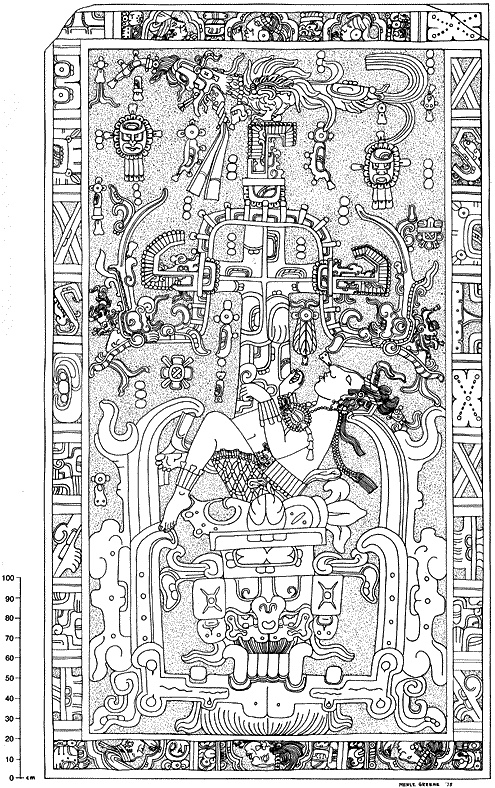
The location of the tomb is significant since King Pakal is buried in a subterranean chamber directly below the pyramid—and is therefore connected to the “earthly” realm. In this way, Pakal inhabits both the world of the living and the dead. The lid of the sarcophagus (a sculpted coffin placed above ground), which was carved out of a single piece of stone features a depiction of the king suspended over the jaws of the underworld (above). On the lid, as in his tomb, Pakal is positioned in an intermediary space, between the heavens—symbolized by the world tree and bird above him—and Xibalba, the Maya underworld.
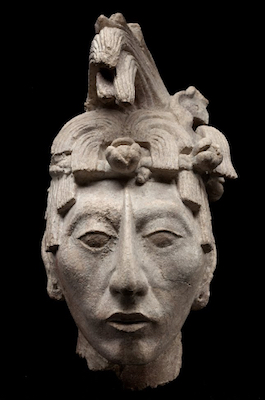
In addition to the remains of Pakal, precious materials such as jade, shells, pearls, and obsidians were discovered inside the sarcophagus. This idealized portrait of Pakal (image left) associates the king with the Maya maize god (his hair is meant to resemble corn silk). It was also found in the tomb and reveals the Maya ideal of beauty, as seen in the king’s oval face, elongated nose, and high cheekbones. His finely sculpted features and realistic portrayal reveal the naturalism of Classic Maya figurative sculpture.
While the tomb of Pakal was largely hidden from view until 1952, archeologists believe that at some point it was made accessible to those who wished to worship the ruler after his death. They also believe that—because construction of the tomb began before Pakal’s death in 683 C.E.—the Temple of the Inscriptions was most likely built to the ruler’s specifications. However, some archaeologists, after studying the skeleton’s teeth, hold that the tomb contains the remains of a man 40 years younger than Pakal—a reminder that Maya archaeology remains a dynamic area of study.
Additional resources:
Maya: The Yaxchilán Lintels
Yaxchilán: a significant Maya center
Yaxchilán is located on the south bank of the Usumacinta River, in Chiapas, Mexico. It was a significant Maya center during the Classic period (250-900 C.E.) and a number of its buildings stand to this day. Many of the exteriors had elaborate decorations, but it is the carved stone lintels above their doorways which have made this site famous. These lintels, commissioned by the rulers of the city, provide a lengthy dynastic record in both text and image.
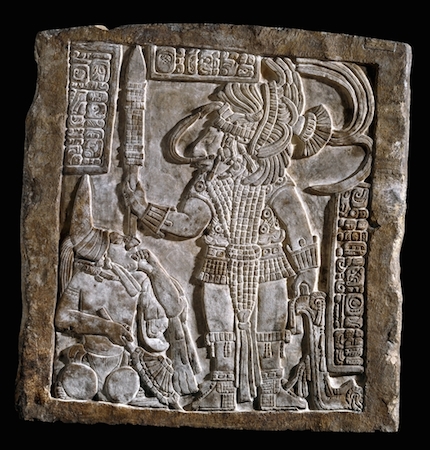
Lintels 24, 25 and 26, set above the three doorways of Structure 23, depict a series of rituals performed by Shield Jaguar II and his wife. Structure 21, commissioned by Bird Jaguar IV, housed lintels 15, 16 and 17. Bird Jaguar was Yaxchilán’s most prolific builder and at least a dozen major structures were initiated or remodelled during his reign.
In this lintel above, Bird Jaguar IV dominates a captive. Scenes representing the public display of captives occur frequently in Maya art. The capture of sacrificial victims was an essential aspect of Maya warfare, as they were necessary for many rituals. Accession rituals, for example, entailed the offering of dedicatory human sacrifices to mark the enthronement of a new ruling lord.
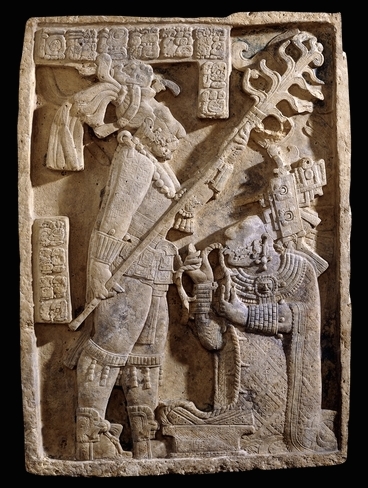
Lintels 24 and 25 are on permanent display in the British Museum’s Mexican Gallery. Lintel 26, the third in the series, is in the Museo Nacional de Antropología, in Mexico City.
Royal blood-letting
This limestone lintel, considered one of the masterpieces of Maya art, is one of a series of three panels from Structure 23 at Yaxchilán, where it was set above the left (south-east) doorway.
The scene represents a bloodletting ritual performed by the king of Yaxchilán, Shield Jaguar the Great (681-742), and his wife, Lady K’ab’al Xook (Itzamnaaj Bahlen III).
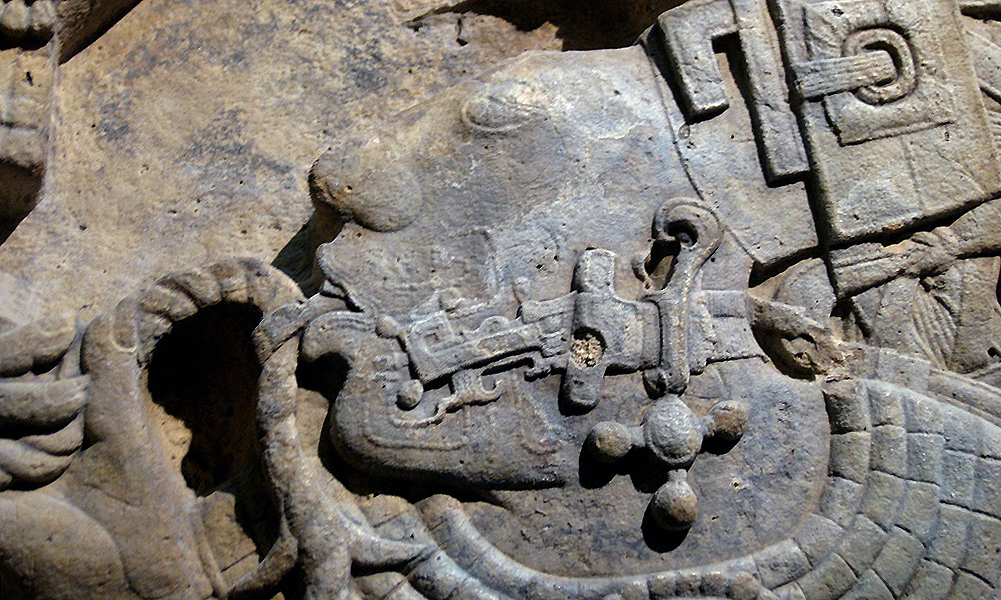
Wearing an exquisitely woven “huipil,” Lady K’abal Xook pulls a thorned rope through her tongue in the principal form of blood sacrifice perfomed by royal women. The rope falls on to an open codex. Her pierced tongue allowed her blood to flow as part of a ritual communication with gods and spirits. This sacrifice mirrored the Maya story of creation, when the gods let their blood to create the human race. By choosing to take part in the ritual, the queen demonstrated both her moral and physical strength to the people, and her suitability as a Maya royal. Scrolls of blood can be seen around her mouth. She kneels in front of Shield Jaguar who holds a great torch described in the text as a “burning spear” illuminating a ritual that was probably held at night or set in the dark recess of a private chamber.

Both king and queen are richly attired with Sun God pectorals. The human head worn by Shield Jaguar over his brow may be a shrunken battle trophy.
Bloodletting was a common practice in Maya life from the Late Preclassic period (400 B.C.E.- 250 C.E.) onwards, and an essential part of rulership and of all public rituals. The Maya élite drew blood from various parts of their bodies using lancets made of stingray spine, flint, bone or obsidian. These objects are often found in burials and other archaeological contexts, though other perishable materials, like the rope and the bark-paper strips seen on the lintel, are now lost.
The first two glyphs in the text at the top of the lintel indicate the event and the date on which it took place, October 24, 709 C.E. (5 Eb, 15 Mak in the maya calendar). The last glyph represents the Emblem Glyph (that is, the city name in Maya hierolglyphs) of Yaxchilán. The text on the left of the panel contains the name and titles of Lady K’ab’al Xook. The lintel has traces of Maya blue, turquoise and red pigment.
The site of Yaxchilán was only rediscovered in the 19th century as it stood in the midst of the dense tropical forest, and Maya glyphs only began to be translated in the 1960s.
Suggested readings:
V.R. Bricker, “Advances in Maya epigraphy,” Annual Review of Archaeology, 24 (1995), pp. 215–235.
J. Marcus, “The Iconography of Power Among the Classic Maya,” World Archaeology, 6 (1974), pp. 83–94.
N. Grube and Simon Martin, Chronicle of the Mayan Kings and Queens: Deciphering the Dynasties of the Ancient Maya (London, Thames and Hudson, 2008).
V.E. Miller, Yaxchilan: the Design of a Maya Ceremonial City (Austin, University of Texas Press, 1992).
D. Freidel and L. Schele, A Forest of Kings: the Untold Story of the Ancient Maya (London, 1990).
© Trustees of the British Museum
Yaxchilán—Lintels 24 and 25 from Structure 23 and structures 33 and 40
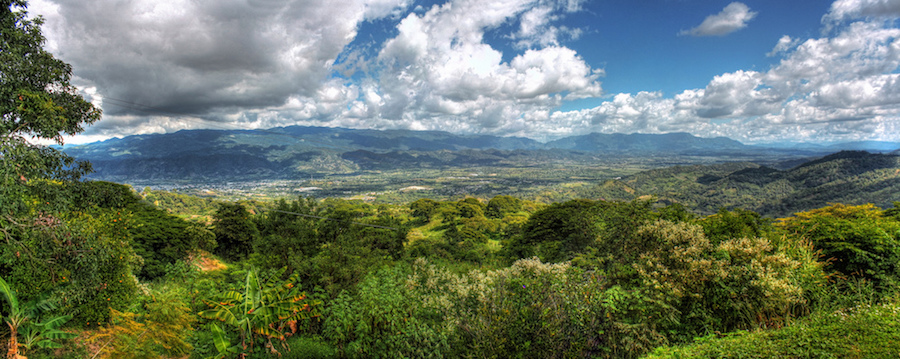
Floating down the Usumacinta River in southeastern Mexico and northwestern Guatemala, various Maya sites materialize out of the dense jungle, some rising above the canopy and others subsumed by a tangle of green growth. One such site is Yaxchilán (pronounced Yash-chee-LAN) located in Chiapas, Mexico (close to the border of Guatemala) between the famous Maya cities of Copán and Palenque. The site is host to an impressive number of structures and monuments—over 100—and is especially famous for its high-quality relief carvings.
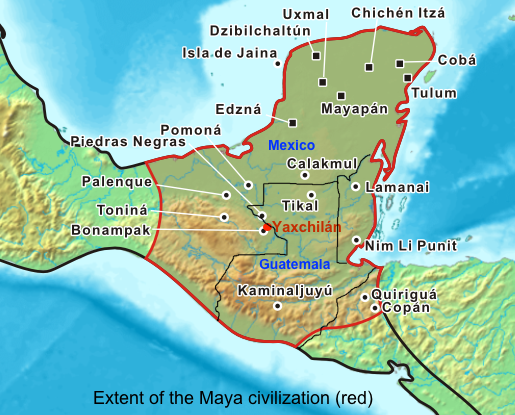
Yaxchilán’s ruling dynasty rose in the 4th century C.E., but its heyday followed several hundred years later (during what art historians call the Classic period), with Lord Shield Jaguar II who ruled for 60 years beginning in 681. He commissioned some of the most famous sculptural works at the site. His son and heir, Bird Jaguar IV, continued this tradition. Some of the most impressive Maya buildings and sculptures were created during this late-Classic period before the city-state collapsed in the 9th century.
Structure 23: Royal Life and Power
Shield Jaguar II’s commissions at Yaxchilán’s central complex of buildings (called the Central Acropolis) include carved lintels (the beam at the top of a doorway), stairs faced with hieroglyphic writing, and stele (upright wood or stone slab monuments).
Some of the most famous lintels are those on Structure 23—a yotoot (palace building) showing Shield Jaguar II’s wife, Lady K’abal Xook. Anyone entering Structure 23 would pass underneath the limestone lintels when entering the doorways; the lintels are thus situated in a liminal space between exterior and interior.

Before the construction of Structure 23, there was a hiatus in building at Yaxchilán for about 150 years. This building’s construction is therefore important, and so too are the individuals it showcases. But why focus on Lady Xook rather than Shield Jaguar II exclusively? It might be that the ruler wanted to promote his lineage and power through his principal wife (who had more prestige than his other wives). Structure 23 is therefore important not only for advertising Shield Jaguar II’s power, but also for highlighting the important role of royal women in Maya culture. Other relief sculptures, such as Lintel 45 on Structure 44, show Shield Jaguar II with war captives to commemorate his victory in battles against rival city-states.
Three important lintels
The three lintels on Structure 23—known as lintels 24, 25, and 26—depict different ritual moments in the life of Lady Xook. While they appear to have been carved years apart from one another, they seem to show a narrative. Note: the monuments and objects uncovered at Yaxchilán are numbered in the order in which they were found—so Lintel 1 is not the oldest, but rather the first to be excavated by archaeologists.
Lintel 24
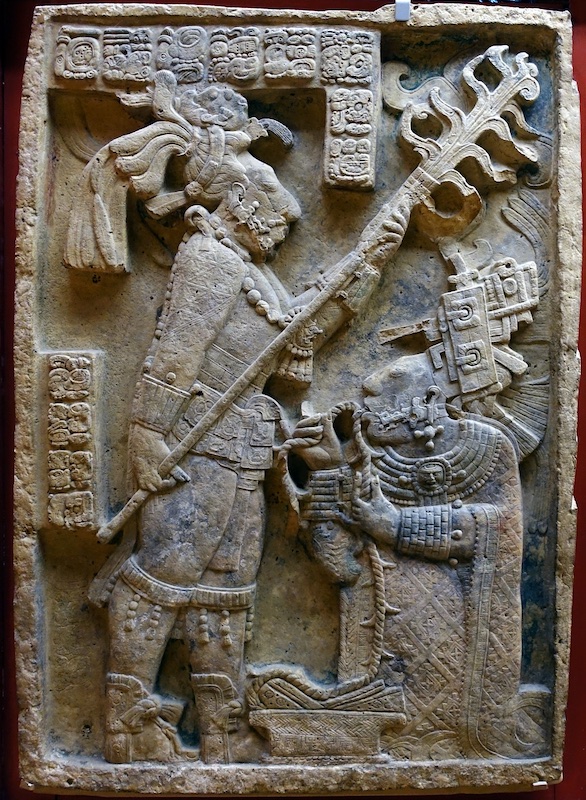
On Lintel 24, Lady Xook pulls a thorned cord through her tongue so that she can bleed onto paper that fills a basket on the ground before her. She is engaged in bloodletting—the ritual shedding of blood. Her husband, Shield Jaguar II, holds a lit torch above her. The glyphs (writing) on the top note Lady Xook’s titles, and mention that the events depicted occurred on 28 October 709 C.E.
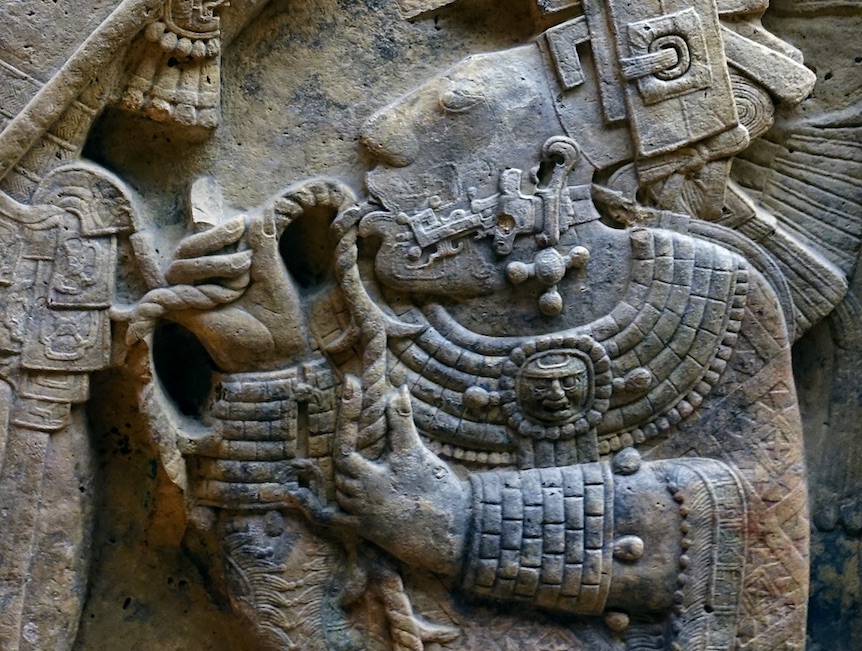
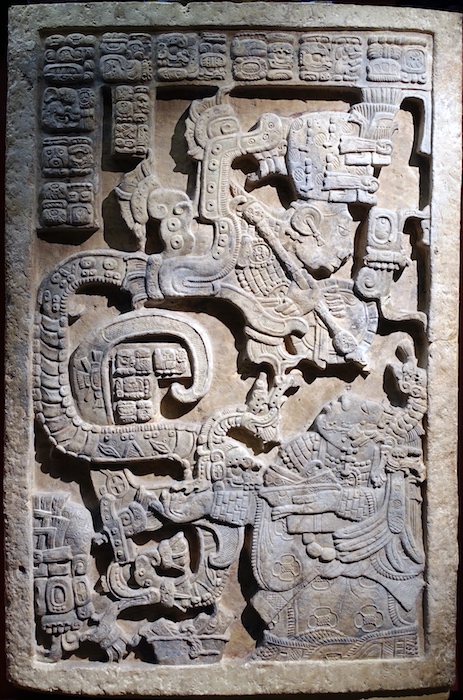
Lintel 25 & 26
Lintel 25 (left)—from the central doorway—also focuses on a bloodletting ritual carried out by Lady Xook. Bloodletting was a common ritual among elites and it is one of the most frequent subjects in Maya art. A ruler or other elites (including women), would let blood to honor and feed the gods, at the dedication ceremony of a building, when children were born, or other occasions. Rulers needed to shed blood in order to maintain order in the cosmos. The ruler was believed to be a descendent of the gods, and the act of bloodletting was of critical importance in maintaining their power and order in the community. Bloodletting was also an act related to rebirth and rejuvenation.
On Lintel 25 (left), the effects of bloodletting are on display. The loss of blood and the burning of incense produced hallucinations, which were desired in certain ritual contexts to access other realms. In this lintel, Lady Xook (in the lower right) kneels before a vision serpent, from whose mouth emerges a figure. Look closely at the detail below. Lady Xook holds a bowl in her left hand while she looks up towards the rising serpent. In addition to her patterned huipil (square-cut blouse), Lady Xook is festooned with a headdress, elaborate bracelets, earrings, and a necklace—likely made of jade. In the bowl are pieces of paper stained with her blood. She has likely burned the paper to allow the blood to ascend to the gods, and to bring about the vision serpent.
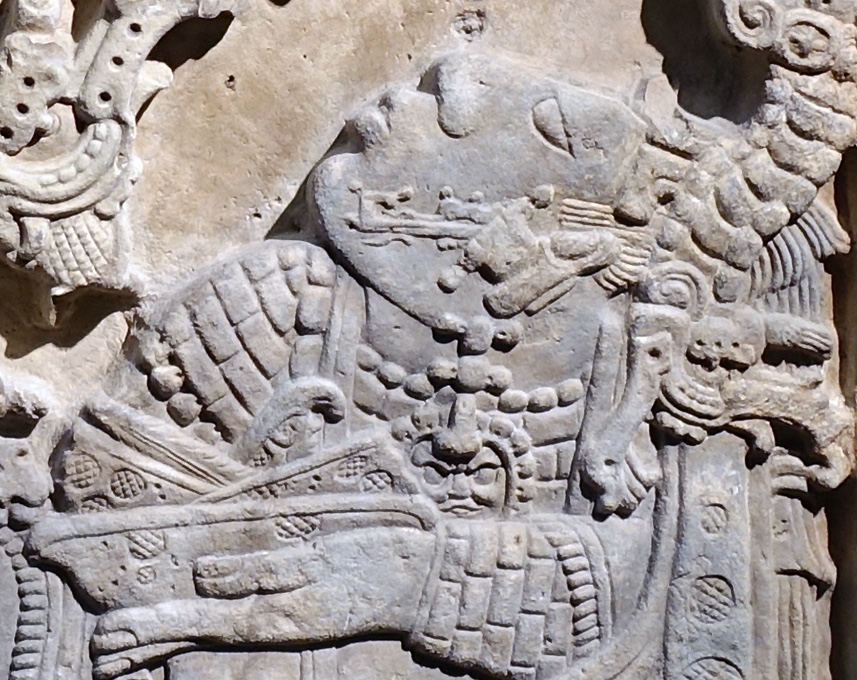
In the image below, you can see that the figure emerging from the vision serpent’s mouth is armed with a shield, spear and a war helmet. He, too, wears an elaborate headdress, a breastplate and ear spools. The identity of this figure is debated; some scholars claim it is an ancestral figure while other believe it is Shield Jaguar II or perhaps even Lady Xook.
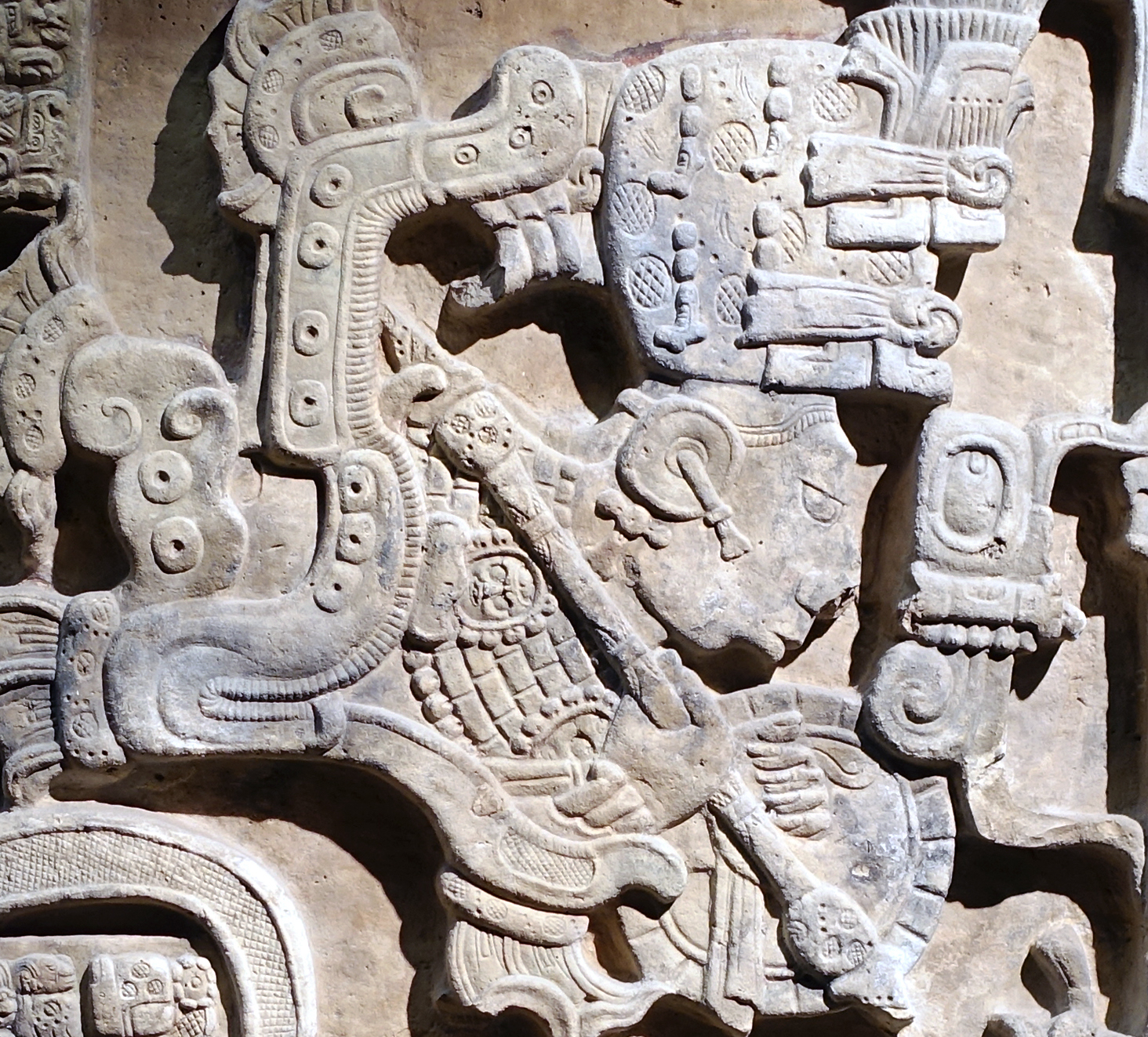
A glyphic inscription (oddly, written backwards) in the upper left corner of Lintel 25 notes the date of Shield Jaguar II’s ascension to the throne in October 681. The image and the inscription both reinforce the reign of the ruler and his dynastic ties, in this case via his wife.
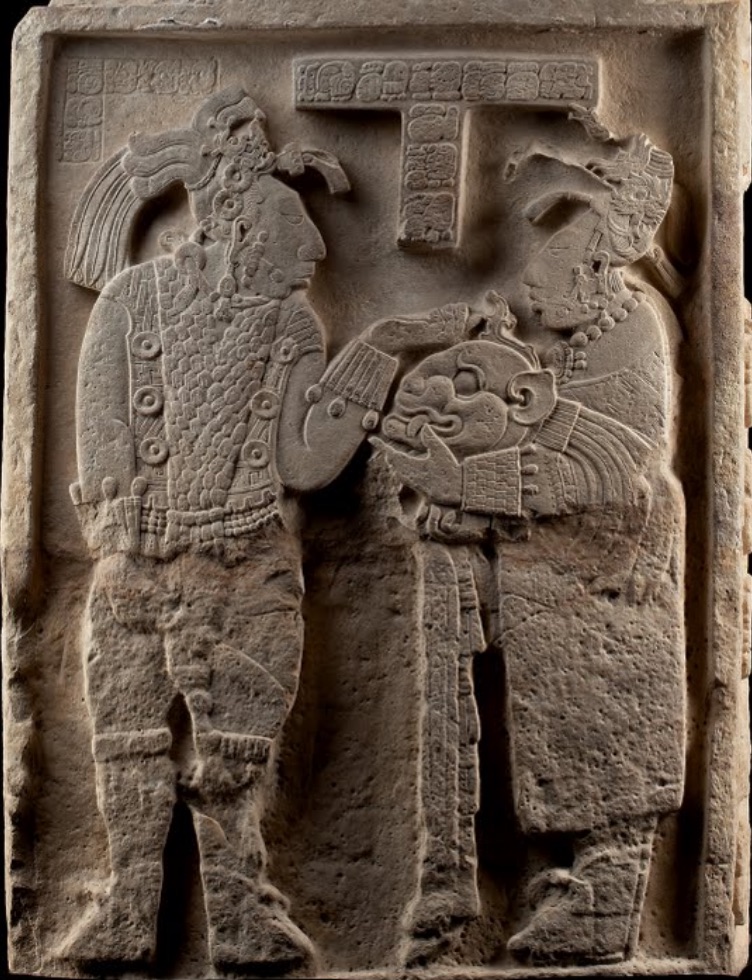
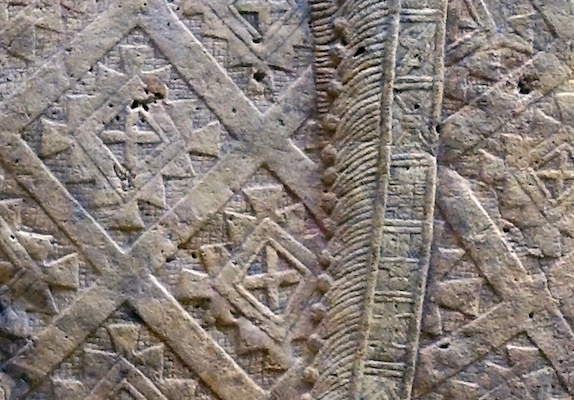
Skilled carving
The lintels exemplify the skilled carving of Maya artists at Yaxchilán—and the Maya more generally. The scenes are carved in high relief with carefully incised details decorating the raised surfaces. A beautiful diamond pattern decorates Lady Xook’s huipil, for instance, in Lintel 24 (left).
The contour and incised lines of the lintels possess a calligraphic quality, as if they were drawn or painted rather than carved. Such careful attention to detail as well as the formal qualities of the line compare to other Maya sculptures, as well as vase painting and murals.
The Yaxchilán lintels were originally painted, although only traces remain, including red on Lady Xook’s clothing and the brilliant Maya blue color on the background of Lintel 24.
Structures 33 and 40: Royal Dynasties and Legitimizing Rule
Also located within the Central Acropolis near Structure 23, Structure 33 (dedicated around 756 C.E.) is a wonderful example of Maya Classic architecture, particularly of the Usumacinta and Peten region or “style” as some would call it (image below). It was most likely built by Bird Jaguar IV, who like his father Shield Jaguar II engaged in a series of building projects and commissioned various monuments as part of his campaign to legitimate his rule. Bird Jaguar ascended the throne ten years after his father died, suggesting that there was perhaps a conflict about who was to become Yaxchilán’s ruler.
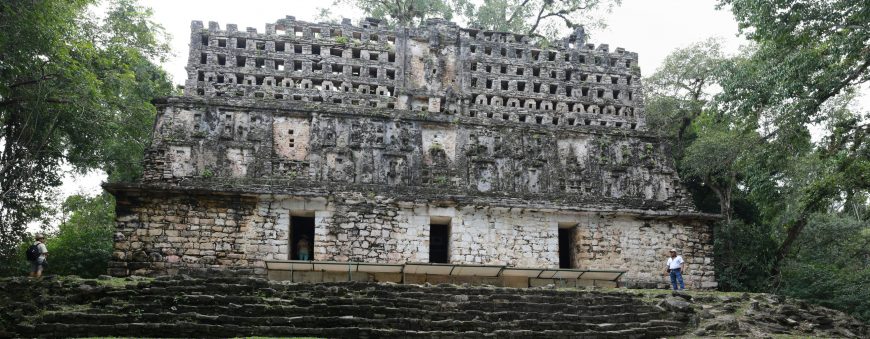
Structure 33 rests on the side of the main plaza, making it a focal point for the area. The building itself is narrow, only one vault deep, so it was not intended to hold many people. Three entryways punctuate the exterior—which is embellished with stucco ornamentation. An elaborate roof-comb (a masonary “wall” that rises upwards above a building to give the impression that it is taller than it actually is), arguably the most famous component of the temple, incorporates a decorative frieze, niches, and sculptural elements, including a sculpted human being in the central niche. It is possible that this is Bird Jaguar IV. Intricate latticework covers the symmetrical roof-comb and the building’s overall style is reminiscent of buildings found at other important Classic Maya city-states like Palenque.
Like Structure 23, carved lintels form the underside of each of the doorways on Structure 33. Lintel 1, for example, shows Bird Jaguar festooned in the fantastic clothing of a Maya ruler. The other lintels show a similar concern with rulership. Lintel 2 displays Bird Jaguar and his son and heir, Chel Te’ Chan K’inich (later known as Shield Jaguar IV), while another depicts Bird Jaguar once again dressed in royal regalia.*
Hieroglyphic Stairway #2 leads up to the building. The top step of Structure 33 displays rulers, including Bird Jaguar IV and his father and grandfather playing the ballgame in a series of thirteen carved limestone blocks (today protected by an overhang and glass, see the image above). They play against Yaxchilán enemies—such as Lord Jeweled Skull who Bird Jaguar defeats.
Structure 40
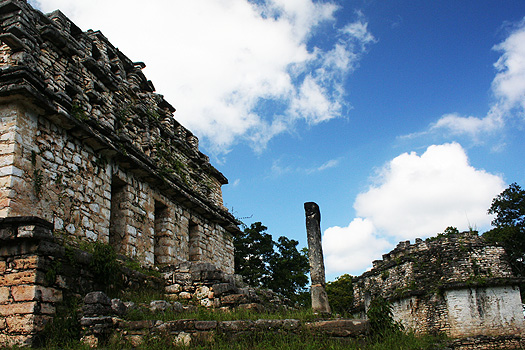
Bird Jaguar IV also had Structure 40 built as part of his political campaign to secure his rulership. Structure 40 (above) sits in the South Acropolis, flanked by two other structures. It displays the typical Yaxchilán architectural style—a rectangular vaulted building with a stuccoed roof comb. Like many other Yaxchilán buildings it had stele associated with it, such as Stela 11 that showed Bird Jaguar IV towering over war captives accompanied by his parents. The stela, like the buildings and other commissioned works, were intended to advertise Bird Jaguar IV’s dynastic lineage and thus his right to rule.
Additional resources:
Yaxchilán from the Peabody Museum of Archaeology and Ethnology (Harvard)
Michael D. Coe, The Maya, 9 ed. (London: Thames & Hudson, 2015).
Simon Martin and Nikolai Grube, Chronicle of the Maya Kings and Queens: Deciphering the Dynasties of the Ancient Maya (London: Thames & Hudson, 2000).
Mary Ellen Miller and Megan O’Neil, Maya Art and Architecture, 2 ed. (London: Thames & Hudson, 2014).
Linda Schele and Mary Ellen Miller, The Blood of Kings (London: Thames & Hudson, 1986).
Carolyn E. Tate, Yaxchilán: The Design of a Maya Ceremonial City (Austin: University of Texas Press, 1992).
SmartHistory images for teaching and learning:

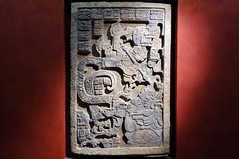
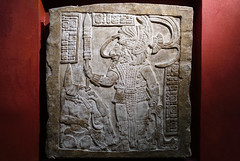
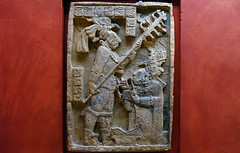
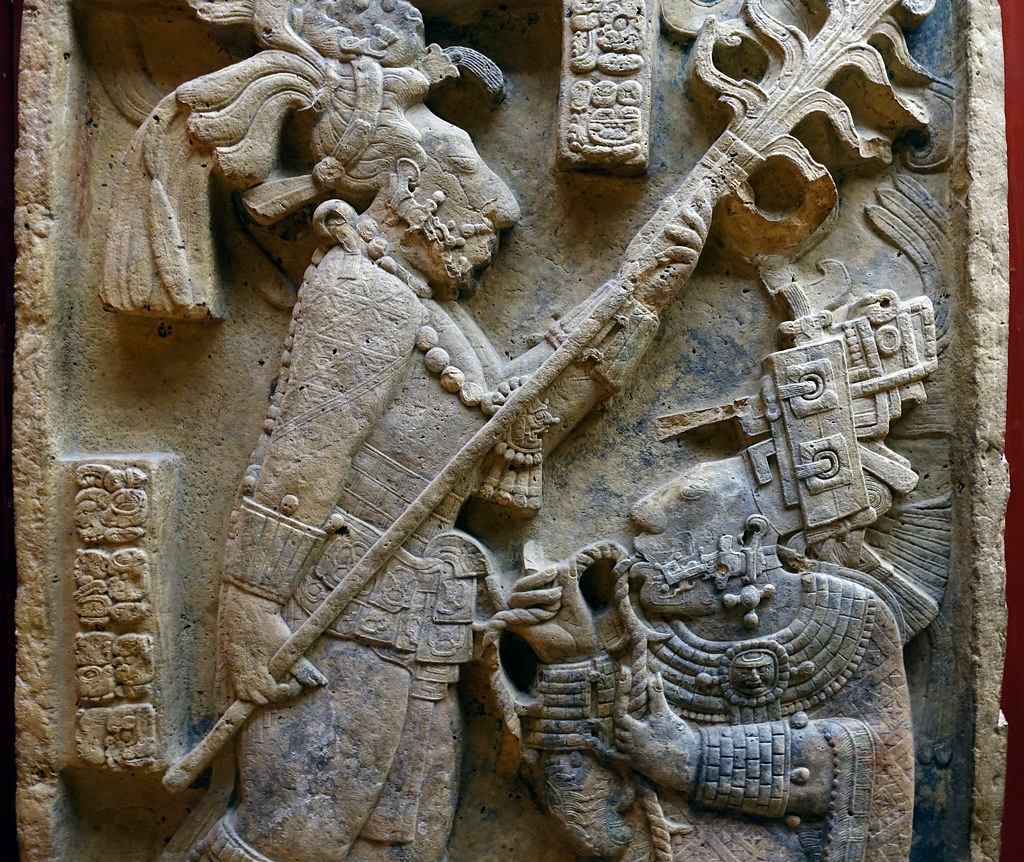
Classic Maya portrait stelae

Kings in stone
In 1839, American lawyer and amateur archaeologist John Lloyd Stephens and English artist Frederick Catherwood were the first outsiders to venture into the rainforests of Central America. They brought back their romanticized accounts and drawings of the remains of ancient Maya civilization to an eager England. In their publications, Stephens and Catherwood conveyed that they had uncovered the ruins of a great civilization that was uniquely American—one that had developed without contact with Egypt, India, or China.
Solemn and strange
Among the many strange and wonderful sites they encountered, it was the monuments that most aroused their interest and sparked their Victorian sensibility for engaging past civilizations. In regard to these hefty carved stones, Stephens penned the following excerpt, “standing as they do in the depths of the forest, silent and solemn, strange in design, excellent in sculpture, rich in ornament…their uses and purposes and whole history so entirely unknown….”
Over the past thirty years, scholars have made substantial advances in understanding the “uses and purposes” of Maya stone sculptures, and of the ancient peoples that produced them. This progress is due in no small part to developments in the decipherment of Maya hieroglyphics, which has escalated in recent decades. Epigraphers and art historians have labored to reconstruct the history and culture of the flourishing Classic period (c. 250-900 C.E.) expressed on the sculptures found throughout México, Honduras, Guatemala, El Salvador and Belize.
We now understand that the sculptors who chiseled these monuments were commissioned by privileged elites who lorded over vast city-states. These regional political and geographic partitions were dominated by singular powerful city-centers that vied for control of land and resources. Such cities were immense, and within them architects built grand pyramids and temples embellished with sculptures. Sculpted stone was an enduring record, and as early explorers witnessed, the remains of hundreds of carved monoliths still grace the ruins of these ancient Maya cities.
A medium for political and religious rhetoric

The stone monuments over which Stephens and Catherwood marveled were crucial to the social and political cohesion of ancient Maya city-states. While small-scale art objects were cloistered behind the walls of privileged homes and courts, larger stone sculptures served as the principal medium for presenting political and religious rhetoric to the public.
The most vital and imposing format was the stela—an upright flat slab of stone worked in relief on one, two, or four faces. Their placement at the base of immense pyramids or in open plazas facing small stage-like platforms suggests that they were intended to be viewed by vast audiences in conjunction with other public spectacles. These lakam-tuun “banner stones,” conveyed a broad and complex set of ideologies concerning royal history and politics, ceremonial activity, and calendrical reckoning. Their just-over human scale renders them ideal for presentations of engaging and awe-inspiring ruler portraits. In the tense political atmosphere of the Classic period, enduring images of powerful leaders ensured that the public recognized the authority of the ruler, the fortitude of his or her dynasty, and of the favor of deities.
Iconography and text carved onto stelae illuminated the king’s visionary power. Contemporary notions of idealization prescribed that rulers appear youthful, handsome, and athletic. They wore a vast inventory of authoritative garb that included jade ornaments, various symbols of kingship, and an unwieldy, oversized headdress that must have been highly impractical for regular use. These figures act out one of a standard set of rites of passage: they wear battle garb to emphasize their military prowess, ritually let blood in offering to the deities, “scatter” sacred substances with outstretched hands, or participate in ritual dance. Imagine trying to dance while balancing a headdress that is half your own height! Accompanying hieroglyphic texts elaborated on the life of the ruler and his ancestors.
The conquering ruler

As regional conflicts became more frequent in 8th century, military themes on portrait stelae increased.
Stela 6 from Aguateca, Guatemala (left) exemplifies the archetype of the conquering ruler, responsible for defeating enemies and procuring captives for ritual sacrifice. Although the hieroglyphs on this monument are eroded, the portrait appears to depict King Tahn Te’ K’inich (ruled 770-802 C.E.) as he brandishes a spear and shield and stands victoriously over two bound enemy captives.
Although Classic-period Maya stelae are no longer shrouded in mystery, numerous questions remain in regard to how they functioned. Perhaps most importantly, they provide only one side of the story, that of the ruler and of royal ideology. Stelae offer us little information regarding how they were received by the public, and we can only guess as to how effectively they impacted the common person. Although we know far more about ancient Maya stelae than Catherwood and Stephens ever imagined possible, the haze of mystery and intrigue through which they viewed these monuments has hardly evaporated.
Additional resources:
Lords of Creation: The Origins of Sacred Maya Kingship (video)
Mayan art of the Americas from The Metropolitan Museum of Art’s Heilbrunn Timeline of Art History
Courtly Art of the Ancient Maya at the National Gallery of Art
Huastec
Huastec: Life-Death Figure


High civilization
This sculpture is an exquisite example of art from ancient Mesoamerica, an area of high civilization that includes the territory of Mexico, Guatemala, Belize, and parts of El Salvador and Honduras. Long before the coming of the Spanish in the sixteenth century, this area independently developed cities and created monumental architecture and sculpture in the city center. Cities were thriving before 1000 B.C.E., or 2,000 years before this sculpture was carved. Important ancient Mesoamerican beings—noble men and women as well as deities—were often immortalized in stone and placed in important public places. We don’t know if the young man seen on the front of this stela represented a young ruler or a god, but we can say that this was an important figure that would have been placed in the center an ancient city, as a focal point for religious ritual.
Paint, tattooing and scarification

The piece is close to life size. Its surface is elaborately incised, with most of the body’s “skin” covered in designs. Many of these designs may be recording body paint. Across the
Huastec area we find small ceramic rollers (see image left) with similar designs. These rollers were likely used to apply paint to skin. Other symbols seen here may have been marked permanently on the body through tattooing and scarification. Many of these designs would have been painted in bright colors in the sculpture before us, but these colors have long ago faded. We do not know what most of these symbols meant, but we do know that Mesoamericans greatly valued such decoration, for the practice was very ancient. Some of these symbols seem to locate the human or god in sacred space and time, suggesting a deeply religious function for the painting. Other symbols, such as the large ear ornaments worn by the young man, also identify the figure as a deity or a ruler.

In addition to the incised detail covering the body, the most striking thing about this sculpture is the juxtaposition of a serene young man on one side with a grotesquely expressive skeleton on the other. Why did the artist highlight this juxtaposition of living serenity and ghoulish death? Is this an example of the close relationship between life and death sometimes seen in Mesoamerican culture, or are we projecting our ideas of life/death symbolism onto a work done 1,000 years ago, when America was a completely different place? These questions lead us into the mystery of the Brooklyn Museum’s Life-Death Figure.

A marker of rule

The young man wears a solemn expression. His face is so expressionless that it appears mask-like, much like the solemn stone masks found in earlier periods in ancient Mesoamerica. There is little room for individual characteristics or personality in this tradition. Instead, ancient Mesoamericans in general seem to have been more interested in the office a person (or god) inhabited and the symbols of that office. The large headdress that forms a halo around the man’s head served a similar function, as a marker of rule, or a sort of crown. The main artistic focus throughout the piece, whether we look at the incised body decoration, the ideal face, or the headdress, is to identify an important office or deity.
The main task of an artist, then, was to capture the ideal image of the office or status, and not the personality of the individual. The serene, youthful appearance was the appropriate bearing of a ruler or god. This ideal view of rulers and gods was true not only in the Huastec area, but among many ancient Mesoamerican peoples.
This sculpture would have been set in the center of the city, much like the earlier Classic Maya portrait stelae (see image at left). Whether it was placed outside in a public area, or in the interior of a temple, we are not certain. It is remarkably well preserved, with the delicate details in low relief still easily visible on the arms and legs, which leads one to believe that this was kept indoors, perhaps in a shrine. In such a shrine, the figure could have been worshiped as a god, or the statue could be the record of a ruler who did the worshiping. In either case, the sculpture would have been seen as the envelope for the living essence of the god or ruler and thus the focus of religious ritual.
Teomama
The insights above do not explain the presence of the animated skeletal figure on the other side of the sculpture. If you look closely, you can pick out the outline of a rectangular form immediately behind this figure. This form probably represents cloth. Further, the skeletal figure is not a separate figure, but is attached to the back of the young man. It is probable that the young man was seen as carrying the skeletal figure on his back.

Often religious officials and rulers would carry the remains of revered ancestors on their backs, with the ancestor’s bones wrapped in a cloth bundle. Here the cloth bundle is unwrapped, revealing the skeletal figure inside. The Aztec of Central Mexico who flourished at the same time as the Huastec even had a name for this office, teomama. Thus it is possible that the skeletal figure represents a sacred ancestor whose skeleton has been placed in cloth wrap and carried through the city by the somber young man during an important religious rite. The entire sculpture may be seen as a commemoration of that rite placed in the center of an ancient Huastec city.
Additional resources:
Archaeology of the Huasteca: The Ekholm Collection (American Museum of Natural History, New York)
SmartHistory images for teaching and learning:
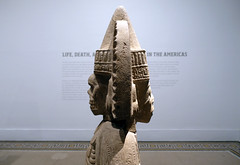




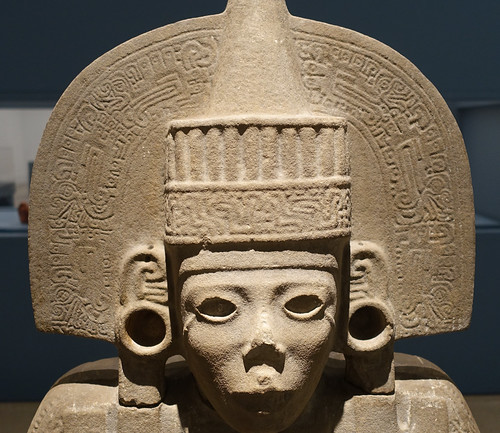
Mixtec
Codex Zouche-Nuttall

This is one of a small number of known Mexican codices (screenfold manuscript books) dating to pre-Hispanic times. It is made of deer skin and comprises 47 leaves.
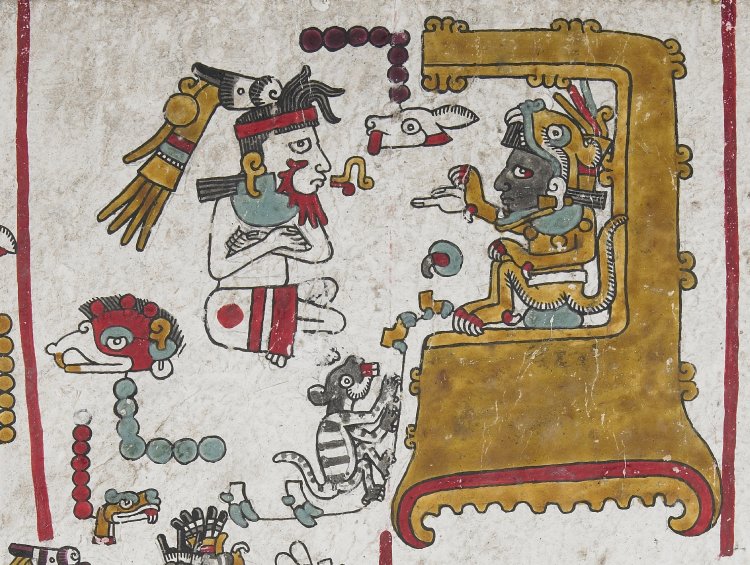
The powerful ruler Eight Deer Jaguar-Claw can be seen here (above), sitting on a throne with his name next to him (8 circles and a deer’s head).
The Zouche-Nuttall Codex contains two narratives: one side of the document relates the history of important centres in the Mixtec region, while the other, starting at the opposite end, records the genealogy, marriages and political and military feats of the Mixtec ruler, Eight Deer Jaguar-Claw. This ruler is depicted at top center, next to his calendric name (8 circles and a deer’s head). It was made by the Mixtec people, some of whom joined the Aztec empire. It uses a kind of picture-writing showing important Mixtec events, with special signs for names and dates.
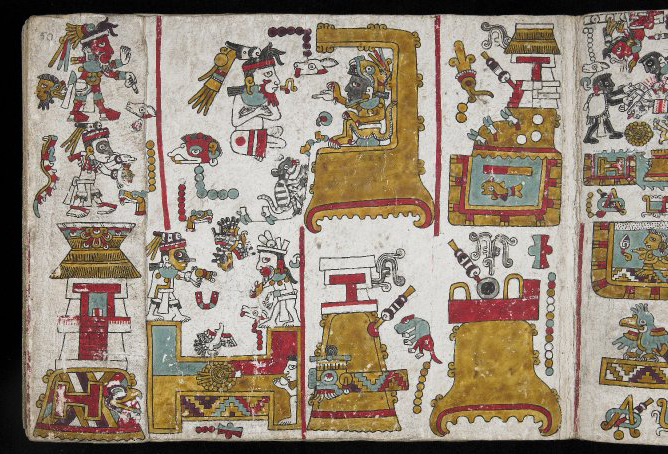
Very few Mesoamerican pictorial documents have survived destruction and it is not clear how the Codex Zouche-Nuttall reached Europe. In 1859 it turned up in a Dominican monastery in Florence. Years later, Sir Robert Curzon, 14th Baron Zouche (1810-73), loaned it to The British Museum. His books and manuscripts were inherited by his sister, who donated the Codex to the Museum in 1917. The Codex was first published by Zelia Nuttall in 1902.
Suggested readings:
E.H. Boone, Stories in red and black: Pictorial Histories of the Aztecs and Mixtecs (Austin, University of Texas Press, 2000).
Z. Nuttall, Facsimile of an Ancient Mexican Codex Belonging to Lord Zouche of Harynworth, England (Cambridge, Mass., Peabody Museum of American Archaeology and Ethnology, Harvard University, 1902).
G. Brotherstone, Painted books of Mexico (London, The British Museum Press, 1995).
C. McEwan, Ancient Mexico in the British (London, The British Museum Press, 1994).
F. Anders, M. Jansen and G. A. Pérez Jiménez, Códice Zouche-Nuttall, facsimile with commentary and line drawing (Madrid, Sociedad Estatal Quinto Centenario; Graz, Akademische Druck-u. Verlagsanstalt; Mexico City, Fondo de Cultura Económica, 1992).
© Trustees of the British Museum
Aztec (Mexica) art
The Aztecs called themselves the Mexica—the root of the name for today's Mexico.
1325-1521 C.E.
Introduction to the Aztecs (Mexica)
Video \(\PageIndex{13}\): Speakers: Dr. Lauren Kilroy-Ewbank and Dr. Beth Harris
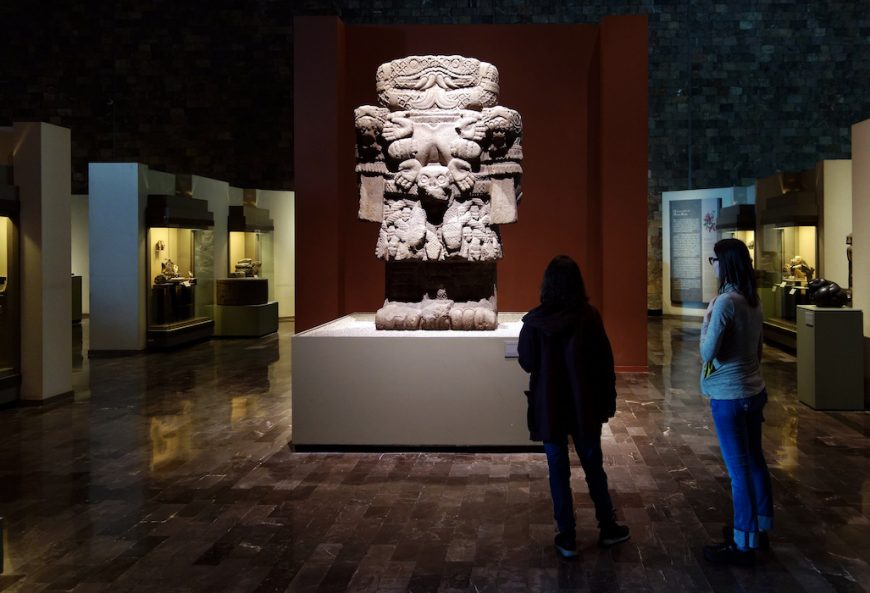
If you travel to Mexico City today, chances are you might visit museums such as the Templo Mayor Museum in the heart of the city or the National Museum of Anthropology in Chapultepec Park. Either is sure to dazzle you with an impressive array of exquisitely crafted objects (that we typically label as “artworks”), ranging from monumental stone sculptures and shell mosaics to colorfully painted ceramics and figurines. At both museums, Aztec art is the centerpiece: excavations at the Aztec Templo Mayor fill the onsite museum, and Aztec art similarly occupies the central galleries within the Anthropology museum. The Aztecs were only one group that made up the diverse indigenous peoples of Mesoamerica, but they were among those groups that encountered Europeans when they arrived in the Americas. Collections like those at the Templo Mayor museum or National Museum of Anthropology attest to the skill and creativity of Aztec artists.
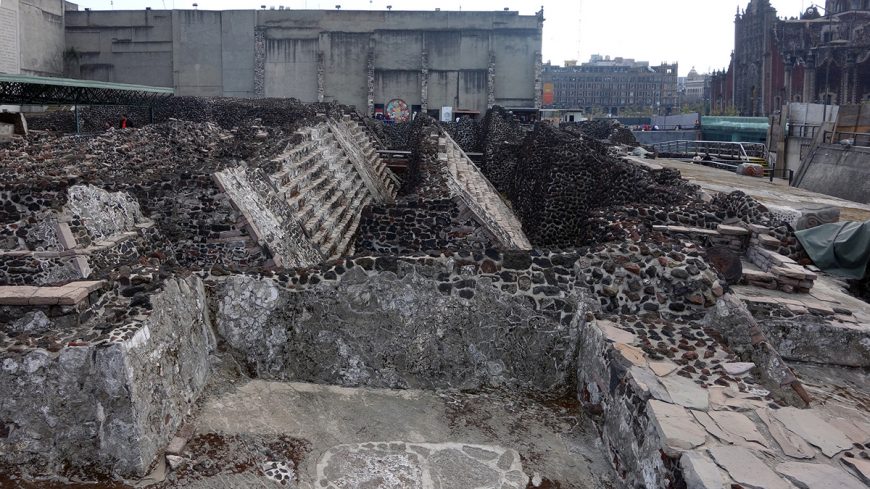
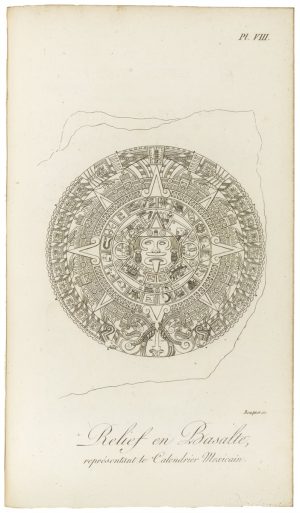
What’s in a name?
The German explorer and scientist Alexander von Humboldt arrived in Mexico in 1803 after traveling throughout parts of Latin America. Impressed by what he experienced and saw in Mexico City, he became interested in the country’s indigenous past (the country was then still New Spain). He wrote about the Aztecs and created illustrations of their sculptures. In 1810, he used the name “Aztecs” to describe the powerful Mesoamerican people who had built a vast empire in Mexico and who encountered the Spaniards in 1519. He adapted the name Aztec from the Nahua word Aztlan, which referred to their mythical homeland. Several decades later, the historian William H. Prescott popularized the term, and it is still common today.
But what did the Aztecs call themselves? They referred to themselves as the Mexica. Those who lived in their capital city, Tenochtitlan, were the Tenochca-Mexica. The Mexica formed part of a larger ethnic group known as the Nahua, who spoke Nahuatl. Unfamiliar with this language? You might know a few words: chocolate, chipotle, coyote, tomato, and avocado derive from Nahuatl words. Even the name Mexico, adopted after Mexicans gained independence from Spain in 1821, comes from Mexica.
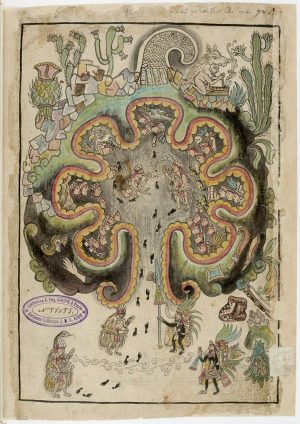
Where did the Mexica come from?
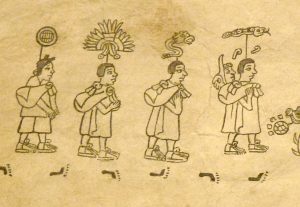
Several myths describe the migration of the Mexica from Aztlan, thought to be somewhere in northern Mexico or the southwestern United States. The Mexica departed Chicomoztoc at the urging of their patron deity, Huitzilopochtli, to journey to establish a new settlement.
Early colonial codices (books), like the Codex Boturini, show this migration, with footprints indicating the direction the ancestors walked on their journey. In this particular codex, we even see Huitzilopochtli carried on the back of one of the individuals migrating, alluding to his role in the migration.
Huitzilopochtli told the Mexica to look for a sign—an eagle on a cactus—that would tell them where to settle. Their migration led them to the Valley of Mexico. They were generally disliked by other groups who found the Mexica uncivilized or unrefined, largely because they were foreigners who worked initially as mercenaries for other people living around Lake Texcoco.
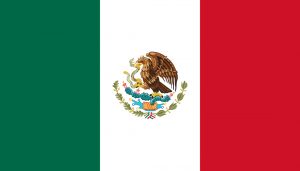
According to Mexica mytho-historical textual sources (written down in the early colonial period), they finally witnessed the sign on an island in the middle of Lake Texcoco in the year 1325. It was there that they established Tenochtitlan, their capital city. They connected the city to the mainland with causeways to make coming and going to the city more efficient. If you look at the Mexican flag today, you will see a reference to this origin story. In the center of the flag an eagle is represented on a cactus, and the eagle stands on a glyph for stone and water.
Forging an empire
As they developed their city and gained more prominence in the Valley of Mexico, the Mexica formed an alliance with Texcoco (Tetzcoco) and Tlacopan (today, Tacuba), known as the Triple Alliance. Really, when we refer to the “Aztecs,” we are talking about the people who formed this alliance.
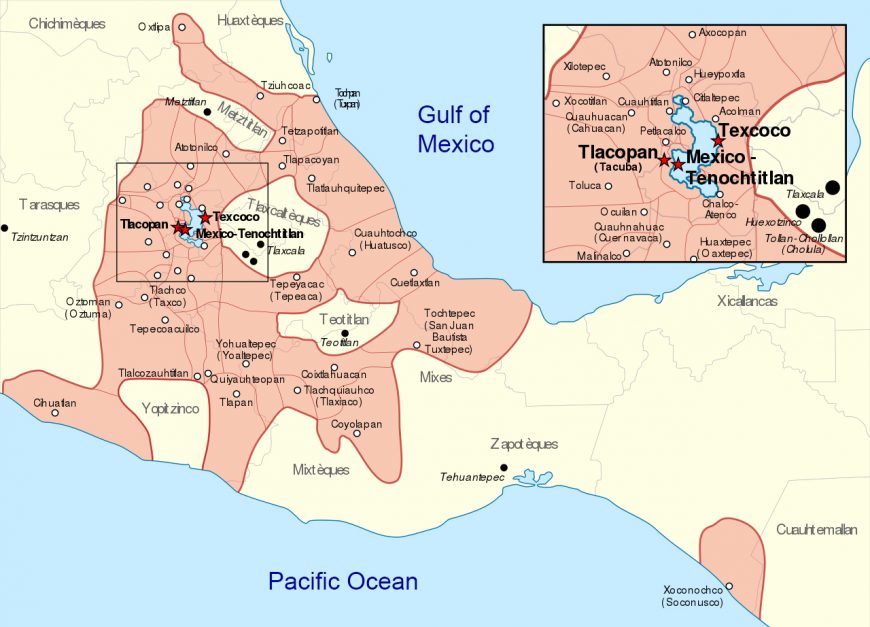
War was common in the Aztec empire. There were two main types of wars: one was primarily for conquest and expansion of the empire, while the other involved a more ritualized form of battle, called “flowery wars.” The flowery wars may have served several functions, including training soldiers, capturing individuals for sacrifice, or weakening enemies.
The Triple Alliance had a large and powerful military that conquered many peoples throughout Mesoamerica. Tribute was gathered from those the Alliance controlled, and we can see a record of this in the mid-sixteenth-century Codex Mendoza. Tribute lists show what items, like bird feathers, greenstone or jade, and textiles, that peoples controlled by the Mexica sent back to Tenochtitlan.
Uprisings against Aztec control were common, meaning that armed conflicts occurred with regularity. Many of these conquered peoples, or even those who successfully managed to maintain independence but still disliked the Aztecs, joined with Hernan Cortés’s army when he journeyed towards Tenochtitlan in 1519.
Mexica rulers
The Mexica ruler was known as the huey tlatoani (“chief speaker”; pronunciation: whey-tla-toe-anee). There were eleven tlatoque (the plural form of tlatoani) of Tenochtitlan, beginning with Acamapichtli in 1375 and ending with Cuauhtemoc in 1525. The huey tlatoani was tasked with maintaining the city, participating in important rituals, and overseeing the military. They lived in large, sumptuous palaces. Moteuczoma II Xocoyotzin’s palace had rooms for living quarters, meetings, and storage, but also had gardens, a zoo, and even an aviary. The colonial Florentine Codex describes the zoo as having “ocelots, bears, mountain lions, and mountain cats… eagles… and various birds.” The royal palaces bordered the most important location in the capital—the sacred precinct—which was thought to symbolize the navel of the universe, or axis mundi.
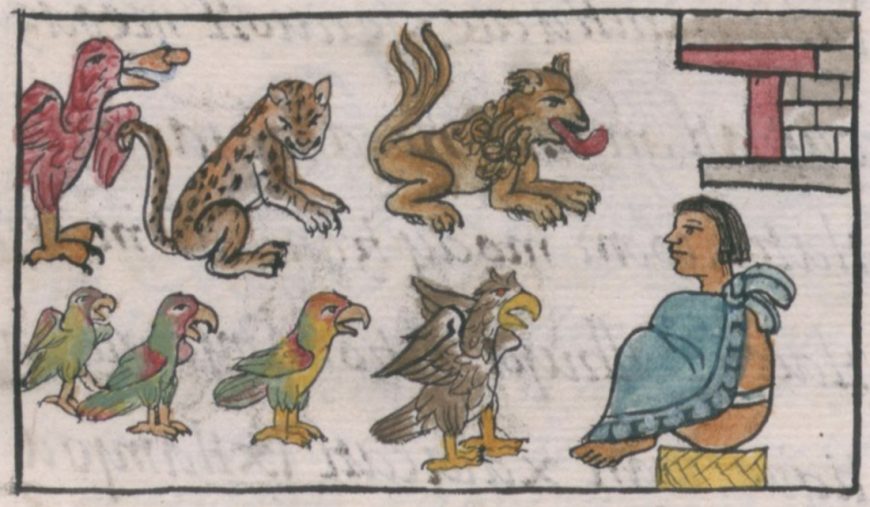
Sustaining an empire
Tenochtitlan was a bustling city, with more than 100,000 people living in it. Food and water were of great concern, especially because the city was located on an island in a lake. Chinampas, or floating gardens, provided the food necessary to sustain the Aztec empire. They consisted of human-made islands where crops could be grown. Food staples included maize, squash, and beans. Some chinampas were even used to grow flowers exclusively. If you visit Xochimilco today, you can get a sense of what chinampas look like, with people still navigating canals amidst floating gardens.
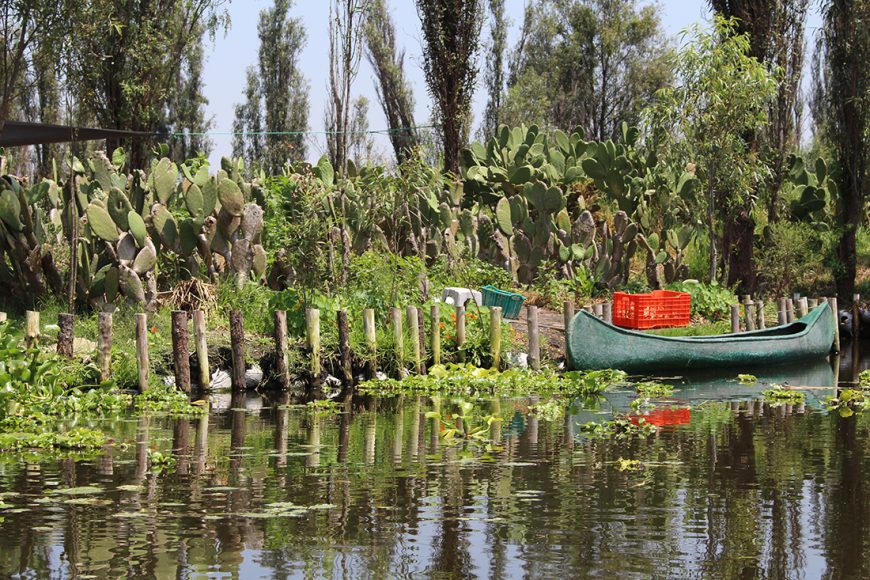
Large aqueducts brought fresh water to the capital. These massive engineering projects were supported by the huey tlatoani because they were critical to the survival of his people.
A complex pantheon of deities
The Mexica had numerous deities in their religious pantheon. The two most important deities were Huitzilopochtli and Tlaloc, a rain and agricultural god. Their significance was symbolized by the twin temples atop the Templo Mayor in the center of Tenochtitlan.
Placed within the heart of the sacred precinct, the Templo Mayor was the largest and most important temple in the empire. One side symbolized Tlaloc, and included objects, symbols, and colors (like blue-green) associated with the rain god. The other side symbolized Huitzilopochtli, and similarly used a variety of means to convey his warrior and solar associations. Together, Tlaloc and Huitzilopochtli communicated the Mexica focus on warfare. Fire and water, known in Nahuatl as atl-tlachinolli (“burnt water”; pronunciation: at-ul tlach-ee-no-lee), symbolized war, which was essential to the expansion of the Mexica empire.
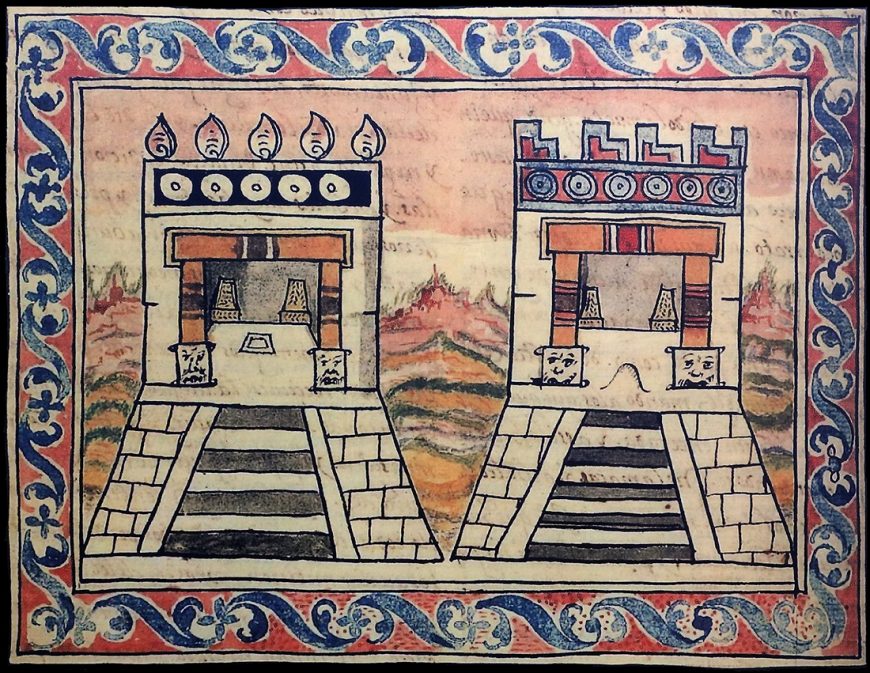
Other important deities included:
- Tezcatlipoca (“Smoking Mirror”), patron of rulers. He is also associated with sorcery, symbolized by the obsidian mirror that he wears
- Quetzalcoatl (“Feathered Serpent”), a god with a long history in Mesoamerica. He was associated with the planet Venus, with wind, and also with fertility
- Chalchiuhtlicue (“She of the Jade Skirt”) a goddess of water fertility, and associated with Tlaloc. While Tlaloc presided over rain, she was associated with bodies of water like lakes and rivers
- Chicomecoatl (“Seven Serpent”) and Cinteotl (“Maize God”), both associated with maize and sustenance
- Mictlancihuatl (“Lady of Mictlan”) and Mictlantecuhtli (“Lord of Mictlan”), deities of death and who presided over Mictlan, the underworld
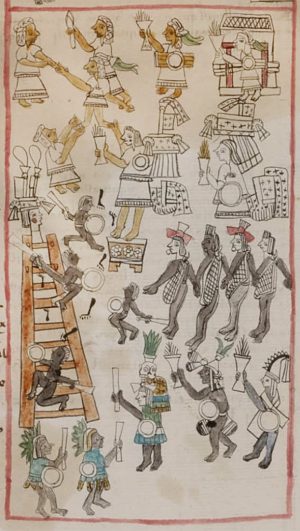
Aztec calendars
The Aztecs had two different calendars: a 260-day ritual calendar called the tonalpohualli (day count), and a 360-day (plus 5 extra days) calendar called the xiuhpohualli (year count). The xiuhpohualli was divided into eighteen months of twenty days each, and each of these months had a festival that honored a specific deity or deities.
These festivals often included music, dancing, offerings, and sacrifice (whether self-sacrifice or human sacrifice). For instance, the eleventh month had the festival of Ochpaniztli (“sweeping of the roads”), which occurred sometime between August to September (or September to October by some accounts), and was intended to celebrate the fall harvest. It honored the earth goddess(es) Tlazolteotl and Toci, and involved sweeping. Sweeping here related literally to cleaning, but also symbolically to fertility, because Tlazolteotl was a goddess associated with filth, but also childbirth. She was a patron of midwives and adulterers.
Aztec art
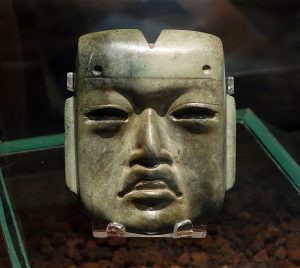
Aztec artists worked in a number of different media, from monumental stone sculptures, terracotta sculptures, and murals to codices, featherworks, and mosaics. Stone sculptures like Coatlicue (top of the page) demonstrate the expertise and skill of stone carvers. The sculpture is over-life size, and is carved from a single stone. The patterning on the serpents that form her skirt replicate actual serpent skin. The combination of naturalistic elements paired with more abstract ones is characteristic of Aztec art in general.
The Aztecs were also interested in the arts of earlier cultures, and would bring objects back to Tenochtitlan where they might be buried as part of offerings. At the Templo Mayor, for instance, we find Olmec masks dating to more than a thousand years earlier that were reburied in ritual offerings at the main Aztec temple. Some Aztec art is intentionally archaizing, or fashioned to look like older “archaic” art like that found at Teotihuacan.
Writing with pictures
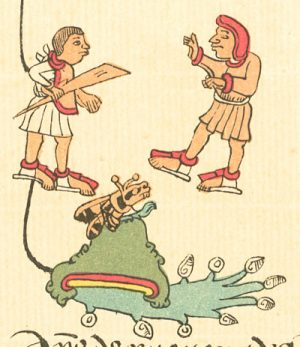
Aztecs used picture-writing rather than an alphabetic script like the one you are reading here. A combination of glyphs and images made up this form of writing. For instance, the image of a hill designated a place, and a specific image accompanying the symbol for hill designated the specific place. Chapultepec, for example, would include a hill (tepetl) and a grasshopper (chapolin). A scroll placed in front of someone’s mouth indicated talking or speech (in Nahuatl, this is called tlatolli). The huey tlatoani Motecuzoma Ilhuicamina’s name means “arrow piercing sky,” and his name glyph shows an arrow piercing the sky.
The Spanish conquest
The Aztec empire crumbled after the defeat of Tenochtitlan in 1521. Cortés and his men, along with thousands of indigenous allies who despised the Aztecs, eventually defeated them after cutting off their water supply. People in the capital city fell sick largely because they lacked immunity to European diseases, and their military forces were weakened.
Aztec culture did not disappear, however. Mesoamerican traditions and art continued into what we call the colonial or viceregal era. Even though some forms disappeared, others were transformed, and still others continued unchanged.
Ongoing excavations in and around Mexico City continue to alter our understanding of this diverse and fascinating culture as they reveal more Mexica art and architecture. Recent excavations near the Templo Mayor uncovered the largest Aztec monolith to date, called the Tlaltecuhtli Monolith. It is believed that this monolith may mark the spot of a huey tlatoani’s tomb, and some of the items discovered underneath this monolith are helping us to rewrite what we know about Aztec culture and art.
Additional resources:
Tenochtitlan on The Metropolitan Museum of Art’s Heilbrunn Timeline of Art History
Aztec stone sculpture on The Metropolitan Museum of Art’s Heilbrunn Timeline of Art History
More on the Aztecs (Mexica)
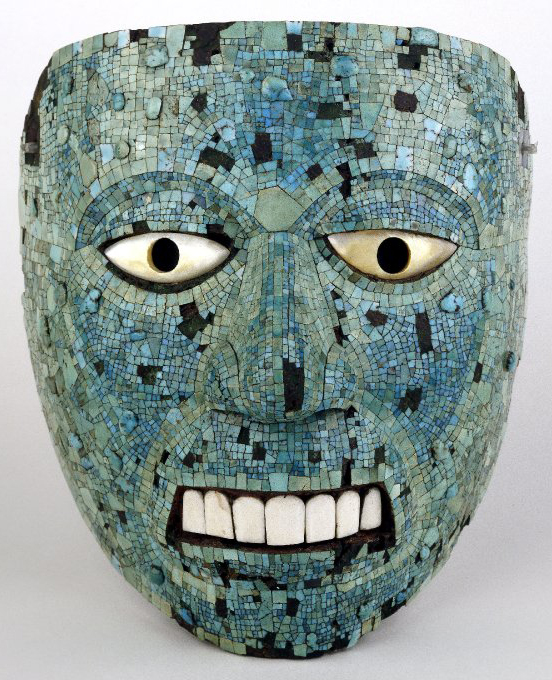
During the twelfth century C.E. the Aztec (or Mexica*) were a small and obscure tribe searching for a new homeland. Eventually they settled in the Valley of Mexico and founded their capital, Tenochtitlan, in 1345. At the beginning of the sixteenth century it was one of the largest cities in the world.
The Mexica were a migrant people from the desert north who arrived in Mesoamerica in the 1300s. This previously nomadic tribe was not welcomed by the local inhabitants who viewed them as inferior and undeveloped. Legend tells that as a result the Mexica wandered waiting for a sign to indicate where they should settle. It is said that in 1325 C.E. this sign, an eagle and serpent fighting on a cactus, was seen at Lake Texcoco prompting the Mexica to found their capital city, Tenochtitlan.
Tenochtitlan
The Aztec capital city, Tenochtitlan, was founded on a small piece of land in the western part of Lake Texcoco. The city was contained within high mountains and surrounding lake and marshes. To create living and farming space the Aztecs sank piles into the marshes and formed small land masses called chinampas, or floating gardens. Tenochtitlan was highly developed with causeways between islands for transport, aqueducts to carry fresh water and sewers to dispose of waste. The city developed into a metropolis led by a ruling leader and supported by noble classes, priests, warriors and merchants. By the early 1500s it contained an array of pyramids, temples, palaces and market places.
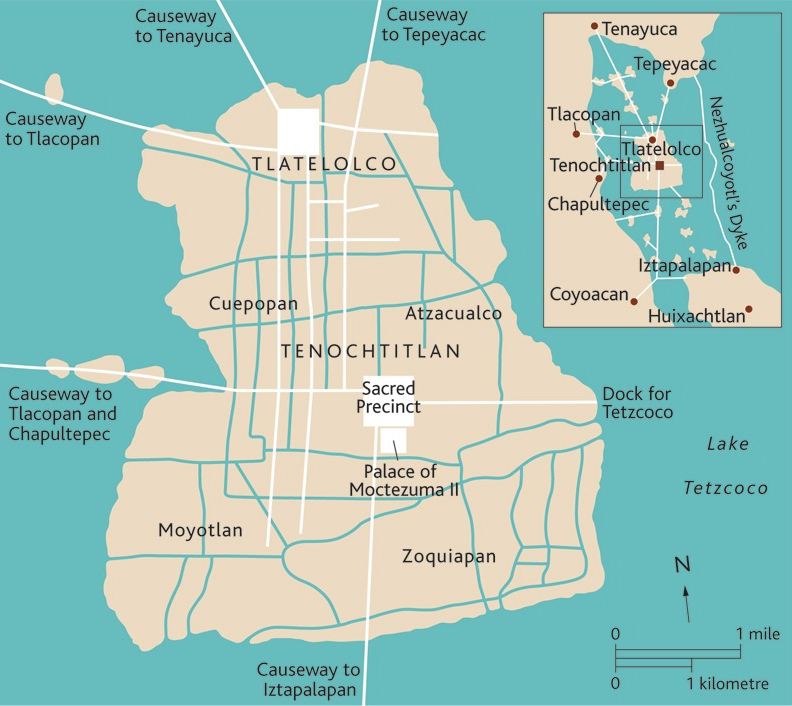
By 1430 C.E. the Mexica had assimilated aspects of the surrounding tribes and developed into a structured society. Their military became powerful and campaigns were fought and won. The Triple Alliance was created with the lords of Texcoco (situated on the eastern shores of Lake Texococo) and Tlacopan (sometimes referred to as Tacuba, situated on the western shores of Lake Texococo) further strengthening Aztec power.
A huge empire

Warfare was extremely important for the Mexica people and led them to conquer most of modern-day central and southern Mexico. They controlled their huge empire through military strength, a long-distance trading network and the tribute which conquered peoples had to pay. The Mexica went to war for two main reasons; to exact tribute and to capture prisoners. They needed prisoners because they believed that the gods must be appeased with human blood and hearts to ensure the sun rose each day. Conquering new regions brought the opportunity to capture slaves who were an important part of Mexica society. Under a succession of rulers armies were sent further across Mexico. By the start of the 1500s the Mexica empire stretched from the Atlantic to the Pacific and into Guatemala and Nicaragua.
The Mexica designed roads for travel by foot because there were no draught animals. These roads were well maintained and boosted trade both for the Mexica and for the tribes under their control. They also enabled the Aztecs to be informed of events across their empire. The Mexica exported luxury items such as jewelry and garments manufactured from imported raw materials. They also exported goods such as lake salt and ceramic goods. Exotic luxuries such as animal skins, feathers, rubber and jade came from the distant southern tropics. Beautiful manufactured goods such as jewelry, textiles and pottery came from craft centers, a famous example of which is Cholula (in the modern Mexican state of Puebla). Traded goods even came from as far away as southern New Mexico and raw materials from Central America appeared in the markets of Tenochtitlan.
Complex religious beliefs
Stone sculpture in the British Museum collection reflects the Mexica’s complex religious beliefs and the large pantheon of gods they worshipped. Their sophisticated ritual calendar reflected the rhythms of the agricultural year and their ceramic sculptures are noted for their visual impact. Musical instruments such as drums were decorated with intricate carvings, probably because of the importance of music during Mexica rituals.
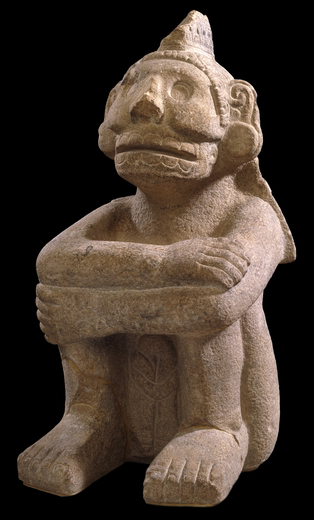
This sculpture represents Mictlantecuhtli, an Aztec god associated with death. It is made from a sandstone which is not found in the Mexican highlands and was probably obtained in Veracruz. The figure bears three glyphs, carved on his back: “Two Skull,” “Five Vulture,” and “Four House.”
Mictlantecuhtli, and his counterpart Mictlancihuatl, inhabited the lowest of the nine levels in which the Underworld (Mictlan) was divided. The “soul” of the deceased went to a particular level in Mictlan according to the circumstances of their death. Those who died of natural causes went to the ninth level and had to negotiate all sorts of obstacles to reach it. To help the “souls” in their dangerous journey the deceased were cremated with some of their possessions, especially the tools they used in life.
Two spectacular ceramic figures of Mictlantecuhtli were recovered in the 1980s from the “House of the Eagles,” a building located in the Sacred Precinct of the Mexica capital, Tenochtitlan. These colossal figures had traces of blood on them. This is consistent with depictions in the codices (screenfold books) of ceremonies in which an image of Mictlantecuhtli, or a person representing him, is bathed with blood.
Craftsmen also worked in gold, turquoise mosaic and feathers. Most pieces were destroyed by the Spanish invaders, but the British Museum holds a number of turquoise mosaics, the most beautiful of which were produced by Mixtec craftsmen and sent to the Mexica as tribute.
Spanish rule
Hernán Cortés and his small Spanish army arrived in 1519 and overthrew the Mexica ruler Moctezuma Xocoyotzin with relative ease. This was partly due to the latter’s weakness, as well as the Spaniards’ superior weaponry, their unfamiliar battle tactics and the devastation of the Mexica population by European disease. Mexico remained under Spanish rule until gaining independence in 1821 C.E.
*The people and culture we know as “Aztec” referred to themselves as the Mexica (pronounced ‘Mé-shee-ka’).
© Trustees of the British Museum
Coatlicue
Video \(\PageIndex{14}\): Coatlicue, c. 1500, basalt, 257 cm high, Mexica (Aztec), found on the SE edge of the Plaza mayor/Zocalo in Mexico City (National Museum of Anthropology, Mexico City)

Mother, goddess, sacrificial offering?

The Coatlicue sculpture in Mexico City’s National Museum of Anthropology is one of the most famous Mexica (Aztec) sculptures in existence (her name is pronounced “koh-at-lee-kway”). Standing over ten feet tall, the statue towers over onlookers as she leans toward them. With her arms bent and pulled up against her sides as if to strike, she is truly an imposing sight.
Numerous snakes appear to writhe across the sculpture’s surface. In fact, snakes form her entire skirt, as well as her belt and even her head. Coatlicue’s name literally means Snakes-Her-Skirt, so her clothing helps identify her. Her snake belt ties at the waist to keep a skull “buckle” in place. Her upper torso is exposed, and we can just make out her breasts and rolls in her abdomen. The rolls indicate she is a mother. A sizable necklace formed of hands and hearts largely obscures her breasts.
Two enormous snakes curl upwards from her neck to face one another. Their bifurcated, or split, tongues curl downwards, and the resulting effect is that the snake heads and tongues appear to be a single, forward-facing serpent face. Snakes coming out of body parts, as we see here, was an Aztec convention for squirting blood. Coatlicue has in fact been decapitated, and her snaky head represents the blood squirting from her severed neck. Her arms are also formed of snake heads, suggesting she was dismembered there as well.

You might read elsewhere that Coatlicue was decapitated by her daughter or beheaded when her son was born from her severed neck (the idea has been adopted in part to explain this monumental sculpture). However, the myth from which this story derives does not actually state that Coatlicue suffered this fate. For this reason, it is useful to review the myth—one of the most important for the Aztecs.
Battle atop Snake Mountain
The primary myth in which Coatlicue is involved recounts the birth of the Aztec patron deity, Huitzilopochtli (pronounced “wheat-zil-oh-poach-lee”). This myth was recorded in the later sixteenth century after the Spanish Conquest of 1521. The main source from which we learn about it is the General History of the Things of New Spain, also called The Florentine Codex (written 1575–77 and compiled by the Franciscan friar Bernardino de Sahagún, indigenous authors and artists, and indigenous informants).[1]

One day Coatlicue, an earth goddess, was sweeping atop Coatepec (or Snake Mountain), when a feather fell into her apron. At that moment, she immaculately conceived a son, whose name was Huitzilopochtli (a sun and warrior god). Upon hearing that her mother was pregnant, Coyolxauhqui (or Bells-Her-Cheeks, pronounced “coy-al-shauw-kee”) became enraged. She rallied her 400 brothers, the Centzonhuitz-nahua, to storm Snake Mountain and kill their mother.
One of the brothers decided to warn Coatlicue. Upon hearing of this impending murder, Coatlicue became understandably afraid. But Huitzilopochtli comforted her, telling her not to worry. At the moment Coyolxauhqui approached her mother, Huitzilopochtli was born, fully grown and armed. He sliced off his sister’s head, and threw her body off the mountain. As she fell, her body broke apart until it came to rest at the bottom of Snake Mountain.
But what became of Coatlicue, the mother to the victorious Huitzilopochtli and the defeated Coyolxauhqui? The myth does not mention her decapitation and dismemberment (only her daughter’s), so why would this famous sculpture display her in this manner?
Why was Coatlicue decapitated?
More recently, a new interpretation has been offered for Coatlicue’s appearance that is based on another myth (recounted in different Spanish Colonial source) concerning the beginning of 5th era, or 5th sun.The Aztecs believed that there were four earlier suns (or eras) prior to the one in which we currently live. The myth notes that several female deities (perhaps Coatlicue among them), sacrificed themselves to put the sun in motion, effectively allowing time itself to continue. They were responsible for preserving the cosmos by offering their own lives.

After this point, these female deities were then symbolized by their skirts (called mantas), which could explain the careful attention paid to Coatlicue’s snaky skirt. It functions as a reminder of her name—Snakes-Her-Skirt—as well as symbolizing her as a deity and reminding the viewer of her past deeds. This might also explain why—in place of her head—we have two snakes rising from her severed neck. They represent streaming blood, which was a precious liquid connoting fertility. With her willing sacrifice, Coatlicue enabled life to continue.
Some details on the sculpture support this newer and enticing interpretation. There is a date glyph, 12 Reed, inscribed on the sculpture’s back which might relate to the beginning of a new solar era. Archaeologists have also found the remains of several other monumental sculptures of female deities similar to Coatlicue, but each display different skirts. One of these sculptures (see photo at top of the page) stands near to Coatlicue in the Anthropology Museum, but hearts adorn her skirt instead of snakes.

Despite her fame in one of the most important Aztec myths concerning their patron god, Coatlicue did not have numerous stories recorded about her during the sixteenth century (that we know of at least). Few surviving Aztec objects display her. However, another stone sculpture in the National Museum of Anthropology—on a much smaller scale—shows Coatlicue with her head intact. We can identify her by her snaky skirt. Her face is partly skeletonized and de-fleshed. Her nose is missing, revealing the cavity. Yet she still has flesh on her lips, which are open to reveal bared teeth. Even with her head, this version of Coatlicue still seems intimidating to us today. But was she perceived as terrifying by the Aztecs or is this only a twenty-first century impression of her?
Terrifying and respected
Prior to the Spanish Conquest, Coatlicue related to other female earth deities, such as Toci (Our Grandmother). Several sixteenth-century Spanish Colonial sources mention that Coatlicue belonged to a class of deities known as tzitzimime (deities related to the stars), who were considered terrifying and dangerous. For example, outside of the 360-days that formed the agricultural calendar (called the year count or xiuhpohualli), there were five extra “nameless” days. The Aztecs believed this was an ominous time when bad things could happen. The tzitzimime, for instance, could descend to the earth’s surface and eat people or at least wreak havoc, causing instability and fear. In Spanish Colonial chronicles, the tzitzimime are depicted with skeletonized faces and monster claws—similar to what we see in Coatlicue sculptures discussed here. These sources also call the tzitzimime demons or devils.
For all their ferociousness, however, the tzitzimime also had positive associations. Ironically, this group of deities were patrons of midwives, or women responsible for helping mothers with their babies. People also invoked them for medical help and they had associations with fertility. For these reasons, they had a more ambivalent role than as simply good or bad deities, and so they were both respected and feared.
Created, buried, found, buried, found again
After the Spanish Conquest, the monumental Coatlicue sculpture was buried because it was considered an inappropriate pagan idol by Spanish Christian invaders. After languishing in obscurity for more than 200 years, it was rediscovered in 1790.

Antonio León y Gama, a curious historian, astronomer, and intellectual living in Mexico City at the time, drew illustrations of the sculpture and offered his interpretation of who it displayed (he claimed it was Teoyaomiqui). Not long after it was found, however, Coatlicue was reburied—she was considered too frightening and pagan. Eventually, she was uncovered again in the twentieth century, becoming one of the crowning objects of the National Anthropology Museum and a famous representative of Aztec artistic achievements in stone sculpture.
[1] There are several other myths that make mention of Coatlicue, but the most frequently cited myth is the one in the Florentine Codex discussed in the text.
Additional resources:
Famsi on Aztec monumental sculpture
Antonio León y Gama’s text in Spanish from the Kislak Collection
Elizabeth M. Brumfiel and Gary M. Feinman, eds., The Aztec World (New York: Abrams, 2008).
Cecelia Klein, “A New Interpretation of the Aztec Statue Called Coatlicue, ‘Snakes-Her-Skirt’,” Ethnohistory vol. 55, no. 2 (Spring 2008), pp. 229-250.
Esther Pasztory, Aztec Art (University of Oklahoma Press, 1983).
Richard Townsend, The Aztecs, 3 ed. (London: Thames and Hudson, 2009).
Davíd Carrasco and Eduardo Matos Moctezuma, eds. Moctezuma’s Mexico: Visions of the Aztec World, revised (University Press of Colorado, 2003).
For myths in the Florentine Codex, see Charles E. Dibble and Arthur J. O. Anderson, eds. Florentine Codex: General History of the Things of New Spain, 12 vols., (Salt Lake City: University of Utah Press, 1950–82).
SmartHistory images for teaching and learning:
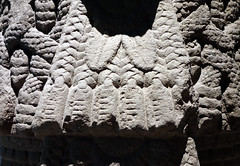
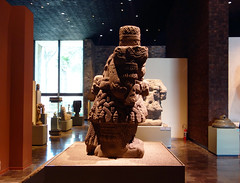
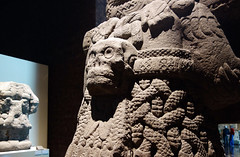



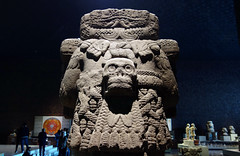
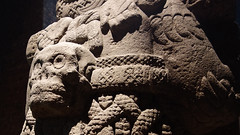
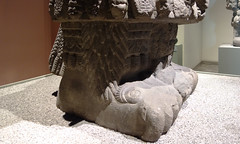
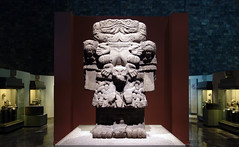
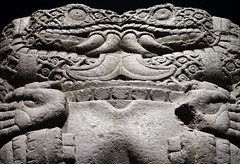

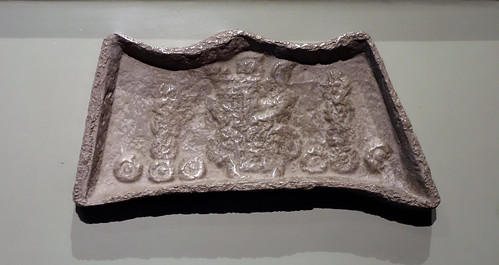
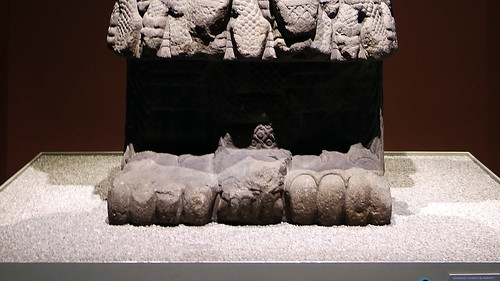
The Templo Mayor and the Coyolxauhqui Stone
Video \(\PageIndex{15}\): Unearthing the Aztec past, the destruction of the Templo Mayor (Mexico City) . Speakers: Dr. Lauren Kilroy-Ewbank and Dr. Steven Zucker
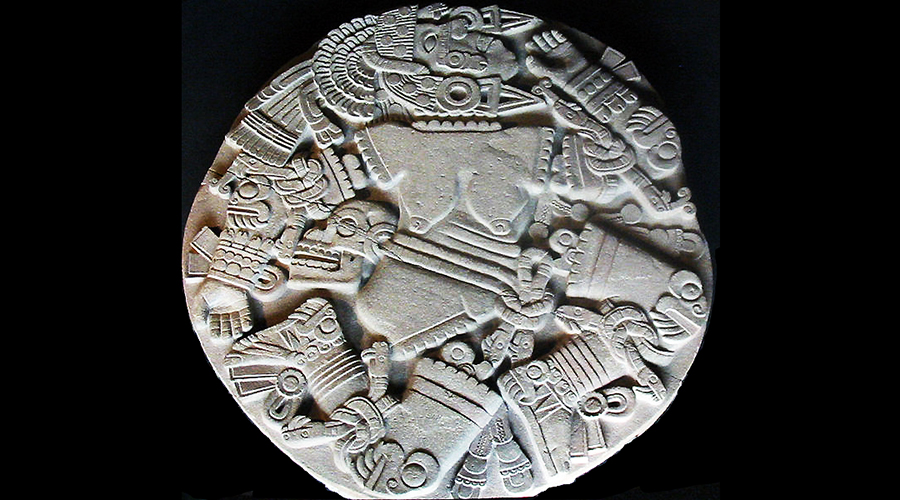
In 1978, electrical workers in Mexico City came across a remarkable discovery. While digging near the main plaza, they found a finely carved stone monolith that displayed a dismembered and decapitated woman. Immediately, they knew they found something special. Shortly thereafter, archaeologists realized that the monolith displayed the Mexica (Aztec)¹ goddess Coyolxauhqui, or Bells-Her-Cheeks, the sister of the Mexica’s patron god, Huitzilopochtli (Hummingbird-Left), who killed his sister when she attempted to kill their mother. This monolith led to the discovery of the Templo Mayor, the main Mexica temple located in the sacred precinct of the former Mexica capital, known as Tenochtitlan (now Mexico City).
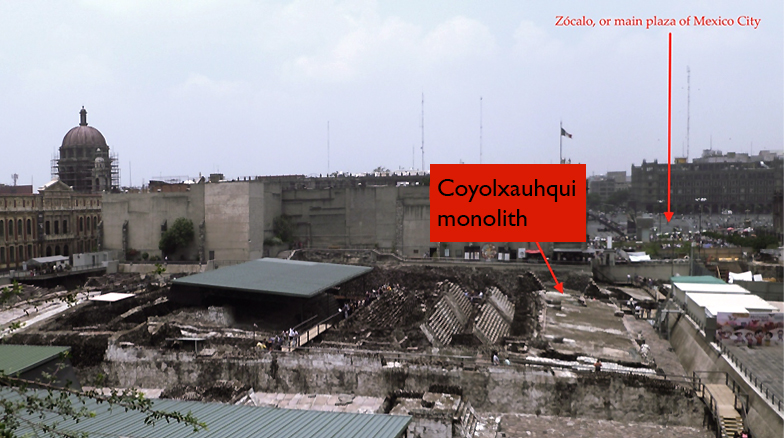
The Templo Mayor

The city of Tenochtitlan was established in 1325 on an island in the middle of Lake Texcoco (much of which has since been filled in to accommodate Mexico City which now exists on this site), and with the city’s foundation the original structure of the Templo Mayor was built. Between 1325 and 1519, the Templo Mayor was expanded, enlarged, and reconstructed during seven main building phases, which likely corresponded with different rulers, or tlatoani (“speaker”), taking office. Sometimes new construction was the result of environmental problems, such as flooding.


Located in the sacred precinct at the heart of the city, the Templo Mayor was positioned at the center of the Mexica capital and thus the entire empire. The capital was also divided into four main quadrants, with the Templo Mayor at the center. This design reflects the Mexica cosmos, which was believed to be composed of four parts structured around the navel of the universe, or the axis mundi.
The Templo Mayor was approximately ninety feet high and covered in stucco. Two grand staircases accessed twin temples, which were dedicated to the deities Tlaloc and Huitzilopochti. Tlaloc was the deity of water and rain and was associated with agricultural fertility. Huitzilopochtli was the patron deity of the Mexica, and he was associated with warfare, fire, and the Sun.

Paired together on the Templo Mayor, the two deities symbolized the Mexica concept of atl-tlachinolli, or burnt water, which connoted warfare—the primary way in which the Mexica acquired their power and wealth.
The Huitzilopochtli Temple
In the center of the Huitzilopochtli temple was a sacrificial stone. Near the top, standard-bearer figures decorated the stairs. They likely held paper banners and feathers. Serpent balustrades adorn the base of the temple of Huitzilopochtli, and two undulating serpents flank the stairs that led to the base of the Templo Mayor as well.

But by far the most famous object decorating the Huiztilopochtli temple is the Coyolxauhqui monolith, found at the base of the stairs. Originally painted and carved in low relief, the Coyolxauhqui monolith is approximately eleven feet in diameter and displays the female deity Coyolxauhqui, or Bells-on-her-face. Golden bells decorate her cheeks, feathers and balls of down adorn her hair, and she wears elaborate earrings, fanciful sandals and bracelets, and a serpent belt with a skull attached at the back. Monster faces are found at her joints, connecting her to other female deities—some of whom are associated with trouble and chaos. Otherwise, Coyolxauhqui is shown naked, with sagging breasts and a stretched belly to indicate that she was a mother. For the Mexica, nakedness was considered a form of humiliation and also defeat. She is also decapitated and dismembered. Her head and limbs are separated from her torso and are organized in a pinwheel shape. Pieces of bone stick out from her limbs.

The monolith relates to an important myth: the birth of the Mexica patron deity, Huitzilopochtli. Apparently, Huitzilopochtli’s mother, Coatlicue (Snakes-her-skirt), became pregnant one day from a piece of down that entered her skirt. Her daughter, Coyolxauhqui, became angry when she heard that her mother was pregnant, and together with her 400 brothers (called the Centzonhuitznahua) attacked their mother. At the moment of attack, Huitzilopochtli emerged, fully clothed and armed, to defend his mother on the mountain called Coatepec (Snake Mountain). Eventually, Huitzilopochtli defeated his sister, then beheaded her and threw her body down the mountain, at which point her body broke apart.

The monolith portrays the moment in the myth after Huitzilopochtli vanquished Coyolxauhqui and threw her body down the mountain. By placing this sculpture at the base of Huiztilopochtli’s temple, the Mexica effectively transformed the temple into Coatepec. Many of the temple’s decorations and sculptural program also support this identification. The snake balustrades and serpent heads identify the temple as a snake mountain, or Coatepec. It is possible that the standard-bearer figures recovered at the Templo Mayor symbolized Huitzilopochtli’s 400 brothers.
Ritual performances that occurred at the Templo Mayor also support the idea that the temple symbolically represented Coatepec. For instance, the ritual of Panquetzaliztli (banner raising) celebrated Huitzilopochtli’s triumph over Coyolxauhqui and his 400 brothers. People offered gifts to the deity, danced and ate tamales. During the ritual, war captives who had been painted blue were killed on the sacrificial stone and then their bodies were rolled down the staircase to fall atop the Coyolxauhqui monolith to reenact the myth associated with Coatepec. For the enemies of the Mexica and those people the Mexica ruled over, this ritual was a powerful reminder to submit to Mexica authority. Clearly, the decorations and rituals associated with the Templo Mayor connoted the power of the Mexica empire and their patron deity, Huitzilopochtli.
The Tlaloc Temple
At the top center of the Tlaloc temple is a sculpture of a male figure on his back painted in blue and red. The figure holds a vessel on his abdomen likely to receive offerings. This type of sculpture is called a chacmool, and is older than the Mexica. It was associated with the rain god, in this case Tlaloc.

At the base of the Tlaloc side of the temple, on the same axis as the chacmool, are stone sculptures of two frogs with their heads arched upwards. This is known as the Altar of the Frogs. The croaking of frogs was thought to herald the coming of the rainy season, and so they are connected to Tlaloc.

While Huiztilopochtli’s temple symbolized Coatepec, Tlaloc’s temple was likely intended to symbolize the Mountain of Sustenance, or Tonacatepetl. This fertile mountain produced high amounts of rain, thereby allowing crops to grow.
Offerings at the Templo Mayor
Over a hundred ritual caches or deposits containing thousands of objects have been found associated with the Templo Mayor. Some offerings contained items related to water, like coral, shells, crocodile skeletons, and vessels depicting Tlaloc. Other deposits related to warfare and sacrifice, containing items like human skull masks with obsidian blade tongues and noses and sacrificial knives. Many of these offerings contain objects from faraway places—likely places from which the Mexica collected tribute. Some offerings demonstrate the Mexica’s awareness of the historical and cultural traditions in Mesoamerica. For instance, they buried an Olmec mask made of jadeite, as well as others from Teotihuacan (a city northeast of modern-day Mexico City known for its huge monuments and dating roughly from the 1st century until the 7th century C.E.). The Olmec mask was made over a thousand years prior to the Mexica, and its burial in Templo Mayor suggests that the Mexica found it precious and perhaps historically significant.

The Templo Mayor today
After the Spanish Conquest in 1521, the Templo Mayor was destroyed, and what did survive remained buried. The stones were reused to build structures like the Cathedral in the newly founded capital of the Viceroyalty of New Spain (1521-1821). If you visit the Templo Mayor today, you can walk through the excavated site on platforms. The Templo Mayor museum contains those objects found at the site, including the recent discovery of the largest Mexica monolith showing the deity Tlaltecuhtli.
1. The Aztec referred to themselves as Mexica
Additional resources:
Virtual Tour of the Templo Mayor museum (in Spanish)
The Templo Mayor and its Symbolism (Guggenheim Museum)
Templo Mayor on the Heilbrunn Timeline of Art History, The Metropolitan Museum of Art
The Aztec World, ed. By Elizabeth Baquedano and Gary M. Feinman (New York: Abrams in association with the Field Museum, 2008).
SmartHistory images for teaching and learning:
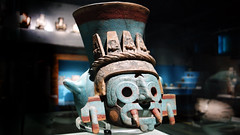
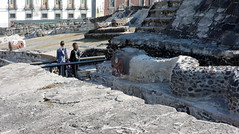
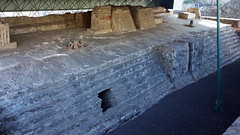
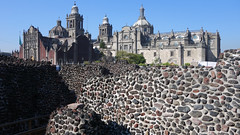

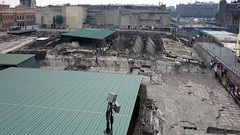


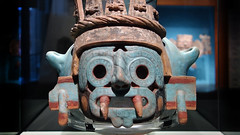
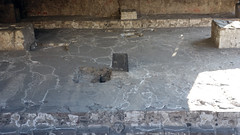
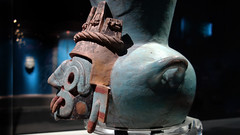
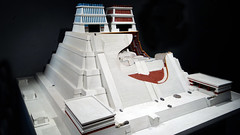
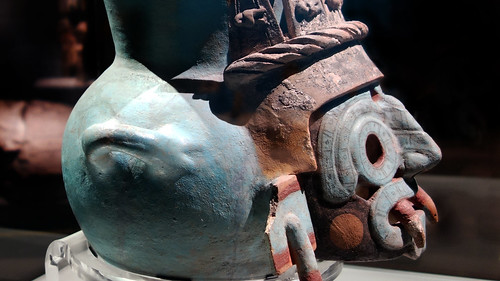
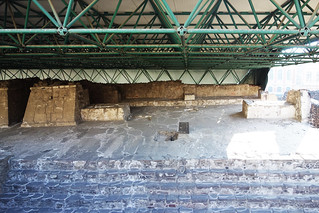
Codex Borgia
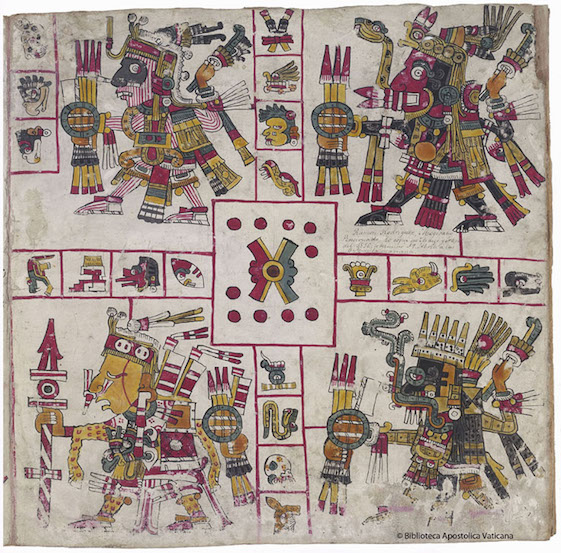
Mesoamericans made screenfold manuscripts of great artistic beauty. One of them is the Codex Borgia, an Aztec manuscript made during the late Post-Classic period, which stretched from about 1250 until about 1521. It has been studied for centuries, and scholars continue to study this complex manuscript in order to better understand its original meaning and use.
While manuscripts were both ubiquitous and esteemed in Mesoamerica, only twelve survived the destruction related to the conquest of the Aztecs by Spain, when most were burned or otherwise destroyed. Each of the surviving manuscripts bears the name of its European owner or the institution where it was or is now kept. For example, the Codex Borgia is named after its former owner, Cardinal Stefano Borgia, an avid collector of coins and manuscripts.
Based on geographic origin and style, scholars classify the 12 pre-conquest manuscripts into three groups:
Borgia
Codex Borgia, Codex Cospi, Codex Fejérváry Mayer, Codex Laud, Codex Vaticanus BMixtec
Codex Colombino-Becker, Codex Bodley, Codex Vindobonensis Mexicanus 1, Codex Zouche-NuttallMaya
Dresden Codex, Madrid Codex, Paris Codex
Making screenfold manuscripts
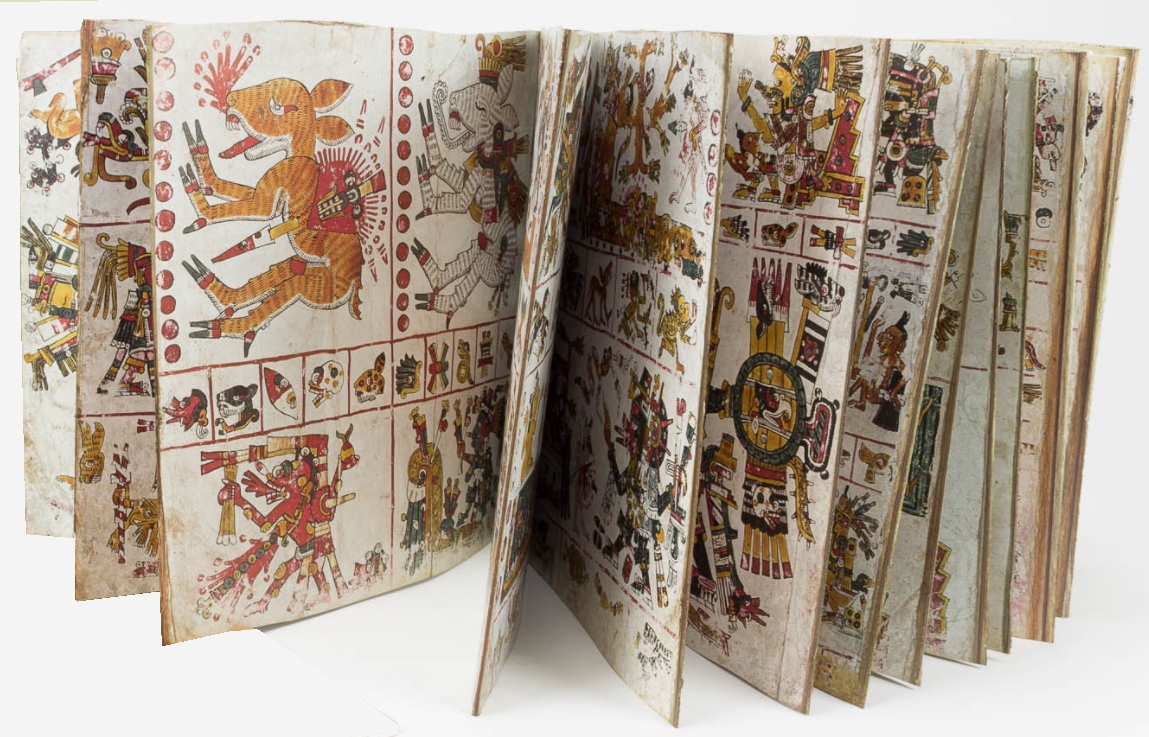
Manufacturing screenfolds involved gluing long strips of leather or paper. These measured different widths, but were of approximately the same height to form an even longer strip that was folded back and forth, accordion-like, to make “pages.” Scholars call the screenfold’s front “obverse” and its back “reverse.” Two pages, a large section, or even an entire side—obverse or reverse—can be viewed simultaneously. The screenfold is a Mesoamerican construction, strikingly different from European manuscripts whose pages are bound on the left side so the reader sees two pages at a time. Artists covered the screenfold’s obverse and reverse with white gesso to prepare it for painting.
Describing the Codex Borgia
When completely unfolded, the Codex Borgia measures approximately 1,030 centimeters (more than 33 feet) in width. When folded, its nearly square pages, each measuring approximately 26.5 by 27 centimeters, can be individually appreciated. The screenfold consists of 39 double-sided pages or 78 single pages, though only 76 of these are painted. The two outermost pages served as covers to which wooden panels were attached (only the Codex Vaticanus B retains these panels).
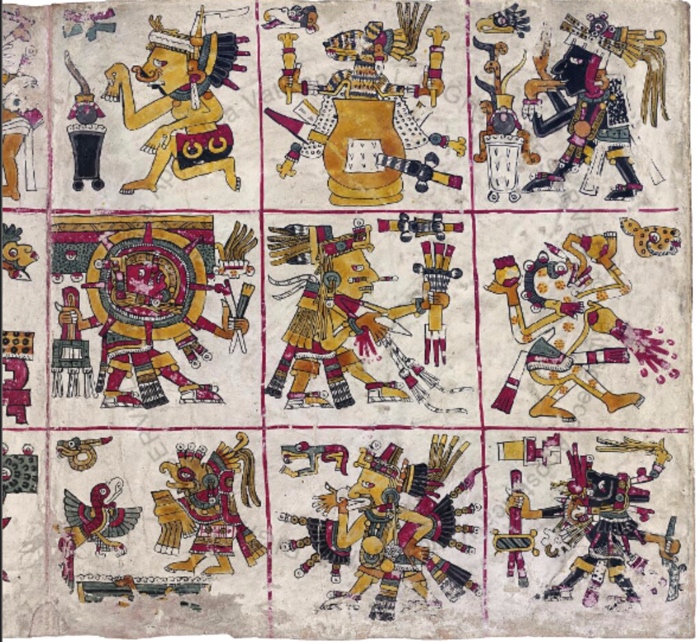
The Codex Borgia features images with precise contour lines and painted with polychrome washes. In its dense imagery, human figures (usually representing gods) predominate, although plants, trees, animals, water, architectural features, celestial bodies, shields, and tools and accoutrements also appear. These are sketched with fine black lines, which in most instances are delicate and precise, such as the outline of the bird’s beak on folio (page) 23. Other outlines are rendered with somewhat thicker strokes, as is visible in the human figure’s legs and the feathers on the bird’s outstretched wings. Sometimes lines are executed as if to evoke shading, such as the narrow blue band at the base of the figure’s headdress. In the bird’s claw, diagonal lines coming from opposite directions simulate texture.
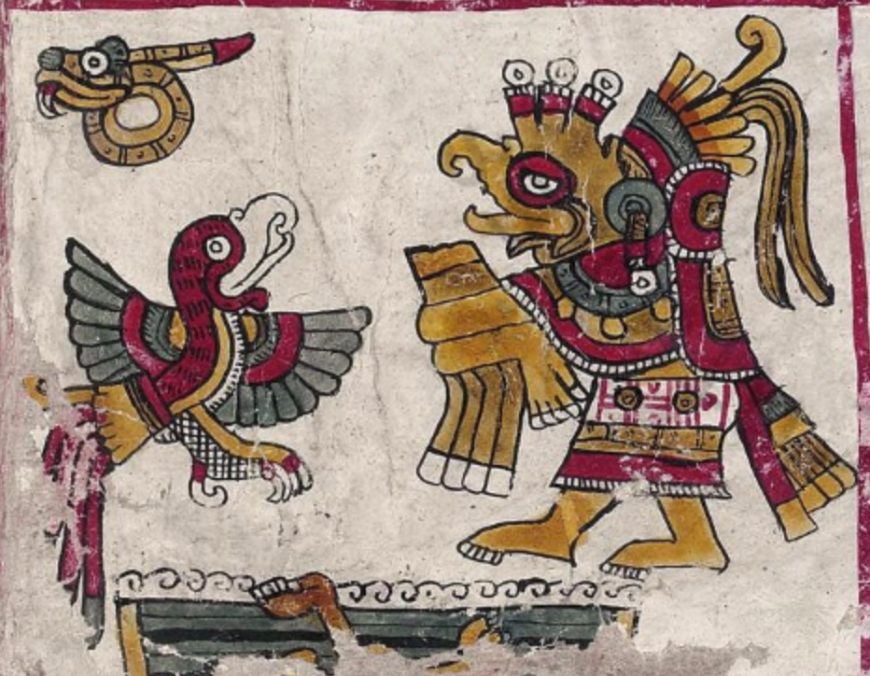
Studying the Codex Borgia
Pre-conquest manuscripts like the Codex Borgia help us to understand indigenous thought before the arrival of Europeans and Africans; however, the writing is extraordinarily difficult to decipher as it consists entirely of images and glyphs (characters or symbols). For example, page 28 features five compartments—one in each corner and one in the center—each with a male hovering above a female.
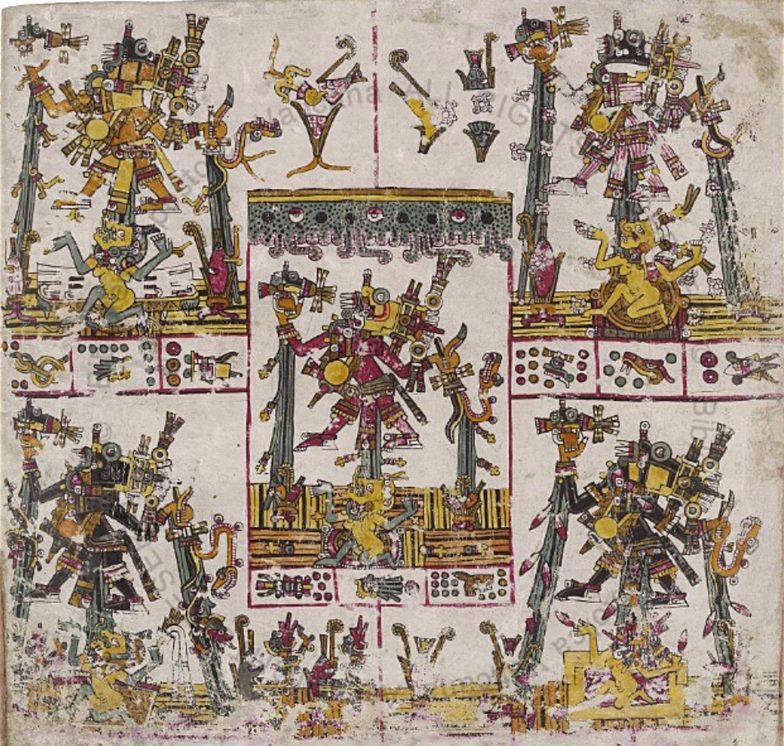

Each female wears an elaborate headdress but is otherwise naked. The male-female couple appears amid maize, an important Mesoamerican plant. Below each compartment are three rectangles each containing a glyph. How do we decipher these images and glyphs? In the early colonial period, indigenous scribes, friars, conquistadors, and other Spanish officials compiled documents—what we call the ethnohistoric record—including chronicles and manuscripts with illustrations by indigenous artists that featured imagery with explanatory glosses in Spanish, Nahuatl (the language of the Mexica, or Aztecs), Latin, and/or Italian. These help us to understand writing in pre-Columbian manuscripts.
For example, page 28 of the Codex Borgia depicts Tlaloc, the god of rain whose iconography includes goggle eyes and fangs. Tlaloc wears costume elements and paraphernalia of additional creator gods, which, starting in the lower right and following a counter clockwise direction, are: Tezcatlipoca (Smoking Mirror), Tlahuizcalpantecuhtli (Lord of Dawn), Xiuhtlecuhtli (Fire Lord), Quetzalcoatl (Wind God), and Xochipilli (Flower Prince). The ethnohistoric sources also help us to identify the female figures and glyphs. The females wear the headdress of Ehecatl-Quetzalcoatl, the wind god (lower right), Xochiquetzal, the Flower Quetzal (upper right), and Chalchitlucue, the water goddess (the other compartments). The glyphs are day signs recording dates. In each compartment two glyphs represent days and one represents a year (page 28 records five consecutive years)
It is generally believed that the glyphs record the movements of the planet Venus and other celestial bodies, which would link the iconography of page 28 to astronomy and rainfall patterns. Because some of the glyphs are severely worn, there is some disagreement about exactly what they represent. Overall, the page’s iconography relates to maize, creating what some would call an “agricultural almanac.”
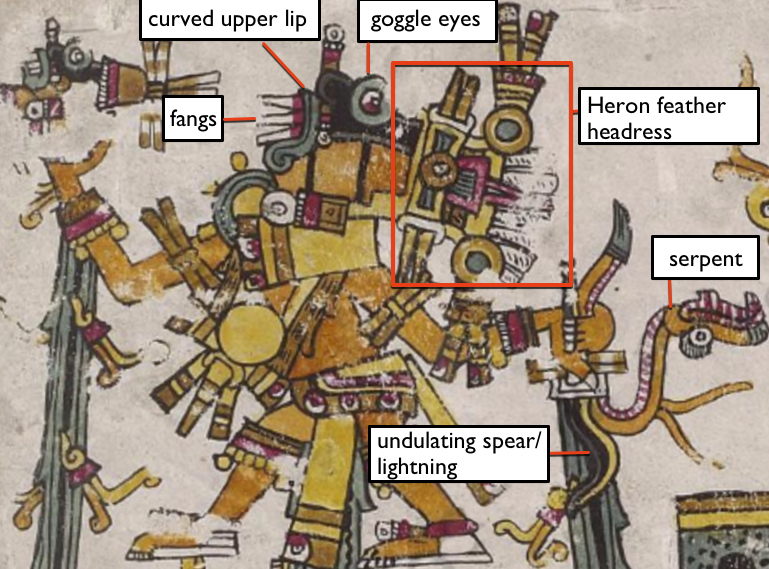
The Codex Borgia’s scholarship is extensive and includes discussions of its materials, construction, style, origin, and interpretation (of specific figures, pages, or sections). In the 1790s, the Jesuit José Lino Fábrega wrote a pioneering commentary arguing that the manuscript relays messages about divination (predicting the future). Eduard Seler’s 1904 page-by-page iconographic analysis of the Codex Borgia, which continues to be an essential tool in the study of Mesoamerican manuscripts, contends that the Codex Borgia conveys messages about both divination and astronomy. Subsequent scholars have shown that the Codex Borgia also records historical, ritual, mythological, and most recently, botanical information. For example, I have argued with iconographic, ethnographic, and scientific evidence that page 28 represents pollination. Because so few original codices survive, the continued study of the Codex Borgia is essential for our understanding of the pre-conquest cultures of the Americas.
Additional resources:
This manuscript at the Vatican library
Ferdinand Anders, Maarten Jansen, and Luis Reyes García, Los templos del cielo y de la oscuridad, oráculos y liturgia: Libro explicativo del llamado Códice Borgia (Graz, Austria: Akademische Druck- und Verlagsanstalt; Madrid: Sociedad Estatal Quinto Centenario; Mexico City: Fondo de Cultura Económica, 1993) (in Spanish).
Juan José Batalla Rosado, Codex Borgia. El Códice Borgia: Una guía para un viaje alucinante por el inframundo (Madrid, España: Biblioteca Apostólica Vaticana, Testimonio Compañía Editorial, 2008). (Written in Spanish, but the accompanying facsimile is stunning; UCLA Special Collections has a copy)
Elizabeth Hill Boone, Cycles of Time and Meaning in the Mexican Books of Fate (Austin, TX: University of Texas Press, 2007).
Gisele Díaz and Alan Rodgers, The Codex Borgia: A Full-Color Restoration of the Ancient Mexican Manuscript (New York: Dover, 1993).
Helen Burgos Ellis, “Maize, Quetzalcoatl, and Grass Imagery: Science in the Central Mexican Codex Borgia” (PhD diss., University of California, Los Angeles, 2015).
Eduard Seler, Comentarios al Códice Borgia, translated by Mariana Frenk. 3 vols. (Mexico City: Fondo de Cultura Económica, 1963 [1904–9]) (in Spanish).
Tlaloc vessel
by DR. BETH HARRIS and DR. LAUREN KILROY-EWBANK
Video \(\PageIndex{16}\): Tlaloc vessel, c. 1440-70, found Templo Mayor, Tenochtitlan, ceramic (Museo del Templo Mayor, Mexico City)
SmartHistory images for teaching and learning:

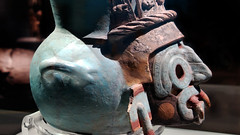




Additional resources:
Tenochtitlan: Templo Mayor on The Metropolitan Museum of Art’s Heilbrunn Timeline of Art History
The Aztecs and the making of colonial Mexico (from the Newberry Library)
Serpent mask of Quetzalcoatl or Tlaloc
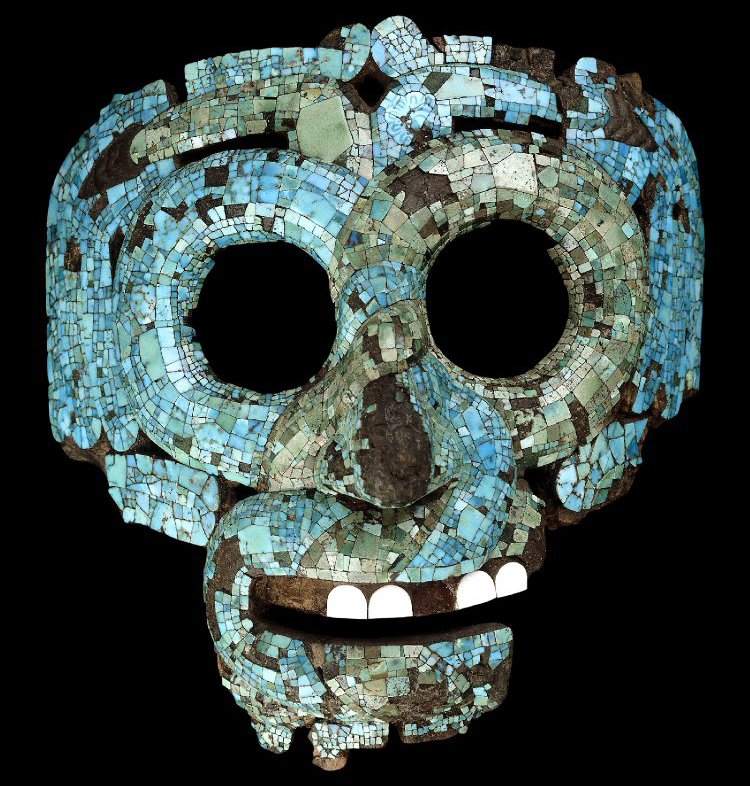
Intertwined looped serpents
This mask is believed to represent Quetzalcoatl or the Rain God Tlaloc; both are associated with serpents. The mask is formed of two intertwined and looped serpents worked in contrasting colors of turquoise mosaic; one in green and one in blue that twist across the face and around the eyes, blending over the nose. Turquoise mosaic feathers hang on both sides of the eye sockets. The mask is made of “cedro” wood (Cedrela odorata) with pine resin adhesive. The teeth are made of conch (Strombus) shell and the resin adhesive in the mouth is coloured red with hematite. The rattles of the serpent tails were originally gilded. They are molded from a mixture of beeswax and pine resin; the same resin mixture coats the interior surface of the mask.
The Spanish friar Bernardino de Sahagún, writing in the sixteenth century, describes a mask like this one. It was a gift of the Aztec emperor Motecuhzoma II to the Spanish captain Hernán Cortés (1485-1547). The Aztec ruler thought that Cortés was the god Quetzalcoatl (Feathered Serpent) returning from the East. This mask was part of the adornments associated with this god. According to Sahagún’s description it was worn with a crown of beautiful long greenish-blue iridescent feathers, probably those of the quetzal (a bird that lives in the tropical rain forest).

Quetzalcoatl?
Though the Rain God Tlaloc was also sometimes represented with serpents twisting around his eyes, the feathers are more consistent with the image of Quetzalcoatl. The earliest image of Quetzalcoatl as the Feathered Serpent appears at Teotihuacan in Central Mexico, on the façade of the temple that now bears his name.
Tlaloc?
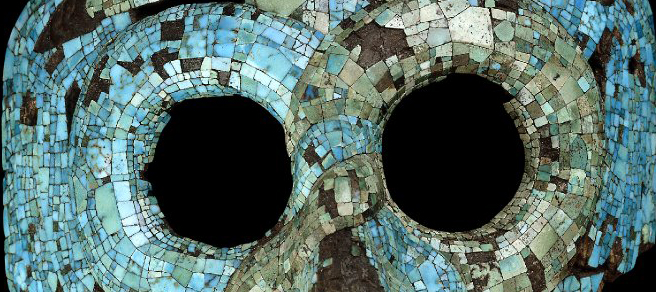
The goggled-eyed effect created by the twining serpents is typical of Tlaloc. The mask has also been associated with the feather serpent, Quetzalcoatl, mainly because of the plumes that hang down from the tails of the two serpents. Two serpents of blue and green turquoise mosaic entwine to form this stylized mask. Their interwoven bodies create the prominent twisted nose and goggle eyes associated with Tlaloc, the god of rain. The eyebrows double as the two rattles from the serpents’ tails.
Snakes copulate by intertwining, sometimes in a vertical position. In Mesoamerica, this act of procreation may have been observed and adapted, both visually and metaphorically, to symbolize the fertilizing rains sent by Tlaloc. The striking green and blue colors of the mosaic evoke the waters and vegetation covering the earth’s surface. On the mask’s forehead an engraved mosaic tile in the shape of a bivalve shell may symbolize water, while the large green mosaic tile on the opposite snake perhaps represents vegetation, both aspects associated with Tlaloc. Mosaic representations of feathers flanking the face may have mimicked part of a larger headdress that once complemented the mask.
Open cavities in the eyes and suspension holes indicate that this mask may once have been worn. The priest who served Tlaloc in the Templo Mayor at Tenochtitlan was known as Quetzalcoatl Tlaloc Tlamacazqui, and may have worn a mask like this as part of his ritual attire. Another example of a Tlaloc wooden mask, painted in blue, has recently been excavated from the Templo Mayor. It bears similar perforations and may have been worn by a deity impersonator.
Suggested readings:
C. R. Cartwright and N. D. Meeks “Aztec conch shell working: high- tech design,” British Museum Technical Research Bulletin 1, (2007), 35-42.
C. McEwan, Ancient Mexico in the British Museum (London, The British Museum Press, 1994).
C. McEwan, A. Middleton, C.R. Cartwright, R. Stacey, Turquoise mosaics from Mexico (London, The British Museum Press, 2006).
Pasztory, E., Aztec Art, New York. 1983.
Vila Llonch, E., “Cat.66: Tlaloc Mosaic Mask,” Colin McEwan and Leonardo Lopez Lujan (eds.), Moctezuma, Aztec Ruler, London: British Museum Press, 2009.
© Trustees of the British Museum
The Sun Stone (or The Calendar Stone) (Aztec)
by DR. LAUREN KILROY-EWBANK and DR. BETH HARRIS
Video \(\PageIndex{17}\): The Sun Stone (or The Calendar Stone), Aztec,reign of Moctezuma II (1502-20), discovered in 1790 at the southeastern edge of the Plaza Mayor (Zocalo) in Mexico City, stone (unfinished), 358 cm diameter x 98 cm depth (Museo Nacional de Antropología)
SmartHistory images for teaching and learning:

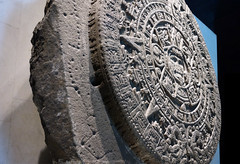

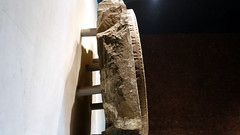
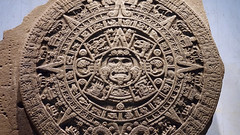
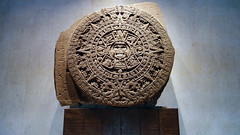
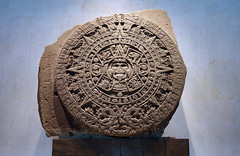
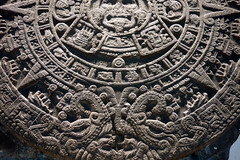
Coyolxauhqui Monolith
by DR. BETH HARRIS and DR. LAUREN KILROY-EWBANK
Video \(\PageIndex{18}\): Coyolxauhqui Monolith, c. 1500, volcanic stone, Aztec, found at Templo Mayor, Tenochtitlan, excavated 1978 (Museo del Templo Mayor, Mexico City)
SmartHistory images for teaching and learning:
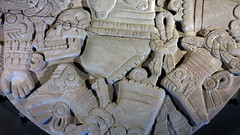
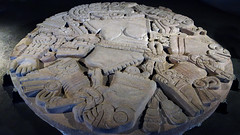
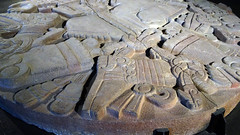
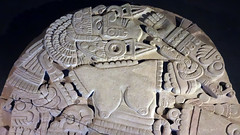
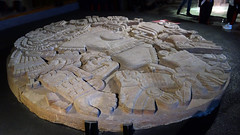
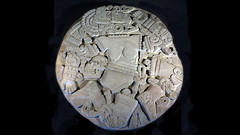
Monolith of Tlaltecuhtli (Earth Lord)
by DR. LAUREN KILROY-EWBANK and DR. STEVEN ZUCKER
Video \(\PageIndex{19}\): Monolith of Tlaltecuhtli (Earth Lord), 1502, Mexica (Aztec), 4.19 x 3.62 m (Museo del Templo Mayor, Mexico City)
Additional resources:
Monolith of Tlaltecuhlti on Fordham University’s Tenochtitlan website
Another Tlaltecuhtli monolith at The Metropolitan Museum of Art
Information on the Tlaltecuhtli excavations from The Great Temple Project (pdf)
Report on the installation of the Monolith of Tlaltecuhtli at the Museo Templo Mayor
Double-headed serpent
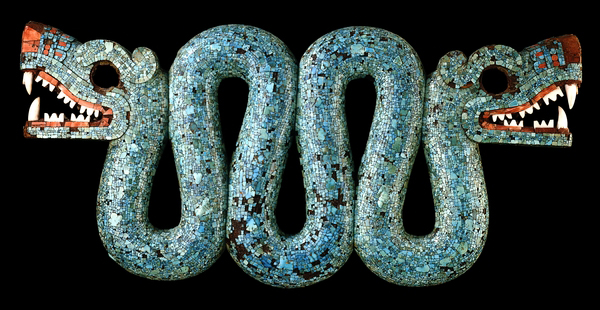
An icon of Mexica (Aztec) art, this striking object was probably worn on ceremonial occasions as a pectoral (an ornament worn on the chest). It is carved in wood (Cedrela odorata) and covered with turquoise mosaic. The wood is hollowed at the back.
Serpent imagery
Serpent imagery occurs throughout the religious iconography of Mesoamerica. The serpent played a very important role in Aztec religion. The word for serpent in Nahuatl, the language spoken by the Aztecs, is coatl and is associated with several gods such as Quetzalcoatl (Feathered Serpent), Xiuhcoatl (Fire Serpent), Mixcoatl (Cloud Serpent) or Coatlicue (She of the Serpent Skirt), the mother of the Aztec god Huitzilopochtli. The habit of snakes to shed their skin each year probably led to them being used to convey ideas concerning renewal and transformation. Likewise the ability of many species to move freely between water, earth and the forest canopy helped underline their symbolic role as intermediaries between the different layers of the cosmos (underworld, earth and sky).
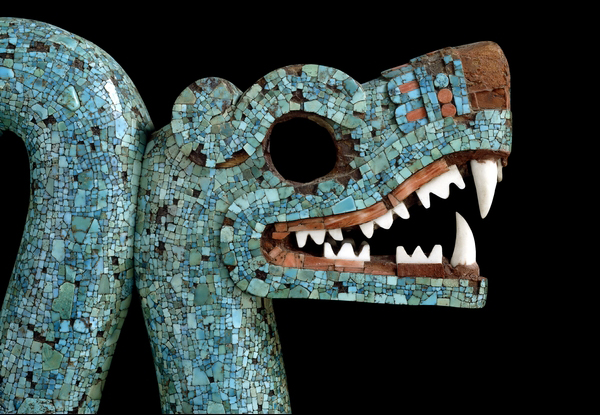
The word coatl is also part of many place names, such as Coatepec (“the hill of the serpents”). Coatepec is the birthplace of the god Huitzilopochtli, the principal Aztec god, and thus one of the most important places in Aztec mythology.
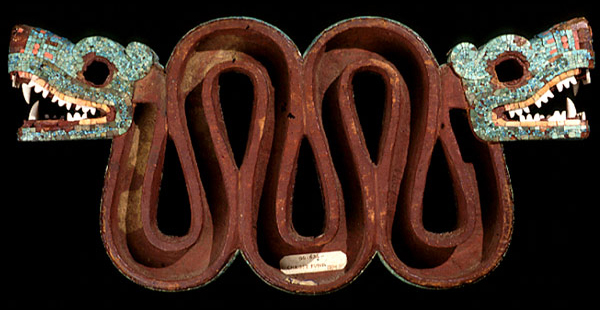
Serpents were also used as architectural elements, for example, a wall of serpents (coatepantli) was often used to mark out sacred spaces within a ceremonial area. At the Aztec capital, Tenochtitlan, such a wall surrounded part of the Great Temple, which was the ritual focus for the entire city.
Materials
Spondylus (thorny oyster) shell was used for the bright red details around the nose and mouth of both of this object’s serpent heads. Strombus (conch) shell was used for the white teeth. Within the gaping mouths the resin adhesive was colored bright red with hematite. Beeswax adheres to the edges of the empty eye sockets which were probably originally inlaid, perhaps with iron pyrites.
The reverse of the body is undecorated, although the surface may have originally been gilded, but the heads are worked in mosaic on both sides. Resins from pine and Bursera (copal) were used as adhesives for the mosaic.
Suggested readings:
C. R. Cartwright and N. D. Meeks, “Aztec conch shell working: high- tech design,” British Museum Technical Research Bulletin 1, (2007), 35-42.
C. McEwan, A. Middleton, C.R. Cartwright, R. Stacey, Turquoise mosaics from Mexico (London, The British Museum Press, 2006).
C. McEwan, Ancient Mexico in the British Museum (London, The British Museum Press, 1994).
R. J. Stacey, C. R. Cartwright and C. McEwan “Chemical Characterization of Ancient Mesoamerican ‘Copal’ Resins: Preliminary Results.” Archaeometry 48, (2006), 323-340.
© Trustees of the British Museum
Eagle Warrior (Mexica)
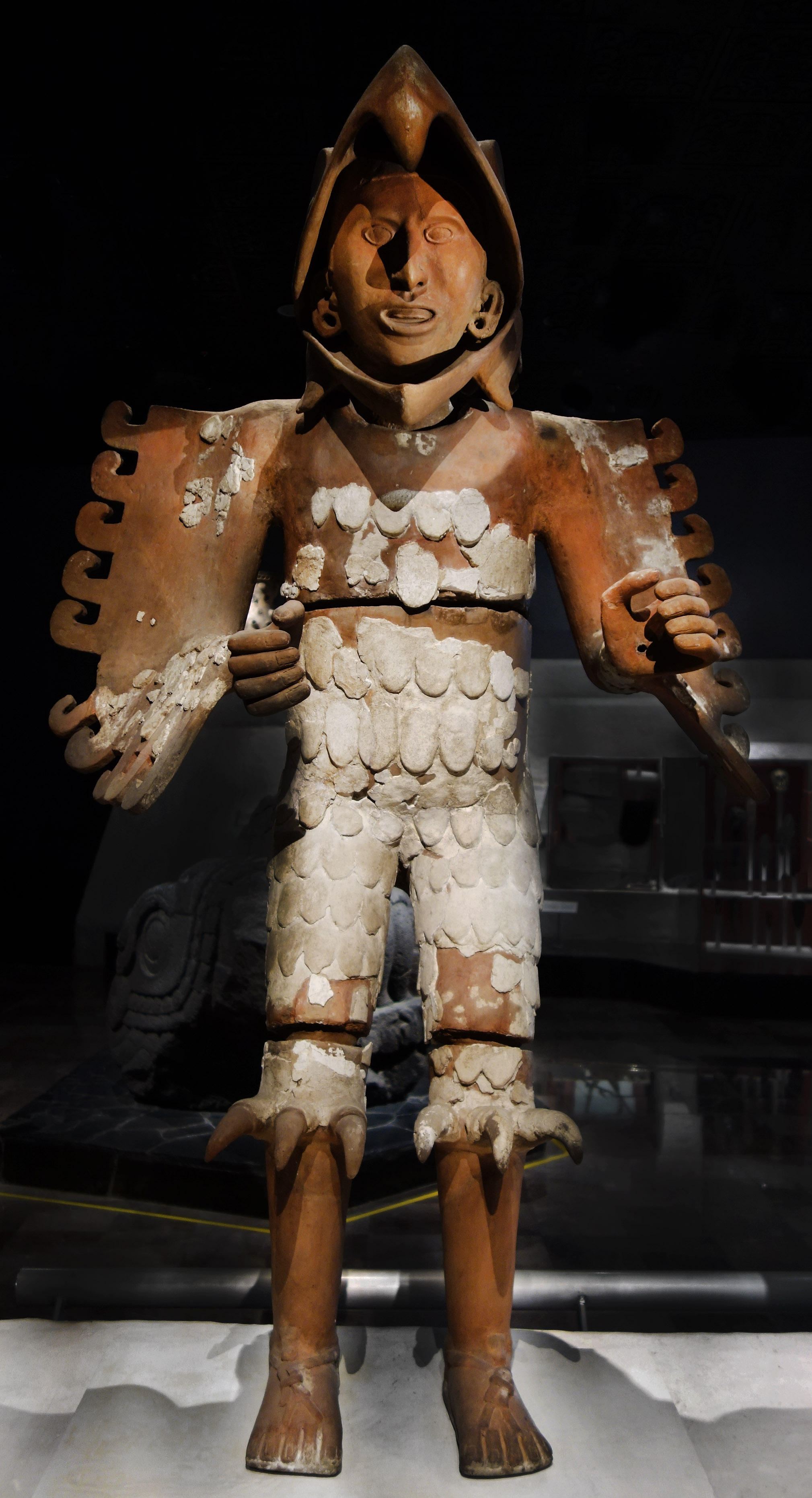
Eagle Warrior is a life-sized ceramic sculpture made by Mexica (sometimes called Aztec) artists that shows a warrior dressed in an eagle costume. Made of terracotta, a type of earthenware known for its reddish color, the life-sized Eagle Warrior was originally painted and adorned with feathers and weapons. His outstretched wings and arms suggest a gesture of flight. This sculpture was discovered during excavations at the main Mexica temple, called the Templo Mayor. This temple was located in the ceremonial center of Tenochtitlan, the capital city of the Mexica empire. The Templo Mayor consisted of a twin-towered stepped pyramid dedicated to Tlaloc, the god of Rain, and Huitzilopochtli, the patron god of the Mexica, usually associated with war and fire.
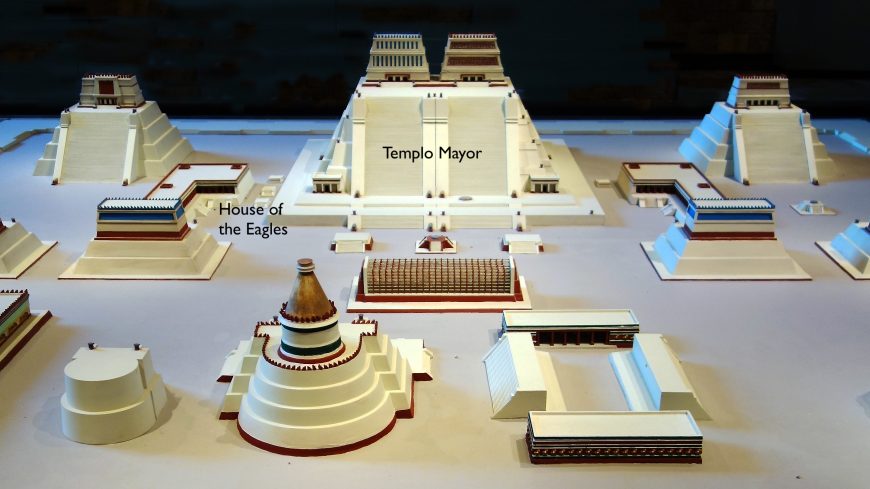
The sculpture was recovered at the House of the Eagles, the meeting place of eagle and jaguar warriors, two of the most prestigious of the Mexica military classes. The House of the Eagles was just beside to the Templo Mayor, and highlighted the association of the Mexica’s most important temple with warfare. The Templo Mayor itself symbolized warfare in its combination of Tlaloc and Huitzilopochtli.
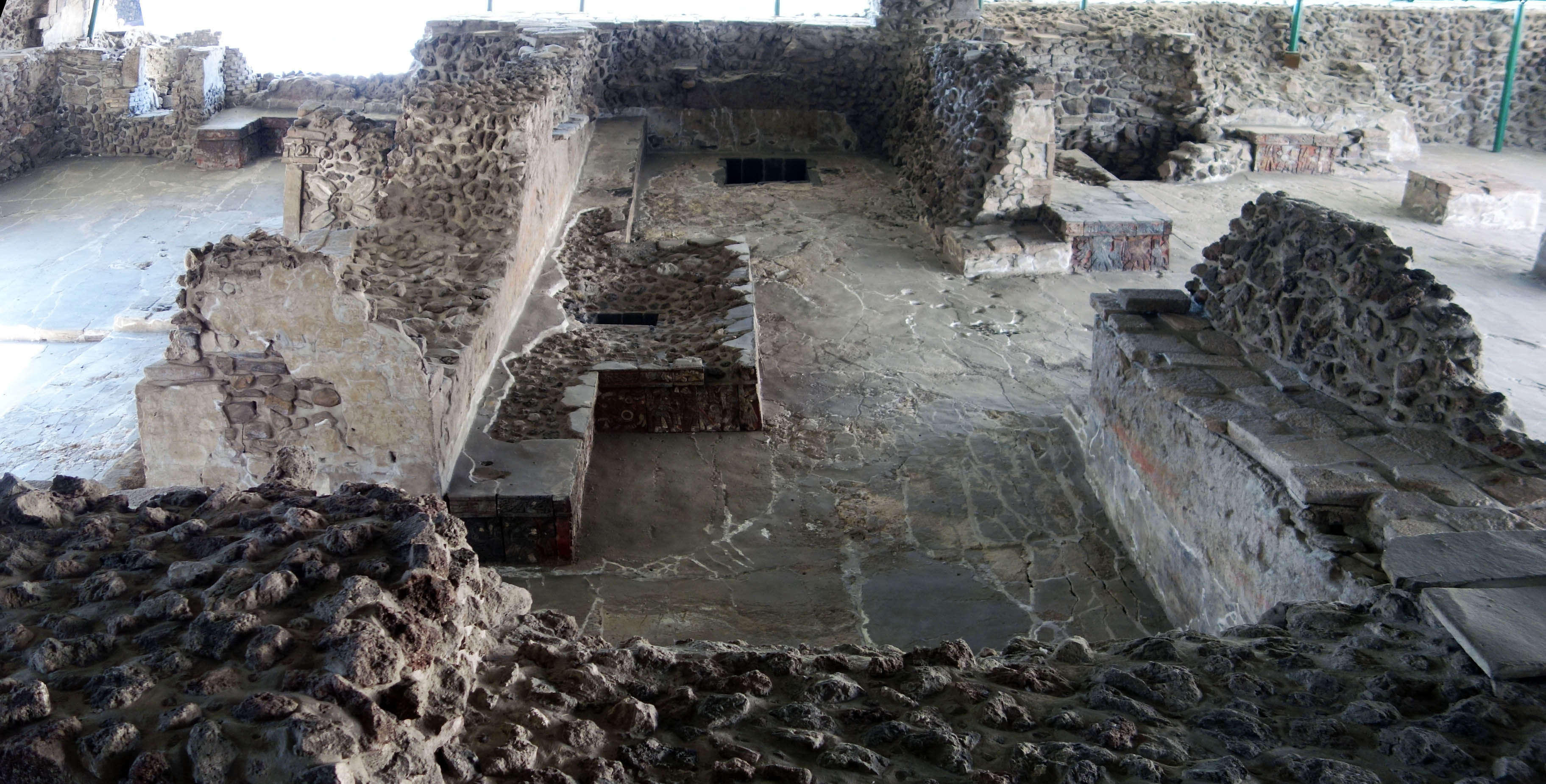
For the Mexica, the symbol for war was water and fire, called the atl-tlachinolli in Nahuatl, the language of the Mexica. A meeting space for eagle and jaguar warriors next to the Templo Mayor advertised the important role that the military classes played in Mexica culture more generally and in maintaining Mexica power over conquered peoples.
Warrior ranks
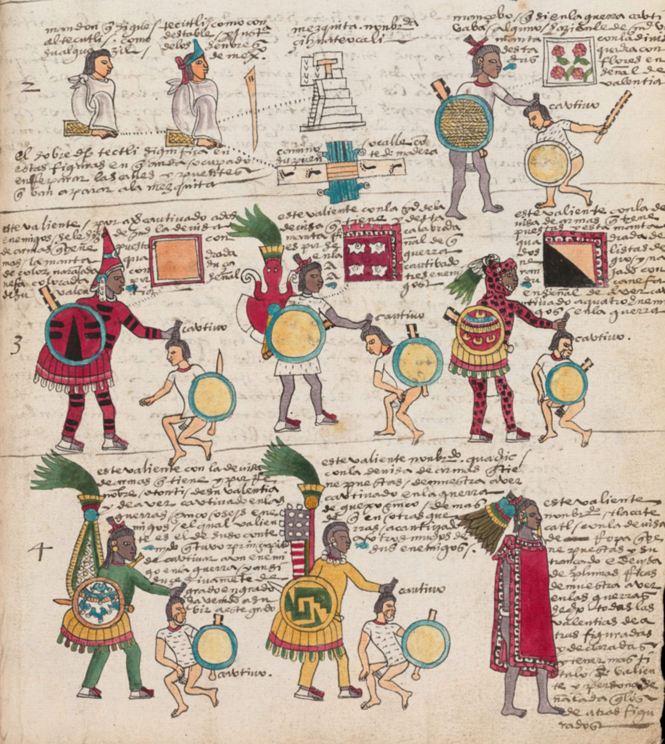
While the Mexica had no standing army, they did have elite warriors with extensive military and martial arts training who fought in “flowery wars,” a ritualistic form of warfare that consisted of capturing victims and sacrificing them to the gods.
Our understanding of the role of the eagle warriors is largely based on colonial sources (or written sources made after the Spanish conquest in 1521), including the Codex Mendoza, (c. 1541–42). This book documents pre-invasion Mexica culture but was commissioned by Antonio de Mendoza, the first viceroy of New Spain. It should be kept in mind though that the Codex Mendoza, while a critical historical document, is not politically nor culturally neutral. According to this source the goal of the eagle warrior was to capture the greatest number of captives, who would then be sacrificed to the Mexica gods. Warriors rose in rank according to the number of captives they acquired. This ranking system is documented in the Codex Mendoza, which illustrates the different military ranks and their corresponding war suits, determined by the number of captives.
In the second to last register, for example, the warrior in the red suit is credited for capturing two victims, while the jaguar warrior at the far right captured four. In the last register, the warrior at right is of the highest rank, yet he is dressed in civilian clothes, a reference to his aristocratic ancestry. While all warriors were equipped with shields and obsidian weapons, their war suits identified their military rank and social status.
Symbolism of the war suit
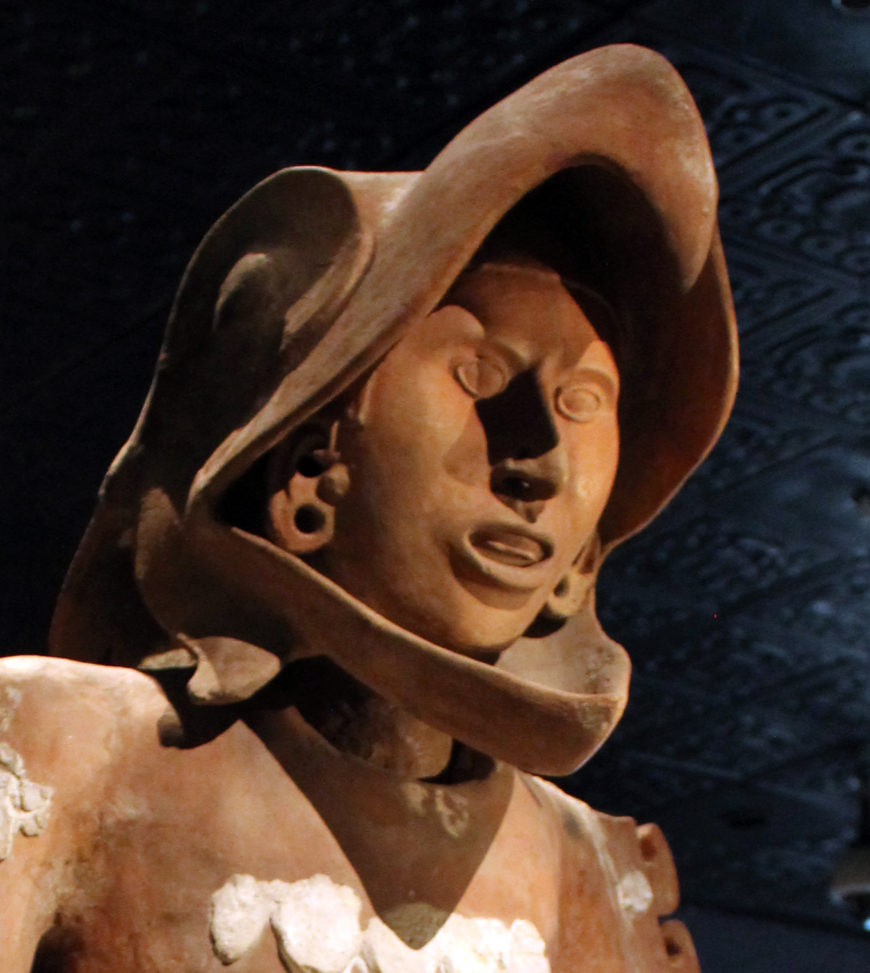

Additionally, and perhaps most importantly, the war suit served a symbolic function, since it was believed that in dressing like an eagle or a jaguar, the warrior adopted the power and skill of their assigned animal, thus ensuring a more successful hunt. The symbolism of the war suit was further emphasized by its materiality, since most warriors, except for the nobility, wore suits made of animal skin. The eagle warrior not only acted like an eagle, but also literally resembled one.
Original appearance
In comparison to the warriors seen in codices, the Eagle Warrior may appear somewhat tame at first. Lacking the colors, patterns, and weapons of the warriors of the Codex Mendoza, the Eagle Warrior does not seem have the menacing appearance that these soldiers may have actually possessed. But we have to remember that the sculpture was originally painted and covered in feathers, and so it would have had a more life-like appearance when placed in the House of the Eagles.
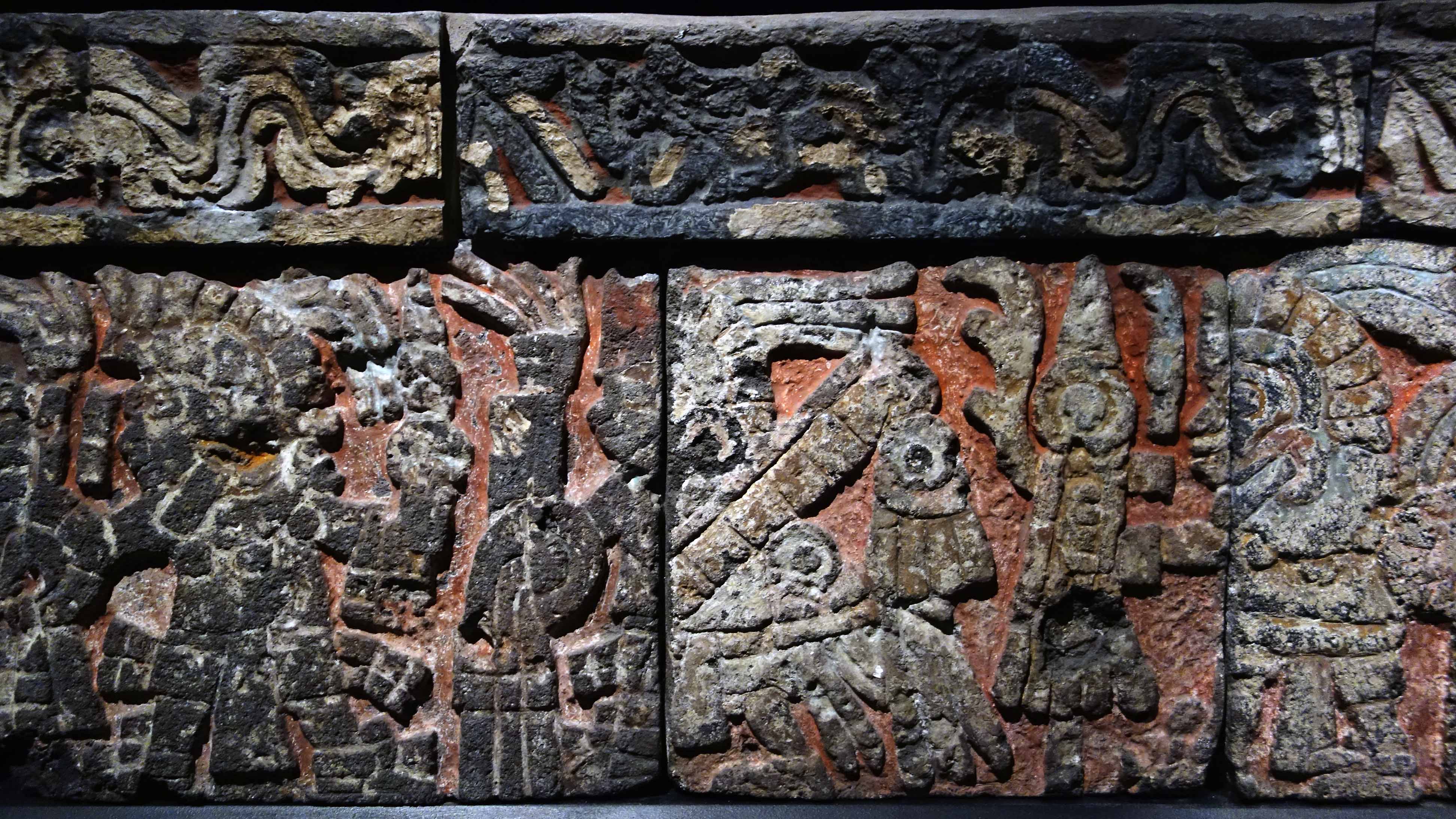
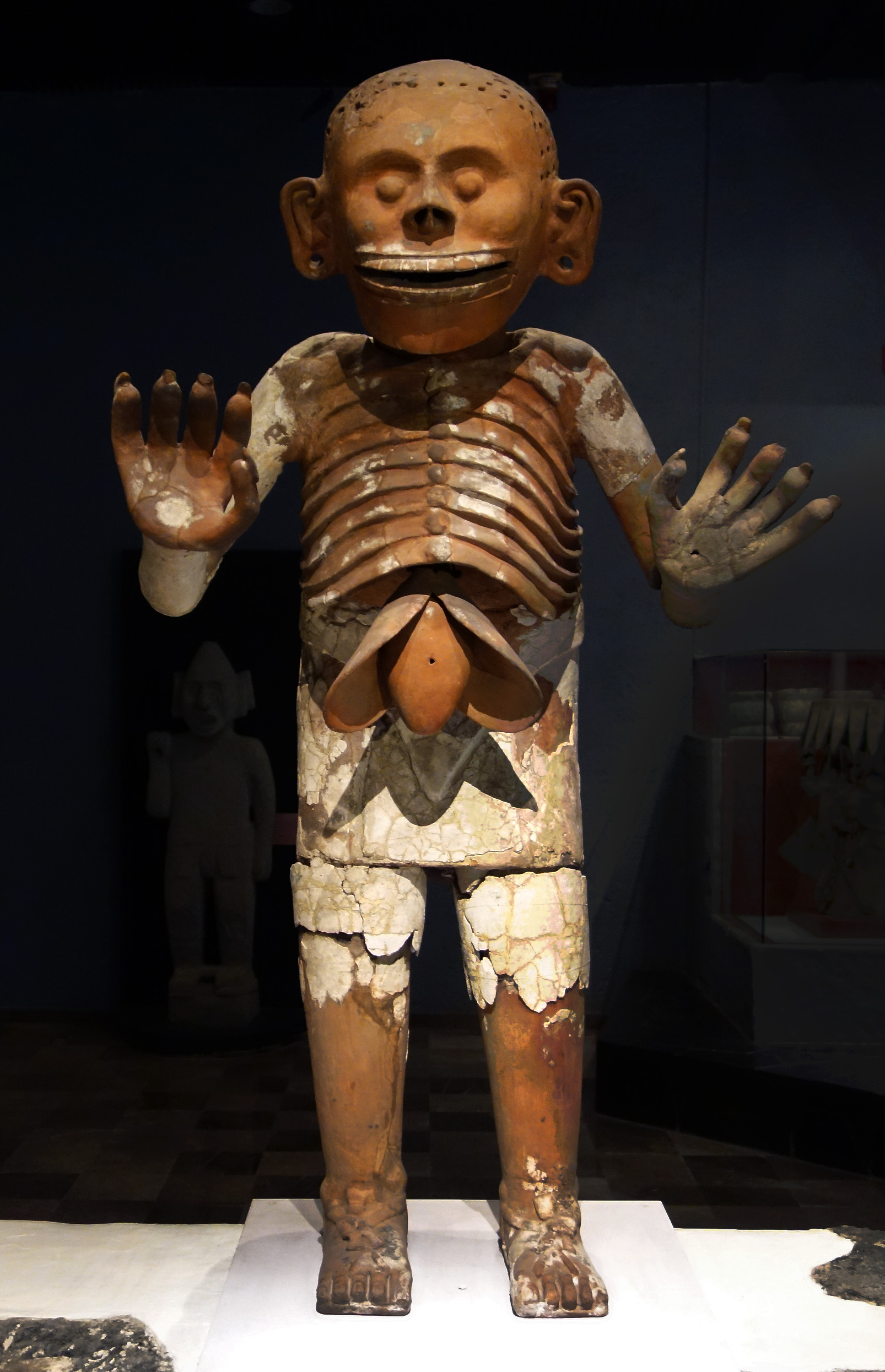
The Eagle Warrior stood near the doorway of the House of the Eagles, likely functioning as a guardian figure. He stood atop a bench that was decorated with relief sculpture showing warriors as they advanced towards a ball (called a zacatapayolli) into which they placed bloodletting implements. Warriors would have pierced parts of their body, such as their tongue or ears, to let blood onto paper, which would then be burned. The blood was offered to the gods as an act of penance because the Mexica believed that the gods demanded blood in return for their creation of the world.
Another life-size terracotta figure stood at a second doorway in the House of the Eagles, but instead of showing an eagle warrior it is the god of the Underworld, Mictlantecuhtli. At almost six feet tall, the skeletal god is as imposing as the Eagle Warrior, if not more so. He leans slightly forward, his clawed hands raised and his mouth slightly open. Originally, hair or paper decorations would have been placed in the holes on top of his head. Like the Eagle Warrior, Mictlantecuhtli displays the same skill in firing terracotta on a large scale.
Though much of the original splendor of the armed Eagle Warrior has been lost, one can only imagine the imposing appearance of this sculpture hovering at the entrance as actual warriors gathered together. Both the sculpture of the Eagle Warrior and Mictlantecuhtli testify to the ways in which sculptures of warriors and gods played an active role in Mexica life.
Mosaic mask of Tezcatlipoca

The skull of the Smoking Mirror
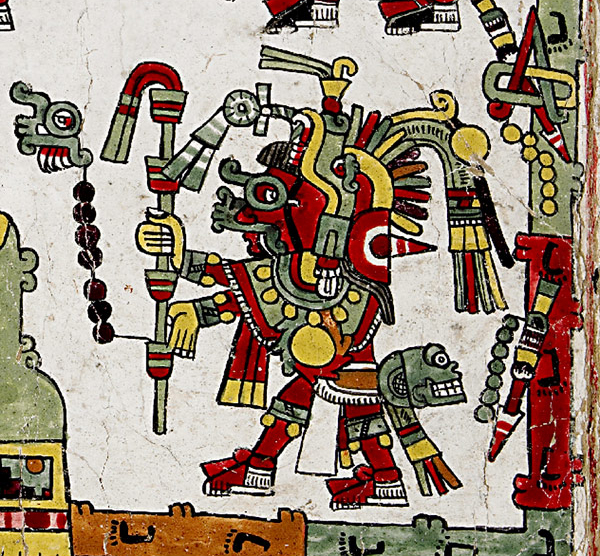
This mosaic is believed to represent the god Tezcatlipoca, or “Smoking Mirror,” one of four powerful creator deities, who were amongst the most important gods in the Mexica* pantheon. Tezcatlipoca is often depicted with obsidian mirrors at the head and is conventionally cast as an adversary to Quetzalcoatl. The name “Smoking Mirror” derives from the Nahuatl (Mexica) word tezapoctli, meaning “shining smoke” and representations of Tezcatlipoca are typically characterised by distinctive black stripes on the face and a smoking mirror generally displayed in his headdress, at his temple or in place of a torn-off foot.
The base for the mosaic is a human skull. The skull is cut away at the back and lined with deer skin on which the movable jaw is hinged. Long deerskin straps would have allowed the skull to be worn as part of priestly regalia. Skull ornaments like this are depicted in the Mixtec Zouche-Nuttal Codex.
The mosaic decoration is worked in alternate bands of bright blue turquoise and black lignite. The eyes are made of two orbs of polished iron pyrite framed by rings made of white conch (Strombus) shell. The nasal cavity is lined with plates of bright red Spondylus (thorny oyster) shell.
Farthest reaches of the Mexica empire
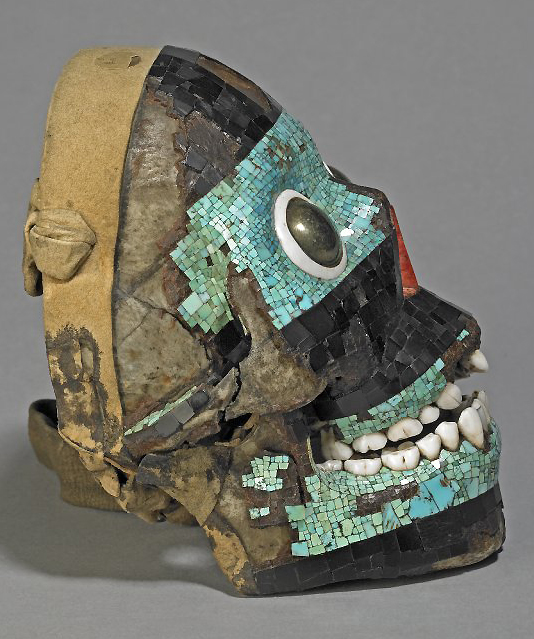
The turquoise, lignite, pyrite and shell were all procured from the farthest reaches of the Mexica empire and beyond. The effort made in assembling this diverse selection of exotic materials emphasises the divine “other-worldly” nature both of the mosaic and whoever wore or displayed it.
Turquoise was sent as tribute to the Aztec capital from several provinces of the empire. Some of those provinces were located in present-day Veracruz, Guerrero and Oaxaca. The turquoise was sent as raw chunks or as cut and polished mosaic tiles decorating a variety of objects, such as masks, shields, staffs, discs, knives and bracelets. We know from a tribute list issued by the emperor Moctezuma II that ten turquoise mosaic masks, made by skilled Mixtec artisans, were sent each year from a province in Oaxaca.
*The people and culture we know as “Aztec” referred to themselves as the Mexica (pronounced “Mé-shee-ka”).
Suggested readings:
C. R. Cartwright and N. D. Meeks, “Aztec conch shell working: high- tech design,” British Museum Technical Research Bulletin 1, (2007), 35-42.
C. McEwan, A. Middleton, C. Cartwright, R. Stacey, Turquoise mosaics from Mexico (London, The British Museum Press, 2006).
C. McEwan, R. J. Stacey and C. R. Cartwright, “The ‘Tezcatlipoca’ skull mosaic in the British Museum collections: new insights and questions of identity,” E. Baquedano (ed.) Tezcatlipoca: Trickster & Supreme Aztec Deity (Colorado, University of Colorado Press, 2014).
C. McEwan, Ancient Mexico in the British Museum (London, The British Museum Press, 1994).
© Trustees of the British Museum
Stone kneeling figure of Chalchiuhtlicue
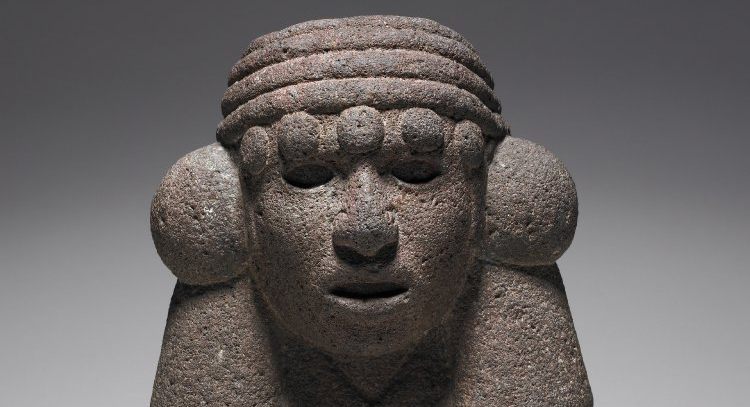
A water goddess
This stone sculpture represents Chalchiuhtlicue, the Mexica water goddess. Chalchiuhtlicue means “she of the jade skirt” in Nahuatl, the language spoken by the Mexica.* She was associated with the spring water, rivers and lakes, and also with birth. According to an Mexica creation myth there were four suns (or worlds) before the present one. Chalchiuhtlicue presided over the fourth one, which was destroyed by floods and its people turned into fishes.
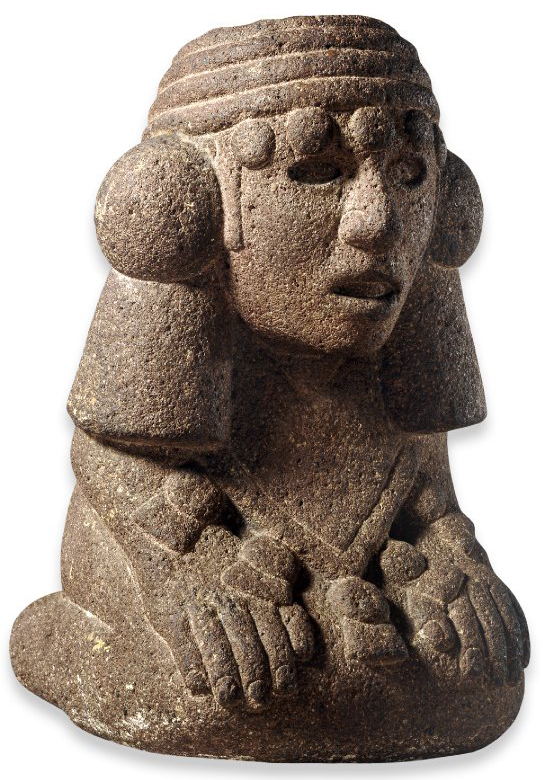
Female figurines, kneeling or standing, are a recurring theme in Mexica sculpture. Most of them have distinctive characteristics that identify them as fertility goddesses. They are always represented as young women and they wear a variety of headdresses. In some cases, like in this example, their hair is arranged in two large tassels on both sides of the head. Other fertility deities, such as the maize goddesses, wear a large rectangular headdress made of rigid bark paper and ornamented with rosettes. Here, Chalchiuhtlicue wears the traditional shawl (quechquemitl), also trimmed with tassels, over a long skirt. Her eyes were probably made of shell, like in many other Mexica sculptures.
This piece was acquired by William Bullock, a famous collector of Mexican antiquities, in 1823 and exhibited at the Egyptian Hall, in Piccadilly.
The image of the goddess Chalchiuhtlicue figures prominently in the codices as a beautiful young woman representing the purity and preciousness of water. She is invariably painted blue, signaling her role in mythology as the wife, mother or sister of Tlaloc, the Rain God. She is associated with spring water used to irrigate the fields and, as the patron saint of fishermen, with lakes and rivers. She also plays an important role in birth ceremonies. Each figure wears a headband adorned with large ear tassels, as well as a tasseledquechquemitl (shoulder cape) over a long skirt.
*The people and culture we know as “Aztec” referred to themselves as the Mexica (pronounced Me-shee-ka).
Suggested Readings:
C. McEwan, Ancient Mexico in the British (London, The British Museum Press, 1994).
M. E. Miller and K. Taube, An illustrated dictionary of the Gods and Symbols of Ancient Mexico and the Maya (London, Thames and Hudson, 1997).
H.B. Nicholson and E. Quiñones Keber, Art of Aztec Mexico (National Gallery of Art, Washington, D.C., 1983).
© Trustees of the British Museum
Aztec feathered headdress
by DR. LAUREN KILROY-EWBANK and DR. BETH HARRIS
Video \(\PageIndex{20}\): Feathered headdress, Aztec, reproduction (National Anthropology Museum, Mexico City). Original: early 16th century, quetzal, cotinga, roseate spoonbill, piaya feathers, wood, fibers, amate paper, cotton, gold, and gilded brass, Aztec, Mexico, (World Museum, Vienna)
Backstory
This headdress is also called the Penacho of Moctezuma II. Moctezuma II’s headdress was first mentioned in a European inventory in 1596, when it was acquired by Austrian Archduke Ferdinand II von Tyrol. It was listed there as “a Moorish hat.” It was likely an object sent from Mesoamerica to Europe by Hernan Cortes, but it is unknown whether it actually belonged to Moctezuma II himself.
In the late nineteenth century, Austria established its first Museum of Natural HIstory, with geologist Ferdinand von Hochstetter as its director. While searching for objects to display in the new museum, von Hochstetter found the headdress in Ambras Castle, Archduke Ferdinand’s former residence in Innsbruck, Austria. Since then, the headdress has been displayed in the ethnology museum in Vienna (now called the Weltmuseum Wien). In 2010, the Weltmuseum embarked on a restoration and research project on the headdress in conjunction with INAH (Instituto Nacional de Antropología e Historia, Mexico’s National Institute of Anthropology and History).
Over the last century and a half, the headdress has become an important touchstone for Mexican national and indigenous identity, and many Mexicans think it should be returned. Representatives and activists from Mexico have continuously made requests for its repatriation, but despite a deal almost struck in 2011, the Austrian authorities have as yet refused to officially allow the loan or return of the headdress to Mexico, claiming that the trip across the Atlantic would be too risky for the fragile object. As art historian Khadija von Zinnenburg Carroll writes,
The replica of the headdress in Mexico City, which is featured in the video above, was created and installed in 1940.
Backstory by Dr. Naraelle Hohensee
Additional resources:
“The Penacho of Moctezuma’s Repatriation Battle,” Pulsamérica, November 3, 2017
“Return of Aztec artifact may be model deal,” IOL, January 19, 2011
“The Fight to Bring Home the Headdress of an Aztec Emperor,” Atlas Obscura, September 26, 2017
SmartHistory images for teaching and learning:

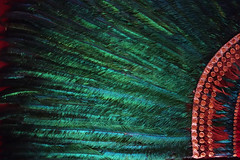

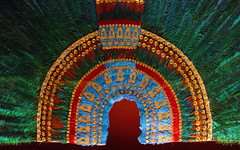
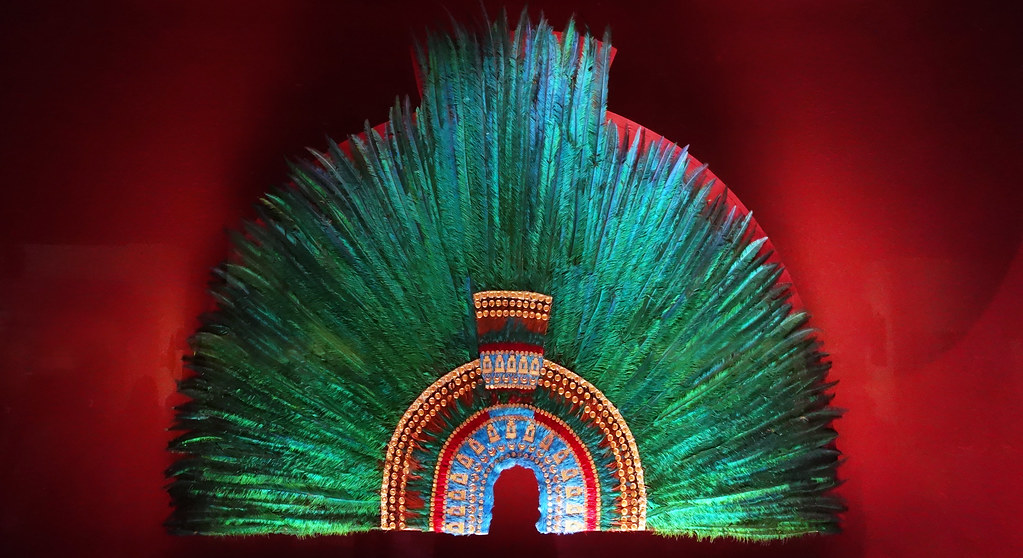
Aztec art and feasts for the dead
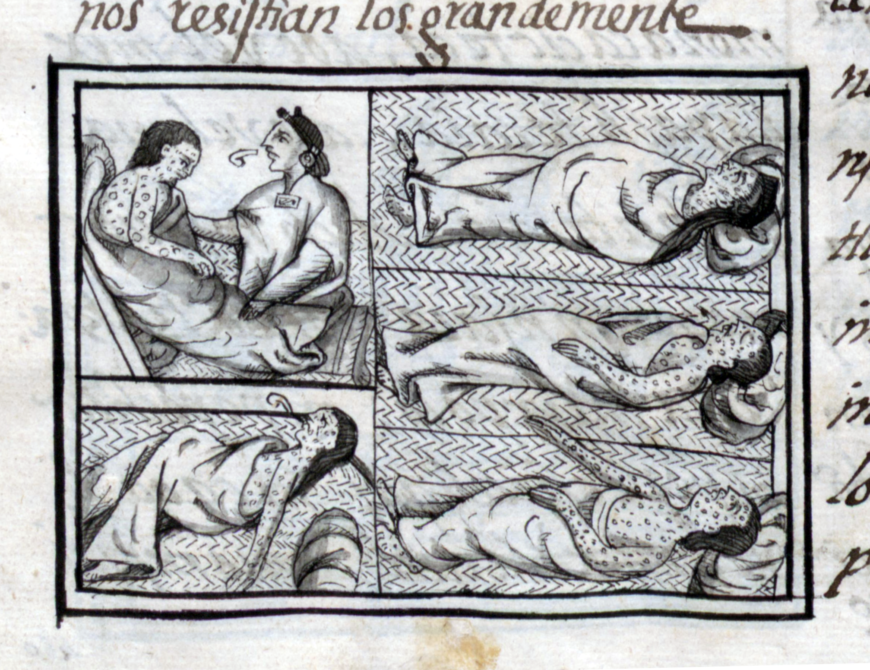
Art and the fall of Tenochtitlan
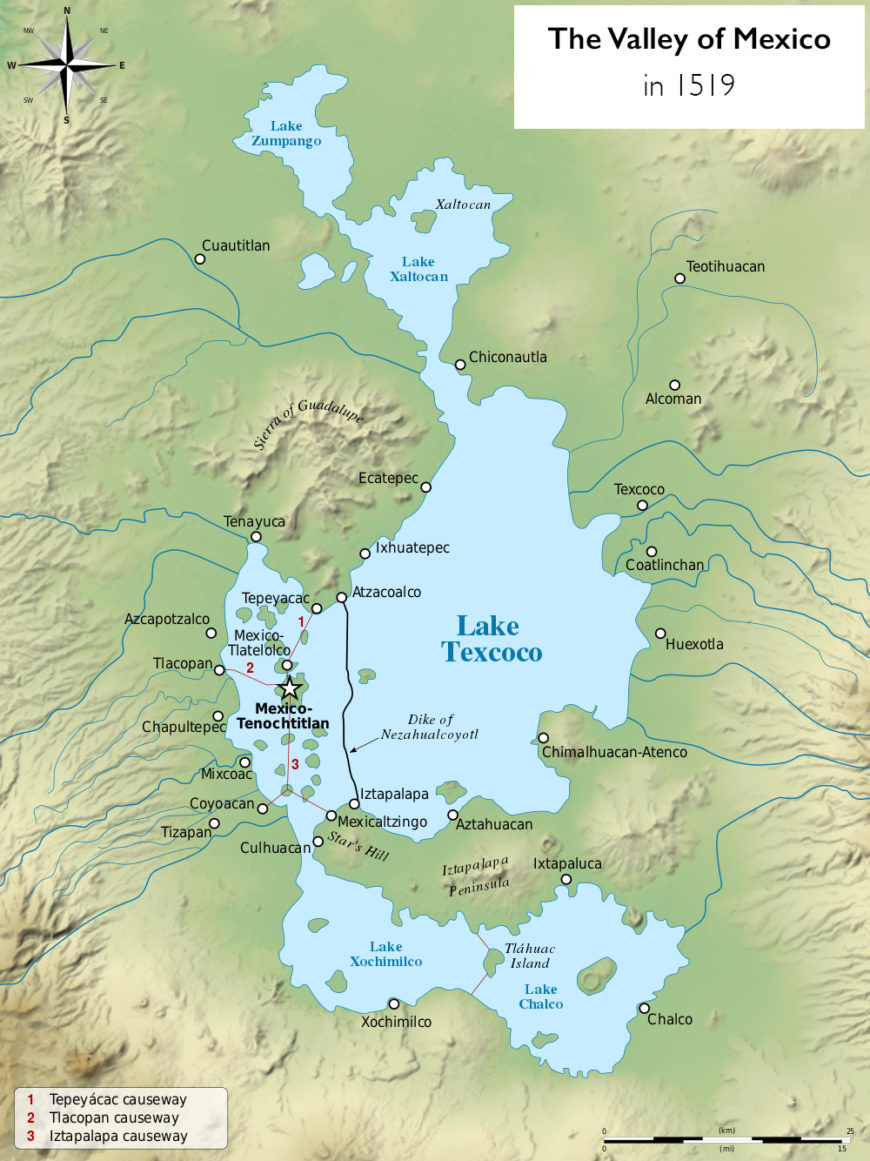
The Mexican-Catholic tradition of Día de Muertos (“Day of the Dead”) occurs on November 1 and 2. Families begin days or weeks in advance to make tasty treats to welcome the holiday—and now in October 2020 they still do, even as a global pandemic turns life upside down. By some horrid irony, 2020 marks the 500th anniversary of the first transatlantic pandemic—the smallpox outbreak of 1520 in the Valley of Mexico—and unbeknownst to many, the ancient roots of Día de Muertos are inextricably tied to that grim anniversary. That fall, the Mexica people (who belonged to the larger Nahua ethnic group and who were the leaders of the “Aztec” Triple Alliance) of the island city of Tenochtitlan in the Valley of Mexico should have been preparing ample amounts of amaranth dough to honor ancient traditions instead of struggling to survive disease.
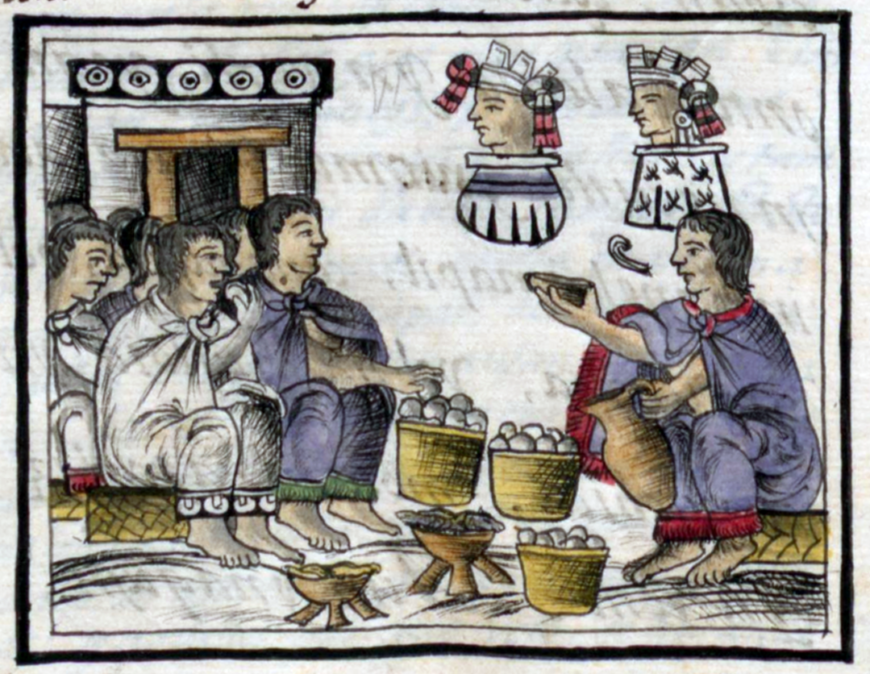
Smallpox attacked Tenochtitlan at an important time in the Mesoamerican calendar. According to the Mexica’s account of the Spanish invasion, recorded in Book 12 of the Florentine Codex (created c. 1575–77 by a Franciscan friar and Indigenous collaborators), smallpox erupted during the sacred month of Tepeilhuitl or “The Festival of the Mountains”—one of the oldest religious festivals associated with the Mexica and their capital at Tenochtitlan. Normally the Mexica observed that holiday, one of their twenty-day months, by remembering their dead relatives through communal feasting, song, and dance.
The sacred festivities date back to to the foundation of the city Tenochtitlan in the 14th century, when, according to colonial-era manuscripts, as the Mexica slogged through marshy lands of the Valley of Mexico in search of their new home, and arrived at a place called Iztacalco. There they performed the amatepetl or “paper-mountain” ceremony in the year 13 Rabbit (likely 1362 C.E.). One Nahuatl (the language of the Nahua) text describes the solemn ceremony as one where “people made many hills of dough and gave them eyes and mouths of seeds.” [1]
During the month of Tepeilhuitl in 1520, however, smallpox raged among the Mexica for sixty days, the disease then spread throughout the countryside. Only months before, the people of Tenochtitlan had cast out the Spaniards (led by Spanish conquistador Hernán Cortés) for committing a massacre during another festival known as Toxcatl. The Mexica had crafted a life-sized dough image of their patron deity Huitzilopochtli, and when they began to dance and sing before it, Spanish onlookers used that act as a rationale to attack the surprised and unprepared worshippers. As the fall set in, the Spaniards returned and were prepared to choke off the city with a months-long siege. By that time, its citizens had borne witness to the horrors of smallpox, many unable to move under the pain of erupting pustules that blanketed their skin. Basic functions in Tepeilhuiltl had been disrupted by the crippling disease as “starvation reigned, and no one took care of others any longer.” [2] Instead of creating edible art and honoring the ancestors, the Mexica faced famine.
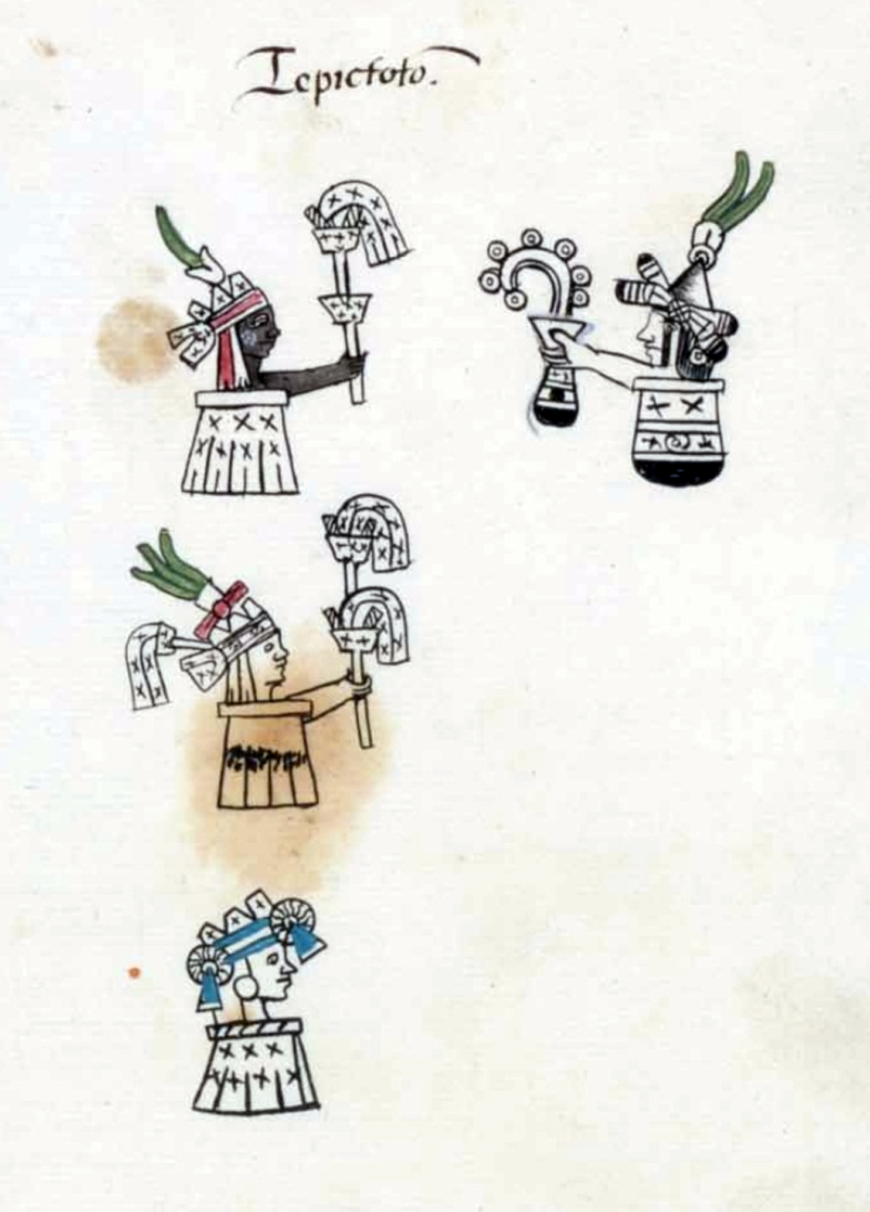
Crafting Edible Mountain-Gods
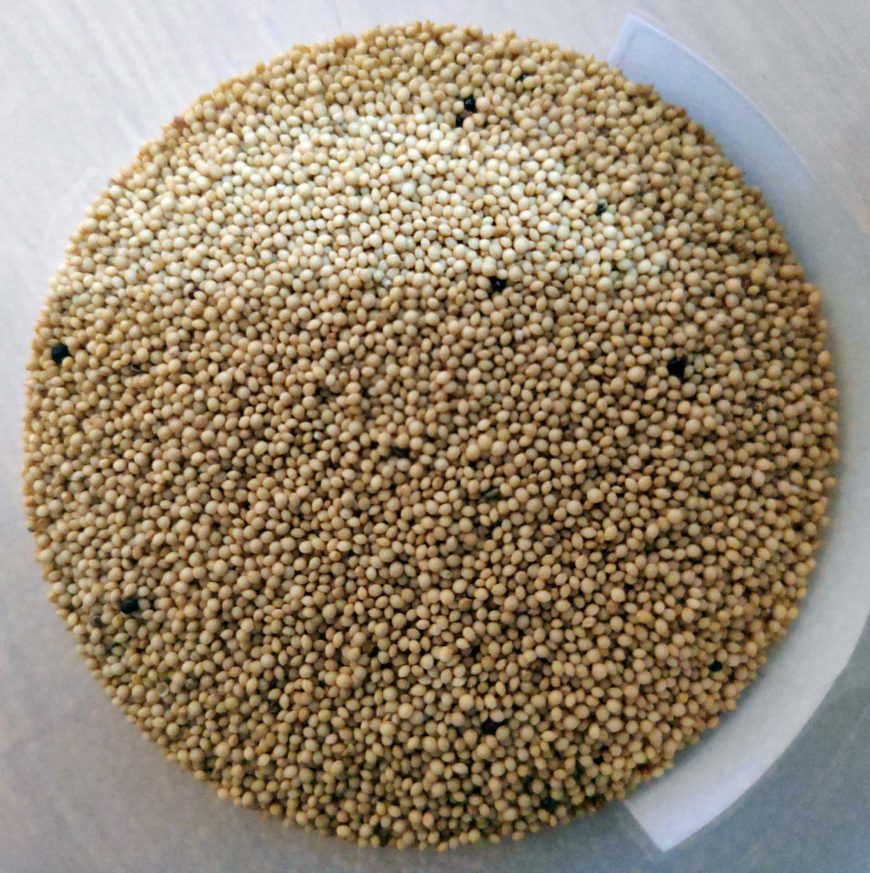
The month of Tepeilhuitl was dedicated to honoring the natural and supernatural environment while also commemorating the recently deceased members of a community. It knitted communities together with its public displays of religious artwork, musical and dance performances, and acts of gifting food and drink to supernatural forces. A central aspect was the act of crafting, displaying, and eating handmade sacred art made of dough.
These works of sacred art were known as tepictoton, or “small molded ones.” They were sacred objects consisting of three basic components: an inner portion containing a collection of amaranth-dough figures that were the likenesses of actual living or dead people; an exterior shell that looked mountain-like and encased the dough figures; and a final layer of paint, appliques, and ornamentation that associated the mountain with a particular deity. Nahuas used the tepictoton as a type of altar or shrine in the process of commemorating their dead.
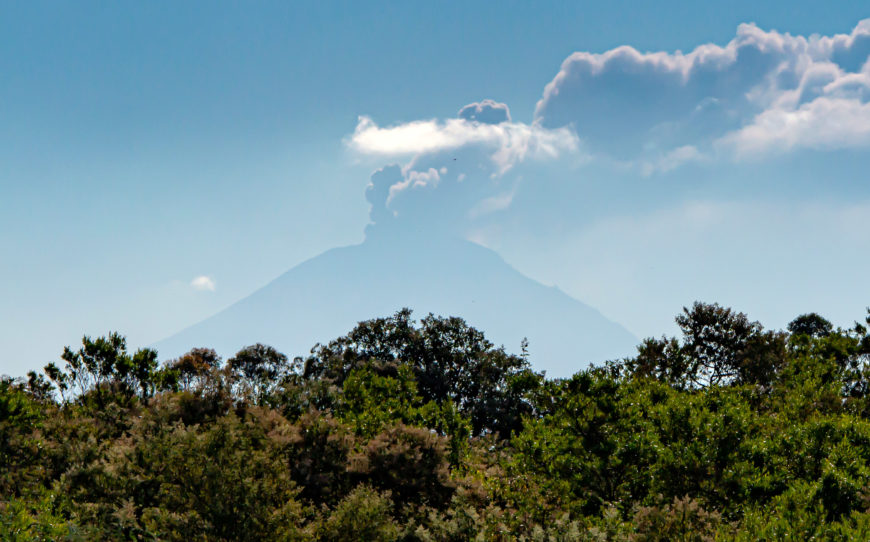
In Nahua cosmology, mountains were concretions around water, and life-sustaining rain clouds formed above them. Famed mountains in the Valley of Mexico included Mount Tlaloc, Popocatepetl, and Iztactepetl. Interviewing Nahuas in the 1550s, the priest Bernardino de Sahagún recorded that
“Everyone fashioned them in their homes… at midnight, and after they had been fashioned, they made an offering of incense to them. They also sang to them… a song to each of the mountains… Payment [to the gods] was made. They decapitated birds in their honor then they made offerings of tamales to them.” [3]
With everyone honoring their local mountain-gods, the displays clearly reflected an important religious tradition.
Dough objects, as is their nature, tend to be perishable, and we lack extant examples of these ancient mountain-gods to learn from today; we must rely on colonial-era texts and images (those created after the defeat of the Mexica in 1521). Some of the best sources for studying tepictoton include both Sahagún’s Primeros Memoriales and the Florentine Codex that followed, as well as other descriptions made when Indigenous elders were interviewed by non-Indigenous men or Nahua assistants.
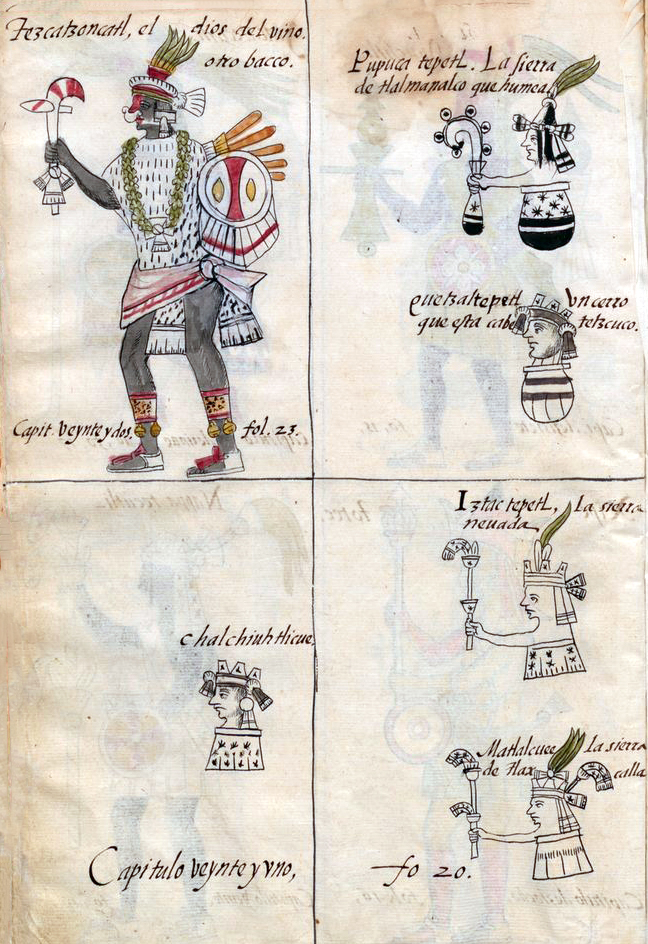
Images can help to identify patterns in the rituals of the month of Tepeilhuitl. An image in the Primeros Memoriales and reproduced in Book I of the Florentine Codex illustrates five mountain-gods (the tepictoton) whose bodies consist of an upper, human-like head and a lower base made to look like a bulbous vessel or a fanned skirt. Three of them have a single arm extending into the air before them that clutch small replicas of “their stout reed staves, their lightning sticks, their cloud-bundles.” [4]

The artist renders fine details, including splatter marks of rubber paint that were applied to the skirts and sashes worn by the mountain-gods. Identifiable features distinguish each one. For instance, the likeness of the mountain Popocatepetl dons a black and white peaked cap and bears a vessel that fumes a curly stream of smoke. It represents the sacred forces of the active volcano located to the southeast of Tenochtitlan. According to the text, the tepictoton were then “placed on the ground, the one following the other in a row, and they were facing the fifth [figure]” [5].
The main ingredient
The mountain-god creations consisted primarily of nourishing amaranth seed dough, called tzoalli (tzohualli in Huastecan Nahuatl). The dough was a chief ingredient in worship, and the people of Mexico have enjoyed it in various forms, from dried cakes to soupy atoles, for millennia. Dough figures looked uncomfortably human as they were given “teeth of gourd seeds… eyes of fat black beans.” [6]
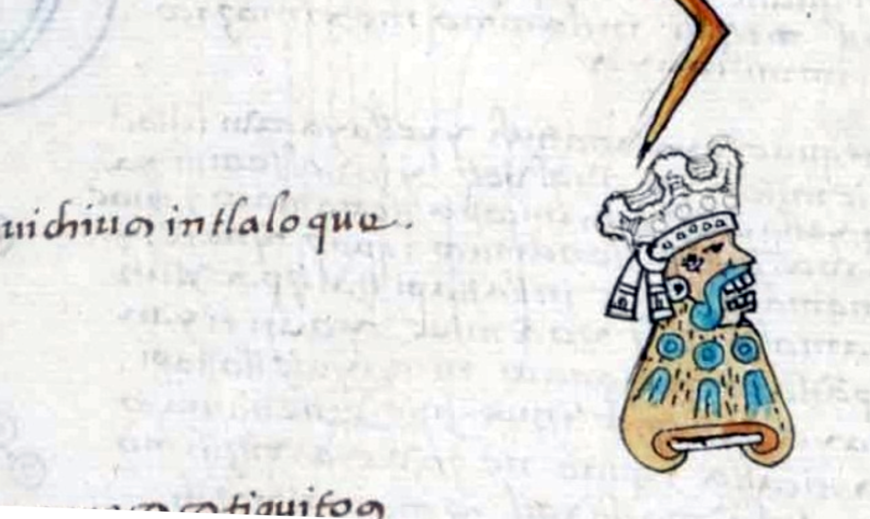
Another depiction from the Primeros Memoriales shows the exterior of a tepictoton (mountain-god) in the likeness of Tlaloc (it is a tlaloque, a little helper of Tlaloc). Its head and body are honey-yellow (amaranth seeds, huauhtli, had an amber quality and looked like pale fish roe) and the tiny black strokes give the appearance of black seeds dimpling the mountainside. Tlaloc has three blue rain and water symbols painted on his side, and he wears a white cotton crown (its fluffy edges apparent on the codex page), a headband, and an earspool. His face consists of exposed teeth made from gourd seeds, and the classic blue-green “Tlaloc mouth”—a mustache-like symbol framing the upper lip, its ends curling back and upward.
Tepeilhuitl is directly related to the god Tlaloc, who was a water deity overseeing rain and lighting. Tlaloc was responsible for Nahuas drowning or struck down suddenly, and he manifested in human bodies by crippling them with palsy or stiffening their limbs. Those figures that made up the inside of each tepictoton were specifically the likenesses of those living or dead people affected by Tlaloc’s powers.
The dead inside
Before the exterior of a mountain-god display could be fashioned, Nahua artisans first crafted little dough figures called “children,” which represented the dead and afflicted. First, they would craft “skeletons” (in Nahuatl imomoio, “their bones”) for individual figures. This was done with sticks of wood or compacted bars of amaranth dough to provide a frame. Around the figure’s “skeleton,” they applied more dough to make the body, and these along with other dough figures in the shape of “serpents” (known as ehecatotontin or “little winds” in Nahuatl) would be piled together in the participant’s household courtyard. The children and little winds were then curated into piles by the artists, one pile for each mountain-god to adorn the courtyard that year.
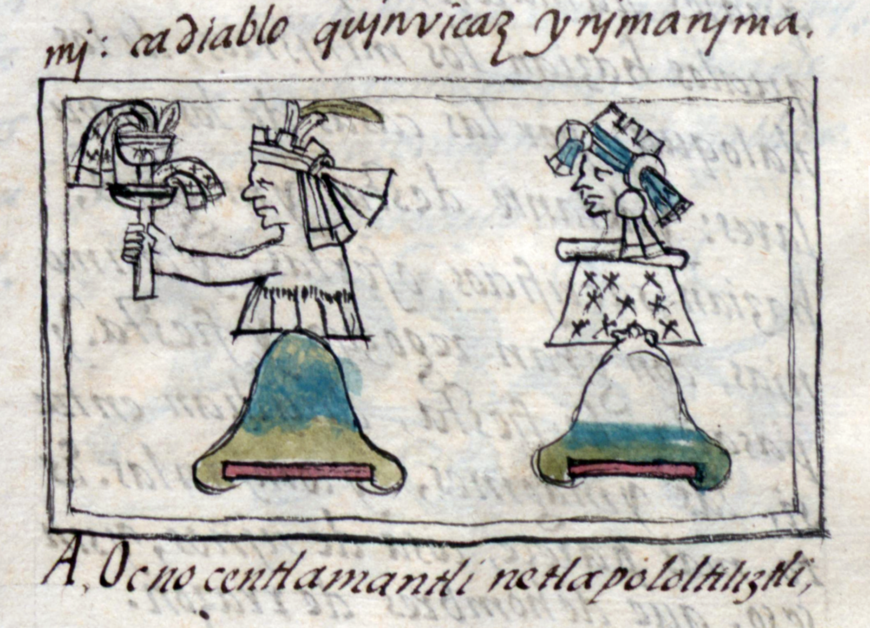
Over these they pasted more amaranth, which they pressed to form the geologic and human-like features of the tepictoton. As they finished the exterior with paint, feathers, and seeds, they also wrapped the mounds of dough with a paper skirt, a final layer of dress to cover both the mountain and its dough children inside.
At the end of the month of Tepeilhuitl, observants cracked open the mountain-god dioramas, pulled out “children” and “little winds” from the interior, carried the figures to a sacred shrine called the Mist House, and carefully washed and prepared them for consumption. Eating replicas of their dead—the little dough bodies now metaphorically charged with twenty days’ worth of adoration and memories—Nahuas believed they were nourished with the same powers as the dough bodies.
During the month of Tepeilhuitl in 1520, the Mexica starved through a pandemic when they would normally be feasting to remember their loved ones and looking forward to a prosperous future. We do not know how, if at all, the Mexica celebrated that year.
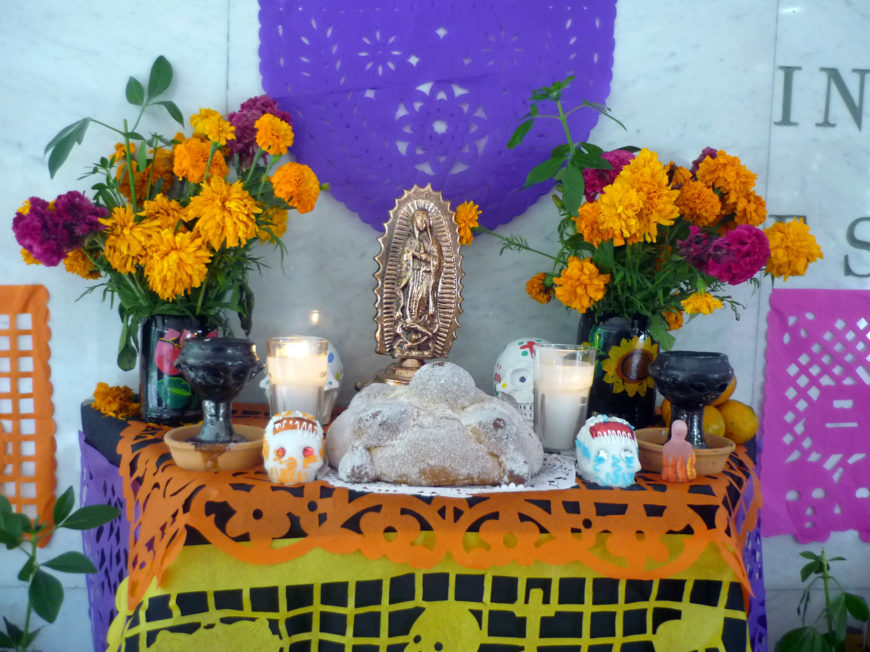
Edible arts in times of sickness
Adopted and adapted up to the present, every fall we are reminded of Tepeilhuitl’s cultural resilience in each ofrenda (family altars) that families make for Día de Muertos. Artisanal foods grace family altars and tombstones in the cemetery, and everyone enjoys eating sweet breads, called pan de muertos, decorated with crossbones designs, and glittering white calavera sugar skulls. People do not make tepictoton nor tzohualli figures for eating these days, but alegrías (tasty biscuits made of toasted and honey-coated amaranth seeds) reflect some of the deeper roots of honoring the sacred landscape. Celebrating the tradition of Día de Muertos will need to be different this year (2020) due to disease, with many festivals across the globe cancelled to limit the spread of COVID-19. Furthermore, many of this year’s ofrendas will memorialize the lives we have lost to the virus. Hopefully, families can still honor their roots in a safe and tasty way.
Notes:
[1] Codex Aubin, Am 2006 Drg.31219, Folio 23v © The Trustees of the British Museum and Fernando Alvarado Tezozómoc, Crónica mexicáyotl, Adrián León (trans.), third edition (México Universidad Nacional Autónoma de México Instituto de Investigaciones Históricas 1998)
[2] James Lockhart (ed. and trans.), We people here: Nahuatl accounts of the conquest of Mexico, Vol. 1 (Berkeley: University of California Press, 1993: pp. 180-183).
[3] Bernardino de Sahagún, Primeros memoriales (trans. by Thelma D. Sullivan and Henry B. Nicholson, Norman: University of Oklahoma Press, 2017: p. 64).
[4] Bernardino de Sahagún, Primeros memoriales, p. 114.
[5] Bernardino de Sahagún, Florentine Codex: General History of the Things of New Spain, Book 1: The Gods (trans. by Arthur JO Anderson and Charles E. Dibble; Santa Fe: The School of American Research and the University of Utah, 1970: p. 49).
[6] Florentine Codex, book 1, p. 47.
[7] Florentine Codex, book 1, p. 75.
Additional resources
Look at the Florentine Codex
Carolina A. Miranda, “How a vital record of Mexican indigenous life was created under quarantine,” LA Times 2019
For those interested in learning more about Día de Muertos and ofrendas, please do so in a respectful and genuine manner
Learn more about Día de Muertos from National Geographic
Celebrate Día de Muertos by honoring Mexico’s ancient roots and shape your homemade sweets from indigenous ingredients
Bernardino de Sahagún, Florentine Codex: General History of the Things of New Spain, 13 Vols. (edited and translated by Arthur J O Anderson and Charles E Dibble; Santa Fe, NM: School of American Research; Salt Lake City, UT: University of Utah, 1950-1982).
Michel Graulich, Myths of ancient Mexico (Norman, OK: University of Oklahoma Press, 1997).
Frances E. Karttunen, An Analytical Dictionary of Nahuatl (Norman, OK: University of Oklahoma Press, 1992).
Elizabeth Morán, Sacred Consumption: Food and Ritual in Aztec Art and Culture (Austin, TX: University of Texas Press, 2016).
John F. Schwaller, The Fifteenth Month: Aztec History in the Rituals of Panquetzaliztli (Norman, OK: University of Oklahoma Press, 2019).
Remembering the Toxcatl Massacre: The Beginning of the End of Aztec Supremacy
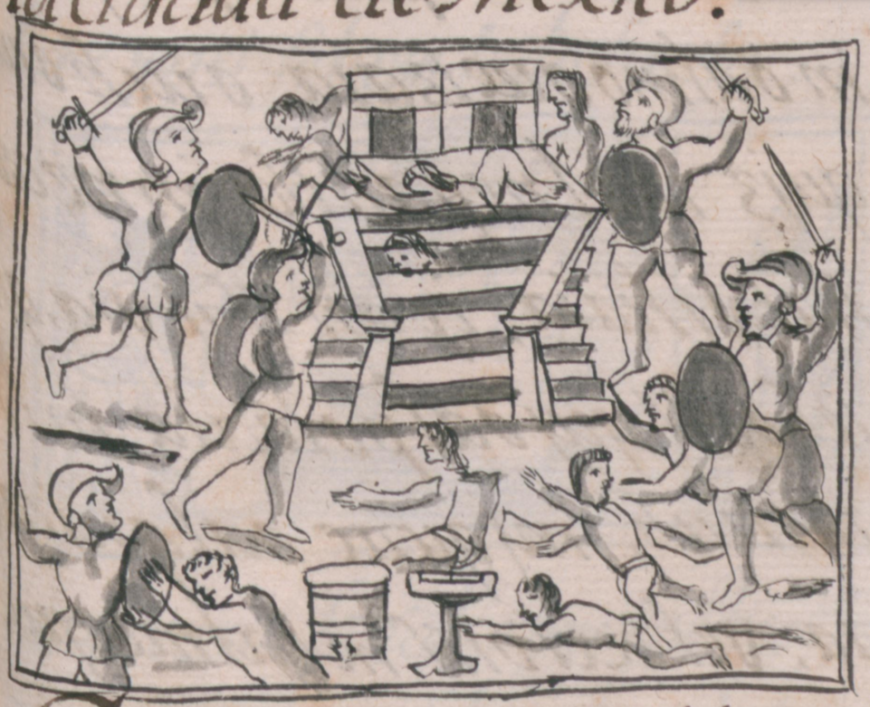
Competing Histories
This May marks 500 years since the Toxcatl massacre, in which Indigenous people were killed during a festival that took place in the Aztec capital of Tenochtitlan (today’s Mexico City). Two competing histories of this event exist. In the Spanish telling, the conquistadors acted in self-defense, yet a very different narrative emerges in the Indigenous version.
On May 22, 1520, Spanish conquistadors and their Indigenous allies attacked the Mexicas—the Nahuatl-speaking ethnic group that dominated a vast multi-ethnic territory that spanned from the Pacific Ocean to the Gulf coast, and from central Mexico to present-day Guatemala. The attack during the Toxcatl festival incited a war that led to the end of Mexica supremacy and to the beginning of the conquest of Mexico.
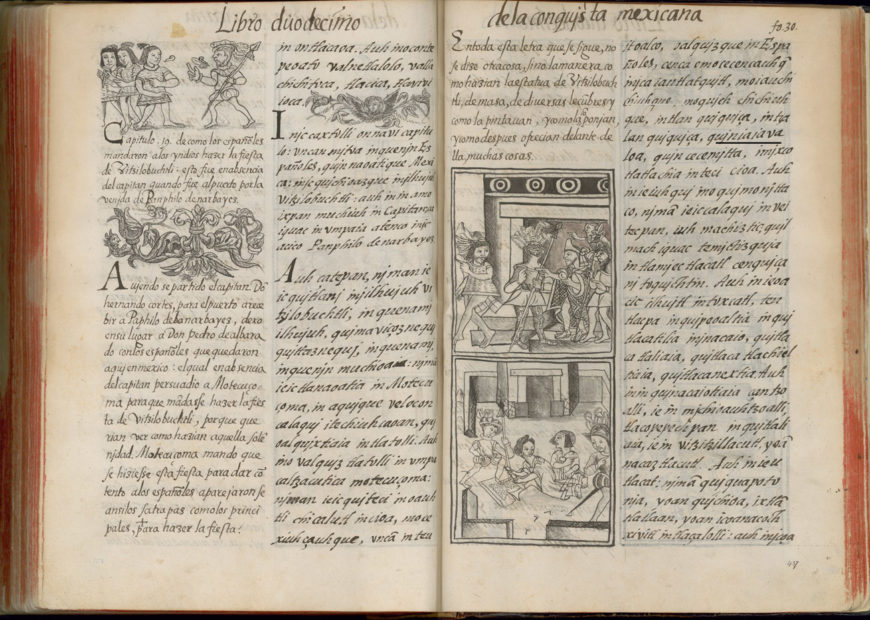
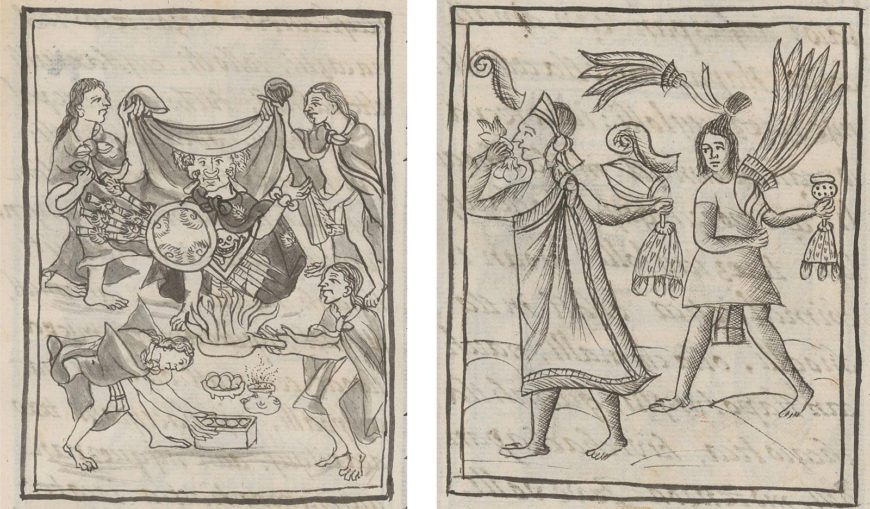
For most of the past 500 years, this history of the conquest of Mexico has been based on the accounts of Spaniards. Francisco López de Gómara’s La conquista de Mexico was one of the most influential historical accounts of the conquest of Mexico, drawing on Hernán Cortés’s letters addressed to the Spanish king that justified the attack. The Spaniards claimed the festival was a cover-up for an Indigenous rebellion. However, Nahuatl-language texts survive that tell us an alternative version. They excruciatingly detail the human horror and the treachery of a mass murder, now known as the Toxcatl Massacre. One of the most critical Indigenous sources is Book 12 of the Florentine Codex, the manuscript that is the focus of a digital research initiative at the Getty Research Institute.
The Mexica Perspective
Book 12 of the 16th-century Nahuatl-Spanish encyclopedia, known as the Florentine Codex, preserves the point of view of the Mexicas. It is the longest and most detailed historical account of the conquest written in Nahuatl, the lingua franca of pre-Hispanic central Mexico. Here the Toxcatl Massacre is described as an attack carried out with cruelty, stealth, and treachery. The Nahua authors write that the Spaniards ordered the ceremony to take place, even after they detained the Mexica ruler, Moteuczoma Xocoyotzin, and looted the palace for gold.
Book 12 of the Florentine Codex begins with an illustration of the Toxcatl Massacre. The Nahua authors and artists deliberately placed this image at the beginning of the book to foreground their underlying argument: the treacherous attack and ensuing war on Tenochtitlan, the Mexica capital, and the sister city Tlatelolco were unjustified.
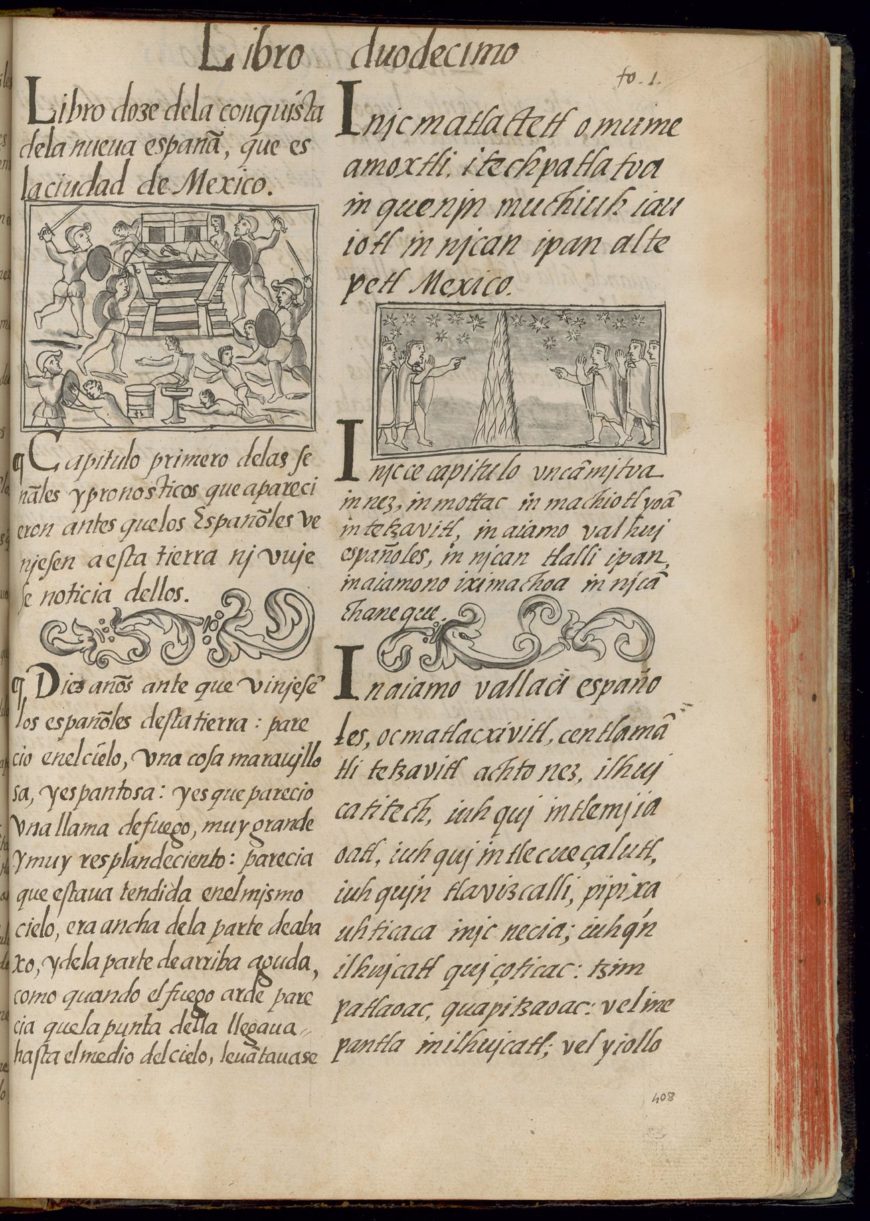

The image depicts the gruesome attack: armed Spaniards crowd in from all sides and hack away at unarmed Mexicas gathered for the ceremony. In the background is the Templo Mayor, Tenochtitlan’s main ceremonial temple, signaling the sacred environment in which this massacre was perpetrated. Two traditional drums in the foreground, the vertical huehuetl and the horizontal teponaztli, underscore the violent interruption of the religious festival. The Nahuatl text in Book 12 and in other 16th-century Nahuatl sources, such as the Codex Aubin, detail how the Spaniards initiated the attack by cutting off the hands of the drummer and then dismembering him—a traumatizing memory also captured in multiple images in the manuscript.
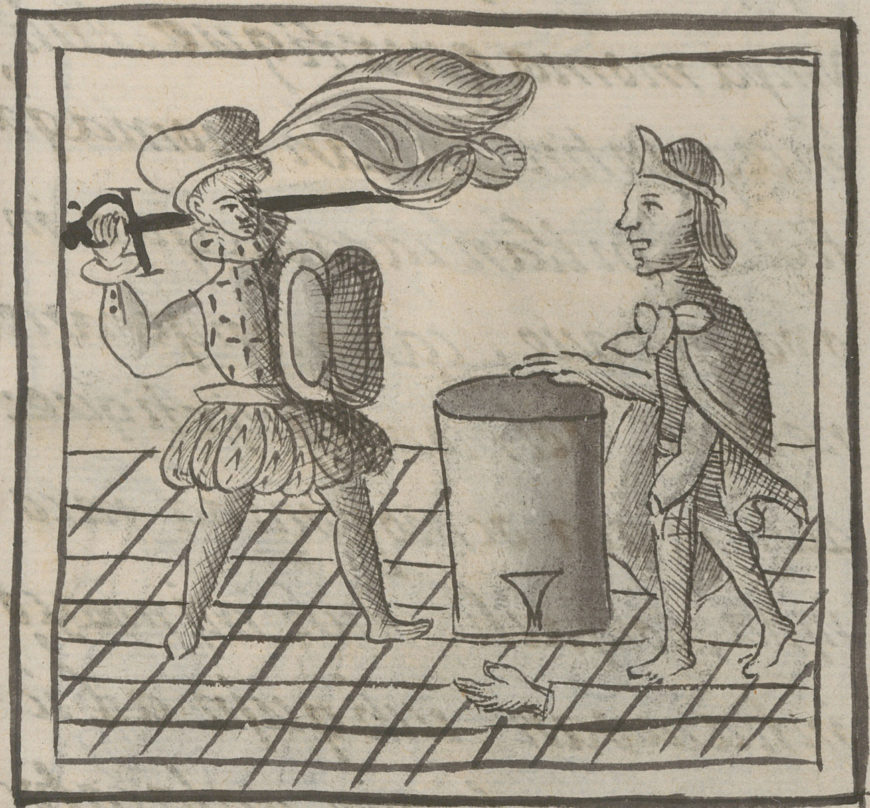
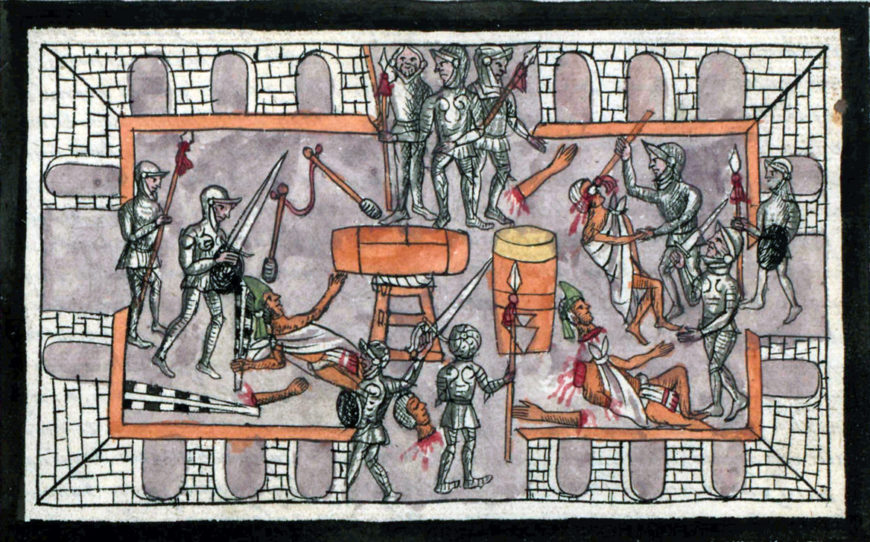
These painful visual elements are echoed in this colorful image painted in a history of New Spain compiled by the Dominican friar Diego Durán in 1579. Again, we see two drums at the center, Spaniards entering the sacred courtyard from all four sides, and dismembered and bleeding Mexica bodies. This image was most likely painted by an Indigenous artist. We see a European-style colonnade, but the architecture and people are flattened against the pictorial plane to allow for maximum visibility following Indigenous artistic norms.
The Nahuatl text of Book 12 recounts the bloody scene:
Then they stabbed every one with iron lances and struck them with iron swords. They stuck some in the belly, and then their entrails came spilling out. They split open the heads of some, they really cut their skulls to pieces, their skulls were absolutely pulverized. And some they hit on the shoulders; their bodies broke open and ripped. Some they hacked on the calves, some on the thighs, some on their bellies, and then all their entrails would spill out. And there were some who were still running in vain: they were dragging their intestines and seemed to get their feet caught in them. Eager to get to safety, they found nowhere to go.Book 12 of the Florentine Codex
The Mexica Counterattack
Soon, the Mexicas organize a counterattack. The Nahua authors record a speech calling the warriors to take up arms: “Mexica! Warriors! Come running, get outfitted with devices, shields, and arrows. Hurry! Come running! The warriors are dying; they have died, perished, been annihilated. Mexica! Warriors!”
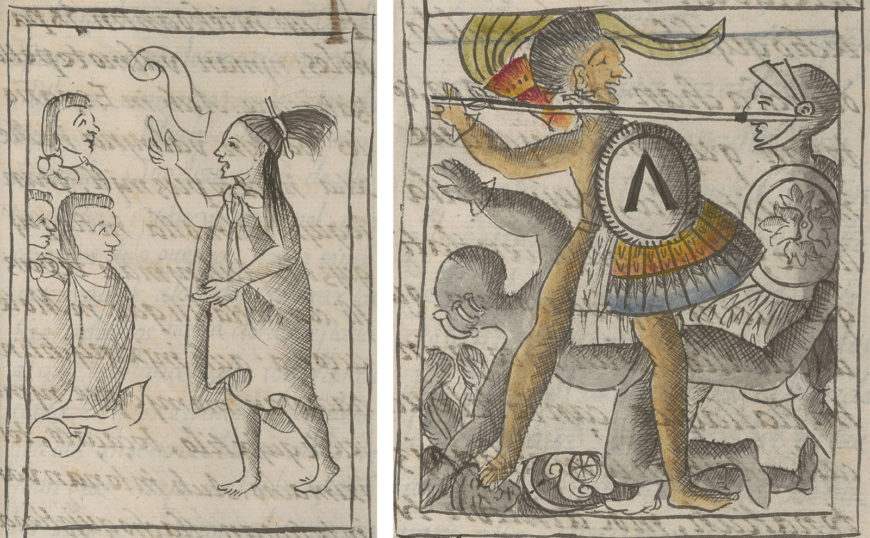
The chapter on the Toxcatl Massacre ends with the Mexica fending off the attackers, in an atmosphere described as “yellowish” (cozpol). The color yellow refers to the blur of arrows, harpoons, and darts, all made from reeds, falling upon the attackers. The Mexicas win this battle but will lose the war that follows. The story ends with the surrender of the Mexicas, led by Cuauhtemoc, the last ruler of Tenochtitlan.
Essay first published in the iris (CC BY 4.0)
Painting Aztec History
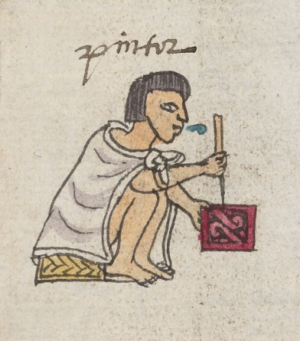
Writing with images
Imagine writing a history. More than likely, you would begin by brainstorming the events you would want to include, the characters in your story, and when and where the events took place. Then, you would have to order these elements in some way to create a cohesive account, maybe telling your story in a clear chronological order or from multiple perspectives. You would want to organize it using a format that packs in as much information as possible and serves the agenda of your narrative.
Although history writers throughout time have had to grapple with such questions, many use alphabetic text to record the past. However, for the Aztecs, the people who lived in Central Mexico before the arrival of the Spaniards in 1519, language took a painted form. The Aztecs understood writing and painting to be deeply intertwined processes, so much so that the Nahuatl word for “painter,” or tlacuilo, translates to “painter-scribe” or “painter-writer.” An important subset of the corpus of Aztec painted manuscripts, which include divinatory books, censuses, land registers, and tax and tribute documents, were histories.
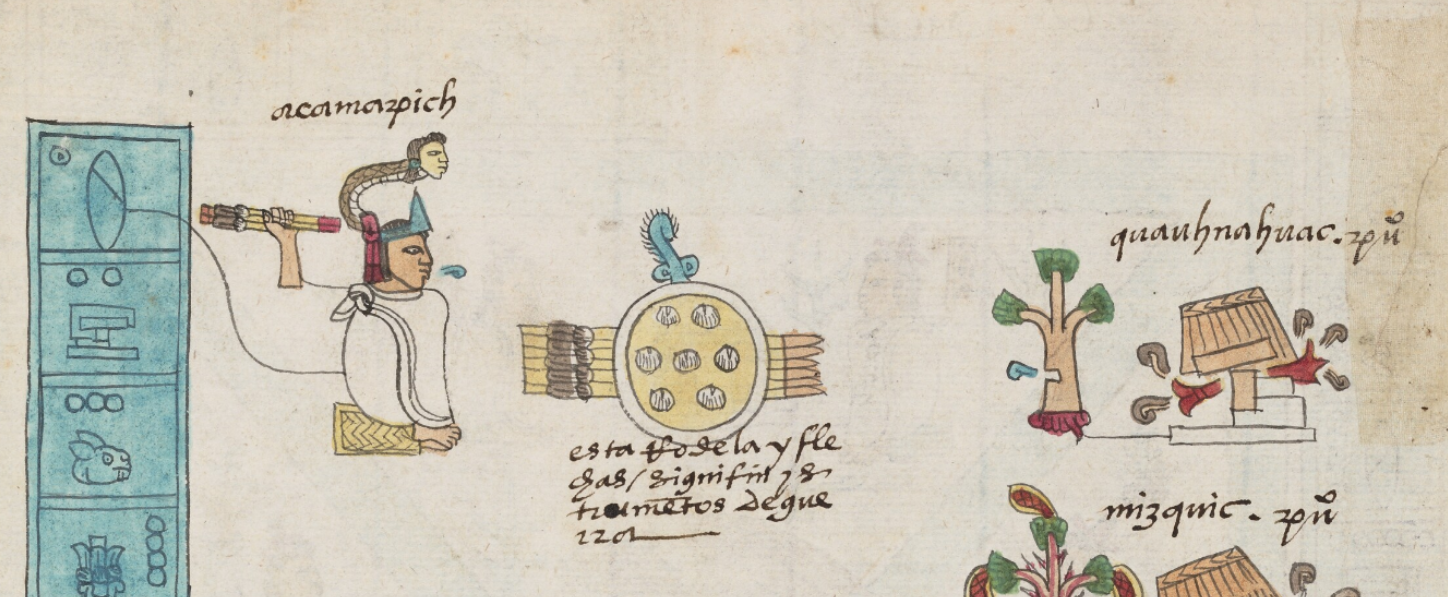
The Aztec painted language operated at two levels. First, painter-scribes identified individuals and specific places through glyphs, which functioned like nametags. For instance, in the Codex Mendoza, the glyph attached to the ruler Acamapichtli provides the reader with his name, represented by a hand grasping a bundle of reeds (his name means “Handful of reeds” in Nahuatl). On the same page, a painted tree with a curled scroll represents a place called Cuauhnahuac. In Aztec painted writing, the representation of the ruler Acamapichtli itself carries meaning just like its associated name glyph. Acamapichtli’s visual features are elements of Aztec pictography, in which visual representations of people, places, and events act like writing. For instance, a literate reader can examine the representation of Acamapichtli (ignoring the name glyph) and conclude that he is a ruler since he wears the turquoise diadem of Aztec rulers, sits on the woven throne of rulers, and speaks (signified by a curled scroll that comes out of his mouth), an act characteristic of rulers (who were called huey tlatoani or “chief speaker”).
Then, painter-scribes made strategic choices about to how to arrange and present these individual elements in order to create story arcs. This is the second way that the Aztec painted language operated. Some stories packed many people and events together in a stream of narrative, some stories stressed change over time, and in some stories, place and setting played a pivotal role to the narrative. The Aztecs’ painted language employed composition as a communication device as much as it used glyphs to identify people and places.
The Codex Boturini
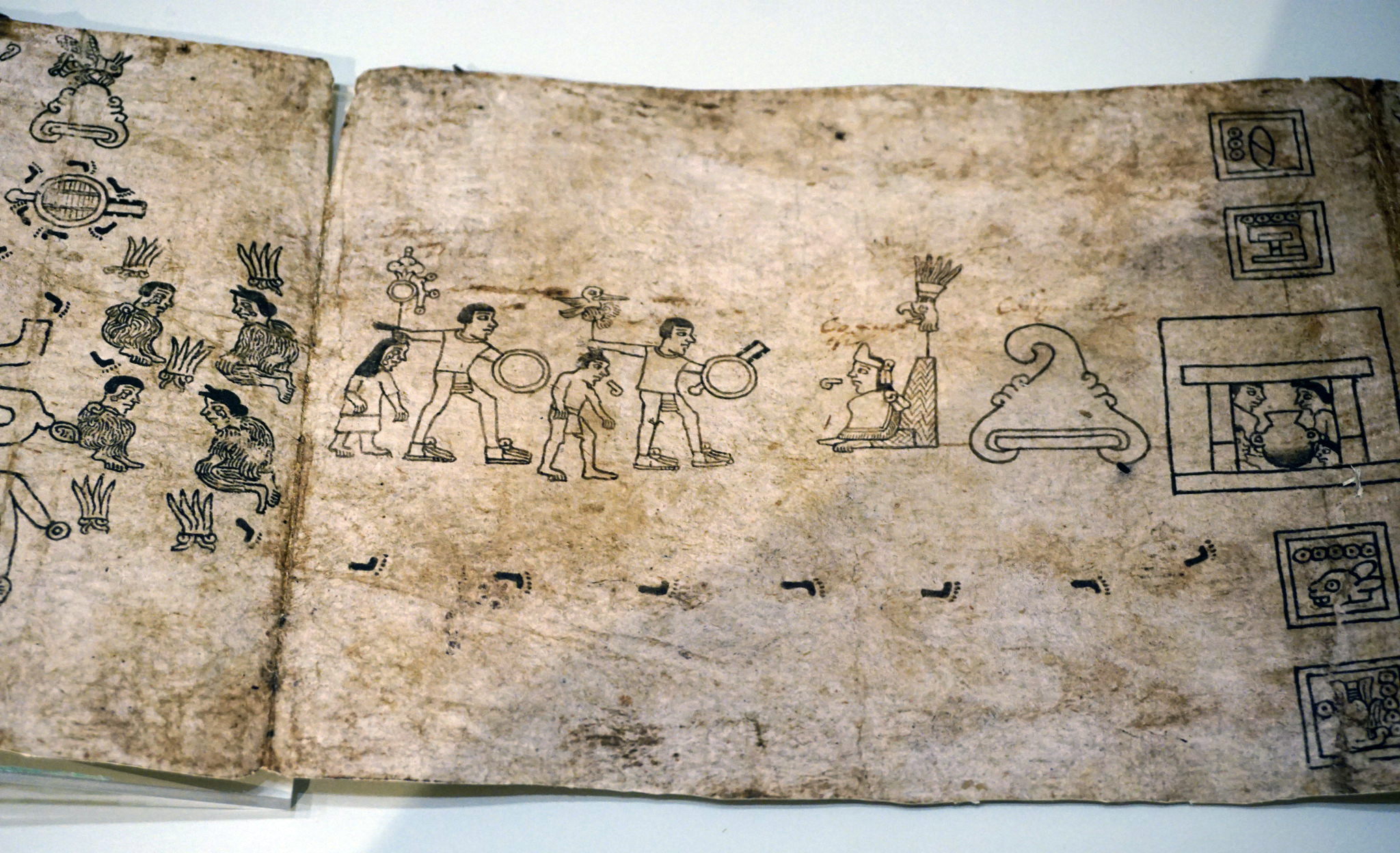

One painted history is the Codex Boturini. The codex is a screenfold, or an accordion-style book made of indigenous paper that allows the pages to be compressed or expanded at the reader’s discretion. This is the conventional format of pre-Hispanic painted books in Central Mexico. The first page of the codex represents the initial scene of the Aztec migration story, the foundation story that visually outlines the Aztecs’ journey from their ancestral homeland called Aztlan to their arrival at the eventual capital of their empire, Tenochtitlan (today, Mexico City). In the first page, a figure standing in a canoe departs from an island in the middle of a lake; the painter-scribe demonstrates that this place is an island through the wavy outline of the lakeshores.
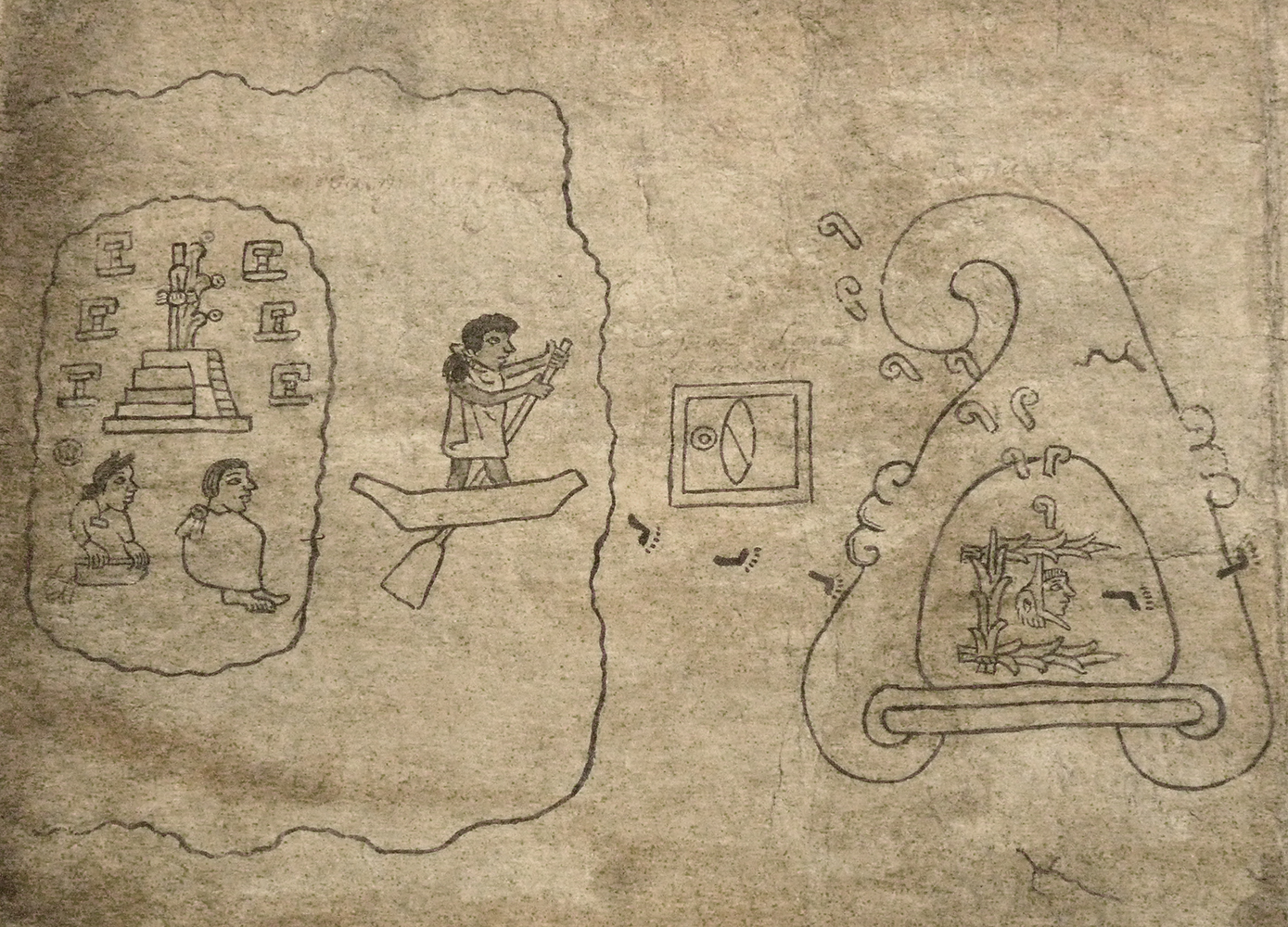
This island is Aztlan, the ancient homeland of the Aztecs; a male and female couple and a few temples symbolize that this place was settled and populated. The direction of the figures’ profile bodies and the footprints leading to the right cue the reading order. The footprint path leads to a large sign with a curled top, which represents a place called Colhuacan. Within this place, the Aztec patron deity, Huitzilopochtli, rests. He is identified by a head that seems to emerge from a bird headdress. Above the footprints is a framed flint sign with a single dot next to it. This is the glyphic year sign of 1 Flint and connects the action to a specific year. A series of curled scrolls emanate from the representation of Huitzilopochtli; these scrolls represent speech or utterance and show that the patron deity is speaking and giving direction to the migrants. Thus, in the eyes of a literate viewer, all of these pictorial elements come together to express that in the year 1 Flint, the Aztecs left their ancestral island home of Aztlan, and received directions from their patron deity to continue on their migration. The painter-scribes efficiently pack all of the required elements of narrative (people, places, events, and time) into this opening page using exclusively visual language.
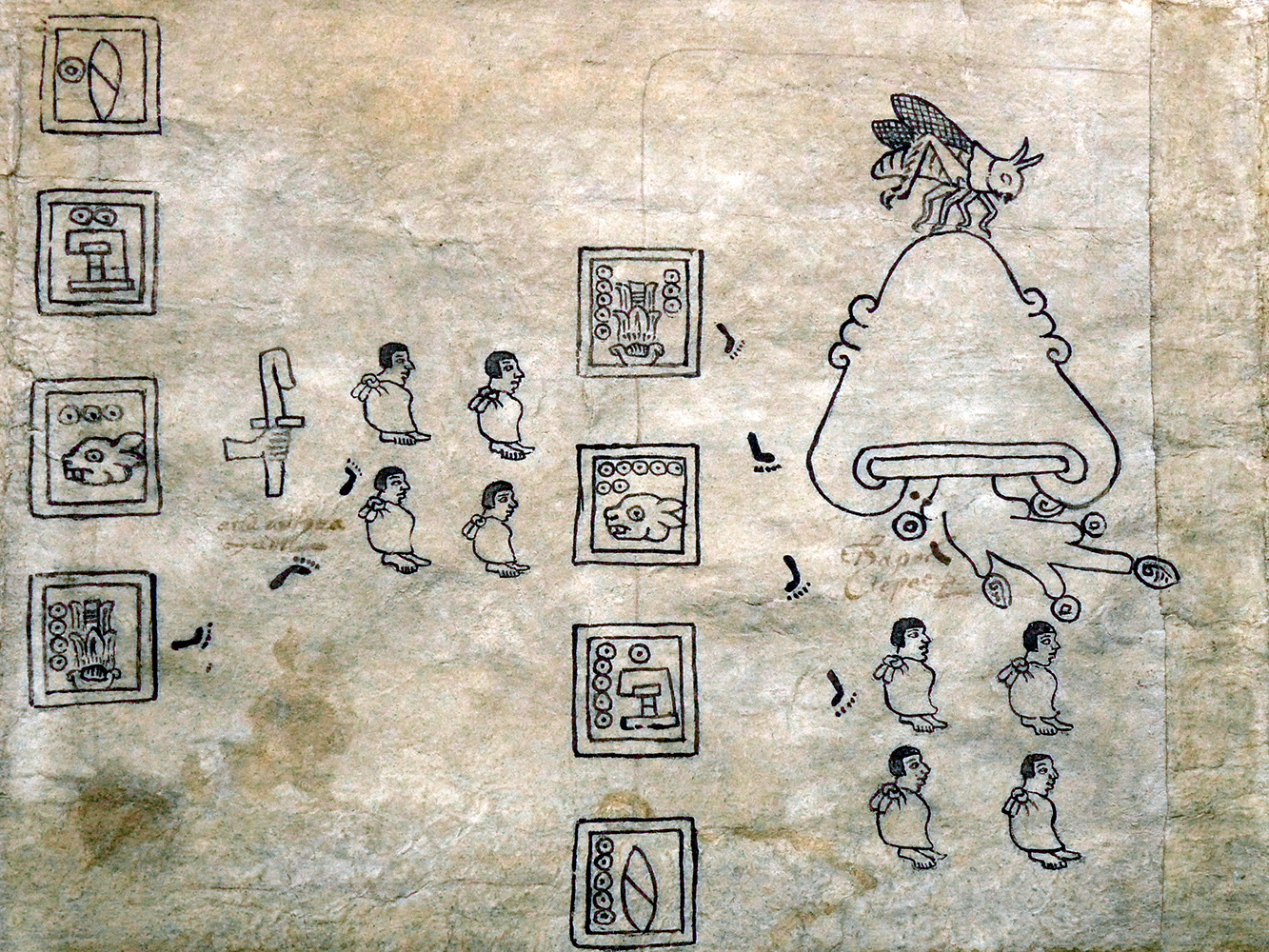
Throughout the rest of the codex, the Aztec migration story continues. Most of the pages include images of migrants, a place glyph that represents where they stopped on their migration story, and a cluster of year signs that show how many years they stayed in that particular place. Footprints link the migrants’ journey and symbolically connect the separate pages to one another (which could be expanded when opened from the accordion-style book). In the Codex Boturini, the painter-scribe emphasized the sequence and duration of the migration, as the narrative is linked together in a chronological order.
The Mapa Sigüenza
The flexibility of the Aztecs’ visual grammar meant that the migration story told in the Codex Boturini could also be told in a completely different format. In the Mapa Sigüenza, the Aztec migration story is told with the help of a conceptual map. While the Boturini is a screenfold book, meaning each episode of narrative corresponds to one page to be read sequentially, the story on the Mapa Sigüenza was painted on a single large sheet of indigenous amatl paper so the viewer sees all of the content at once. For the painter-scribe of the Sigüenza, it was more important to position the Aztecs’ migration in geography rather than as a sequence of events, as in the Boturini.
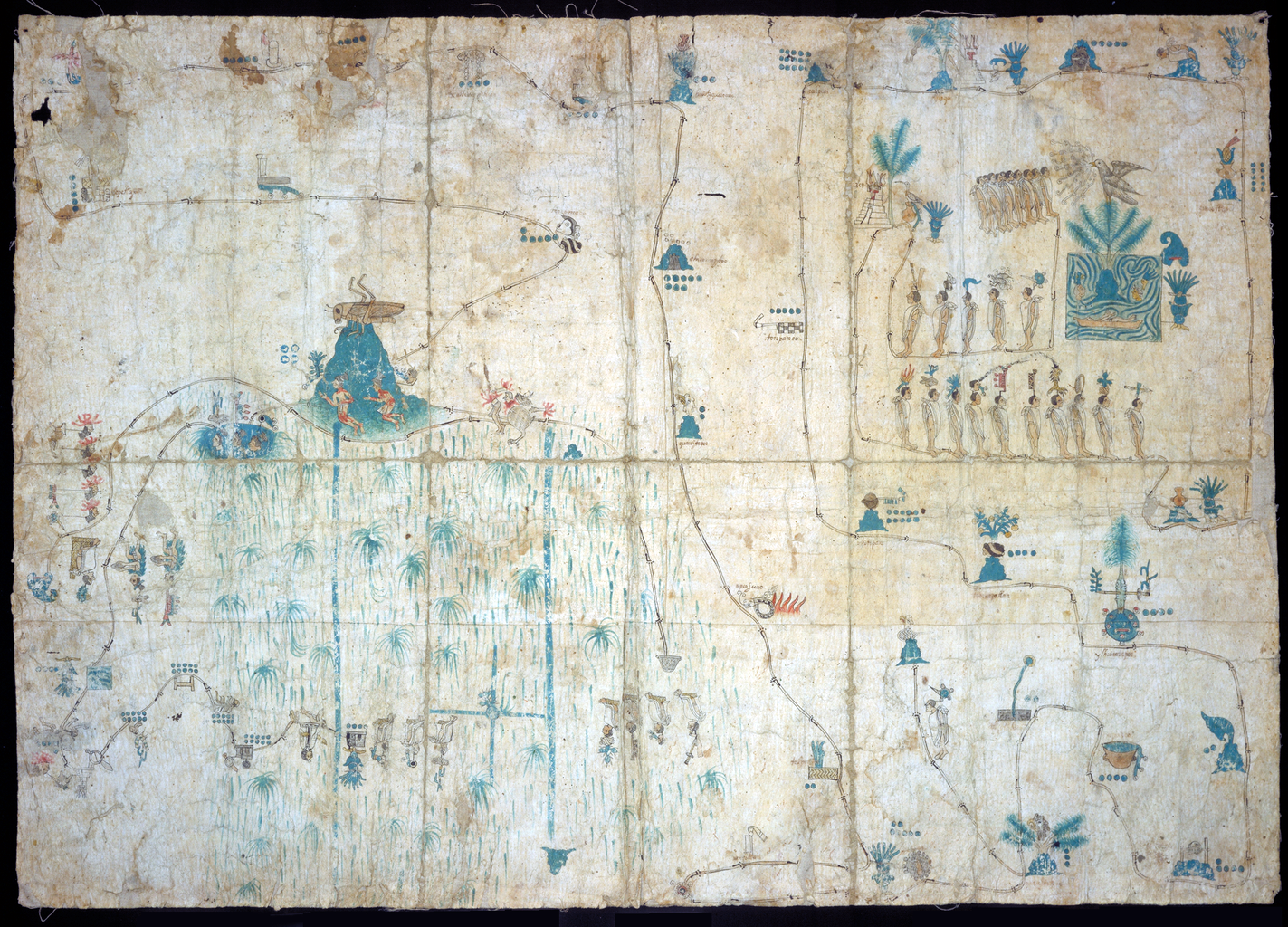
The story begins in the top right corner, at the island of Aztlan (represented as a square filled with blue wavy lines representing water) and the curved place sign seen in the Codex Boturini. Tall, slender figures line up in profile to begin the migration. Their itinerary takes place along a thin pathway dotted with footprints to mark movement. The pathway meanders throughout the page, passing through signs that represent different mythic places. Dots next to these place signs express how many years the migrants stayed in each place.
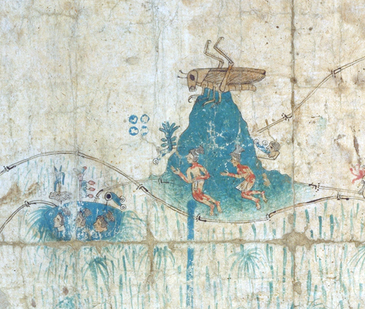
The disproportionately large place sign of a grasshopper on top of a green hill in the middle of the left side of the page demonstrates that this was the most important stop in the Sigüenza’s version of the migration. The painter-scribe chose to increase its size relative to the other place signs (what we call hierarchy of scale). Below this place, the painter-scribe adds descriptive geographic features, such as blue straight lines that signify canals and marshy vegetation, to help the reader identify this landscape as the marshy lakeshores that surrounded the ultimate capital of Tenochtitlan. Unlike the Boturini, the Sigüenza’s makers decided to use a map-like format to give its readers a better understanding of the spatial relationship between places on the journey.
Aztec books and the Spaniards
Although many Aztec painted histories survive today, none are undoubtedly pre-Hispanic in date. When the Franciscan friars arrived in 1524, they began to systematically destroy all types of books in Aztec libraries, as these forms of knowledge were considered to be continuations of pagan idolatry incompatible with Catholicism.
Despite this, indigenous painter-scribes continued to record histories in painted form in the decades after the Aztec-Spanish encounter, and even used the Aztec painted language to memorialize scenes of colonial history. In fact, the manuscripts described above (the Codices Boturini and Mendoza and the Mapa Sigüenza) were all created in the early colonial era. Indigenous communities made many manuscripts and maps in the pre-Hispanic style and used the painted language, often to express their ancient right to lands. Although viewership changed, the Aztecs’ painted language was both stable and versatile in the face of colonialism; it did not cease with Spanish intervention, but rather it adapted and addressed new audiences.
Additional resources:
Elizabeth Hill Boone. Stories in Red and Black: Pictorial Histories of the Aztecs and Mixtecs. (Austin: University of Texas Press, 2000).
Dana Leibsohn. Script and glyph: pre-Hispanic history, colonial bookmaking and the Historia Tolteca-Chichimeca. (Washington D.C.: Dumbarton Oaks Research Library and Collection, 2009).
A list of Aztec Group codices at the Foundation for the Advancement of Mesoamerican Studies
Facsimiles of colonial codices and commentaries (in Spanish) at Amoxcalli
Isthmian cultures (Central America)
The North American Isthmus—today, Panama, Costa Rica and Nicaragua
Doe Shaman Effigy
From the physical to spiritual world (the shaman)

An important visual theme in many ancient American art styles is that of transformation: one thing changing into another. Often the physical change seen in the art is meant to convey a spiritual transmutation, as inhabitants of this physical world communicate with, and often temporarily become, the inhabitants of the spirit world. Communication with the spirit world is essential. The inhabitants of that world hold power over this one, and they can aid humans in making crops grow, healing the sick, or helping the dead pass into the afterlife. However, there is also a dark side to the spirit world and its inhabitants. Some spirit beings are malevolent, causing disease, crop failure, droughts, floods, and other disasters. In order to negotiate with the perilous spirit world, a person with special gifts and training must be able to travel there and represent their people.
The term “shaman” initially referred solely to the specific kinds of healers and holy people of Siberia (the word is Tungusk in origin), but today it is often used as a broad category designating ritual specialists who undergo spiritual transformations and trances that place them into communication with the spirit world, and allow them to journey into that world if the need arises.
Usually, if the local term for such a practitioner is known, that is what they are called in scholarly literature, but in the case of long-passed cultures with no written language, “shaman” is frequently the catch-all designation. Most shamans have spirit alter egos who help them in this world and in the spirit world, and these alter egos are usually animals. The qualities of particular animals, such as swiftness, strength, and heightened senses, all aid the shaman as they travel in the spirit world, where they may have to fight evil spirits or rival shamans as well as find and communicate with more benevolent forces.
Doe / Shaman
The Doe Shaman (above) is such a figure. She is from the Greater Nicoya area, comprised of parts of modern-day Costa Rica and Nicaragua. Unlike Mesoamerica and the Central Andes, there was no empire-building in the area we now call Central America. Instead, small egalitarian bands and larger chiefdoms were the primary political units. A characteristic of such small societies was their desire to clearly distinguish themselves from their neighbors, with whom they often fought, competed for resources, married, and traded. A product of this competition was remarkable innovation in material culture styles, meant to create distinct wares that announce and confirm social identity. The red and black slip painting burnished to a high sheen and fine incised lines all characterize the particular local style (called Rosales Zoned Engraved) that the Doe Shaman’s people used. However, it is what the artistic style depicts that was of central importance. What is slip?

A woman…
The Doe Shaman depicts a woman, identifiable by her protruding breasts and rounded, pregnant belly, seated with her legs crossed and her hands placed on her thighs. She wears a necklace, perhaps made of stone beads, around her neck, and her body is painted or tattooed with numerous swirling and straight lines. Her head is considerably larger in proportion to her body than a normal human’s would be, and her shoulders are exceptionally broad. The swirling forms that cross her body at the armpits, navel, and buttocks may reference the shapes modern shamans report seeing as they fall into trance and prepare to enter the spirit world.
She is seated in a cross-legged pose that is commonly used to show shamans in a trance state. Her crossed legs (below) are rendered in a combination of three-and two-dimensional forms: the thighs down to the knees are rounded, three-dimensional forms, while the lower legs and feet are painted on the surface of the thighs they cross. The ankles cross between the legs, both marking and hiding her genital area. In general her body is depicted in an abstract manner, with rounded forms and a lack of interest in musculature.

but also a white-tailed deer…
Upon closer inspection, it also becomes clear that this woman does not just have human features. Instead she is being portrayed as someone in between the human and animal worlds: a shaman transforming into her animal self in preparation for a journey to the spirit world. Her features are a mixture of those of a human and those of a white-tailed deer (Odocoileus virginianus).
Several parts of her body reveal this subtle transformation, most especially the knobby protrusions on the sides of her head, the split in her lower lip, and the fact that her hands lack fingers and instead look like hooves. The protrusions on her head mimic the pedicels, or antler stumps, of deer, from which antlers grow and then are shed. The pedicels reference the regenerative nature of antlers, endowing the shaman with their property of death and rebirth.

Her split lower lip, viewed against her protruding chin, looks somewhat like a deer’s sensitive muzzle. Her hoof-hands, viewed in contrast to her nearby human feet, emphasize her ability to transform into the deer in her travels to the spirit world, and to use the swiftness of the deer in her dangerous journey. This beautifully-made piece would have been placed in a grave, where the vessel would embody the shaman’s power that would help the deceased make their safe passage from life to death, being reborn into the spirit world through the regenerative and maternal power of the shaman as well as her protection in the journey from life to afterlife.¹
1. Rebecca Rollins Stone, The Jaguar Within: Shamanic Visions in Ancient Central and South American Art (Austin: University of Texas Press, 2011), pp. 94-104.
Additional resources:
This work at the Michael C. Carlos Museum, Emory University—with zoomable image
Rebecca Rollins Stone, The Jaguar Within: Shamanic Visions in Ancient Central and South American Art. Austin: University of Texas Press, 2011.
Rebecca Stone-Miller, Seeing with New Eyes: Highlights of the Michael C. Carlos Museum collection of the art of the Ancient Americas. Atlanta: Michael C. Carlos Museum, 2002.
Mirror Pendant in the Form of a Bat-Human From Grave 5, Sitio Conte

Although the entertainment industry is constantly releasing a new Hollywood blockbuster, TV series, video game, graphic novel, or comic book about Batman’s latest adventures, it is important to understand that the extraordinary image of a human being with bat features and qualities existed long ago in the Americas. This is one of the key messages from this unique pendant from ancient Panama.

Archaeologists found this pendant with the remains of a male elder in a grave at the cemetery called Sitio Conte, located west of Panama City in the province of Coclé and approximately twenty-five miles from the Pacific Ocean. The Sitio Conte cemetery was one of several major regional cemeteries in the first millennium C.E. Currently, archaeologists are excavating El Caño, another major cemetery very close to Sitio Conte with similar types of graves and art objects. At least 200 people, mostly adult men, were buried at the Sitio Conte cemetery between 750 and 950 C.E.
Besides this pendant, the male elder’s grave was filled with pottery and tools as well as many types of jewelry and ornaments in various materials, including metals, animal bone, and stone. The Bat-Human pendant was found near two other pendants that look completely different—one displays two male warriors (below) and the other one mixes bat and crocodile imagery. Aside from this older man and his items, fourteen men of various ages were interred alongside him in the grave and most of them also had some pottery, tools, jewelry, or ornaments.

Materials and function
The bat-human pendant is in very good condition overall. One loss can be observed at the right bottom corner and another one can be seen at the left top corner. It is made with a gold-copper alloy (typical of ancient Central American metalwork), and showcases the artists’ skills with a variety of materials and techniques. It was fabricated using the lost-wax method, which requires many steps before the pendant is cast by pouring liquid metal into a mold.
In addition to casting, the curved wings with pointed extensions were made from sheets hammered into shape and attached to the body at the shoulders. Along with casting and hammering, the artists also inlaid materials into the four round and now empty depressions. The inlays have not survived after being buried for centuries in water-logged soil (the cemetery was located along the Great Coclé River). However, archaeologists have observed traces of resin in the large central depression, indicating that some sort of stone was held in place through this method. The other three depressions were inlaid differently, which is indicated by pairs of holes in the metal back.
Such holes would have had a cord pass through the back, holding the stone in place. It is likely that the smaller depressions would have once held pyrite or emeralds. Emeralds were a highly valued material and were used across Mesoamerica and Central America. In fact, a pendant in another Sitio Conte grave has a large square emerald in its back and, as such, bears witness from ancient Panama to the value of greenstone across Mesoamerica and Central America.
Drawing, Grave 5, Sitio Conte, from Samuel Kirkland Lothrop, Coclé: An Archaeological Study of Central Panama, Part I. Memoirs of the Peabody Museum of Archaeology and Ethnology, Harvard University, volume VII (Cambridge: Harvard University Press: 1937), page 104.
On the back of the pendant are two suspension rings, which confirm that this object was designed to be hung on a cord around the neck, either alone, or, more likely, with other pendants such as those found in the grave. There is evidence dating from the time of Spanish Conquest in the 16th century that people living on the Caribbean coast of Panama wore mirrors suspended from their necks.
Iconography
In addition to the mixture of techniques and materials, this pendant’s imagery also is a blend: human being and bat. Today there are more than one hundred known bat species in Panama. Several features of the pendant resemble bats such as its large ears, interlocking canines, and partially folded wings with pointed contours. The triangular or leaf-like nose panel resembles that of the leaf-nosed bats (family Phyllostomidae). Bats—especially with the wings spread open—are a popular subject for Sitio Conte pottery and pendants. However, this figure stands straight on two legs with two arms and hands raised like that of a human. All of its fingers are separated from the wings—unlike actual bats whose free thumb and fingers are encased in its wings. The figure has a trapezoidal forehead contour and upper and lower sets of square teeth behind canines. These features resemble human-shaped pottery vessels found in Sitio Conte graves. The figure is dressed in a loincloth, which is articulated by contour lines that run across the knees and a triangular cloth tucked between the legs. The Bat-Human figure also wears an elaborate head ornament in the shape of a trapezoidal panel.
Symbolism
It is not hard to understand why humans create images of themselves possessing the bat’s striking physical features and impressive abilities, such as adroit flight and locating prey at night.
Bat-human imagery in ancient Central American art is often linked to religious beliefs and practices. There is evidence of ritual specialists in ancient Central American societies: men and women who go through rigorous training about the natural and supernatural worlds to gain knowledge that helped them accomplish a goal for the community. The specialists may have animal assistants and they may also transform into these assistants during rituals to acquire the animal’s features and abilities. Beliefs and practices of ritual specialists may also help us understand the pyrite originally in the central depression (and possibly the three smaller ones:) ritual specialists used mirrors like doorways opening into the supernatural realm. Mirrors let them see parts of the universe invisible to the ordinary eye.
Together, these observations may even lead to the hypothesis that the man buried with it served as a ritual specialist in his community in central Panama. Unfortunately, there is no way to confirm his identity or role in his society. That said, other tools in his immediate vicinity in the grave can be linked to ritual: he had two pyrite mirrors (only their stone backs survive today) and a pair of painted ceramic incense burners. Whatever the man’s exact identity in his community, today we can see very clearly a man outfitted for his afterlife with many powerful ornaments, tools, and images.
Video \(\PageIndex{21}\): River of Gold: Precolumbian Treasures from Sitio Conte, University of Pennsylvania Museum of Archaeology and Anthropology (Penn Museum)
Additional resources:
Mirror Pendant in the form of a Bat-Human at the Peabody Museum of Archaeology and Ethnology, Harvard University (31-36-20/C13361)
Warwick Bray, “Sitio Conte Metalwork in Its Pan-American Context,” in River of Gold: Pre-Columbian Treasures from Sitio Conte, edited by Pamela Hearne and Robert J. Sharer (The University Museum, University of Pennsylvania, Philadelphia, 1992), pp. 32-46.
Megan Gambino, The Call of the Panama Bats, Smithsonian Magazine, 2009
Pamela Hearne and Robert J. Sharer, River of Gold: Treasures from Sitio Conte (The University Museum University of Pennsylvania, Philadelphia, 1992).
John W. Hoopes, and Oscar M. Fonseca Z., “Goldwork and Chibchan Identity: Endogenous Change and Diffuse Unity in the Isthmo-Colombian Area,” in Gold and Power in Ancient Costa Rica, Panama, and Colombia, edited by Jeffrey Quilter & John W. Hoopes (Dumbarton Oaks Research Library and Collection, Washington, DC., 2003), pp. 49-89.
John Kricher, A Neotropical Companion, An Introduction to the Animals, Plants, & Ecosystems of the New World Tropics (Princeton University Press, Princeton, New Jersey, 1997).
Olga Linares, “Ecology and the Arts in Ancient Panama: On the Development of Social Rank and Symbolism in the Central Provinces,” Studies in Pre-Columbian Art and Archaeology, number seventeen (Dumbarton Oaks Research Library and Collection, Washington, DC., 1977).
Samuel K. Lothrop, Coclé: An Archaeological Study of Central Panama, Part I. Memoirs of the Peabody Museum of Archaeology and Ethnology, Harvard University vol. VII. (Peabody Museum, Cambridge, Massachusetts).
Julia Mayo and Carlos Mayo, “El descubrimiento de un cementerio de élite en El Caño: indicios de un patrón funerario en el Valle de Río Grande, Coclé, Panamá,” Arqueología Iberoamericana vol 20, 2013, pp. 3-27.
Laura Navarro and Joaquín Arroyo-Cabrales, “Bats in Ancient Mesoamerica,” in The Archaeology of Mesoamerican Animals, edited by Christopher M. Getz and Kitty F. Emery, (Lockwood Press, Atlanta, Georgia), pp. 583-605.
Karen O’Day, “The Sitio Conte Cemetery in Ancient Panama: Where Lord 15 Wore His Ornaments in ‘Great Quantity,'” in Wearing Culture: Dress and Regalia in Early Mesoamerica and Central America, edited by Heather Orr and Matthew G. Looper (University Press of Colorado, Boulder 2014), pp. 1-28.
Nicholas J. Saunders, “’Catching the Light’: Technologies of Power and Enchantment in Pre-Columbian Goldworking,” in Gold and Power in Ancient Costa Rica, Panama, and Colombia, edited by Jeffrey Quilter & John W. Hoopes (Dumbarton Oaks Research Library and Collection, Washington, DC. 2003), pp. 15-47.
Rebecca Stone, The Jaguar Within: Shamanic Trance in Ancient Central and South American Art (University of Texas Press, Austin, 2011)
Rebecca Stone-Miller, Seeing with New Eyes: Highlights of the Michael C. Carlos Museum Collection of Art of the Ancient Americas (Michael C. Carlos Museum, Atlanta, Georgia).
A.R. Williams, “The Golden Chiefs of Panama,” National Geographic 221 (1), pp. 66-81.



